Garden
Remembering Joan
A winter walk around Barnsdale Gardens

Among the 9,000 snowdrops on display at Barnsdale Gardens is this beautiful semi-double variety with long, thin pointed outer segments. Isn’t she a beauty! Such a pretty name too, ‘Starling.’ I spotted it right at the start of our winter walk-and-talk event hosted by Barnsdale owner Nick Hamilton. Once seen, never forgotten. I’m not much of a galanthophile, but Starling captivated me. Such an unusual snowdrop with dark green inner segments and a lovely growth habit, having flowers that tilt upwards which means you don’t have to get down on your hands and knees to appreciate them.
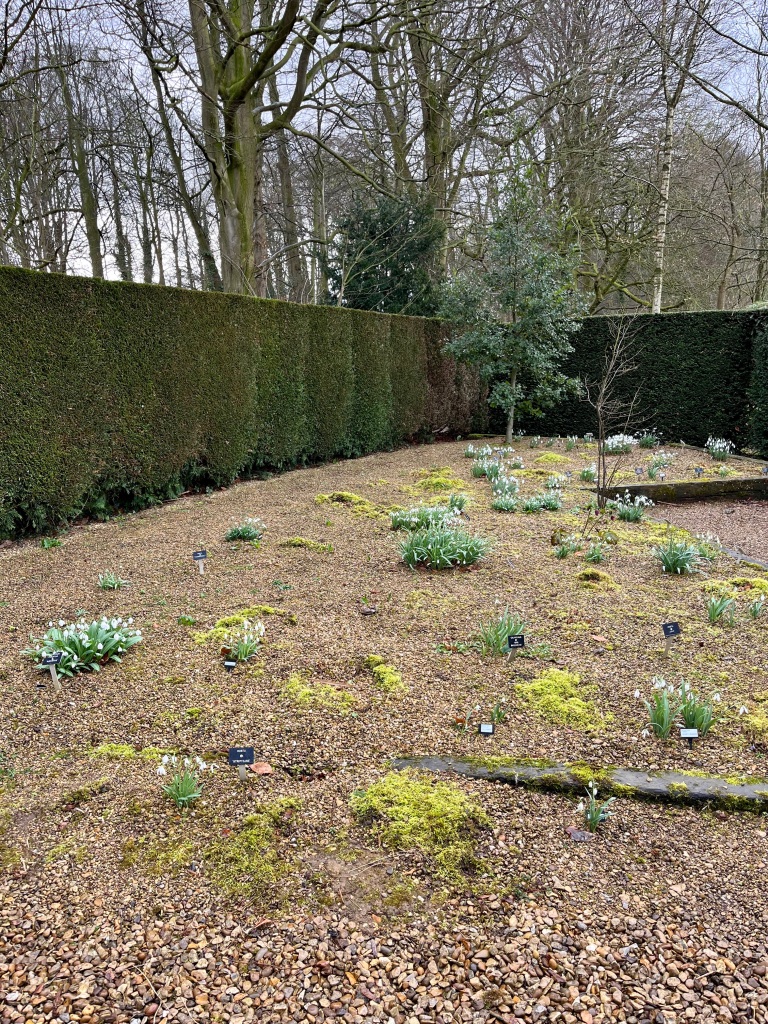
Many of the special snowdrops are displayed in a raised bed surrounded by gravel. Rain doesn’t splash them with mud. Heavy rain has been such a problem this winter and many snowdrops in my garden have either been swamped or munched by slugs. I hadn’t thought of growing them in this way, but I might try it out in a spare corner of the garden.

Galanthus Hippolyta is also thriving and forming a good substantial clump. This is one of the Greatorex doubles, ‘beautifully formed with rounded bells, filled with green edged petticoats’ says the information on a five-page fact sheet supplied by the gardens. All the snowdrops are carefully and clearly labelled and the fact sheet is a great help with identifying all the different varieties.
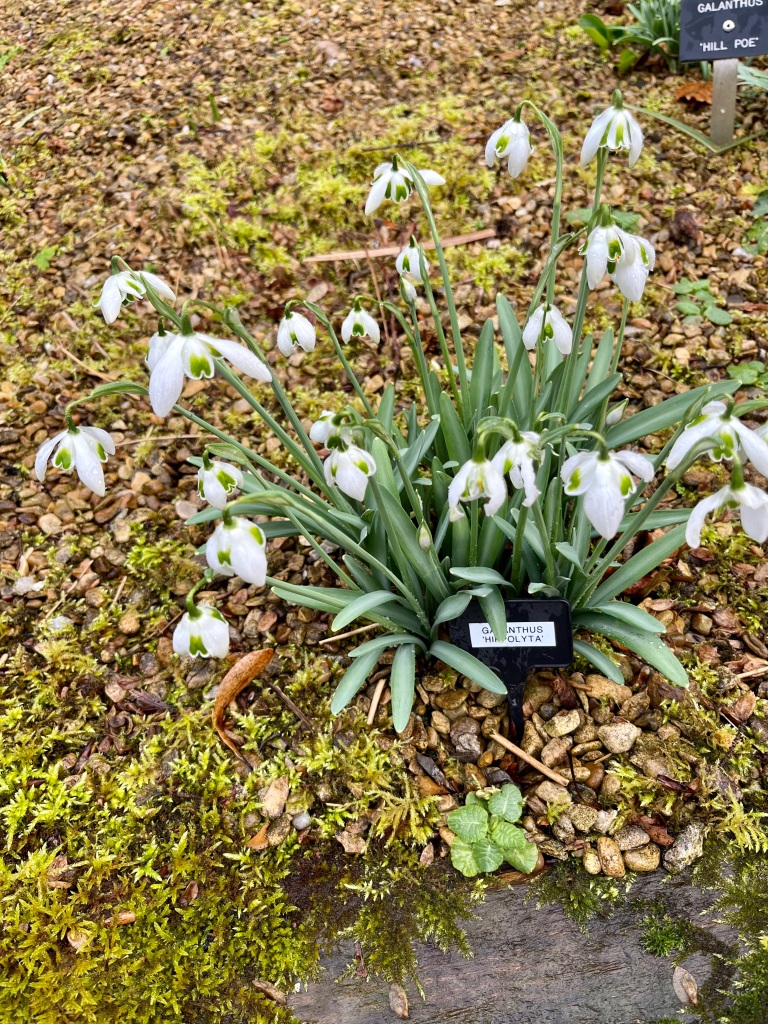

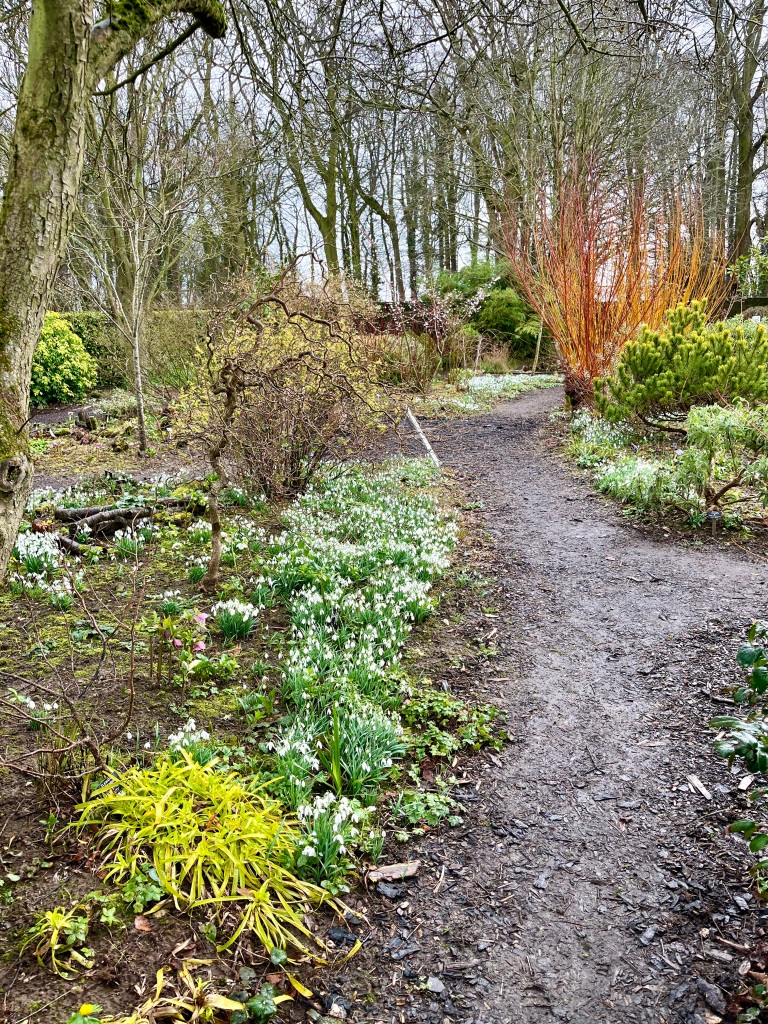
Snowdrops are just one of the attractions in the Winter Border. This garden was created in memory of Nick’s father Geoff Hamilton who presented the BBC Gardeners World show from the site until his death in 1996.
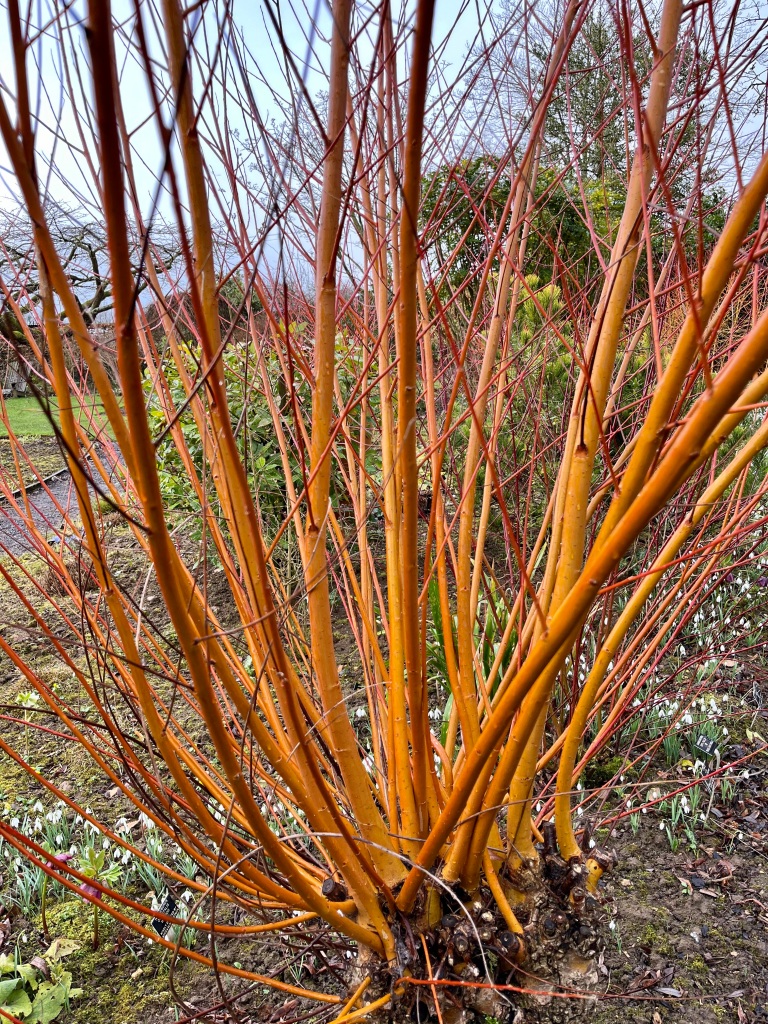
Paths are lined with evergreens, scented plants, and trees and shrubs with colourful bark for winter interest.

The beauty of having a walk- and-talk tour is seeing the plot through expert’s eyes, and picking up hints and tips on cultivation. Nick explains that these beautiful willows produce the best colour on new stems. Plants will be pruned virtually to the ground or to a low stump so that new stems will grow for next winter’s display.

Willows certainly make a design statement, and Nick advises to plant them where the sun shines through them to highlight their bright colours.
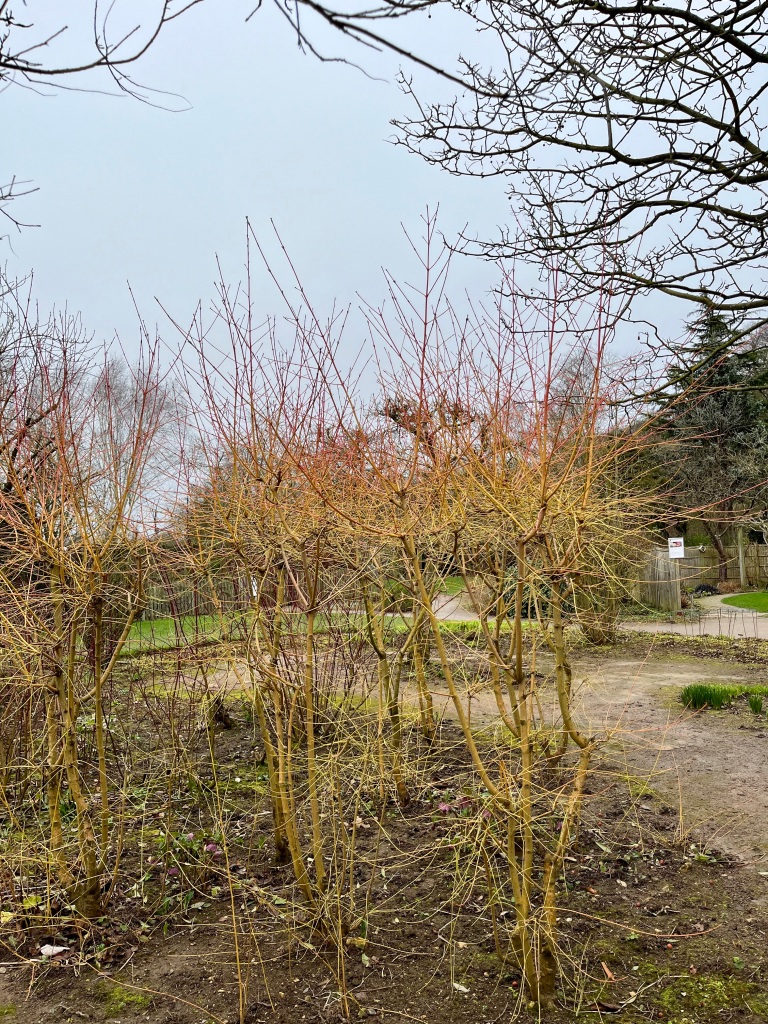
Whereas the willows are quite drastically trimmed, Nick advises a more selective approach for pruning these dogwoods. I have similar Cornus Midwinter Fire, and carefully trim back the side shoots and gently shape up the plants. Cornus Westonbirt which has bright red stems are pruned virtually to the ground, but these orange-stemmed dogwoods take a long time to recover if pruned too severely.

Information boards are posted throughout the garden which help our understanding of the reasoning behind the plantings.

It was fascinating to walk around the garden spotting all the trees, shrubs, bulbs and perennials donated to the memorial garden. Gordon Rae is a good friend of the family, and mine, and his name crops up several times with collections of different snowdrops, for example. I noticed trees from Hilliers and plants from TV and radio gardener Martin Fish- among many others.

I particularly love this view of the bandstand and terracotta urn.
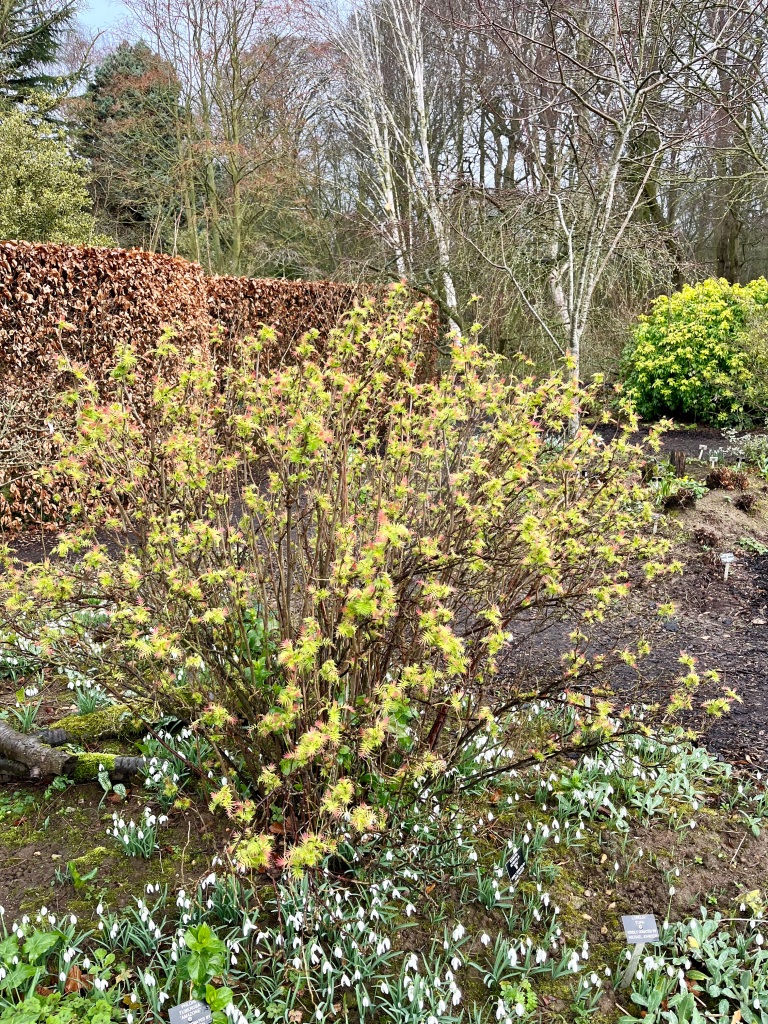

Winter flowering cherries also looking very cheerful and brighten up a cold wet day.
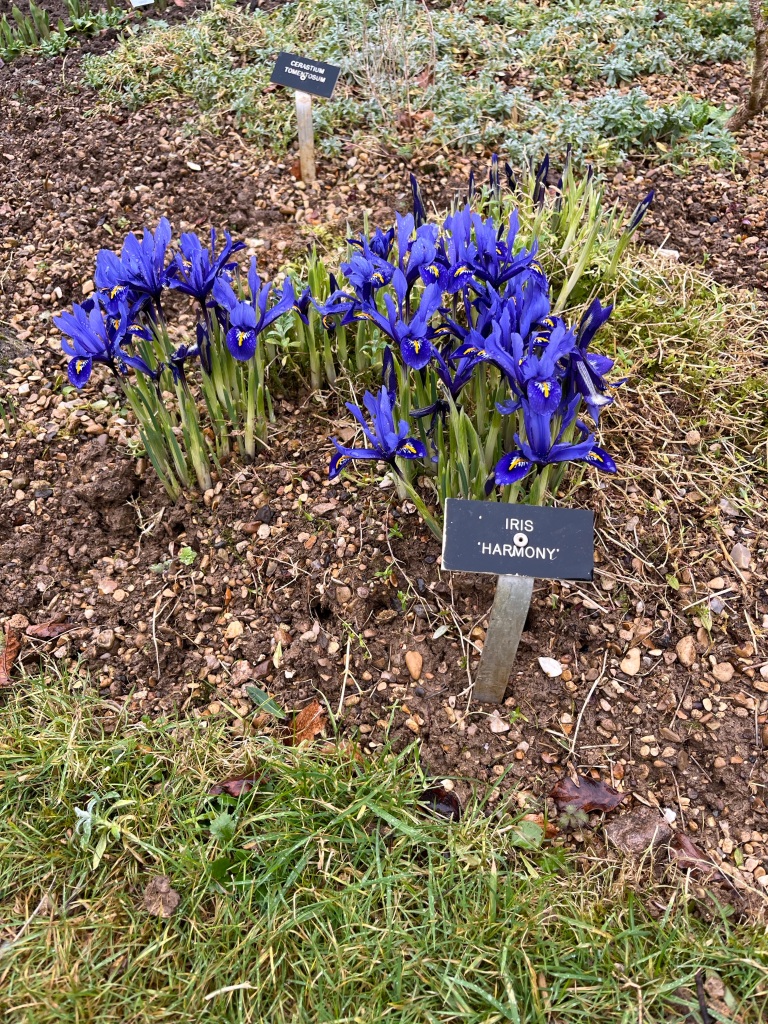
This little Iris Harmony pops up in patches all over the garden.

Nick Hamilton took over the garden when Geoff died and has continued to plant and develop the plot. There are 38 individual gardens over an 8 acre site.

We continued the tour through the Woodland garden, and on to the impressive vegetable plots where courses are held throughout the year on growing fruit and vegetables and pruning. The gardens are run along organic lines, as Geoff set out to do. Nick continues to grow organically without chemicals and with wildlife in mind.
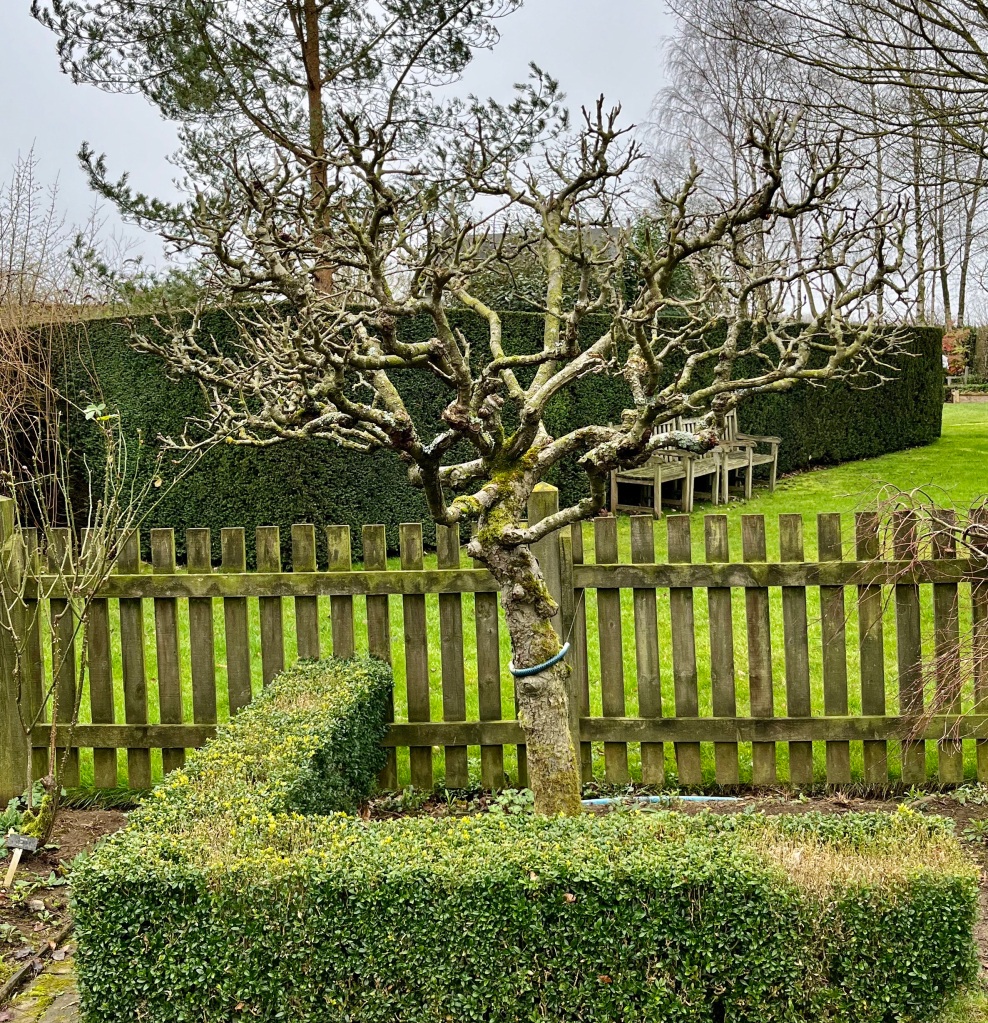
Nick explains how fruit trees can be grown in small spaces by choosing dwarfing rootstocks and by pruning.

These espalier fruit trees take up little space and form an attractive shape throughout the year. There will be blossom in spring and apples and pears in late summer.

These small fruit trees are part of the Dan Pearson cottage garden.

I couldn’t resist a peep inside that beautiful little greenhouse.

I found scented pelargoniums, some still in flower in February.

And succulents and cacti, alongside trays of seedlings growing on for planting out later in spring.

I must mention the cafe, which served a very tasty and substantial cooked breakfast before our tour. I don’t usually eat a hot breakfast, but tried the vegetarian menu and can highly recommend it. A lovely warm start to a few hours spent walking around the gardens. And there was just time to try the tea and cakes at the end of our tour! It would have been rude not to sample them! The lemon sponge is divine!
For more information on Nick’s walk and talks and other events through the year take a look at the website here:
https://barnsdalegardens.co.uk/
I’ll be going back for more events. There’s plenty on offer for Mother’s Day on 10th March and Easter between 29th March and 1st April (including Easter egg hunts for children). The gardens open all year round, only closing at Christmas, 24th, 25th and 26th December.
Note: I was invited to this event as a guest. I’ve given my honest review of the morning. I can highly recommend the ‘walk and talk’ events. A lovely breakfast followed by a wander around a beautiful garden is just what’s needed after such a cold, dark, wet winter, just as the garden is starting to wake up and shine. I feel invigorated to add much more colour to my own plot. And I’m searching for that very pretty snowdrop.
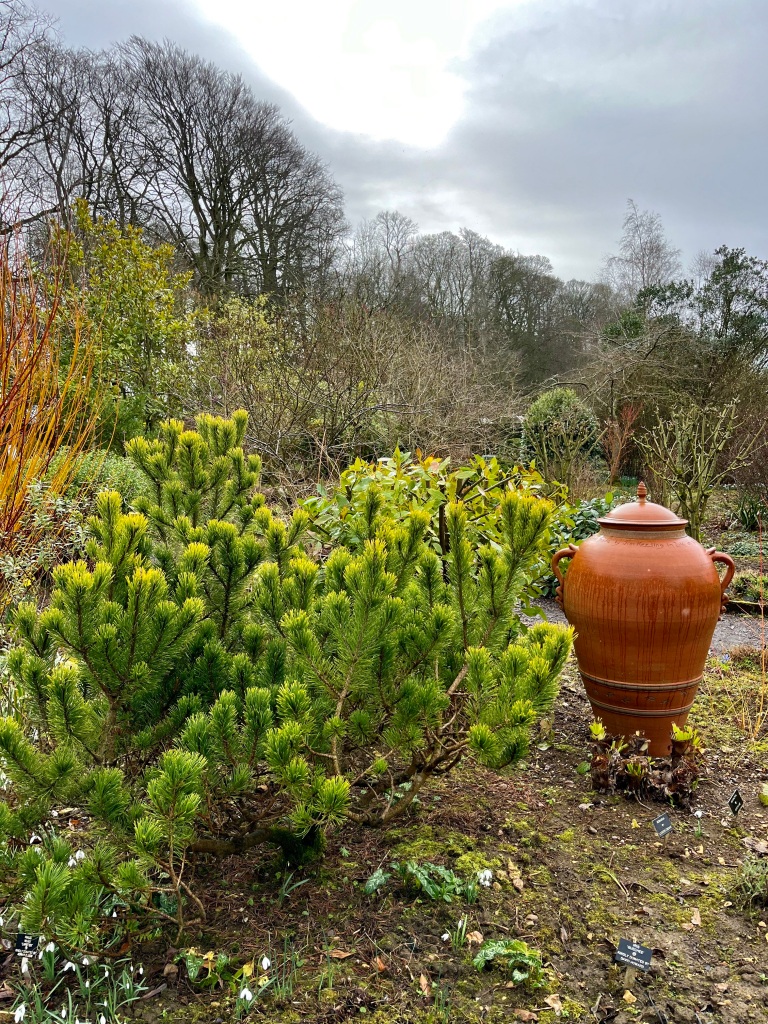
I hope you’ve enjoyed this ‘winter tour’ of Barnsdale Gardens. Have any of you visited in winter? I’ve only ever visited in summer before, so it was a revelation how much there’s to see. Get in touch and share your favourite part of Barnsdale. I haven’t even mentioned the Paradise Garden! That will wait for next time….
Ghosts of the garden. Seeds and fluff.
In a Vase on Monday.

Spring bulbs are just starting to peep through the waterlogged ground. Before I start to pick the dainty cyclamen, crocus and snowdrops, I want to pause for a moment and appreciate all the seed heads, grasses and twigs that have kept me going through winter. These are the ghosts of the garden, the faded flowers, still beautiful in skeletal form.
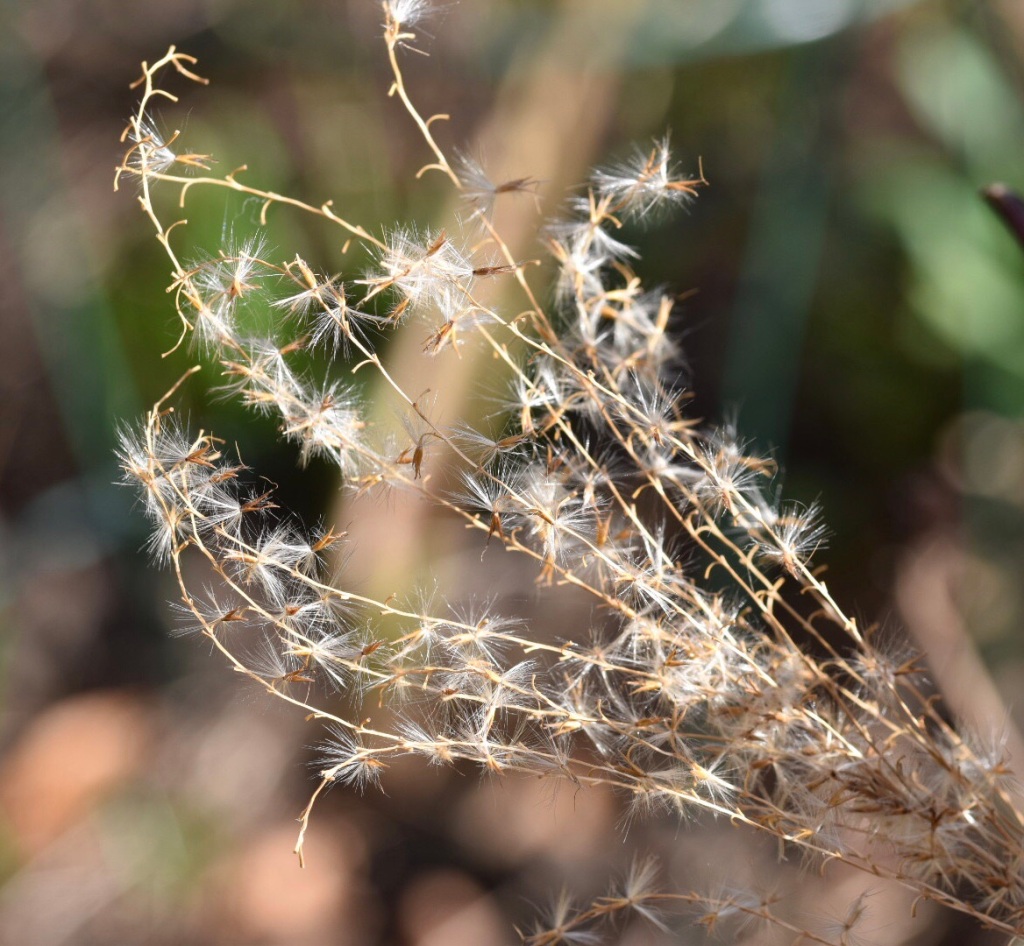
It’s amazing these grasses haven’t disintegrated in the rain. I can’t ever remember a wetter winter. Currently the snowdrops are just emerging from 6” of water. Luckily the borders seem to drain after three or four days. So far, only the salvias have given up the ghost. There are pots of cuttings in the greenhouse to replace them.
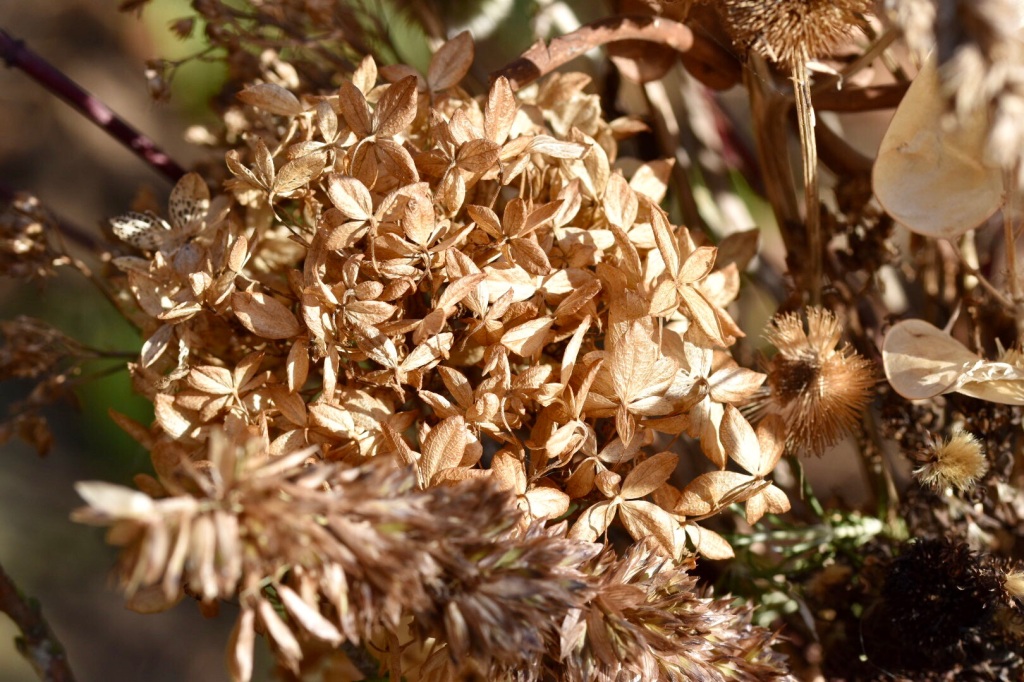
Hydrangea flower heads. I’m just thinking of trimming theses off now. Little green shoots are showing along the stems. Dried flowers help to keep the frost off emerging buds. They look stunning covered in frost and snow- not that we’ve had much of either so far….

Lovely to see the veins in the flowers. I probably look closer at hydrangea flowers in the winter than I do in summer. There’s fewer distractions and more need for something cheerful to focus on.

Allium Christophii blowing round the garden like tumbleweed. I quite like to see them meandering from one place to another. I probably will regret them spreading their seed everywhere though.

Honesty seed pods. I haven’t removed all the seeds from the papery silver seed pods. A gently occupation for a rainy day. I shall just sit by this arrangement and harvest them.

Shooting stars. Alright, they are echinops really. And not full globes. I watched a flock of long tail tits demolish these. A sight to gladden the heart mid-winter.

More seeds half consumed. I hope my seeds have helped to keep some creature alive over the cold, dark months. This is a perennial sunflower.
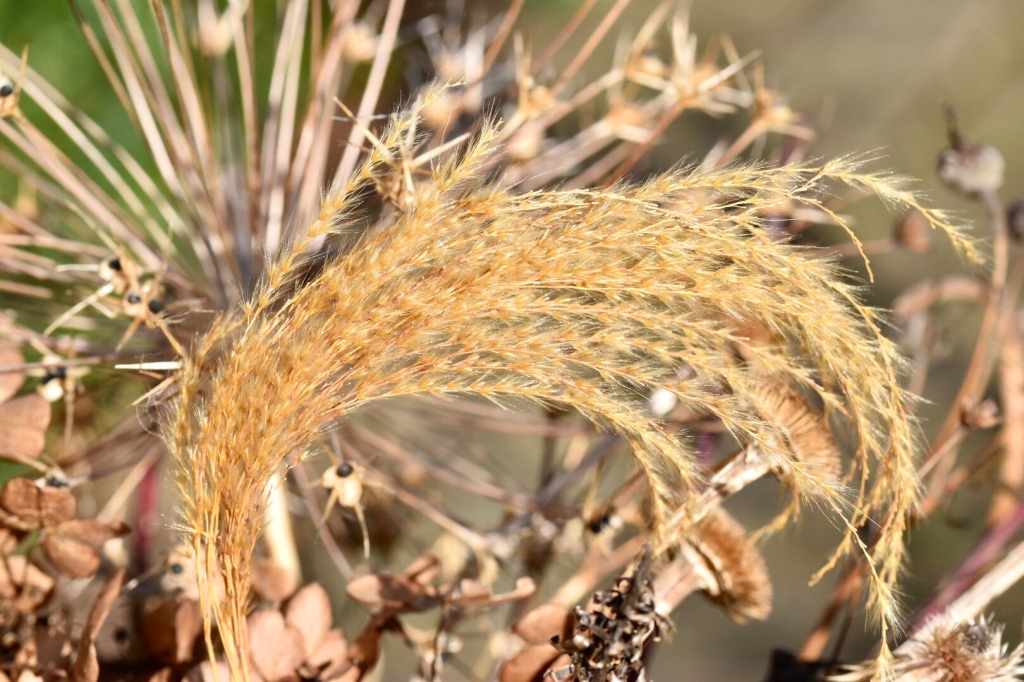
Another flowing ‘tail’ of grasses.
Have a look at Cathy’s site for more In A Vase on Monday.
https://ramblinginthegarden.wordpress.com/2024/02/12/in-a-vase-on-monday-a-vase-of-vegetables/
Thank you for reading my blog. Get in touch and let me know if you have cleared away your old flower heads and twiggy stems, or are you still waiting for the right moment – and the right weather!
David Austin Roses and Emma Bridgewater create a charity fund-raising mug
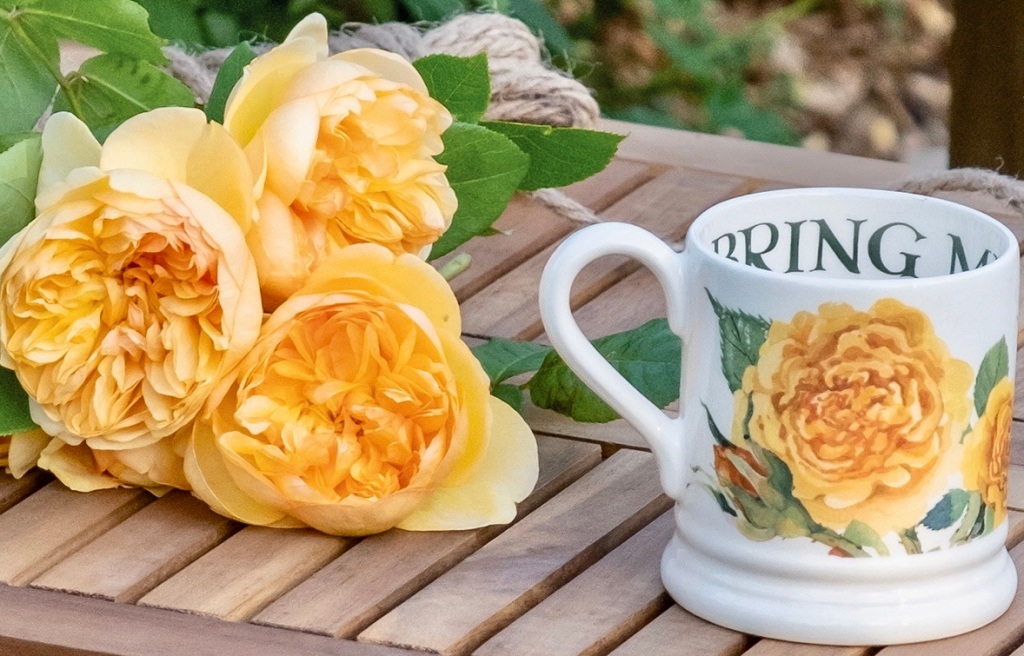
Getting 2024 off to a positive start, Emma Bridgewater and David Austin Roses have announced their collaboration in support of the National Garden Scheme.
The iconic British pottery brand Emma Bridgewater has joined hands with famous rose grower David Austin to design a mug honouring their joyful Bring Me Sunshine® (Ausernie) English rose – named after the heart-warming tune made famous by comedy duo Morecambe and Wise.
“As huge admirers of Emma Bridgewater’s work, we’re thrilled to not only see one of our most popular roses adorned onto the mugs but also dovetail our efforts to support the National Garden Scheme, a charity we each value greatly,” said David Austin.
Chosen because of its mood-boosting apricot and golden yellow colouring that translates beautifully onto pottery, the Bring Me Sunshine Half Pint Mug is an exclusive creation that celebrates great British craftsmanship and the country’s many glorious gardens.

It is available from the National Garden Scheme online shop here. It can also be purchased directly from Emma Bridgewater, David Austin Roses or as part of David Austin’s new gift box that comes with the mug, one of our National Garden Scheme A5 illustrated notebooks and a voucher for any David Austin rose, with Emma Bridgewater directly donating £5 to the National Garden Scheme for every mug sold.

Commenting, Chief Executive of the National Garden Scheme, George Plumptre said: “We are thrilled to have the support of this power duo of iconic British brands in helping us to raise funds and awareness of our work in 2024. The Bring Me Sunshine mug and rose exemplify the joy that gardens and a great mug of tea can bring, and the exclusive access to Mr Austin Senior’s garden in June is something extraordinarily special which we know garden visitors will love.”
More about the June event to follow in the next post!

Do you have a special mug you always use? Mine is a China cup my grandmother used to have. I also have the Emma Bridgewater Christmas mugs and some with birds. I’ll definitely be ordering the new rose mug as it’s a delight to look at and use, and also raising funds for the NGS which last year donated £3.4 million to cancer care and other health and well-being causes. Macmillan cancer care being one that we have needed several times in our family and amongst friends.
Thank you for reading the blog. Please leave your thoughts in the box below and sign up for email notifications of future blogs. They are all about my garden in Leicestershire and garden visiting around the country.
Winter gardens opening for the NGS
A morning of inspiring photos of gardens due to open for the NGS really warmed my heart and set me up for getting out and about visiting special places again. Here’s some photos of gardens due to open over the winter. These were highlighted as part of the NGS’s 2024 launch event yesterday. I must say, thinking of all these lovely garden views and beautiful flowers really cheered me up. I hope they do the same for you too!
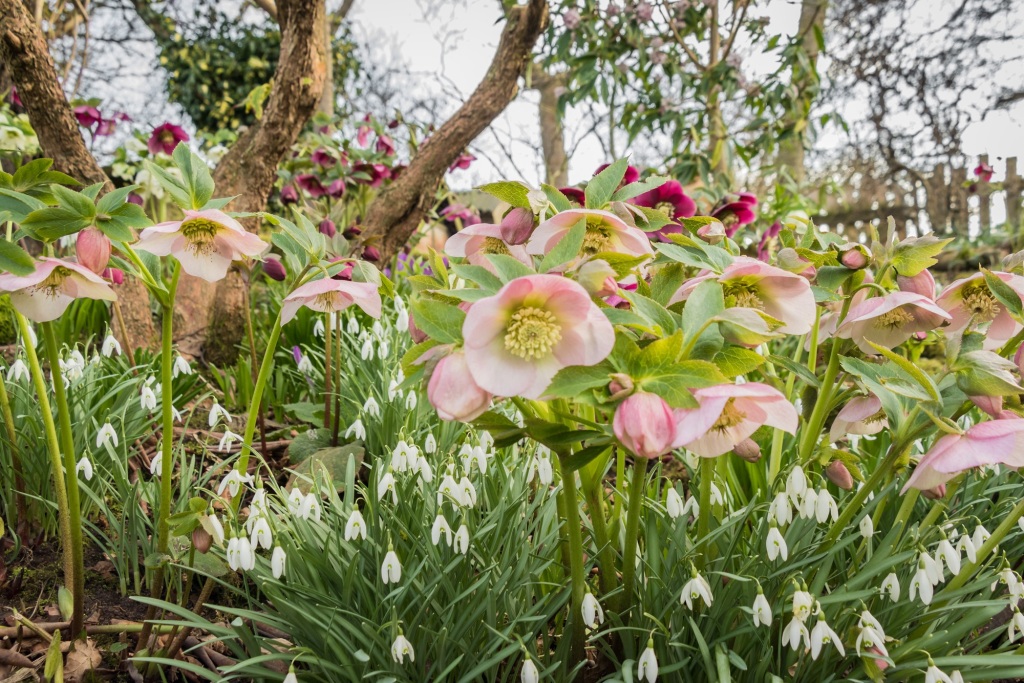
Bucklow Farm in Cheshire opens on 25th Feb. This special, country garden has been created over 30 years. There’s a herb garden,veg plot, meadow and wildlife pond, and is especially well known for its winter flowering displays.

Thousands of snowdrops underplant the special trees, shrubs and roses.

Hellebores especially do well at Bucklow Farm. The address is Pinfold Lane, Plumley, Cheshire, WA16 9RP. Check all dates, times and details before travelling.
https://findagarden.ngs.org.uk/garden/18917/bucklow-farm
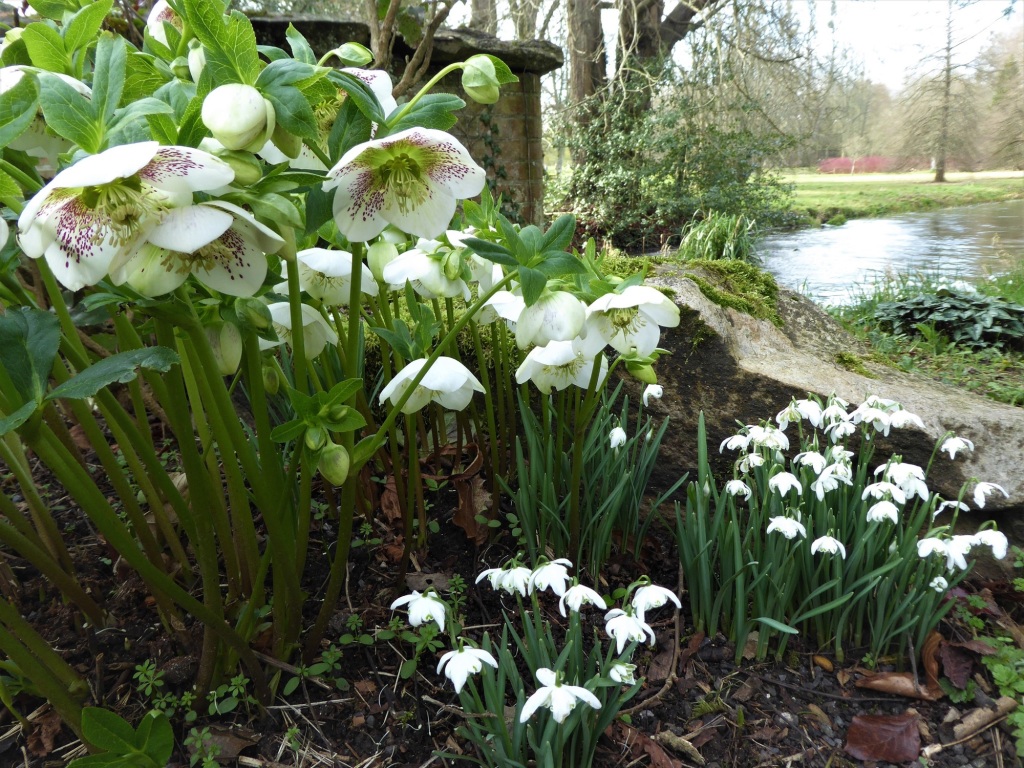
More beautiful hellebores and snowdrops, at Welford Park in Berkshire. This garden has been opening for the NGS since 1927.
https://findagarden.ngs.org.uk/garden/5331/welford-park
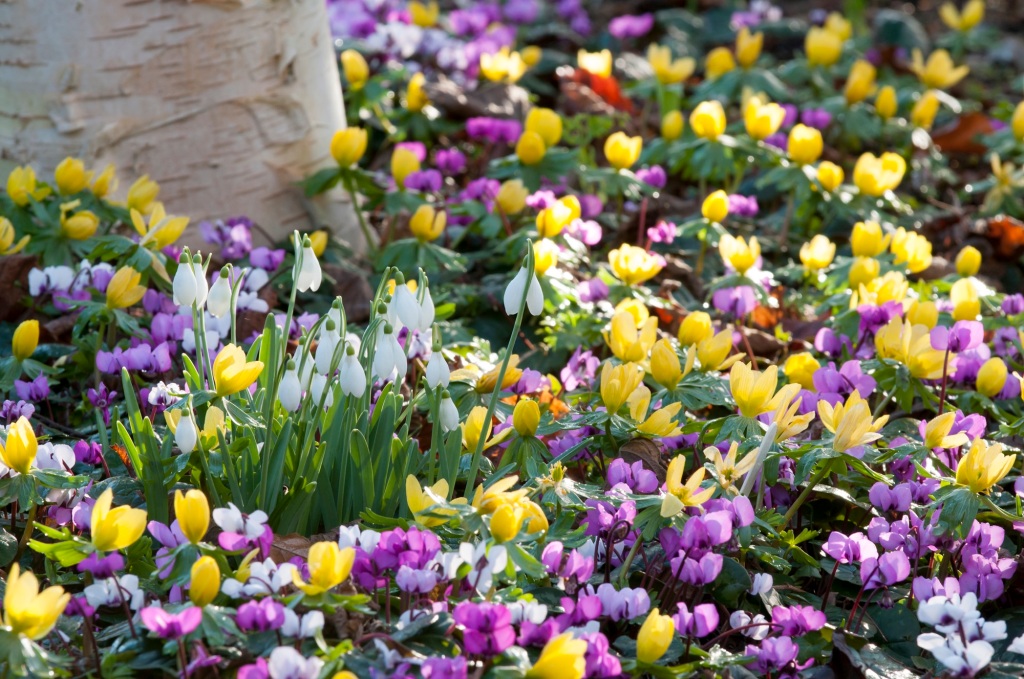
Spring cocktail of colours. Galanthus Melanie Broughton, yellow winter aconites and pink cyclamen coum. Gable House, Suffolk.
https://findagarden.ngs.org.uk/garden/7098/gable-house
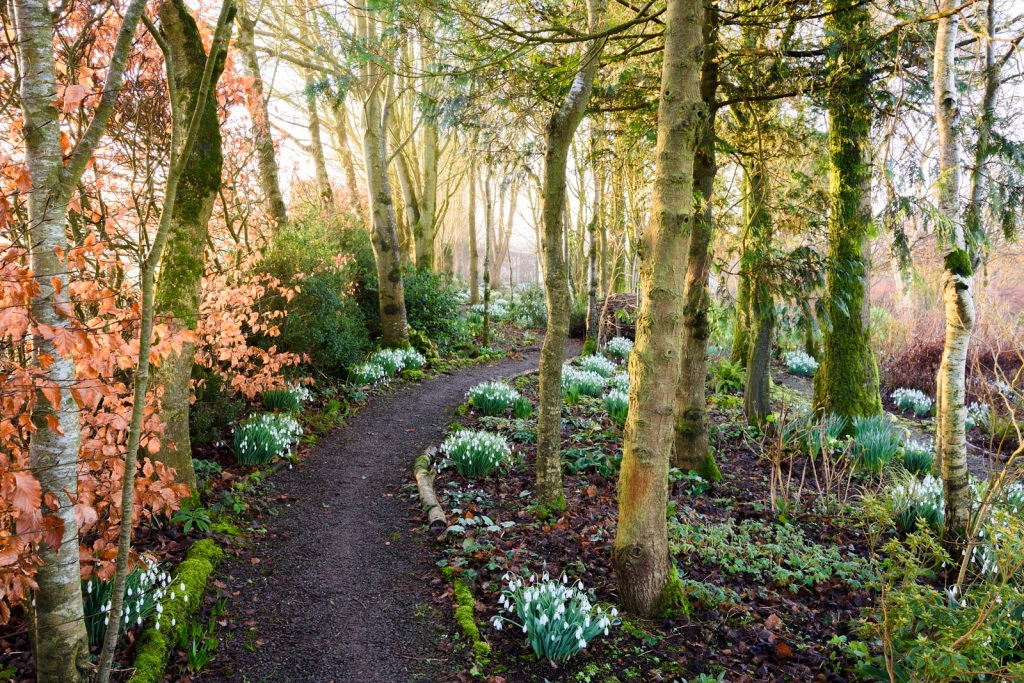
Higher Cherubeer, Dolton, Devon. One and three quarter acres of gardens with 400 varieties of snowdrop and the national collection of cyclamen species.
https://findagarden.ngs.org.uk/garden/17164/higher-cherubeer

The Old Rectory, Fawkham

https://findagarden.ngs.org.uk/garden/32008/the-old-rectory-fawkham
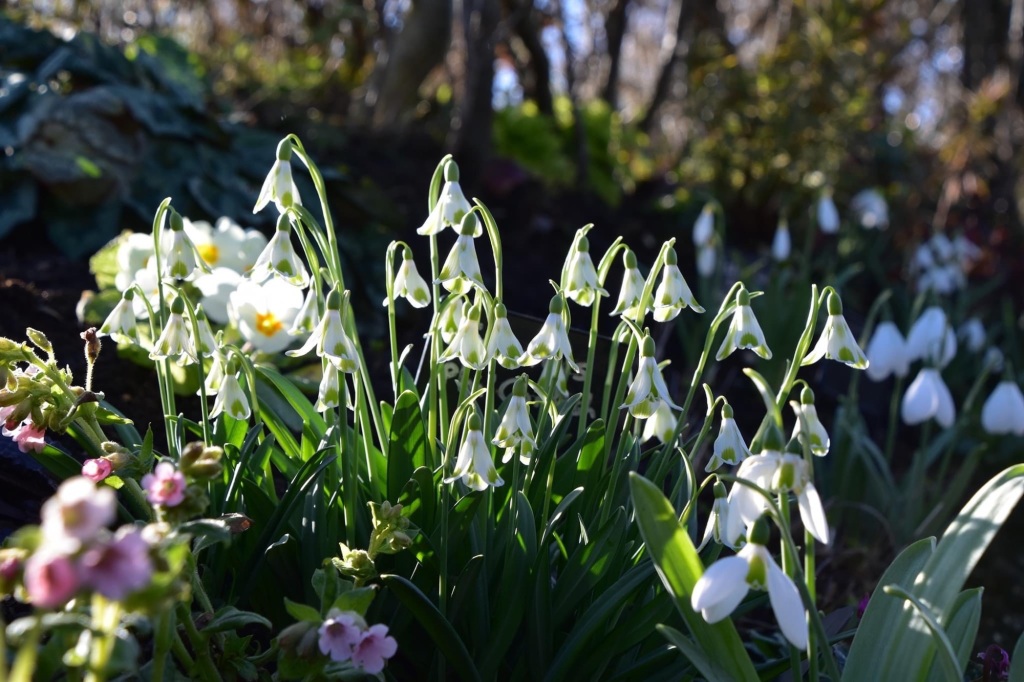
And in Leicestershire, hundreds of snowdrop varieties on display at Hedgehog Hall.

https://findagarden.ngs.org.uk/garden/21608/hedgehog-hall
There are around 100 snowdrop and spring-flowering gardens opening for the National Garden Scheme this year.
Over the whole year, 3,372 are scheduled to open. 575 are new to the NGS. 333 gardens are returning to the charity after a break. Nearly 1,000 gardens open ‘by arrangement’ where groups and individuals can arrange a visit at a mutually-agreed time for an exclusive tour of the garden. 2,681 offer refreshments, and 1,682 welcome dogs (very much appreciated by our spaniel Meg- who doesn’t like being left at home).
It was absolutely heartening to hear that 2023 was a record-breaking year for the NGS enabling them to give away £3.4 million to cancer care and other health and well-being charities. The NGS has been helping Macmillan cancer support for 40 years and has donated almost £20 million to them during this time. Personally, our friends and relatives have benefited from this care and we are truly grateful to the wonderful nurses at Macmillan. Many of you will also know that my youngest daughter is a nurse and my eldest daughter also worked for a children’s hospice. So I’m fully behind the NGS as they are a powerful and staunch supporter of nurses.
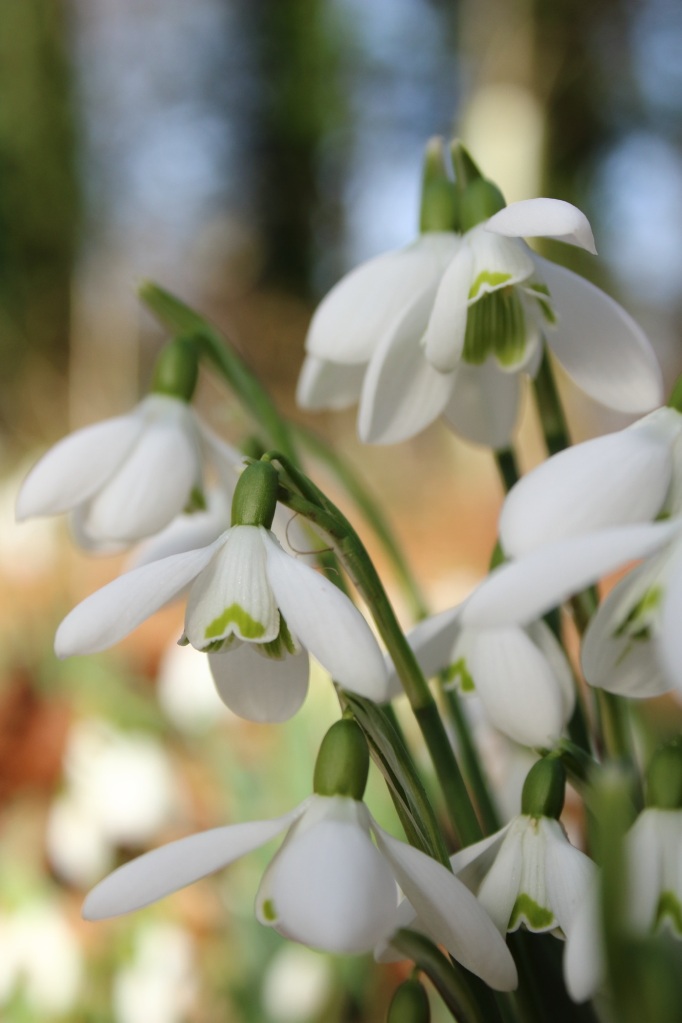
https://findagarden.ngs.org.uk/garden/34092/chawton-house
Thank you for reading my blog. Please leave a comment in the box below, and sign up for e mail notifications of further blogs.
Yesterday’s blog was about garden designers opening their own gardens for the NGS. Read it here:
https://bramblegarden.com/2024/01/25/national-garden-scheme-launches-its-2024-campaign/
Dahlias now sleeping under a duvet of dried leaves
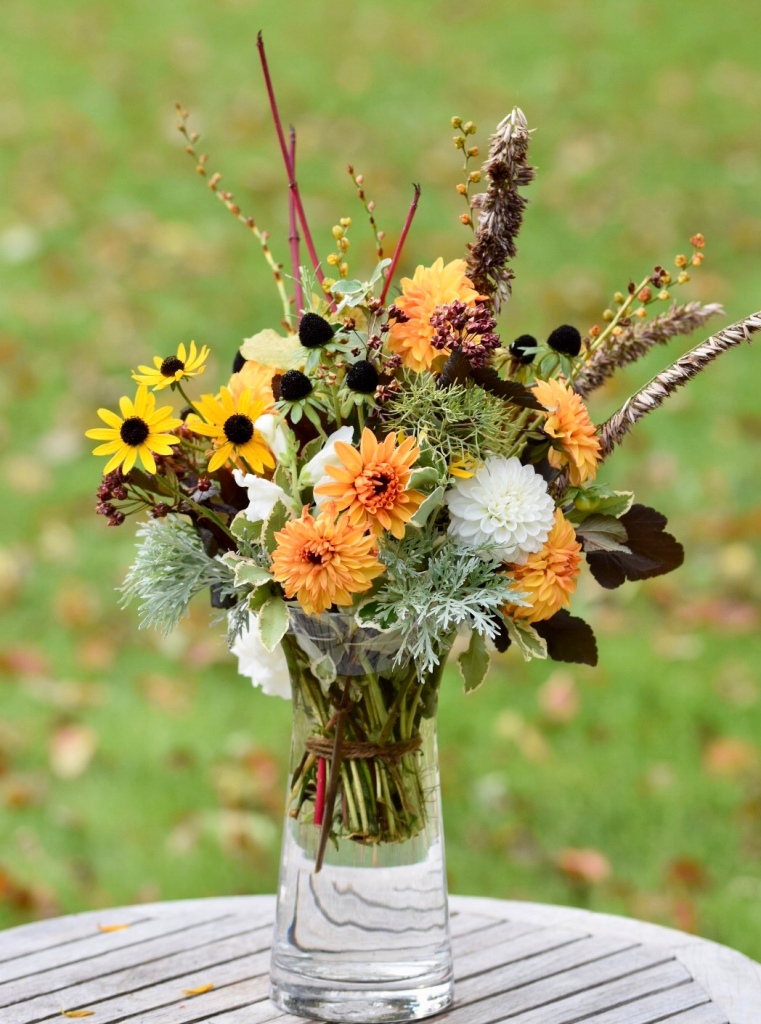
We’ve had a very mild and extremely wet autumn, but flowers continued to bloom right through until the last week of November. This week’s ‘flowers in a vase’ were picked then, to take to my mum, but never made it as I caught a really bad cold. Mum must not catch any infections, so I stayed at home and sent photos of the flowers instead. It’s not quite the same, but I dare not risk spreading germs, and staying at home was the only option. So although these are a few weeks out of sync, I thought I would share them with you anyway, so you can see how late in the season you can still have flowers to pick from your garden.

My home-grown posy features my favourite Dahlia David Howard. As the season gets later, the flowers get smaller and smaller, but just as beautiful, and buds will continue to open if they’ve not been too frosted.


While they are not the dinner plate-size blooms of August, a small handful of dahlias will make a colourful arrangement. Also growing amongst the dahlias is perennial rudbeckia Goldsturm and white Antirrhinum Royal Bride. These fill the gaps between the dahlias and come back every year.
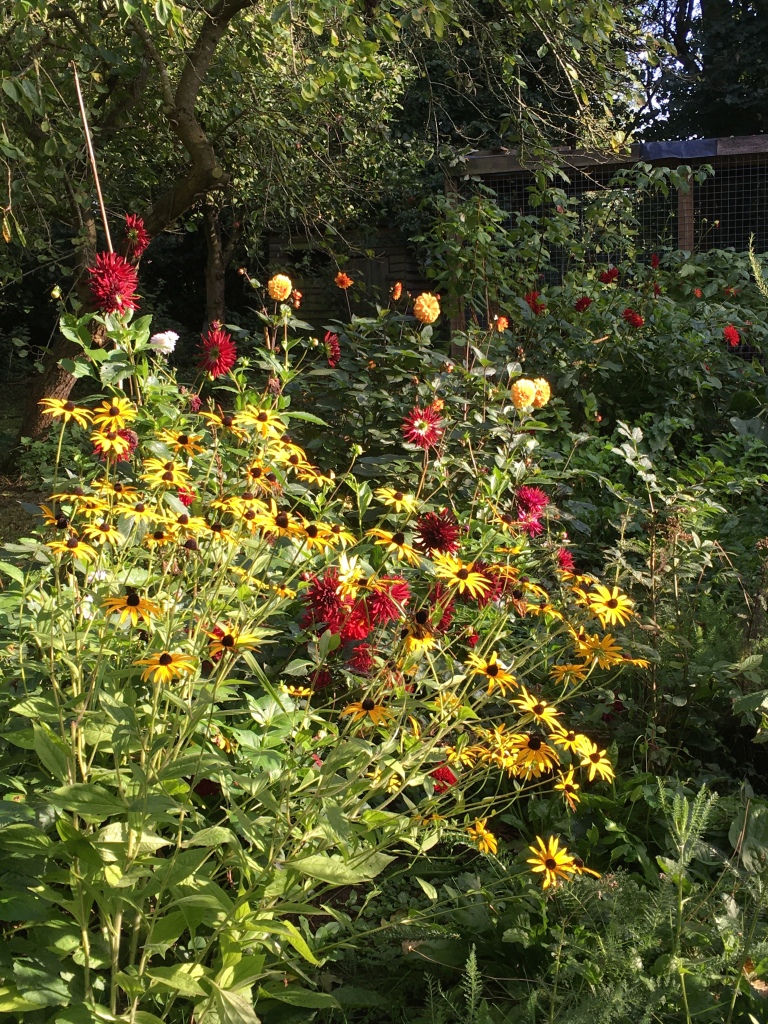

I pick some of the rudbeckia seed heads. They may not have petals, but the glossy black bobble heads add another element to the bouquet, and in November when material is scare you can’t be too fussy.

I love the bronze shiny leaves of Physocarpus Diabolo. Another good shrub to grow as the foliage stays on the plant until early December and comes back into leaf in early spring.

Physocarpus flowers are a pretty addition, but the real glory of the plant is the jewel-like seed heads which can be picked and dried for winter use. They remind me of pomegranate seeds and are perfect for Christmas decorations.

I use a lot of herbs in my bouquets; lavender, sage, rosemary, thyme, and this lovely lemon-scented herb which I’ve forgotten the name of….. perhaps someone out there knows what it is called. I have it growing along the front garden path and I run my fingers through it every time I walk to the front door. It grew from a cutting from my mum’s garden and of course, I think of her every time I see it.

Other foliage I use all the time is Artemisia Powis Castle, and very similar Senecio Viravira. The artemisia flops if it’s not plunged up to its neck in cold water over night, but the senecio is trouble free and probably my favourite. Artemisia grows up through the sweetpeas, and the senecio is in pots in the poly tunnel to give me year-round foliage.

Another useful evergreen is pittosporum, I think this one is Silver Queen, growing in a huge half-barrel size pot by the greenhouse. I might actually plant this in the ground over winter as it was hard to keep it watered last summer. It doesn’t seem to mind having a few 6” stems clipped from it every week. The white and pink edge to the leaf seems to go with any flower combination you can think of.

Eucalyptus grows enormous, but regular trimming for my cut flowers keeps it under control. If I have any surplus I give it to the village florists who is always grateful for spare foliage.

I’ve mentioned rosemary already. I have the popular Miss Jessup upright form, and this gorgeous more tender weeping form. I’m planning to wrap this with a few layers of horticultural fleece this winter to protect both plant and very precious Italian pot. I’ve lost a lot of terracotta pots over the last few winters, ones that were 20 or 30 years old. The incessant rain followed by freezing temperatures caused them to crack. I’ll make sure pots are standing on slivers of slate so they drain well and don’t freeze to paving slabs.

Speaking of winter, this is where my dahlias are now, cut down and cosy under a mulch of dried leaves and compost. The cloches will help to keep the worst of the rain and frost off the tubers. I haven’t got enough space to store tubers frost free, and anyway, the mice nibbled them in the potting shed last winter. So I’m taking a chance and leaving them in the ground. Fingers crossed they survive and come back to provide lots of cut flowers for my mum next summer.

Daphne’s offspring is on slug patrol, meanwhile. Slugs being the main worry when the new shoots emerge next spring.

When all that work was complete covering up the dahlia beds, I stood at the top of the garden, leaning on the five-bar gate, and admired this favourite tree. It holds its leaves until mid December, when suddenly the wind blows and there are puddles of gold spread across the field. A gorgeous sight I never tire of. Thank you for reading my blog. Happy gardening!
Please leave a comment in the box below and sign up for e mail notifications for more blog posts.
And check out Cathy’s ‘In A Vase on Monday’ where gardeners all over the world share what they are growing and arranging in their vases each week.
Winter cuttings on BBC Radio Leicester

If you were listening in to BBC Radio Leicester on Tuesday, you’ll have heard me talking about taking winter, or hardwood cuttings. We were taking dogwood cuttings this time.

Here’s the link at 1.26 on the i player timeline.
https://www.bbc.co.uk/sounds/play/p0gv6761?partner=uk.co.bbc&origin=share-mobile

I use dogwood in almost all of my jam jar posies for my mum. It makes a lovely vertical accent, and helps to support the weaker flower stems. Here stems are supporting paperwhite narcissi and daffodils and tulips from the cut flower patch. These are Dutch Grown bulbs.
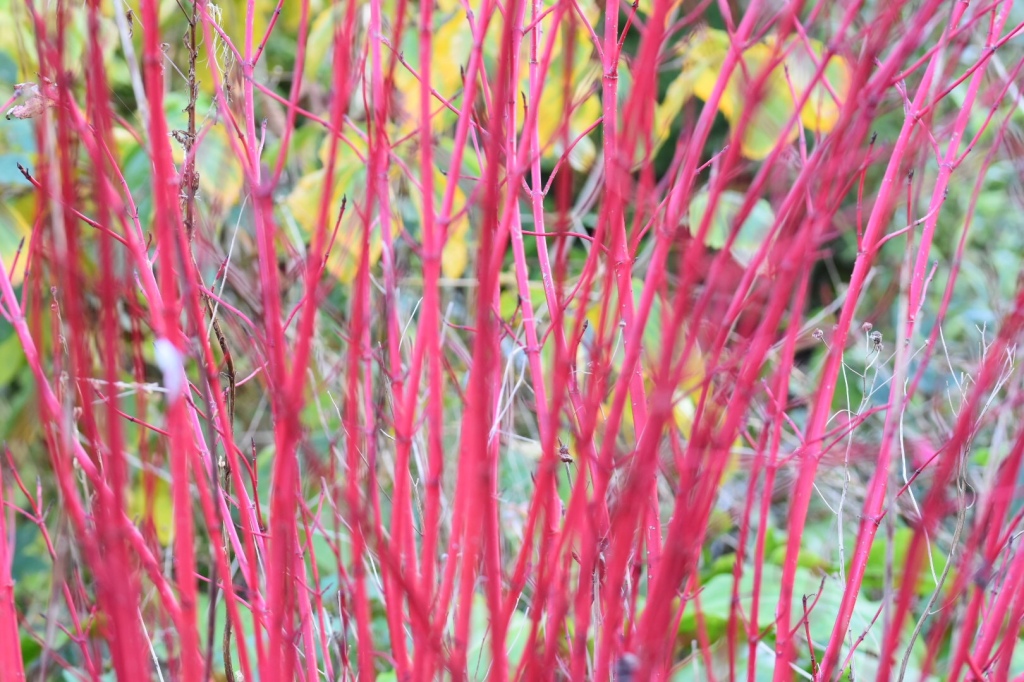
My favourite dogwood is the bright red Westonbirt which really glows all winter with sunlight behind it.

Here it is with Dahlia David Howard, persicaria, sedum and grasses. I love the red stems shining out and glowing in the jam jar water.

This time, the jam jar flowers are chrysanthemums and salvias set off with grey-leaved senecio viravira and golden oak leaves which dry and can be used all winter.
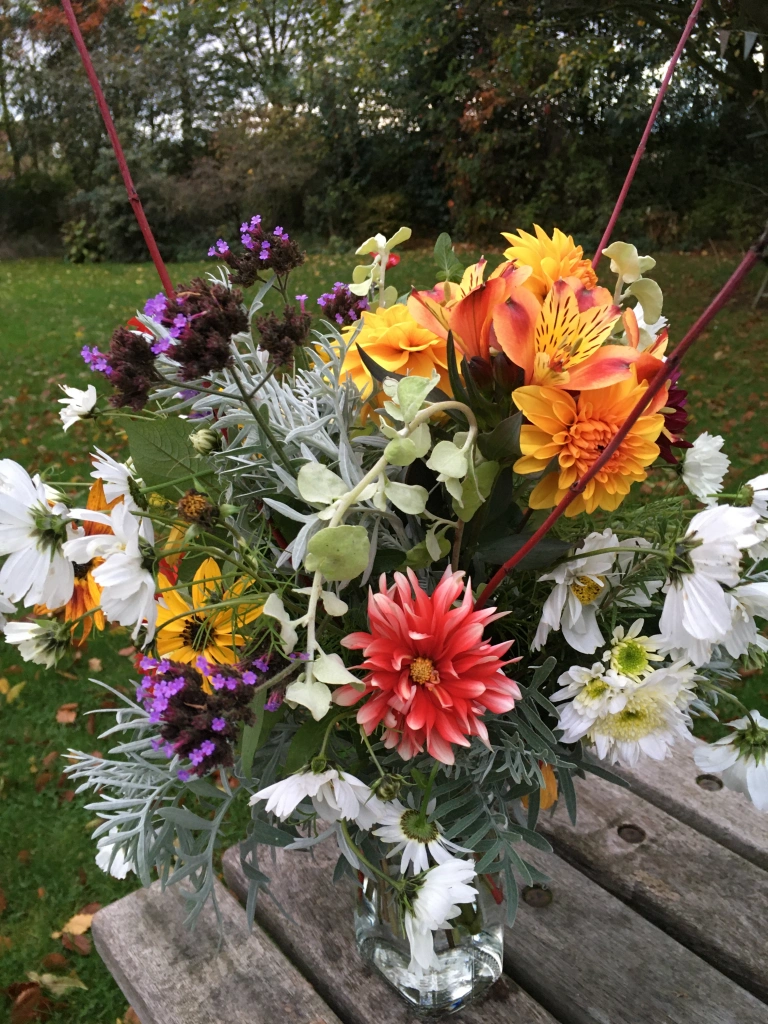
More dahlias including a red unnamed seedling, Alstromeria Indian Summer and cosmos Psyche White grown from Mr Fothergill’s seeds.

Salvia Phyllis’s Fancy, chrysanthemum Swan and the last of the dahlias and rudbeckia. And a tiny sprig of orange abutilon at the front.
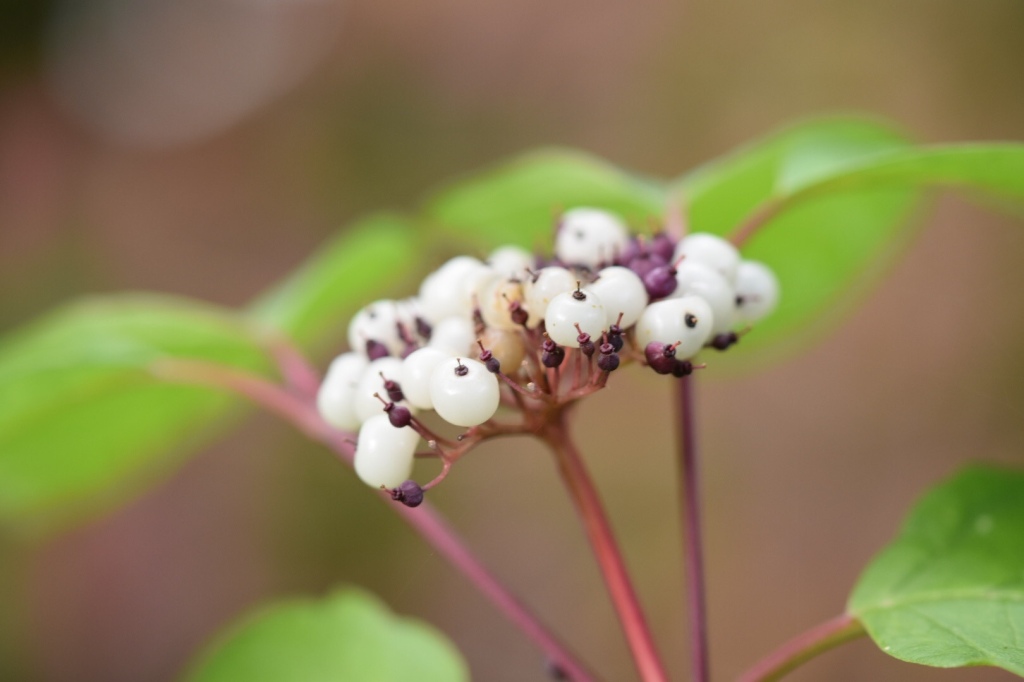
Dogwoods have fabulous berries which look like pearls.
Continue readingChris Beardshaw Lecture for Leicestershire and Rutland Gardens Trust.
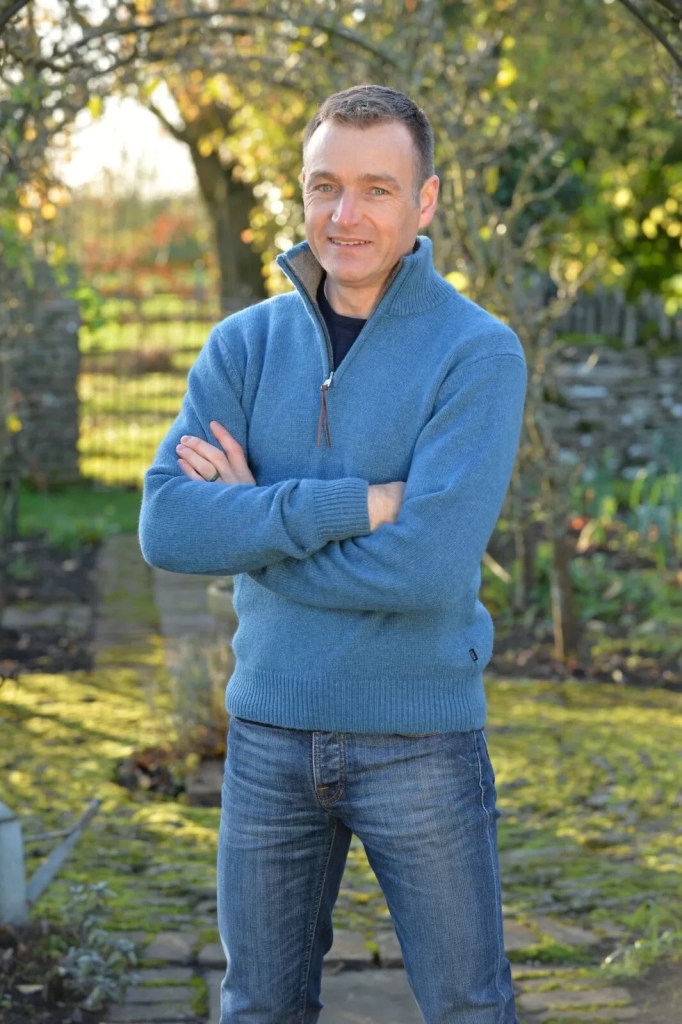
Here’s the link for tickets and information for the LRGT winter lecture. This event supports the trust’s ‘Schools into Gardening Scheme’ which I’ve written about on the blog before.
Information shared from the LRGT website:
“Chris Beardshaw was our Celebrity Lecturer back in 2011. Everyone who heard him on that occasion remembers an entertaining and informative speaker. So, we are anticipating a similar evening.
On this occasion, he will be talking about the English Garden. He will look at some background history and the essential elements that make up the English Garden style. He will then detail some of the designs which he has implemented.
About Chris:
Chris needs little introduction as a celebrated designer, plantsman, and broadcaster. He has clocked up over 35 years’ experience in the horticultural world.
Many will know Chris from his long broadcasting career, which began in 1997 and includes BBC2 television hit series such as Gardeners’ World, Hidden Gardens and the hugely popular The Flying Gardener, amongst many others. These days he is heard by millions as a panellist on BBC Radio 4 Gardeners’ Question Time where he regularly faces a live audience of gardening enthusiasts!
Chris trained in Landscape Architecture (post grad) and Horticulture which makes him a rare combination in the design world and this enables him to combine both disciplines to the benefit of
his clients. His enthusiasm for plants, good design and the desire to work in harmony with the natural landscape and wildlife is reflected throughout his work. His successful design business has
been established for over 20 years and allows Chris the creative freedom to work with private and commercial clients on a wide range of projects across the UK and internationally.
Some of his public schemes include: Le Manoir aux Quat’ Saisons, Royal Parks (Greenwich Park), English Heritage (Mount Grace Priory and Carisbrooke Castle), National Trust for Scotland –
Pitmedden.
Chris has produced award-winning schemes at all RHS shows as well as many international flower and garden shows. Chris Beardshaw Design has achieved close to 40 industry awards, including 15 RHS Gold medals, 6 RHS ‘Best in Show’ and 6 RHS/BBC People’s Choice Awards and a growing number of prestigious international accolades.
Chris has taught students at degree level and was a full-time lecturer at Pershore College from 1997-2001. He has been external examiner at many teaching institutions including Falmouth University and Duchy College.
He has also written a number of books and his book ‘100 Plants that almost changed the World’ won an Independent Publishers award in the USA.
Chris is proud to be an RHS Ambassador.
Venue: Sir Bob Burgess Building Lecture Theatre, Leicester University,
LE2 7TF.
Note that this is a new lecture theatre and is in a different part of the University to last year’s event.The car park is located on Putney Road, Leicester LE2 7TG. The carpark entrance is opposite Nixon Court accommodation. See site map.
This is a ticketed event. Cost: £15 (includes a glass of wine or soft drink.).
For more information or to book contact Fliss on 07788 644887 or email flisshector@gmail.com
All profits from this event will go to support the Trust’s “Schools into Gardening” scheme.
Each year we raise money from our Annual Lecture which, together with donations from members, enables us to support a range of educational projects. Our aim is to help schools and parents encourage children to love gardens and landscapes, through visits and hands-on gardening activities.”
I wholeheartedly support the trust’s projects to encourage children to garden. One year, they funded a coach load of primary school children to visit Kelmarsh Hall to learn about growing food and cooking home-grown produce. Some of the children had never visited a walled kitchen garden before and it was a sight I’ll never forget as their eyes lit up discovering all the plants and cooking tasty treats! Not to mention discovering bugs, ladybirds and butterflies which delighted them too! Children are the future, and anything we do to encourage them into gardening can only be a really good thing to do!
England’s Gardens. A Modern History.
Book Review and my Book of the Week
By Stephen Parker
Published by Dorling Kindersley, June 29 2023
Hard cover 224 pages. £25
ISBN: 978-0-2416-1157-9

I like to highlight special books on this blog. One of this year’s most beautifully-written and visually stunning is England’s Gardens, A Modern History.

Stephen Parker gives us a modern-day tour and an update on the history of some of the most iconic, enduring, and influential gardens across the country.

The book highlights well-known sites such as Sissinghurst and Great Dixter, and also covers other special and unique gardens such as Prospect Cottage and The Laskett. “It’s a celebration of England’s gardens in all their glorious diversity, sublime beauty, and exuberant eccentricity,” says the press release. I couldn’t agree more!
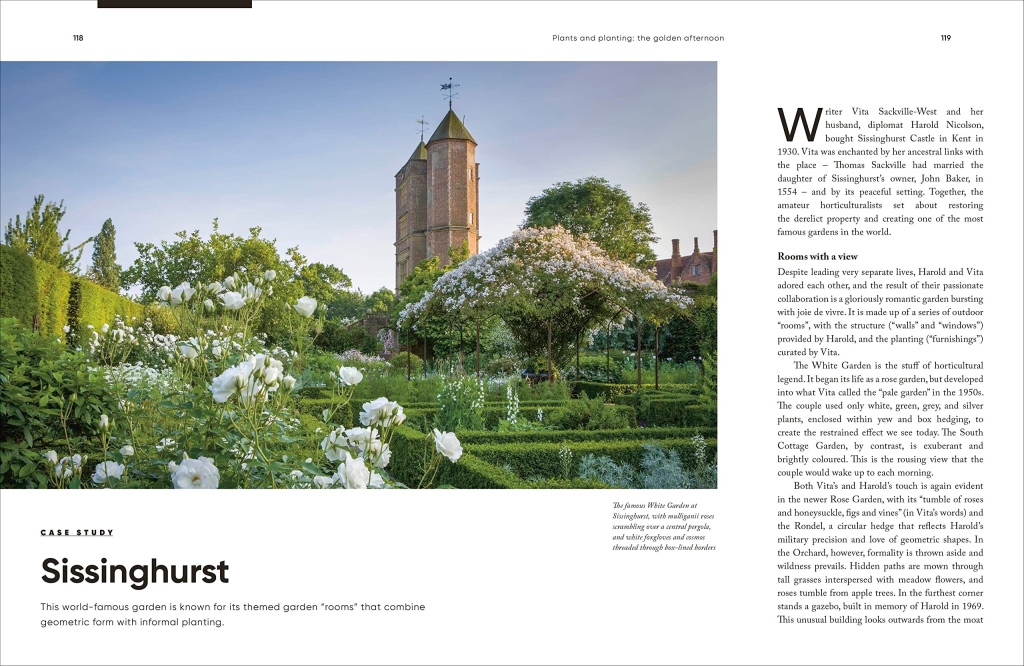





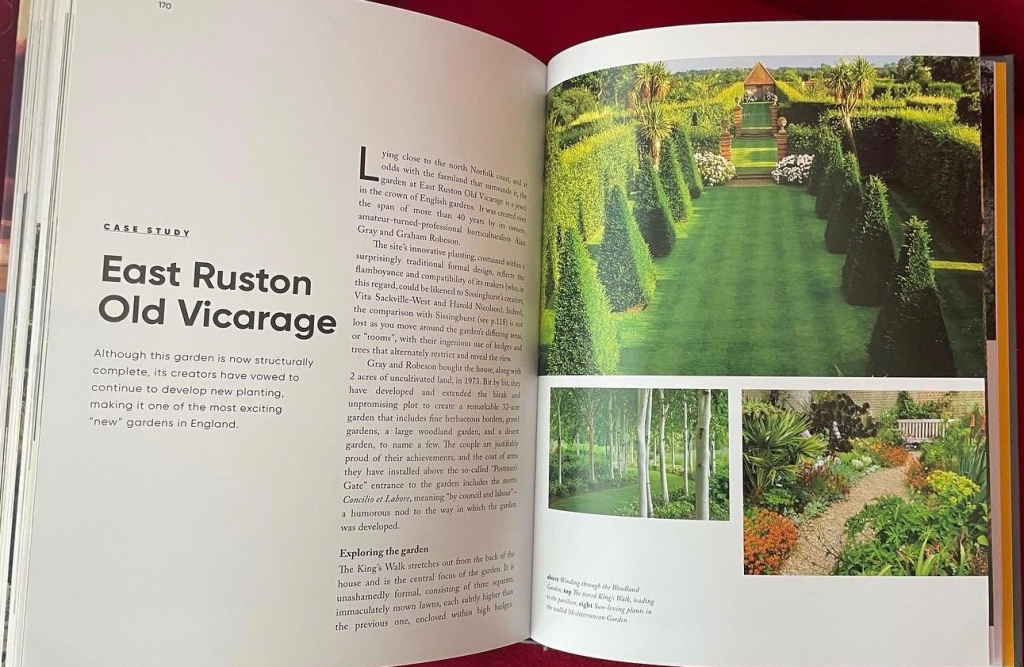
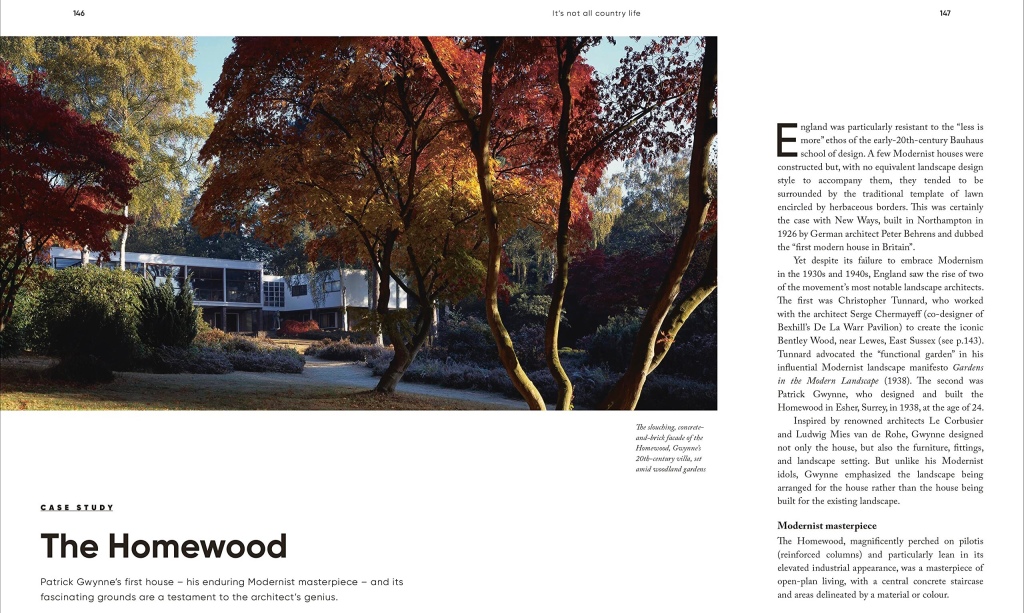

There are 20 case studies in all, with well-written accounts of the stories behind the gardens, the people who made them and the legacies they leave behind. This is another highly recommended publication from the well-respected Dorling Kindersley stable. Some quite remarkable books have arrived on our shelves this summer from DK. This one by garden historian Stephen Parker takes us on a fascinating and joyful journey around Britain. And I enjoyed every minute of my excursion!
https://www.dk.com/uk/book/9780241643808-englands-gardens/
Waterstones https://www.waterstones.com/book/englands-gardens/stephen-parker/9780241611579
Bookshop: https://uk.bookshop.org/p/books/england-s-gardens-stephen-parker/7280290
Hive: https://www.hive.co.uk/Product/Stephen-Parker/Englands-Gardens–A-Modern-History/27638806
Flowers for my mum

Every week I run round the garden and cut a selection of flowers for my mum to show her what’s looking good at the moment. Here’s this week’s posy, with the starring role taken by roses at last. They are a week or two late producing flowers in my garden.

This rose is one of my favourites. It’s called ‘It’s a wonderful Life.’ It was Rose of the Year in 2022, bred by British rose grower Colin Dixon. Colin has won the title 10 times with new roses, so he must be able to spot a winner when he sees one!

I’ve added this lovely highly-scented rose, Timeless Cream, from Wharton’s nursery cut flower range. I also have Timeless Purple, which is highly recommended for scent and for long -lasting flowers in a vase.
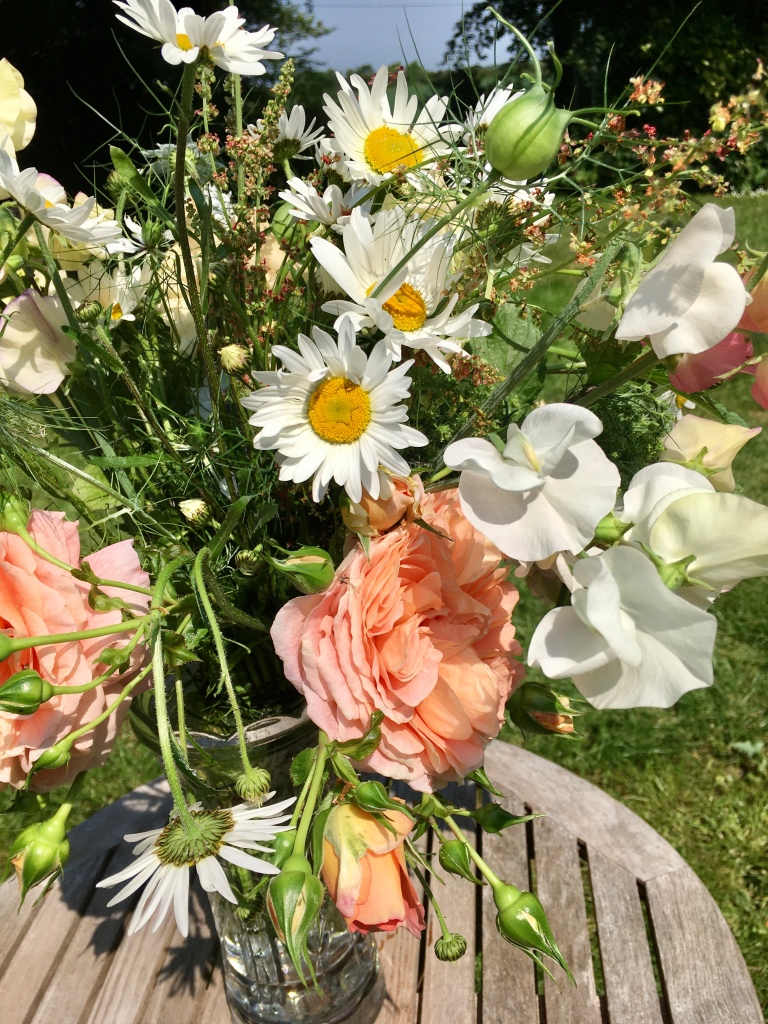
I’ve added white sweet peas and oxeye daisies. I sowed the sweet peas in October and planted them out in April. Seed came from Mr Fothergill’s. Mum grew the oxeye daisies from a packet of mixed wild flower seed and we planted them together about 6 years ago. They are all around the pond area, and also in one of the 10 3x the1.2m beds in front of the greenhouse.


The sweet peas are particularly good this year, having had a cold spring c]which seemed to suit them. Compost for these came from Silvergrow, which is being sold at my local plant centre, Six Acre Nursery. I’m also still using a compost made in Leicestershire by Petersfield.
I hope these photos give you some inspiration to grow your own cut flowers. I use containers as well as a small area of the veg plot. Mostly I just forage around the plot for stems if shrubs and bits and pieces here and there. There’s never a huge amount of any species, but lots of little amounts all through the year.
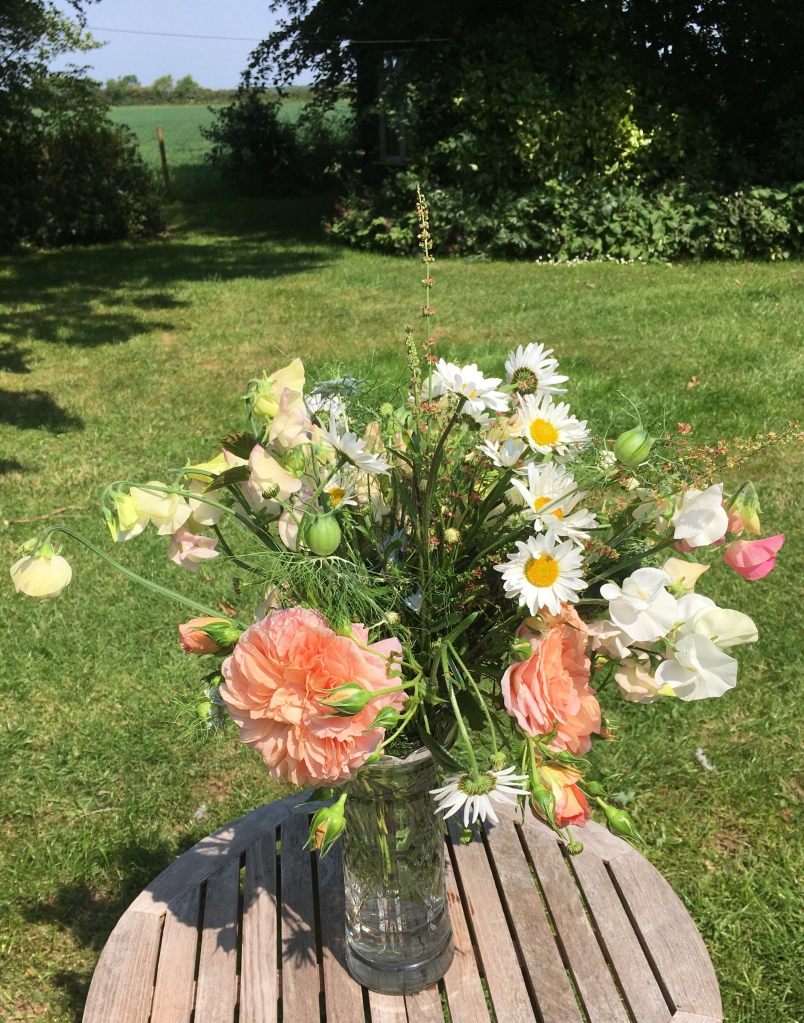
I’m inspired by Georgie at Common Farm flowers who encourages us to join in her daily 30-stem challenge. I also like to join in with Cathy for In a Vase on Monday. She never minds if it’s on a different day. Have a look at her site and see all the flower arrangements being created each week by gardeners all around the world. It’s an awe-inspiring line up! Happy gardening everyone!
I wrote about roses and the Rose of the Year 2024 here:
https://bramblegarden.com/2023/06/14/rose-of-the-year-2024/
https://www.commonfarmflowers.com/
https://ramblinginthegarden.wordpress.com/category/gardens/in-a-vase-on-monday/
Rose of the Year 2024
Roses are among my favourite flowers in the garden, so I was delighted to be invited to the launch party for the Rose of the Year 2024.
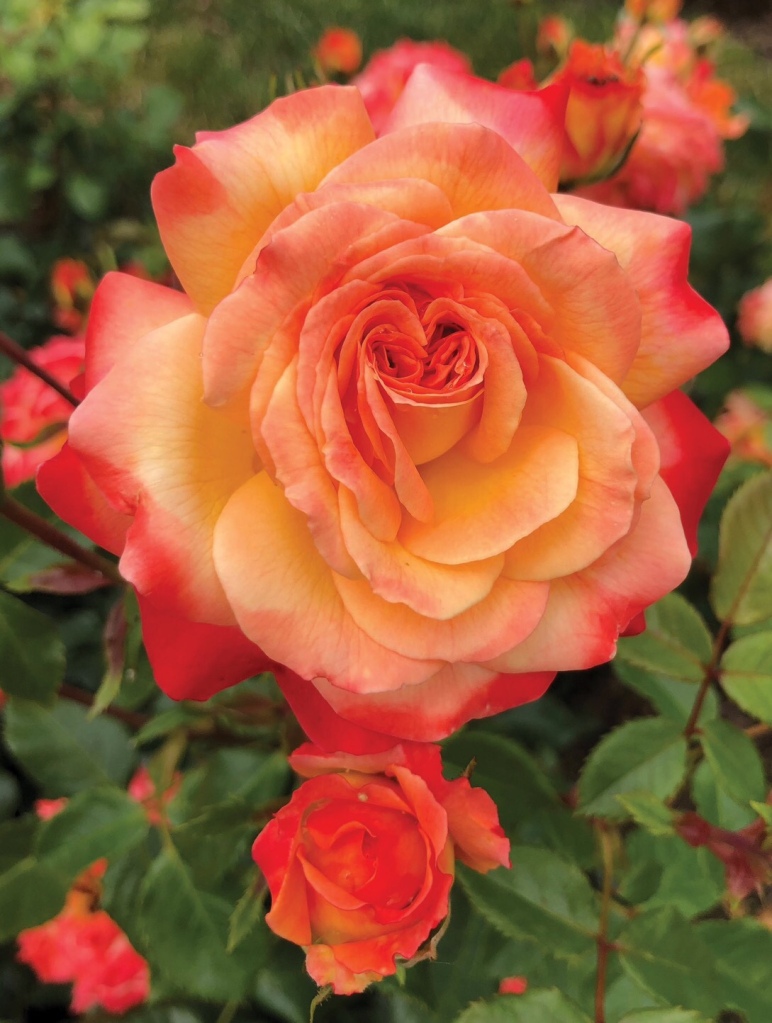
And here it is! Meteor is a floribunda rose with golden yellow flowers, flushed red. This is a later than usual bloomer. I’m fact my sample rose is in bud at the moment (14th June) and looks like it won’t be in full flower for another two weeks. This is a good trait, as it spreads the flowering period in my garden.

The prize-wining rose was chosen as rose of the year because it:
Repeat flowers through the season
Has healthy foliage with excellent disease resistance
Has a bushy growth with erect habit and strong stems
It grows to 70cm high and 40cm wide
Lightly scented, fragrance like fruit salad on a summer morning
Meteor is suitable for pots or containers as well as planting in borders.
Plants will be available this autumn from rose nurseries and garden centres. Meteor was bred by Kordes Rosen, a member of the British Association of Rose Breeders.

Roses UK promotes the Rose of the Year, international rose breeders and British rose growers. Other activities have included theme design and management for the Festival of Roses Marquee at the RHS Hampton Court Flower Show and rose naming projects.
Marilyn Stevens, Roses UK project manager, said: ‘Our mission is to
celebrate roses! We’re keen to encourage gardeners to plant healthy
varieties and to consider companion planting to complement their roses.’ The British Association of Rose Breeders funds Roses UK.
The launch party was held at Waterperry Gardens near Oxford on 13th June, a glorious location for such a prestigious event.
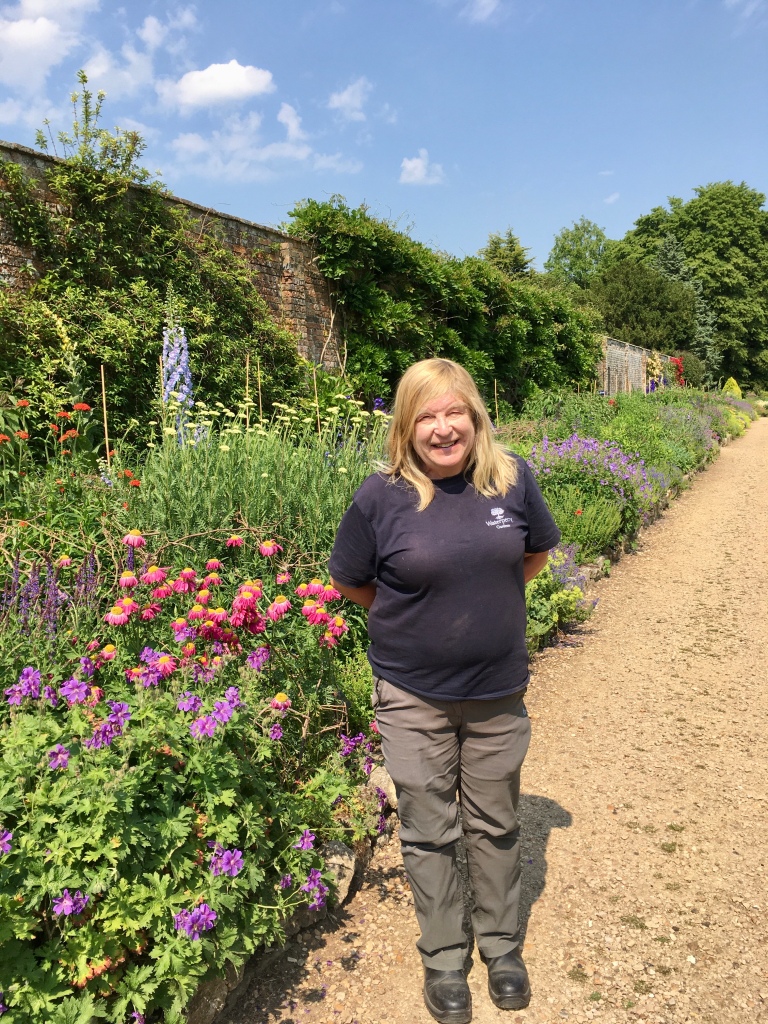
Here’s head gardener and gardens manager Pat Havers who gave us a tour of the gardens following the launch party. More on the gardens to follow in a separate blog post…..

Peach Melba, a fully double climber is Rose of the Year for 2023 and was launched at Iford Manor last summer.
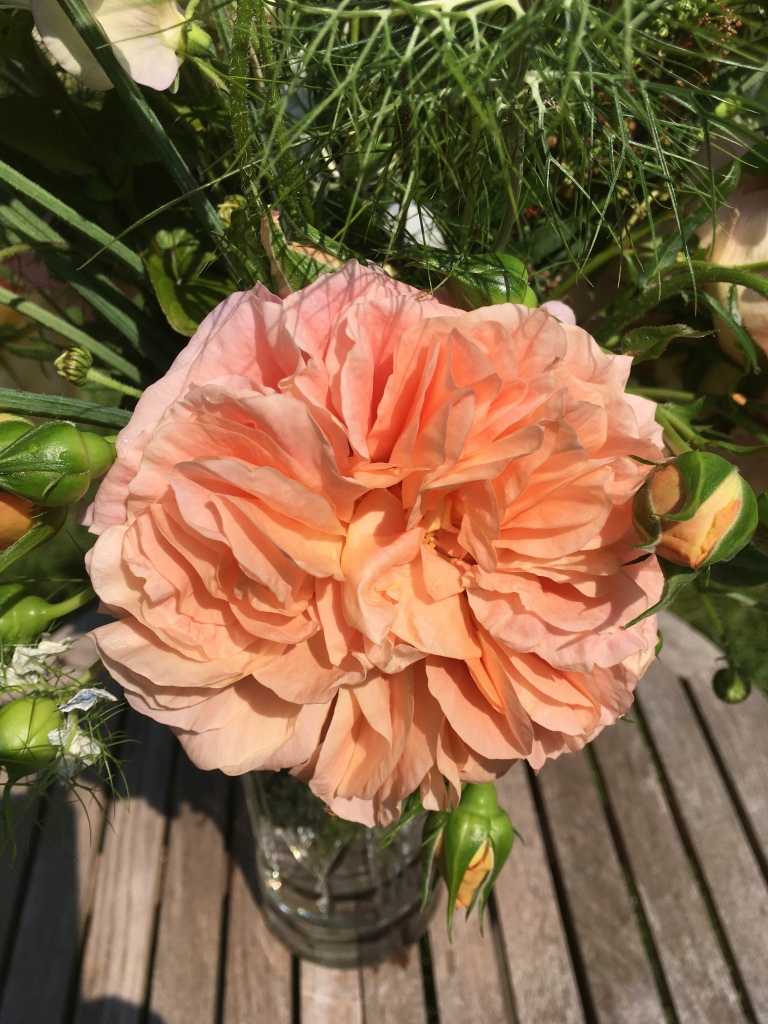
This beauty is called It’s a Wonderful Life, and was Rose of the Year 2022. I used the flowers in this week’s posy for my Mum. The scent is reminiscent of water melon and summer fruit salad. It readily repeat- flowers, which makes it ideal for the cutting garden. This rose was bred by Colin Dixon who has won the rose of the year title 10 times.
Roses UK is @rosesukroses on twitter and Instagram and http://www.rosesuk.com web site.
If you were listening in to BBC Radio Leicester today, I was talking to presenter Ben Jackson about these roses. Do have a listen in on the i-player at about 3.05pm.
Flowers for my Mum. Home-grown from the plot
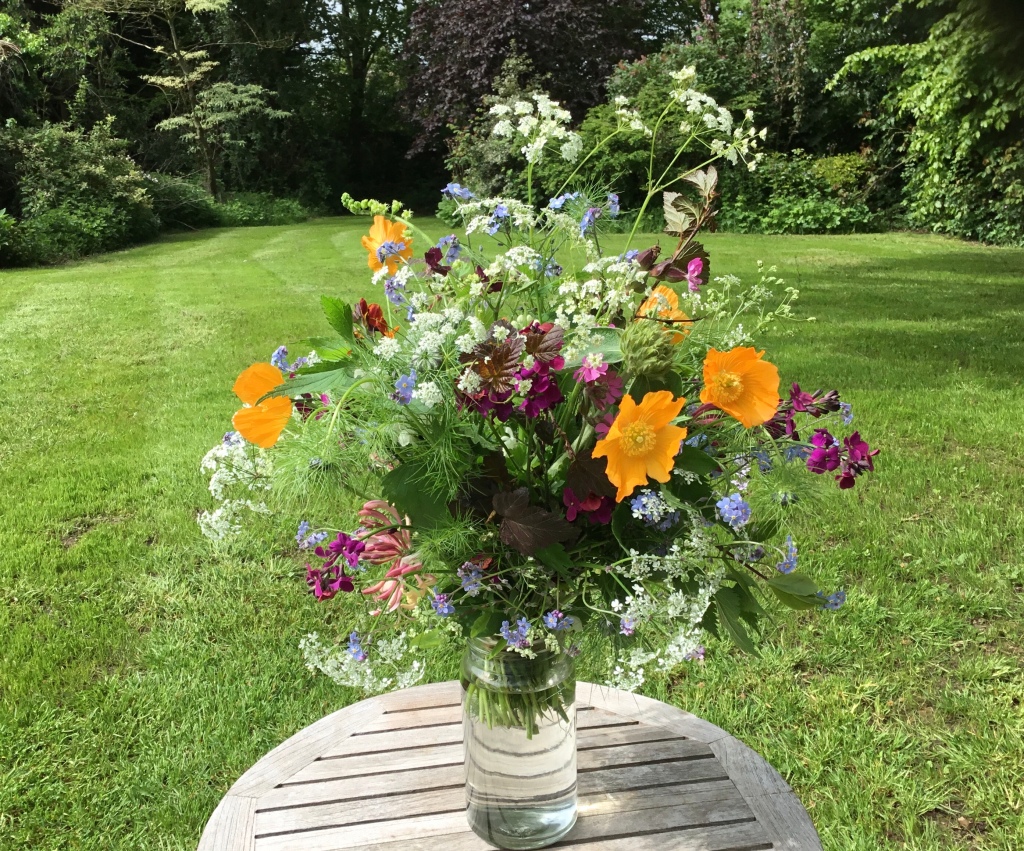
Summer annuals, such as cosmos, haven’t started flowering yet. We are about two weeks behind, due to a very cold spring. So for this week’s flowers from the plot I’ve had to rely on biennials, perennials, climbers and shrubs. Each week, I pick a selection of flowers to take to my Mum as a ‘snap-shot’ of what the garden looks like. It’s a way of sharing our love of flowers and keeping her connected with what’s happening here.
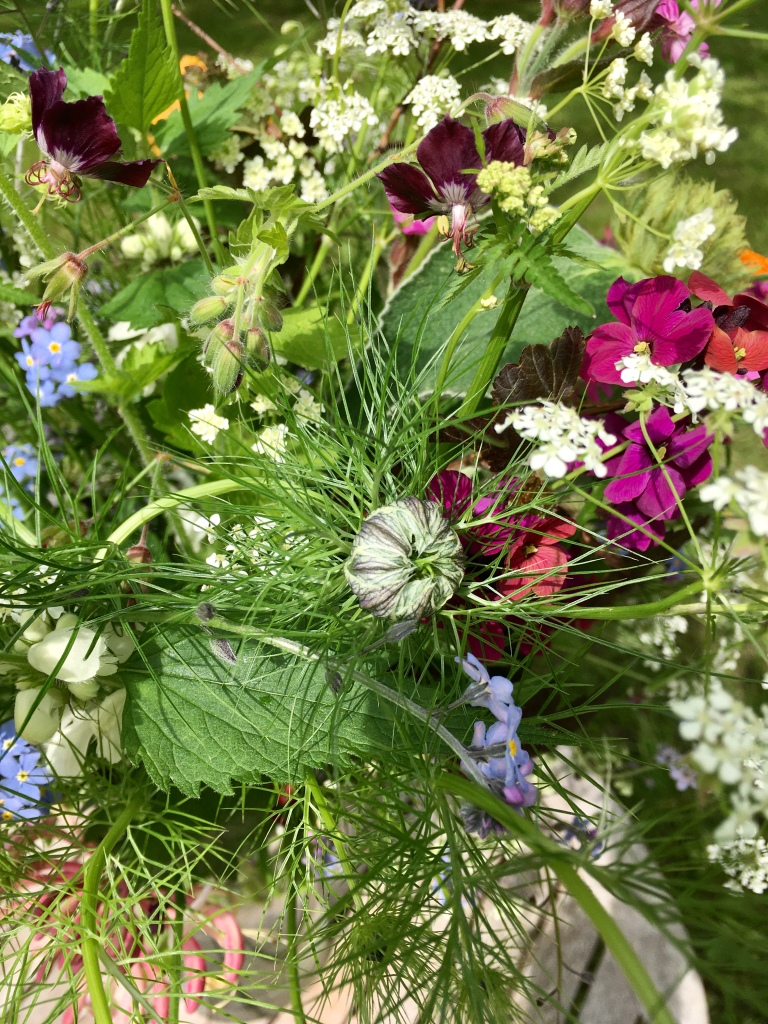
Love-in-a-mist was sown last autumn and over-wintered in an unheated poly tunnel. I was testing out a theory to see if I could get early flowers by the last week of May. There are masses of flowers, but these are only a few weeks earlier than the ones growing in a sunny south-facing border outdoors, so I probably won’t repeat this exercise. The cost of compost and use of space doesn’t warrant the slightly earlier flowers.
The tiny deep purple flowers are Geranium Phaeum which pops up all over the plot in places I never planted it. It’s a long-flowering perennial and doesn’t take up much space, just meandering about through established shrubs and in a dry, shady woodland border.
The other jewel-like purple flowers are perennial wallflowers from Coton Manor plant nursery. These are highly recommended as they flower for a very long period and are low maintenance and easy-going. I bought just one plant and took cuttings immediately. I soon had 20 plants to cover a quarter of one of my vegetable and flower beds sited next to the greenhouse. I have 10 beds which are 1.5m wide by 3m long with small slab paths running between.
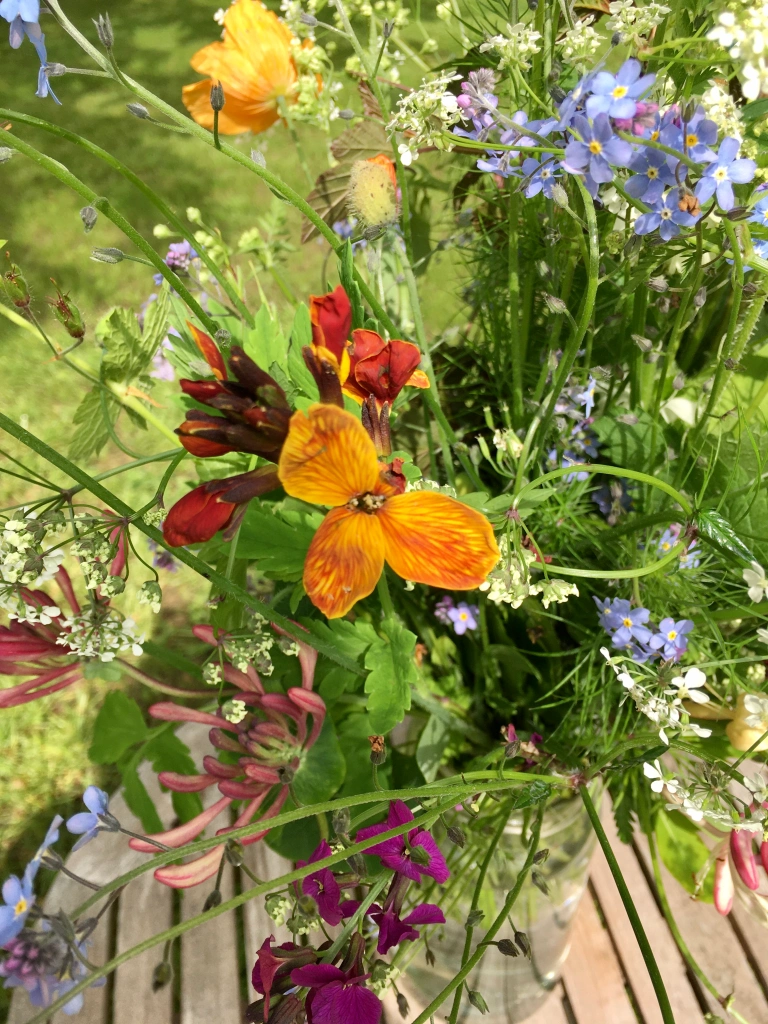
The last of the orange biennial wallflowers are being picked now. I’ll sow some more seed for next year. Sooty is a favourite deep purple/ black variety. The one above was part of a mixed packet of seed named Orange Bedder. It’s been flowering for several months. Deep red buds open to a lovely marmalade orange and the markings on the petals remind me of a dragonfly’s wings. The scent is wonderful, especially in the evening, and attracts clouds of moths. And circling above the plot, eating the moths, we have pipistrelle bats. We have seen them here since we moved in and created a garden 30 years ago. We thought they roosted over winter in the farmhouse next door, but they must have found other accommodation as the farmhouse has been completely renovated and there are now no gaps in the slate roof.
Forget me nots fill another whole bed, providing ground cover for the soil until the bed is required for summer crops. Forget me nots pull up very easily and suppress any weeds, so you are left with a nice clean bed to start planting out crops such as sweetcorn, onions, French beans, and courgettes. This year I have planted a dozen sunflowers in amongst the sweetcorn, an idea I spotted at Easton Walled Gardens last summer. Nasturtiums will clamber up the sweetcorn as it makes a sturdy support for annual climbers and scramblers.
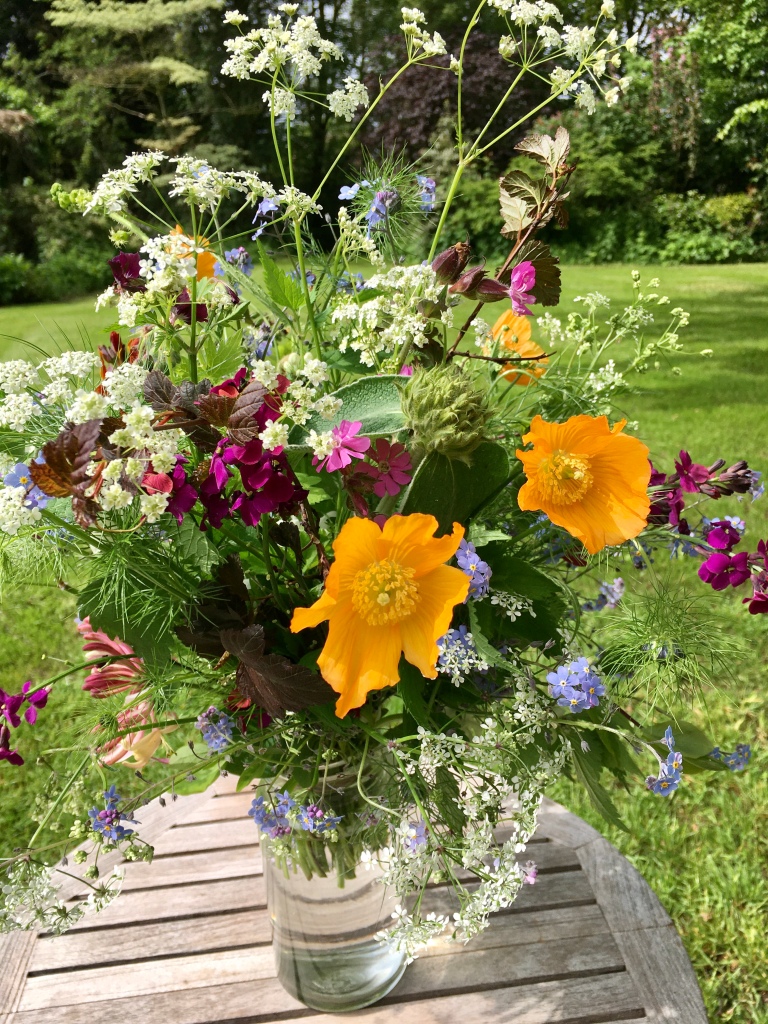
Welsh poppies pop up in every crevice all over the garden. I did previously try to eradicate them, but they persisted and I’m quite pleased they did now. Such a cheerful plant with flowers that look as if they are made of silk. I have the yellow and the orange types here. Background foliage comes from the Physocarpus Diabolo which grows in a north facing border and provides material for flower arrangements all summer long.
Dead nettles and cow parsley add a touch of white to the posy. Dead nettles continue to grow out of the bouquet and flowers last a long time. I was intrigued to see four out of the 12 gardens at Chelsea Flower Show contained so called weeds. I laughed out loud when I heard pots of dandelions were selling for £30. I’m actually a millionaire if dandelions, nettles and buttercups are taken into consideration. My whole plot is full of them!

I have a new little helper in the garden! My grandson, Finn. He loves running between the cow parsley along the woodland paths and picking flowers for his great grandmother. I’m hoping he will have a life-long love of nature and flowers, just as we did, growing up running free in our grandparent’s gardens. Have a happy gardening week everyone.
Do join Cathy for her ‘In a Vase on Monday’ meme. If you are busy, like me, it doesn’t matter what day of the week you post your posy of flowers from the garden. It’s a good community to be a part of, sharing what we are growing in gardens all around the world.
https://ramblinginthegarden.wordpress.com/2023/05/29/in-a-vase-on-monday-self-care/
Salmon and Spring Herb Pie
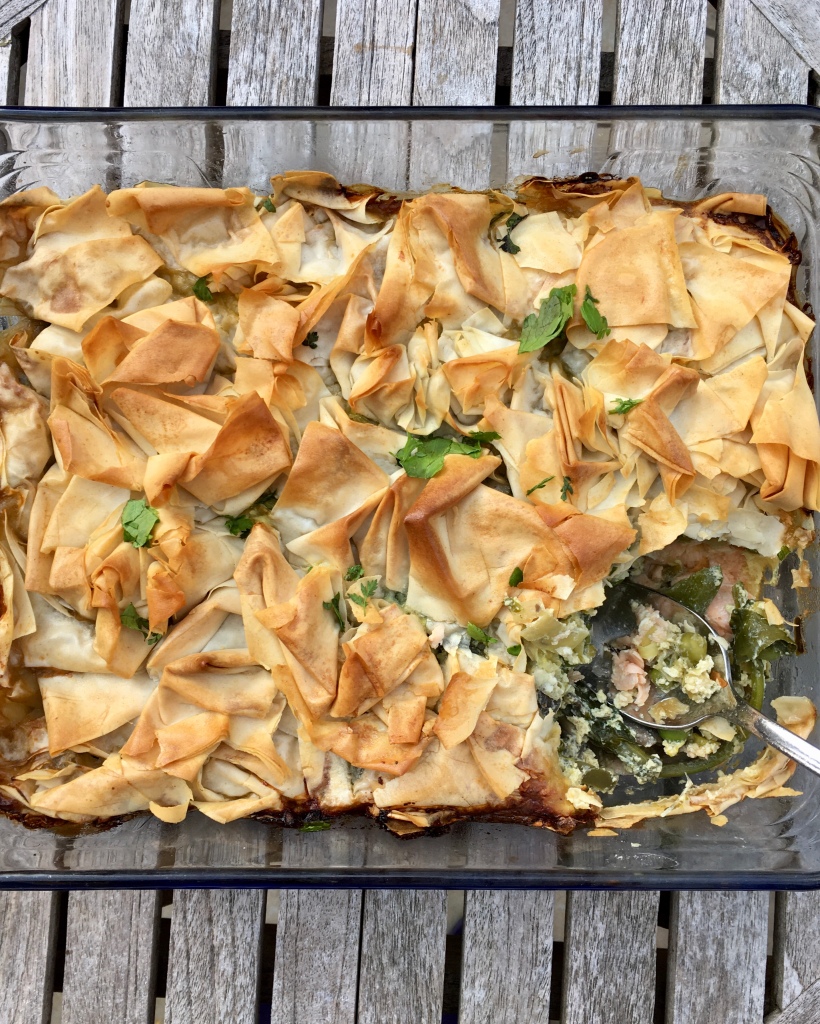
This week’s recipe from Garden News Magazine. So lovely to have sunny weather at the weekend to sit outdoors and eat with the family. Food seems to taste better in the sunshine.
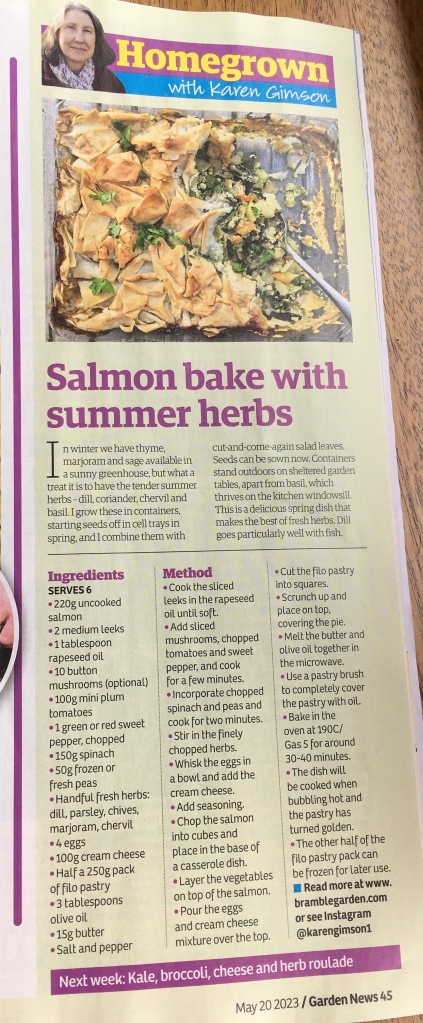

Herbs are grown in shallow terracotta pans and window boxes. These are still in the greenhouse, but will go outdoors the first week of June when all the cold winds should have disappeared.
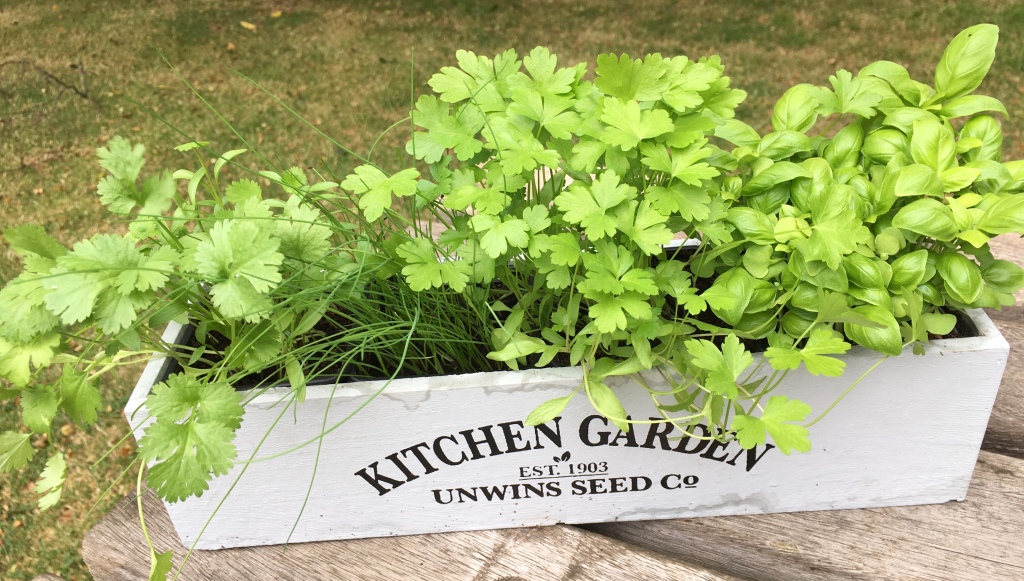
Here’s a mini-windowbox full of basil, parsley, chives and coriander. The kit comes with small packets of seeds and just enough compost for four individual pots.
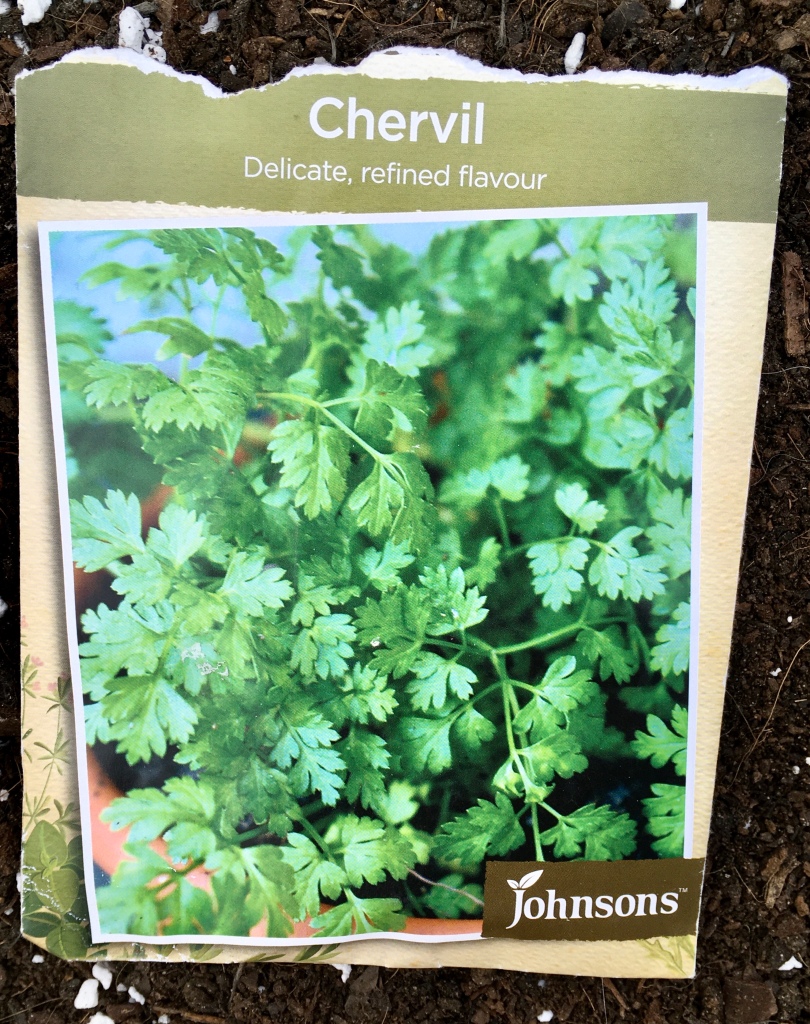

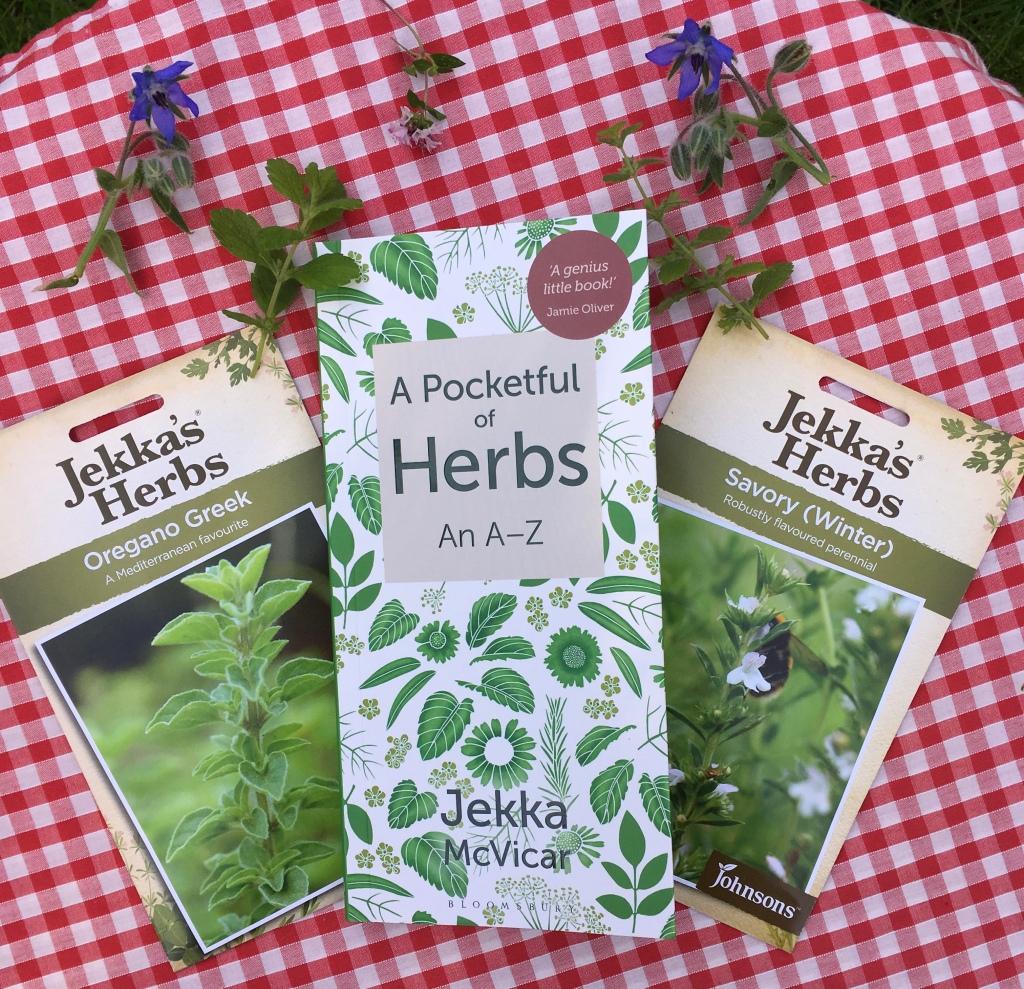
I also recommend Jekka’s Herbs produced by Johnson’s Seeds.


Hope you are having a good gardening week. It’s been a cold spring so far and very wet. We are behind with most vegetables, but the spring flowers have enjoyed the cool conditions and lasted longer than usual. Bluebells are just starting to fade, but bright blue geraniums have started to flower to take their place and all the wild flowers, ragged robin, pink campion and oxeye daisies are starting to bloom. Thank you for reading the blog and, if you have time, leave a comment in the box below, letting me know what herbs you are growing for your summer cooking. I’m very grateful to have the opportunity to write for Garden News Magazine. Each week I share a different recipe featuring something harvested from the garden. Sometimes I only have a handful of herbs, or a dish of berries. It doesn’t have to be a huge amount, just whatever I can find to put into my cooking.
My Book of the Week: Legends of the Leaf
Jane Perrone
Published spring 2023 by Unbound
Hardback. £14.99. Also available as an e-book
ISBN 978-1-80018-200-4
Review and book giveaway. Please leave a comment at the end of this review to take part in a prize draw for one copy.

When I look at my dismal collection of much-loved but slowly-dying houseplants, I just want to jump on the phone and ring horticultural expert Jane Perrone. We would be talking for hours! Overwatering and lack of knowledge are the two reasons my sorry subjects look so poorly. Now, luckily, Jane has saved the day by publishing an entertaining and easy to read book, Legends of the Leaf.
Jane focuses on 25 popular houseplants, unearthing the hidden histories and journeys they’ve taken to becoming prized possessions in our homes.

My favourite story relates to the Kentia Palms which stood on either side of Queen Victoria’s coffin as she lay in state. Jane writes: “When Queen Victoria died on 22 January 1901, her staff enacted a twelve-page set of funeral instructions she had compiled ready for the occasion. Many of her requests broke with traditions of the time, and some certainly seem peculiar to modern readers. The British monarch had been wearing black mourning dress for four decades since the death of her husband Prince Albert, but she insisted on being buried in a white dress, with the white lace veil she last wore at her wedding over her face as a shroud, and she stipulated that mourners at her funeral should not wear black. Tucked around her body were many surprising items, including a plaster cast of her late husband’s hand and his dressing gown. But the Kentia palms which stood at either end of the coffin would have been a surprise to no one.
“These large palms dominate the photographs of Queen Victoria’s coffin lying in state in the Albert Memorial Chapel at Windsor Castle. Their fronds arch over the bearskins of four Grenadier Guards who stood on duty, heads bowed, but they are not noted in many newspaper reports of the scene. I suspect this was because palms in general were such a fixture of upper class life at the turn of the twentieth century that they did not warrant a mention. As professor of design history Penny Sparke noted, palms acted as a frame for the cluttered interior of Victorian homes. ‘They introduced an exoticism of the tropics, as well as memories of empire and of an untamed world in which nature held sway over culture,’ she wrote. Queen Victoria grew Kentias at her royal residences, Society weddings were held underneath living arches made of two Kentia palms, and Kentias filled the lobbies of luxury hotels.”
There were Kentia palms on the Titanic when it sank in April 1912, Kentias in the palm court at the Ritz hotel in London when it opened in 1906, and potted Kentias for sale in the famous Harrods department store. This was a worldwide phenomenon rather than just a British penchant: a report on Kentia palms in the Los Angeles Times in 1929 noted: “They are used in hotel corridors, on banquet tables and for gala occasions – in Tokio (sic), Manila, Singapore, Suez, Cairo, Paris, Barcelona, Berlin, london, New York, and Los Angeles.”
I shall have a new respect for my slow-growing and small Kentia palm. I had never heard of the royal connection before or the fact it was held in such high esteem all over the globe. I might not be having any banquets or gala events, but my palm will be moved to a more prominent position than in it’s former corner in the dark spare room.

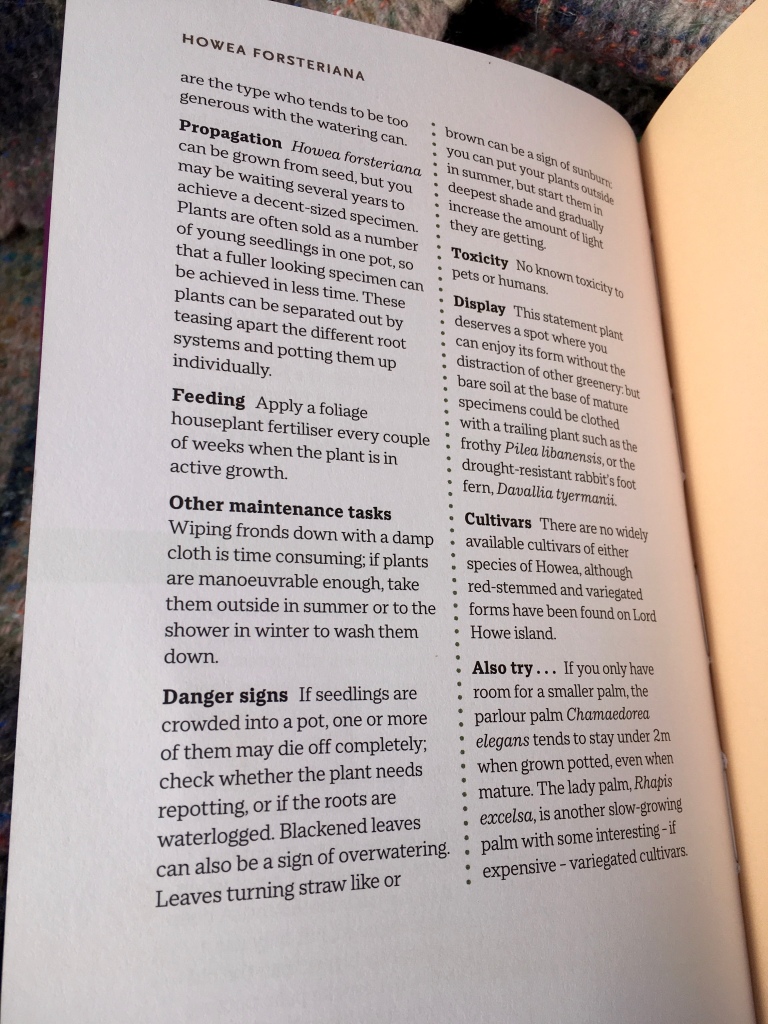
Jane’s beautifully written and entertaining histories are accompanied by a care guide outlining the amount of light plants require, temperatures they prefer, watering, humidity, substrate and a section on pest and diseases, propagation, feeding, ideas for display, and most usefully, ‘danger signs’ to look out for when things are starting to go wrong. In my case, blackened leaves are a sign of overwatering and leaves turning straw-like can be a sign of sunburn. You can put plants outdoors in summer, but start them in deepest shade and gradually increase the amount of light. I probably go from one extreme to the other, from indoors in a dark place, to straight outdoors in full sun.
The other plants I have in my collection include the quirky-looking Lithops, or living stones. I also have the Ceropegia woodii, or string of hearts, the jade plant, Begonia and Monstera. And there’s an Aloe vera, for burns, on the kitchen windowsill.


Jane’s book is beaufully-illustrated by Helen Entwistle. And a word must be said about the quality of the publishing. The cover is glorious, and the silky paper is a beautiful thickness. I’ve never thought to consider these things until this year, when I received several books which were not well put together. A well-made book, as well as a well-written book, is a joy to read.


Jane Perrone is host of the popular podcast, On the Ledge. She also writes for the Guardian, the Financial Times, and Garden Illustrated. Over the years, I’ve looked to Jane for good, sensible advice and always found her writing to be a level above others. I can highly recommend her latest book, Legends of the Leaf. I found it an exciting read, discovering how my favourite houseplants made a leap from the wild to the windowsill. I literally couldn’t put it down once I’d started reading it, and now I know the background stories to my houseplants, they are receiving the care they richly deserve.
Please leave a comment in the box below and a name will be randomly selected for the prize draw. Thank you for reading my blog. You are amongst the 200 people who take a look each day and I’m very grateful for all your support and comments.

Links:
Prize draw winners- To Stand and Stare.

Thank you to everyone who read my review of Andrew Timothy O’Brien’s new book ‘To Stand and Stare’ published by Dorling Kindersley. The publishers kindly gave me two copies to give away.
The winners are Anna, and also Gill Watson. Please could you e mail me your addresses for the copies to be sent out. k.gimson@btinternet.com.
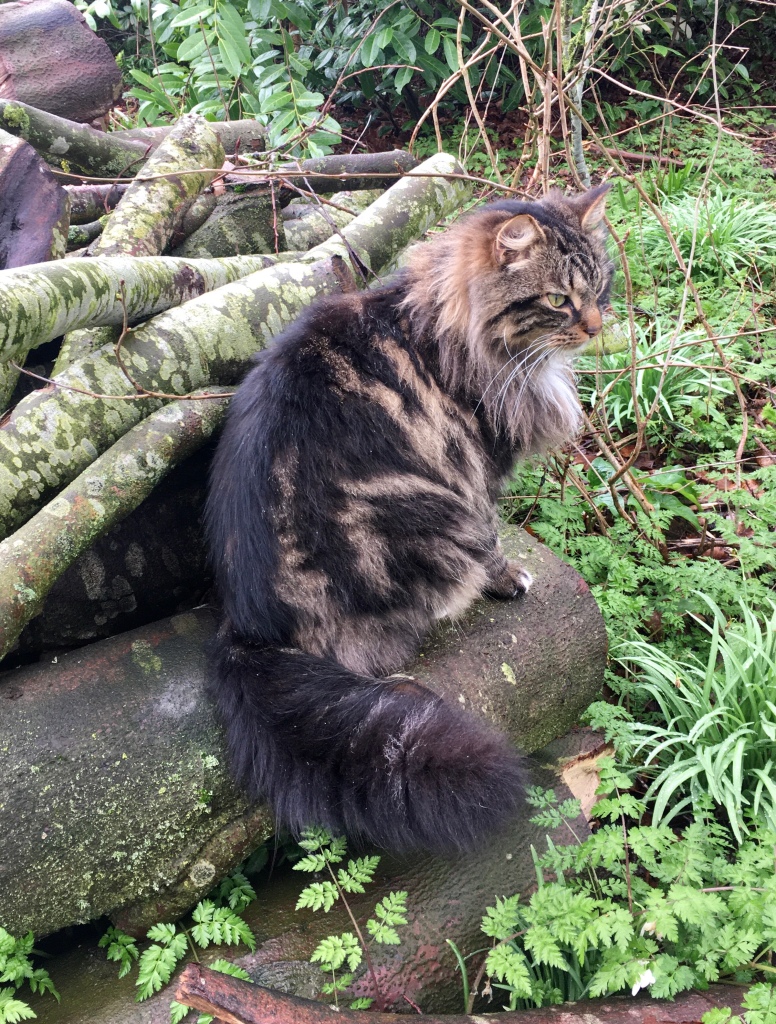
It’s a long time since I shared any photos of my lockdown kitten, Monty. No longer a kitten, but known to everyone as Monty K. He’s got ‘standing and staring’ down to a fine art. He’s still such a good companion in the potting shed and garden and follows me around everywhere. We hadn’t intended to get another cat, but when vets cancelled all the spaying operations there was an explosion of kittens in our village and surrounding area. We only got to see photos of Monty before he arrived, due to the covid rules, and we had no idea he would be a long-haired cat! Isn’t he gorgeous. A lot of brushing goes on with that coat! Otherwise, there’s brambles and dried grass all in a tangle around his ears.
I’ve ‘adopted’ two cats at Shropshire Cat Rescue. We can’t have any more here as Monty wouldn’t tolerate another feline, so I’m sending money to support two of the charity’s resident cats. More about this later!
Meanwhile… here’s a few Monty kitten photos, which is an indulgence really, but a nice reminder of when he arrived.




Have a great gardening week everyone! Thanks again for reading the blog and keeping in touch. It’s always appreciated. Karen.
Caramelised onion and nut roast

If you are looking for a special dish for New Year celebrations, I can highly recommend this recipe. It’s a really tasty onion, mushroom and nut filling encased in golden puff pastry. It’s easy to make and serves 7-8. You can also make it ahead and re-heat it, or cut it into portions to freeze. We have it for Christmas every year, served alongside roast potatoes and honey roast parsnips, greens and onion gravy. wishing you all a very happy Christmas and wonderful New Year! Thanks as ever for following the blog and leaving your comments.
Ingredients:
1 x pack 400g (approx) ready-rolled pastry
For the caramelised onions:
1 large or two small white onions, chopped
1 tablespoon butter or vegan margarine
1 teaspoon golden caster sugar
For the filling:
3 small red onions, chopped
1 tablespoon olive oil
250g chestnut mushrooms, chopped
Few tablespoons fresh flat leaf parsley
1 teaspoon fresh rosemary and thyme, leaves only
Or 1 teaspoon dried mixed herbs
half a lemon, juice only
1 tablespoon vegetable stock
150g mixed cashew nuts, walnuts, hazelnuts, brazils
80g sliced blanched almonds
80g white bread crumbs
1 egg, beaten or 1 tablespoon vegan oat milk
Seasoning
Method:
Heat the oven to 180C / Gas 6
Take the pastry out of the fridge so that it comes to room temperature while you make the filling.
Heat the butter, sugar and onions in a frying pan. Gently cook for about 15 to 20 minutes, until caramelised and soft. Allow to cool
Use the same frying pan to cook the red onion in the 1 tbsp olive oil. When they are soft – which takes about 20 minutes on a low heat- add the chopped mushrooms, herbs, lemon juice and vegetable stock.
Cook on a low heat for 10 minutes.
Chop the nuts in a food processor very briefly. Add the mushroom mixture and process for a few seconds to incorporate. Leave it chunky, but well mixed
Add the breadcrumbs and seasoning and stir.
Mix in half the beaten egg. The other half will be for glazing the top.
To assemble, unroll the pastry on a baking tray, using the paper covering as a non-stick parchment
Spoon the caramelised onions down the centre of the pastry
Add the mushroom nut filling on top.
Cut the pastry sides into diagonal strips about 2cm wide and fold these one at a time over the filling to form a plait.
Brush the top with the reserved half beaten egg or oat milk for vegetarians.
Cook for about 40 minutes until the pastry has risen and turned golden and the filling has heated through.
Can be made the day before and reheated in foil in the oven. Also nice cold of there are any leftovers, served with jacket potatoes and salad. Enjoy!




The finished roast. Sprinkle some fresh herbs over, if you like.
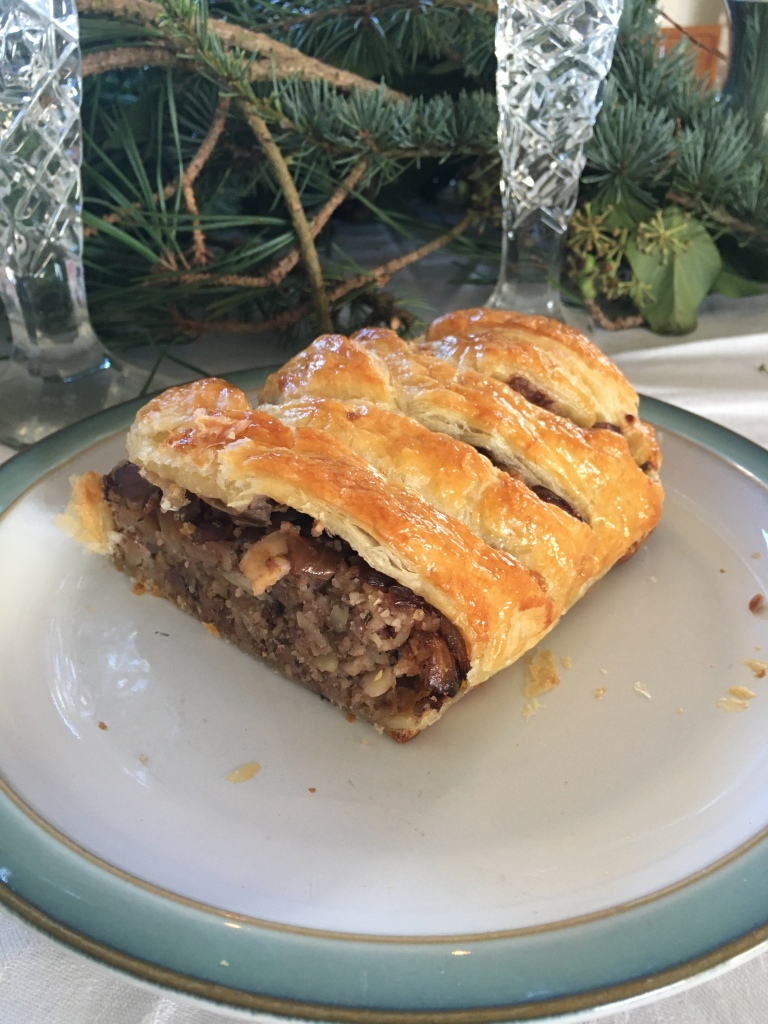
So tasty!
Planting Amaryllis. BBC Radio Leicester gardening show notes. Christmas present ideas.

Christmas only really starts for me when I plant my amaryllis bulbs. For as long as I can remember, there’s been amaryllis bulbs flowering over the festive season at my family’s home. And I like to keep up the tradition by having them in my own home. If you listened in to this week’s BBC Radio Leicester show, you will have heard me talking about the amaryllis varieties I’m planting at the moment. Some are for me, and some will be given as Christmas presents.

Carmen is the deep velvety red single-flowering bulb I mentioned on the show. I was potting them up as we talked. The box kits from Taylors Bulbs contain a plant pot and compost which makes life easier. Everything needed is contained in one box.
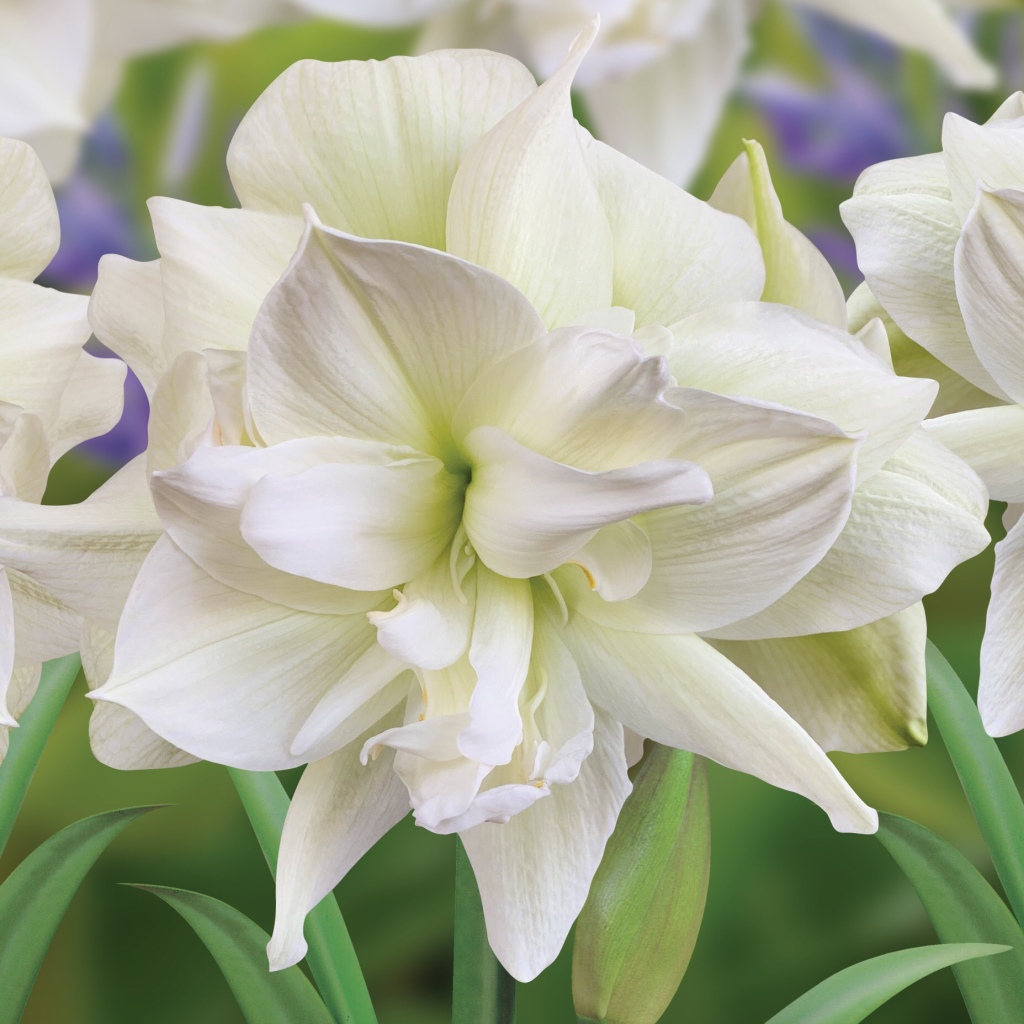
This beautiful double white amaryllis is Marilyn. I love the lime green centre of the flowers.
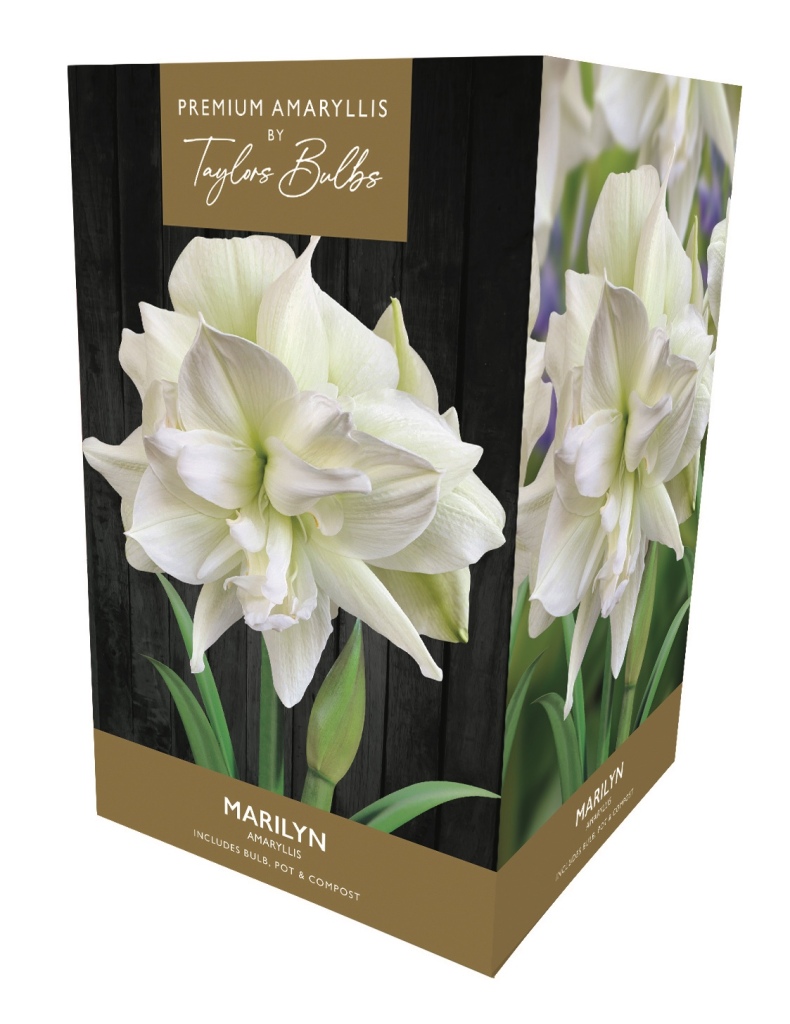
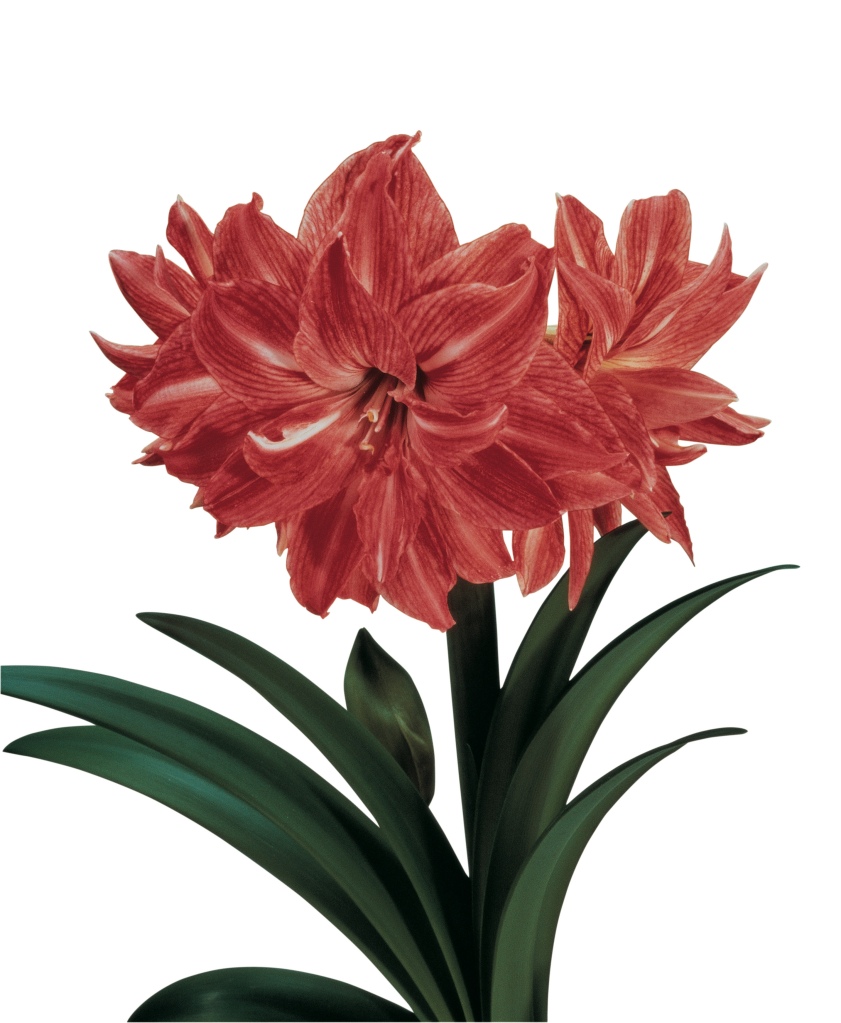
This is the pink and white striped double amaryllis I’ve chosen. It’s called Lady Jane. Which is quite a fancy name for quite a fancy flower!


Amaryllis Rilona has wonderful deep apricot single flowers with a darker eye. The flowers are edged in white, and if you look closely you can see darker orange stripes or veins radiating from the centre of the flowers to the tips.


When choosing bulbs, always go for the largest you can find. The larger the bulb, the more flower spikes will be produced. Usually one single spike is followed by a second, or even a third, if you are very lucky.
I asked Taylors Bulbs for some planting and general care advice:
How To Plant Amaryllis In Pots/Containers:
1. Soak the dry roots (not the bulb) in lukewarm water for about
45mins. Make sure to cut off any damaged roots before potting.
2. Fill the base of your pot (at least 20cm) with multi-purpose
compost, covering the drainage hole.
3. Feed the roots into the pot, spreading them out onto the compost and fill in around them with more compost.
4. Bury the bottom half of the bulb, so that it is secure in the pot.
Water sparingly.
5. Stand the pot in a well-lit position and keep the compost moist, but
do not over water.
Extra Tips:
* Amaryllis are great for the windowsill. Remember to turn the pot
regularly to prevent the stems bending towards the light.
* Once your Amaryllis flowers have faded, cut the whole stem off as
close to the base as possible.
* Water and feed them with a balanced fertiliser every few weeks to
help build up strength for next year.
* Make sure to give them plenty of light, as this helps the leaves
generate energy.
* To help encourage them to flower next year cut any old foliage back
to the neck of the bulb. Move them into a warm position and continue to water them.
Re-potting Amaryllis Bulbs:
* After every two to three years it’s a good idea to re-pot amaryllis
bulbs for continued good displays.
* Amaryllis tend to grow best in small pots, so don’t be tempted to
re-pot into a larger pot.
* After flowering, remove the bulbs from the compost and gently remove the compost around the roots. Then refill your pot with fresh compost and replant the bulb.
About Taylors Bulbs:
Taylors Bulbs are a fourth generation family business, growing and supplying flower bulbs and associated products since 1919.
Daffodils are grown on our farm in Holbeach, Lincolnshire where we also design and pack a large range of products predominantly for the UK and Irish markets.
Still a thriving family business employing over 200 staff at peak times, we pride ourselves on the award winning service we offer our customers.
Here’s some more amaryllis I’ve grown at Christmas. In the second year, they often flower either very early in November, or as late as May. Either way they are very welcome at a time when there are few flowers to enjoy in the garden. Indoor bulbs fill the gap.
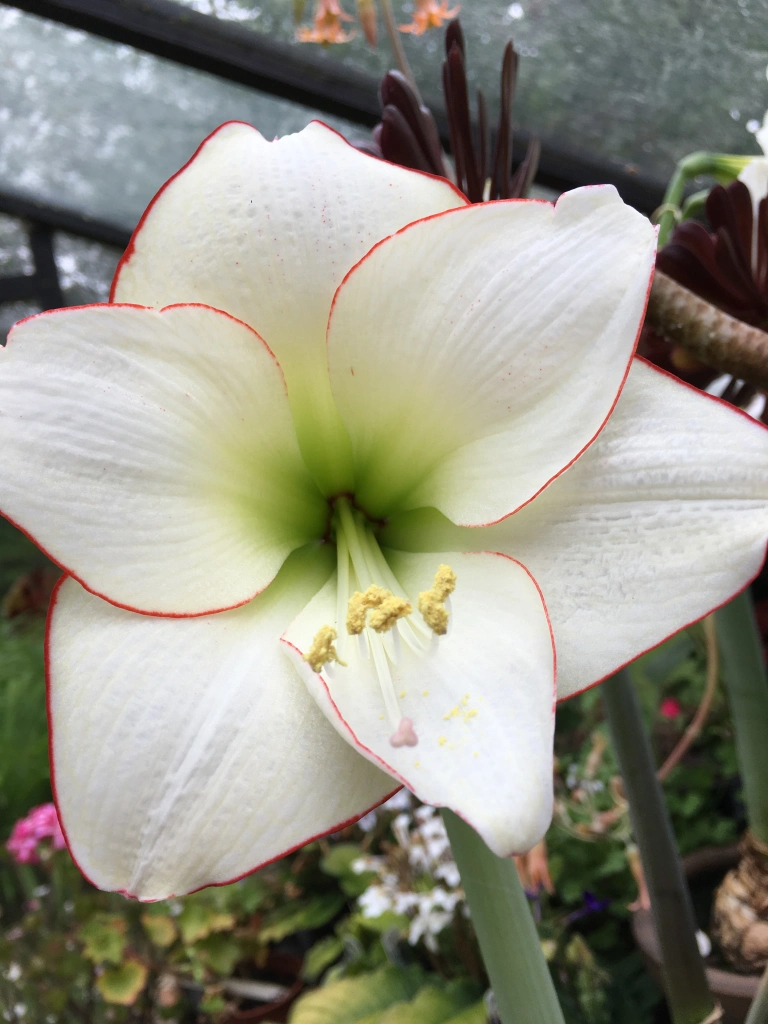


Thanks for reading the blog, and for listening in to the radio. I also write a weekly column for Garden News Magazine, so I’m either talking or writing about flowers every day of the week. Happy gardening everyone!
Award for Flower Carpet Pink Rose

Flower Carpet Pink is the 18th rose to be inducted into the World Federation of Rose Societies prestigious Rose Hall of Fame. Who knew there was such a thing as a Rose Hall of Fame! Or that there were 17 other roses mentioned there already. I learn something new every day. The announcement came at the Word Rose Congress held in Adelaide earlier this month. I’m going to show my complete ignorance here and say that I didn’t even know there was a World Rose Congress either. However, for what it’s worth, I have always loved the Flower Carpet roses for their disease resistance. As an organic gardener, roses that don’t need spraying are a blessing. Ones that repeat flower and don’t need much pruning are even more welcome. I use the pink rose in garden design projects, but at home I have Flower Carpet Coral which grows amongst white peonies, hellebores, and blue campanula in a semi-shaded border. The blue and the coral colours look wonderful together.

It’s fascinating to know the history behind these plants. Flower Carpet Pink was Bred by Noack Roses in 1988 and introduced in the UK in 1991. Like many gardeners, I appreciate its glossy foliage, abundance of flowers and easy-care characteristics.
Rose grower Robert Wharton, licensee for Noack Roses in the UK says ‘With environmental consideration such as water and chemical reduction increasing in importance Flower Carpet with its excellent drought tolerance and superb health will be a feature in gardens and green spaces well into the future.’
Creator of Flower Carpet Pink, Werner Noack passed away recently and his son Reinhard accepted the award from Henrianne de Briey President of the WFRS. Reinhard said ‘Such a success is not the merit of only one person – three generations of the Noack family, our employees and national and international partners have all contributed to make Flower Carpet Pink a true rose of the world’.
The Flower Carpet collection won 11 gold medals and 14 awards in rose trials held around the world. Both Reinhard and his son Steffen continue Werner’s work in creating both beautiful and useful roses, including Cherry, the latest addition to the Flower Carpet family.
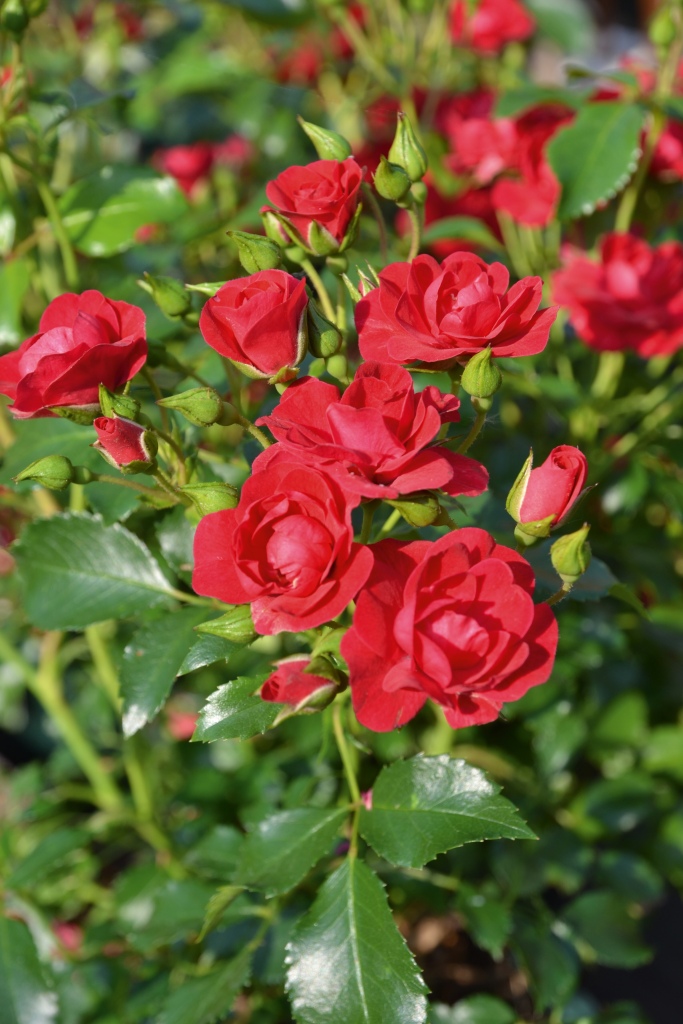
The Flower Carpet collection has combined sales of over 100 million plants globally since the launch of Flower Carpet Pink.

The World Federation of Rose Societies, World Hall of Fame was established in 1976. There have been 18 inductees over the past 46 years, with Rose Peace being the first. There is also an Old Rose Hall of Fame which celebrates the popular historical roses and roses of genealogical importance.
Flower Carpet® is grown in the UK by Whartons Garden Roses and is available from garden centres and nurseries.
Here’s some more roses from the Flower Carpet series.

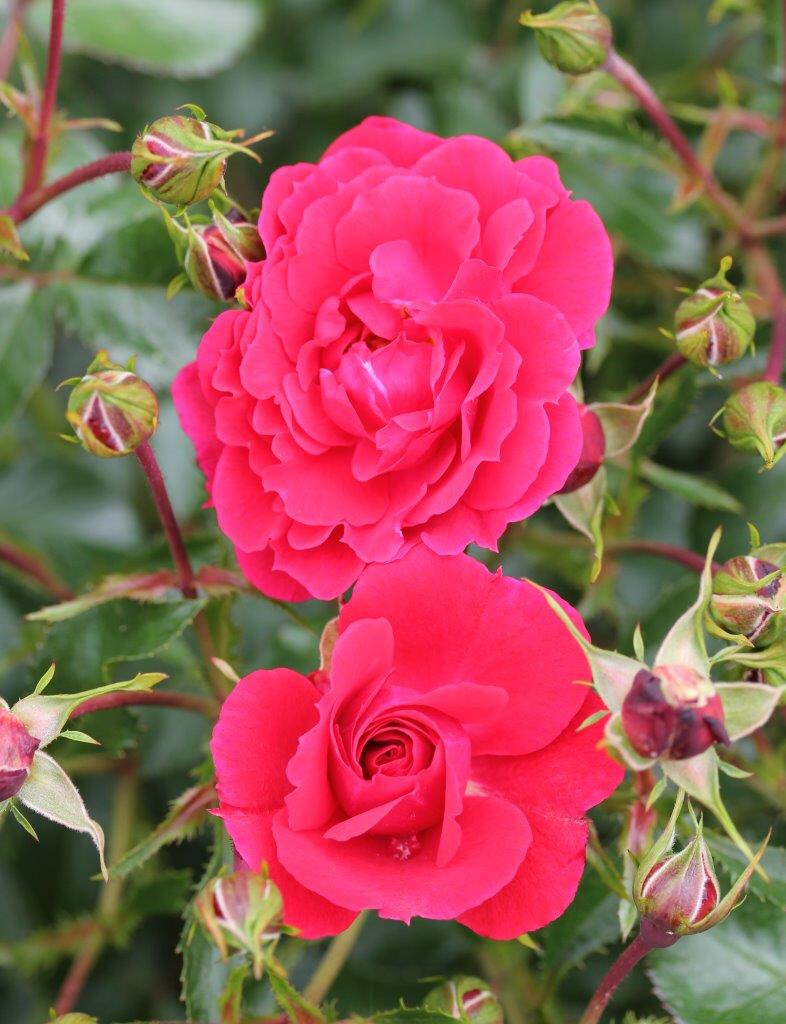

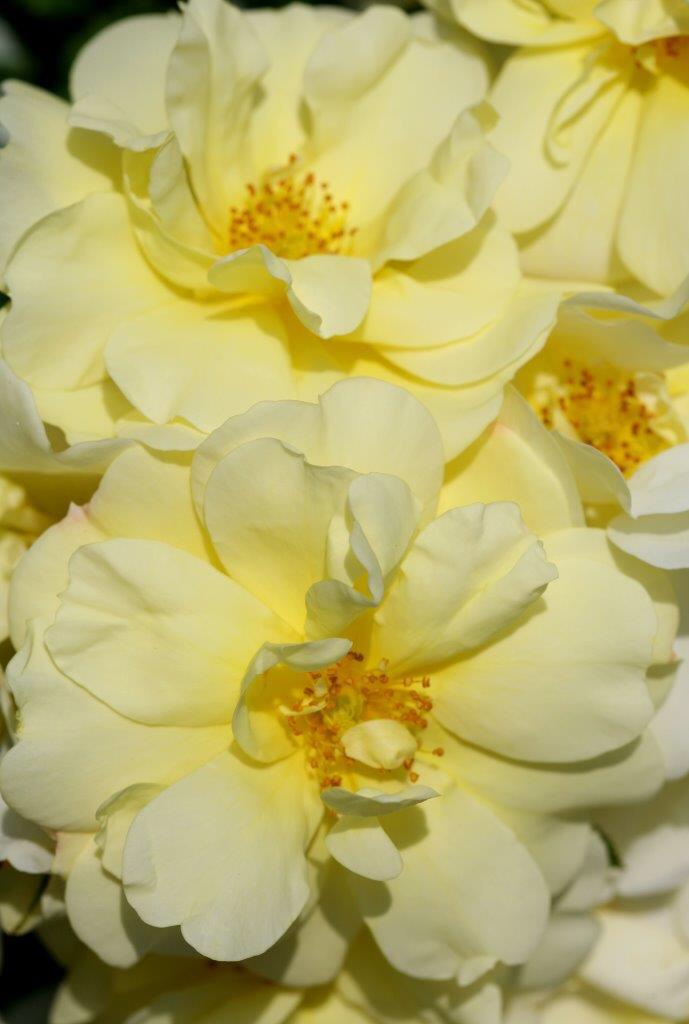

These make good roses for flower arranging, and in the open-centred roses, bees love the pollen. Are any of you growing roses from the Flower Carpet Range? Thank you for reading the blog and leaving your comments in the box below.
Book winner. Grasping the Nettle by Tamsin Westhorpe.
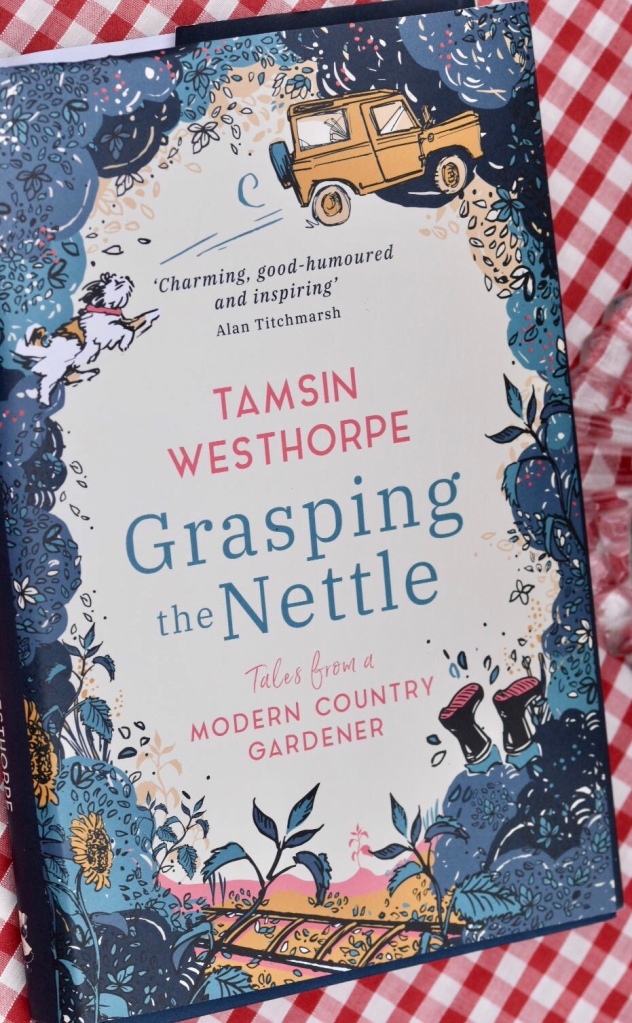
Cathy from https://ramblinginthegarden.wordpress.com/category/gardens/in-a-vase-on-monday/ Has won the free copy of Tamsin’s latest memoir. Thank you to everyone who read my review and left a comment.
My review is here. https://bramblegarden.com/2022/10/27/grasping-the-nettle-by-tamsin-westhorpe/
Book reviews and giveaways coming up this week: The Tree in my Garden by Kate Bradbury published by DK for the RHS.
Have a great gardening week everyone. All the best, Karen.
Secret Gardens of the South East- A Private Tour by Barbara Segall. Prize draw winner.

Jane Wightman is the lucky winner of the prize draw for Barbara Segall’s new book. Thank you to to everyone who read my review and left comments. And thank you to the publishers Frances Lincoln/ Quarto for offering a free book to readers of my blog.
Here’s a link to my review: https://bramblegarden.com/2022/10/14/book-review-secret-gardens-of-the-south-east-a-private-tour-my-bbc-local-radio-book-of-the-week/


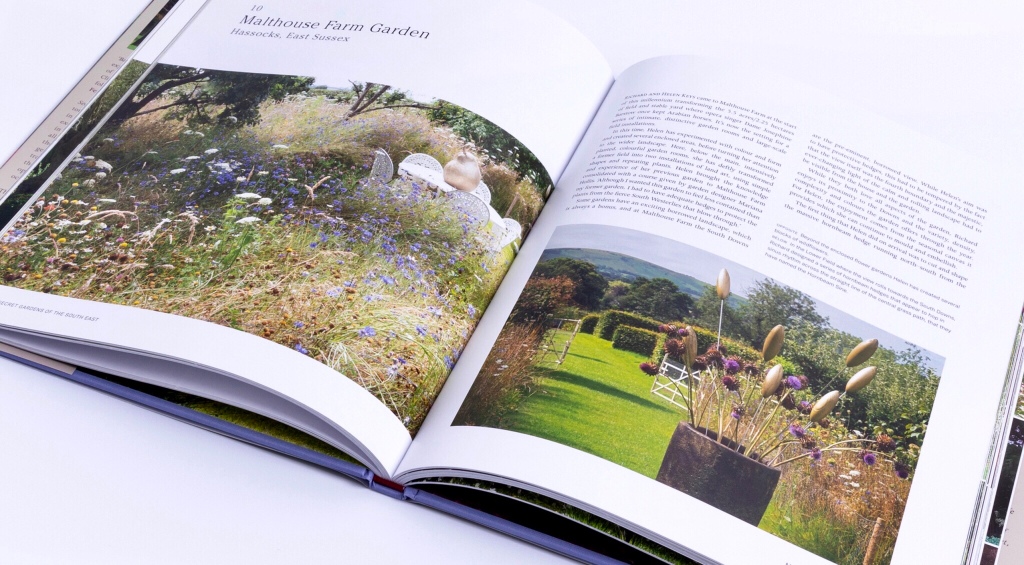


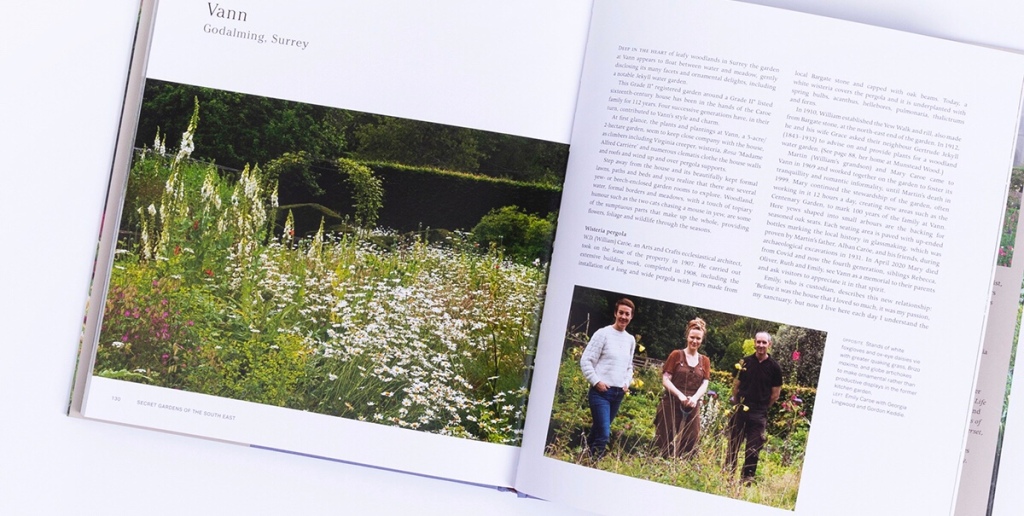
Thank you for reading the blog and leaving your comments. Look out for more book reviews and give-aways later this week. Suddenly there’s a steady stream of top quality gardening books arriving in the potting shed for tea break reading. To be honest, I’ve never seen such a wonderful array of subjects covered and superb garden writing. Tea breaks are getting longer and longer at bramble garden! I’ll keep you posted.
Attracting Garden Pollinators – by Jean Vernon.
Book review and one copy to give away.
Published by White Owl, imprint of Pen and Sword Books
Published summer 2022
Hardback. £25
ISBN 1526711907
Please leave a comment at the end of the review if you would like to be put into the publisher’s prize draw for one copy of the book. Names will be chosen randomly.

Right by my front door, on a warm, sunny south-facing wall, we have a selection of bee ‘houses’ some home-made from cardboard tubes and garden canes, and some purchased at a local supermarket. These are a source of wonder and joy as clouds of solitary bees hatch out and start to forage in the front garden. Watching a new, baby bee hatching out of its winter cocoon is such an exciting and magical moment. Thanks to a new book on attracting pollinators to our gardens, I’ve been able to identify our bees. They are red mason bees; solitary bees that nest in wall cavities and readily use bee houses like ours. In Jean Vernon’s book I’ve learned these bees are fond of fruit tree nectar and pollinate apples, pears and other spring and summer-flowering trees. So I’m expecting a bumper crop of fruit this year. And I’ve learned these bees, like most solitary bees, do not sting, so there’s no danger to me or any visitors walking past the bees to get to the front door. Reading on, I learn that one way to help my bees is to leave a mud patch nearby so there’s plenty of material to seal their eggs cells. It’s completely calming and relaxing watching the bees going about their daily lives, and I want to do all I can to help them. It would be terrible to think of these bees emerging into the world and not finding anything nearby to eat. Jean points out that some solitary bees will only travel a few metres from their nests to find sustenance and they will starve if there’s not enough suitable plants flowering at the right moment.

Here’s a photo of a red mason bee in Jean’s book. (photo by Liam Olds).
Jean’s book is split into chapters on identifying and learning about specific pollinators such as butterflies, moths, bees, and hoverflies among others, and advice on which plants to grow to help pollinators.








Photo of Jean by Hannah McVicar.
If you’ve been listening to BBC Radio Leicester you’ll know that Attracting Garden Pollinators has twice been my Book of the Week. I’m happy to recommend such an easy to read and information-packed book. Jean writes in a friendly and accessible way. Her passion for nature and wildlife shines through and you can’t help but get caught up and carried along by her enthusiasm for the subject. Simple ways to help pollinators are suggested, and you don’t need a huge garden to make a difference. Even a windowbox or container can be a five star diner!
I wrote about Jean’s other best-selling book here:
https://bramblegarden.com/?s=Secret+lives+of+bees
Please leave a comment in the box below if you would like to enter the publisher’s prize draw for one copy of the book. Names will be randomly drawn. I will only contact you on this page and no payment of any kind will be asked for. Please be aware of scams. Please also feel free to leave a comment if you don’t want to be included in the draw. Just let me know.
Signed copies of both books are available from the author’s website here : https://thegreenjeanie.com/shop/
Thank you for reading my blog and book reviews. Are you growing any plants with pollinators in mind? Have you tried making a bee house? I was fascinated to read you can buy red mason bee cocoons to hatch out in your garden. Alternatively, invest in some special mason bee tubes and install them in a nesting box . You can replace the tubes each year to keep the nest free from pests and parasites.
Help for Ukraine- listing gardening, sewing and craft people helping charities for Ukraine
Please add yours to the list.

Link:

I’ve sent dog coats, water bowls, and vet beds to this appeal via their Amazon link.


Link for the Amazon list for the appeal :
https://www.amazon.co.uk/hz/wishlist/ls/10LS1ESE6WHD1?ref_=wl_share&viewType=list

I’ve had some beautiful hand-made bags from Sandra. Highly recommended.
Here’s the Link for Sandra Harris
https://buttonburycrafts.co.uk/

Link for Nowzad:


Link for Daisyglass:
https://www.daisyglass.co.uk/daisy-glass-shop

Felt badges made by Niki Preston:
https://thetwofingeredgardener.wordpress.com/
Please add details of any fund-raising projects you know of. Every little helps.
A Greener Life – by Jack Wallington
BOOK REVIEW AND MY BBC LOCAL RADIO BOOK OF THE WEEK
Published by Laurence King, March 2022
Hardback, 192 pages, £19.99
ISBN: 978-085782-893-4

A Greener Life is much more than a ‘how-to-garden’ book, it’s actually a revealing diary of the writer’s journey from a stressful life and illness, to peace and calm through creating a garden and connecting with nature.

Jack Wallington writes how he struggled to sleep, was regularly ill and felt as if he’d ‘lost his way’ as he tried to keep up, and be available 24/7. “I thought the feeling of dissatisfaction was normal, to be waited out until retirement.” The turning point was the day Jack and his partner Chris planted the first trees, shrubs and bulbs in their new garden. “My worries briefly melted away, and a spark of happiness ignited.”
Jack says childhood memories trickled back, memories of sowing tomato and nasturtium seeds and taking cacti cuttings to sell for pocket money.
Through simply planting a garden he was better able to deflect stresses and anxieties and seemingly insurmountable problems at work . “Life, all life, the thing I had loved as a boy, that had been around me all along, was helping my world make sense. I had euphoric moments when discovering other gardens and visiting countryside. I began to feel connected to something bigger than me, and that somehow the things I planted and cared for were making a real contribution. The more I planted in the garden, the more insects and birds visited. Inviting nature back into my life gave a peace I hadn’t experienced for thirty years, and opened my eyes to the responsibility I had to the ecosystem I was nurturing.”

Jack’s book contains seven chapters. The first chapter outlines nine steps to a greener gardening life, and is almost a book in itself. Chapter two is about ‘getting started’ easy planting guides and essential tools you’ll need. Chapter three, encouraging beautiful ecosystems. Chapter four focuses on creating a wildlife -friendly garden, bringing soil to life and attracting and sustaining insect life.
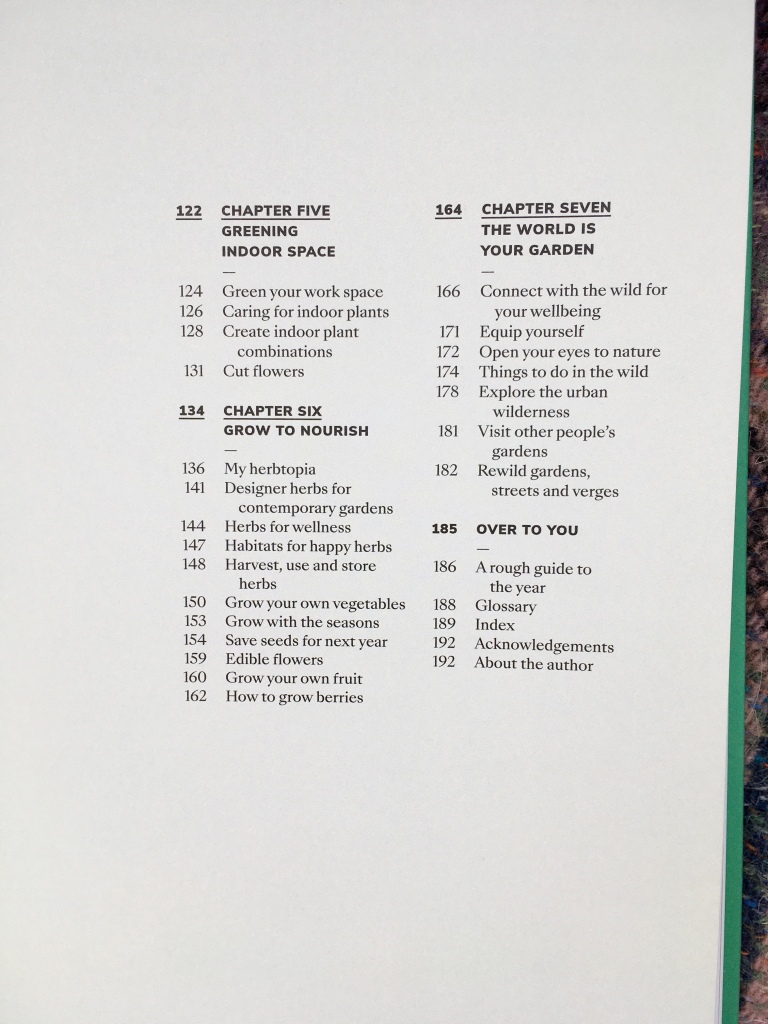
Chapter five focuses on greening indoor spaces and greening workspaces.
Chapter six talks about herbs for wellness, growing vegetables, fruit and edible flowers.
Chapter seven is about connecting with nature, exploring wild areas in the city and countryside. There’s a section on using binoculars, cameras, smartphones and field guides and magnifying glasses- a useful guide to equipping yourself to delve deeper into the natural world.
A Greener Life is an honest, well-written account of self-discovery, and Jack’s voice comes over loud and clear in this beautifully put together book. You’ll certainly learn how to create nature-friendly gardens, but you will also perhaps pause for thought at what good can come from connecting with gardens and wildlife. In these stressful and strife-ridden days, this can only be a very good thing indeed.
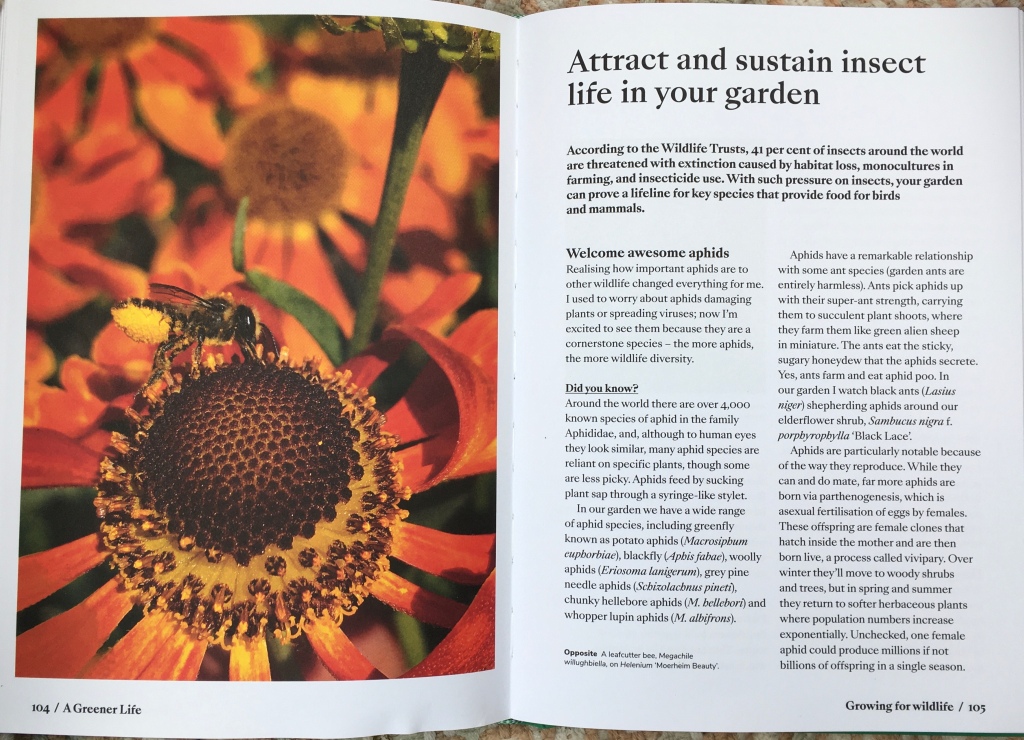




Jack’s book is really everything you’d ever need to be a greener gardener. It’s written from the heart, from someone who’s found out for himself that gardens, gardening and being in touch with nature really can make a difference. Jack says “ We’re part of the natural world and to save it is to save ourselves. We all benefit from a greener life.”

The publishers have kindly given one copy to give away. Leave a message in the comments box below and one name will be selected randomly by 26 March. Sorry, the offer is only open to readers in the UK.
Sarah Raven’s Grow, Cook, Eat Diary – Book Review
From Sarahraven.com
ISBN: 9 781529816617

I’ve never kept a gardening diary before, but I’m enjoying making daily notes in my new Sarah Raven diary. The diary is sturdy enough to take outdoors; the paper is thick, good quality so can stand up to being taken into the greenhouse and potting shed. I’m making lists of seeds I want to sow, dahlias I want to pot up, and general maintenance jobs about the garden. I love making lists- and I love ticking things off the lists! There’s a sense of satisfaction in ticking them off, especially when the list seems never-ending.

There are some beautiful and inspiring photos relevant to each month in the diary. For January, there’s a winter container planting of a terracotta long tom pot with Sarah’s favourite hellebore ‘Maestro’ which is often seen in her flower arrangements.

For March, there’s Fritillaria ‘Early Sensation’ which has a pale, greeny- yellow flower, much more delicate and easy to site than the brash bright golden variety usually found. It’s growing here in a galvanised metal container next to a patch of rosemary.

September’s photo is bright and cheerful. Just what’s needed for a cold, windswept February day as I’m making plans for lots of summer colour. Here’s Zinnia ‘Giant Dahlia Mix’, Tagetes ‘Linnaeus’ and Thunbergia alata ‘African Sunset.’
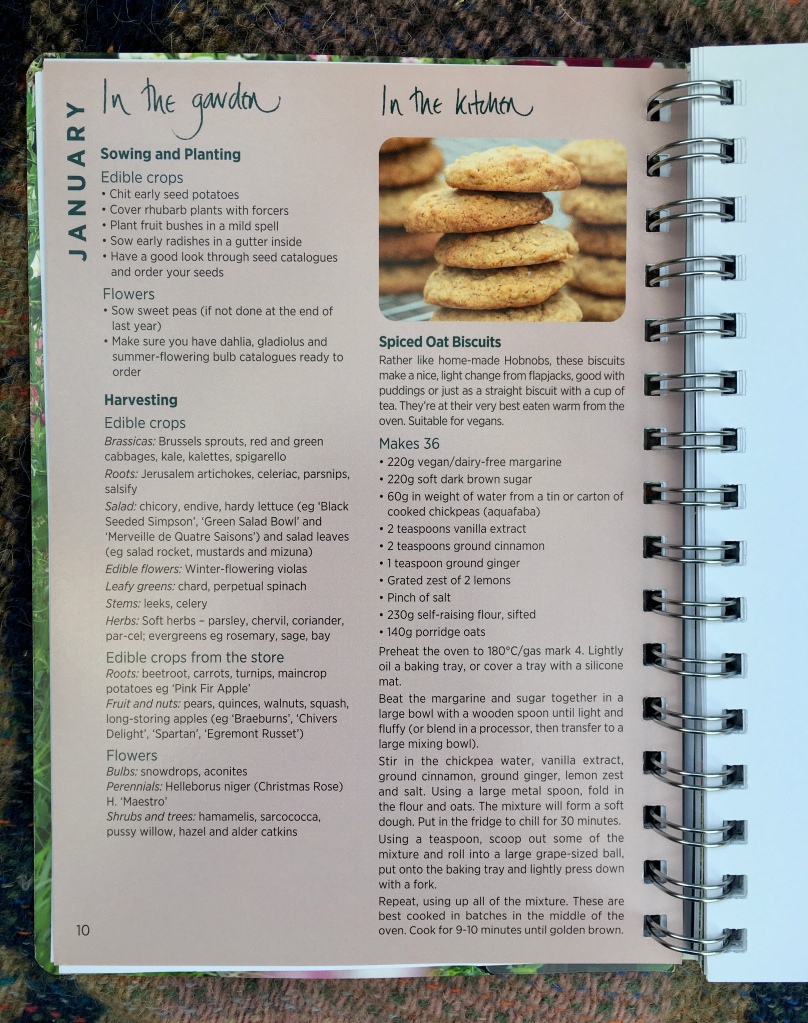
There’s recipe suggestions for each month. I’ve made these spiced ginger and oat biscuits and can report they are absolutely delicious. The family demolished them in just one day. They are quick and easy to make, which is just as well as I’ve have had another request for some more. I made the vegan version by using dairy-free margarine.
I used the chickpeas for a red onion hummus dip, which is also fast to make. Just cook a sliced red onion in 1 tbsp olive oil, add a tin of chick peas and 150ml water. Simmer for 10 minutes with the lid off. Add 2 tbsp lemon juice, garlic salt and pepper. Few tbsp of fresh parsley and chives if you have any. Whizz in a food processor and serve with toast or on jacket potatoes. Another recipe suitable for vegans, if you have any in the family as we do, or unexpected visitors. Which we also often have. They sit around the kitchen table while I quickly make this dish.

Here’s my spiced oat biscuits. Delicious with a cup of tea or coffee.
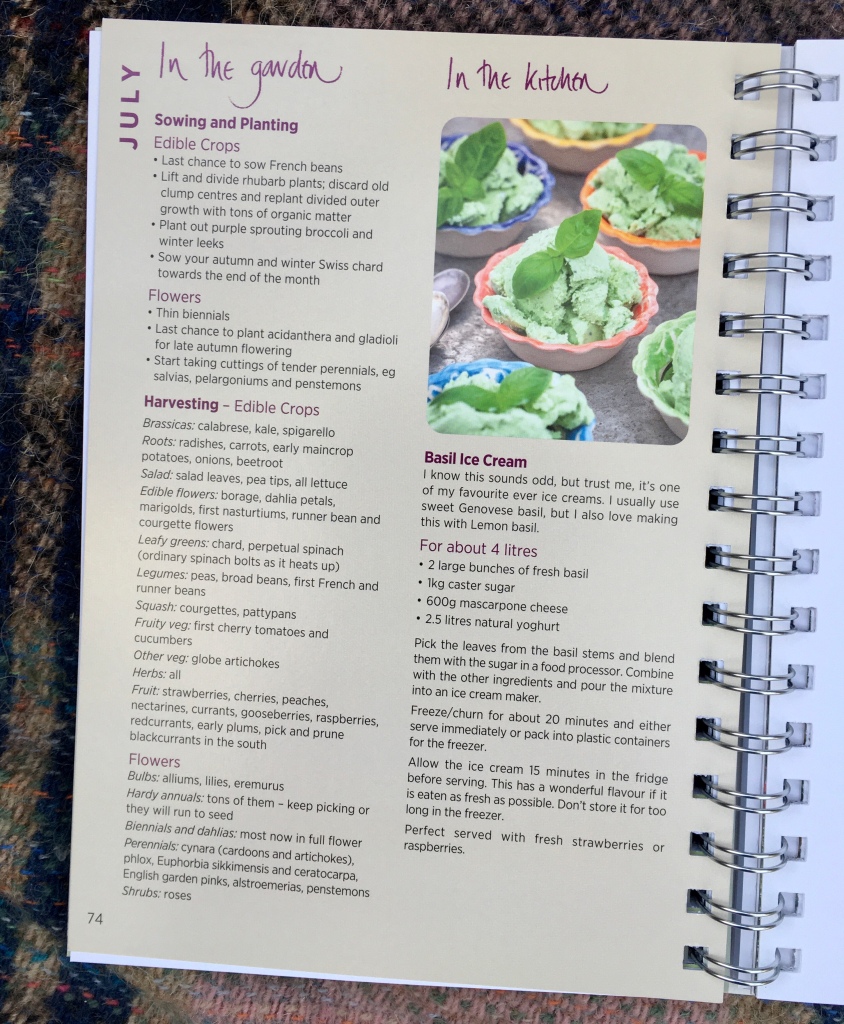
I’m intrigued by this basil icecream recipe for summer. As Sarah says, it sounds odd, but I’m going to give it a try and report back.

I’m going to have a go at these dried allium and poppy seed head decorations as well. Such a beautiful and cheerful Christmas scene from the fireplace at Perch Hill.
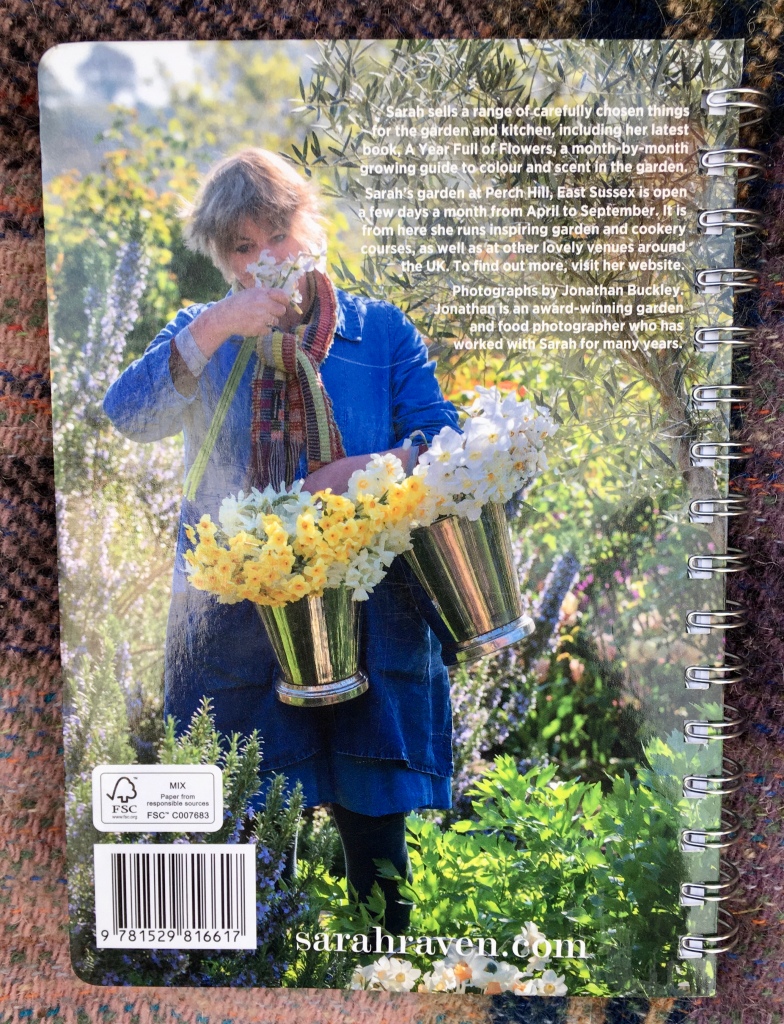
Other features of the book I liked: The fold-out ‘when and how’ guide on seed sowing for cut flowers. The guide to sowing and planting edibles, wild flowers, fruit, potatoes, herbs and salads. A guide to sowing and planting ‘pollinator super’ plants to attract bees and butterflies. There’s a useful ruler for seed sowing spacing. And the metal ring binder design means the diary can easily be folded back on itself.
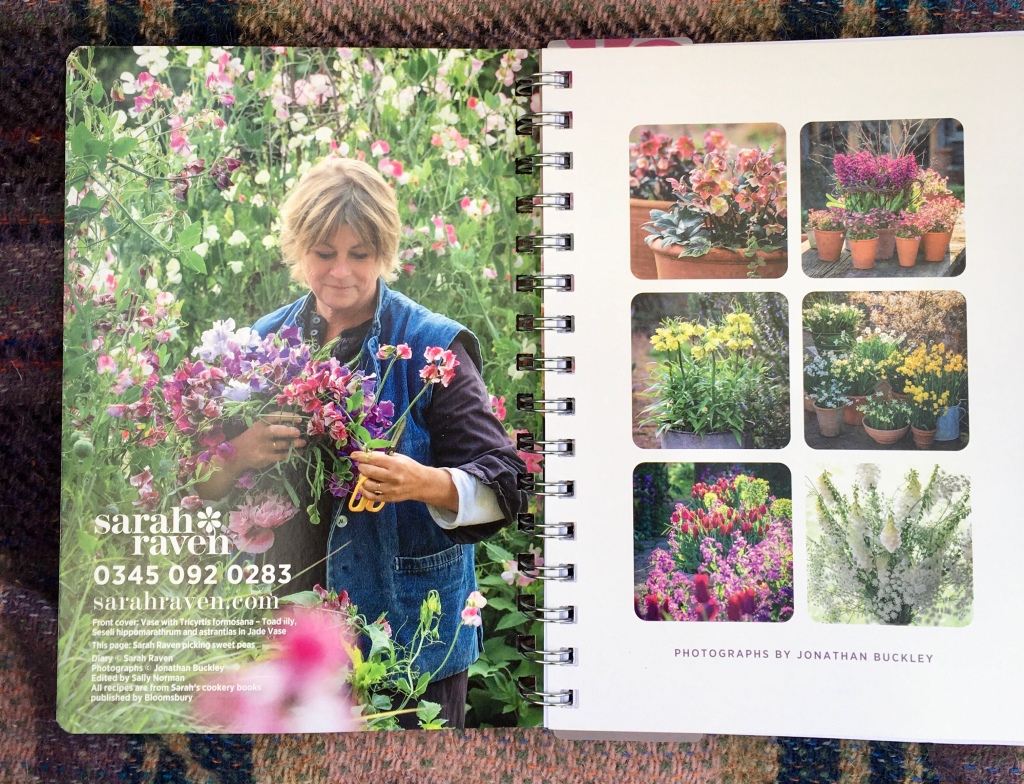
There are not many books I carry around with me all the time, but the Sarah Raven diary is robust enough to slip into my garden tool kit bag, and is proving a joy to dip into on a daily basis.
https://www.sarahraven.com/products/sarah-raven-diary-2021

Sarah Raven also sent me a wall calendar to try, and this too has beautiful photos for each month and plenty of space to write appointments and events. Both will be ordered for 2023 as I’m thoroughly enjoying using the calendar and diary.
Do any of you write a garden diary? My father in law used to keep a perpetual diary. Sadly he died last summer, but he gave me his diary with all the daily notes about sowing dates and varieties he preferred. I check each day to see if I am keeping up with his impeccable timetable. It’s a lovely way to remember him and a reminder of all the flowers he grew for his wife Joan, and the fruit and vegetables he grew for the family.
Info from today’s BBC Radio Leicester Gardening Show -Saturday 4 December 2021
Here’s some links to the recipes I mentioned today, and ideas for home-made and home-grown Christmas decorations and presents.
Thanks to everyone who listens in on a Saturday morning at 11am, and thank you also for all your kind and encouraging comments. Many thanks to Tracey from Melton who says she feels like rushing out into the garden to do some gardening every time she hears us talking on the radio. It’s much appreciated.
We talked about:
Planting tulips
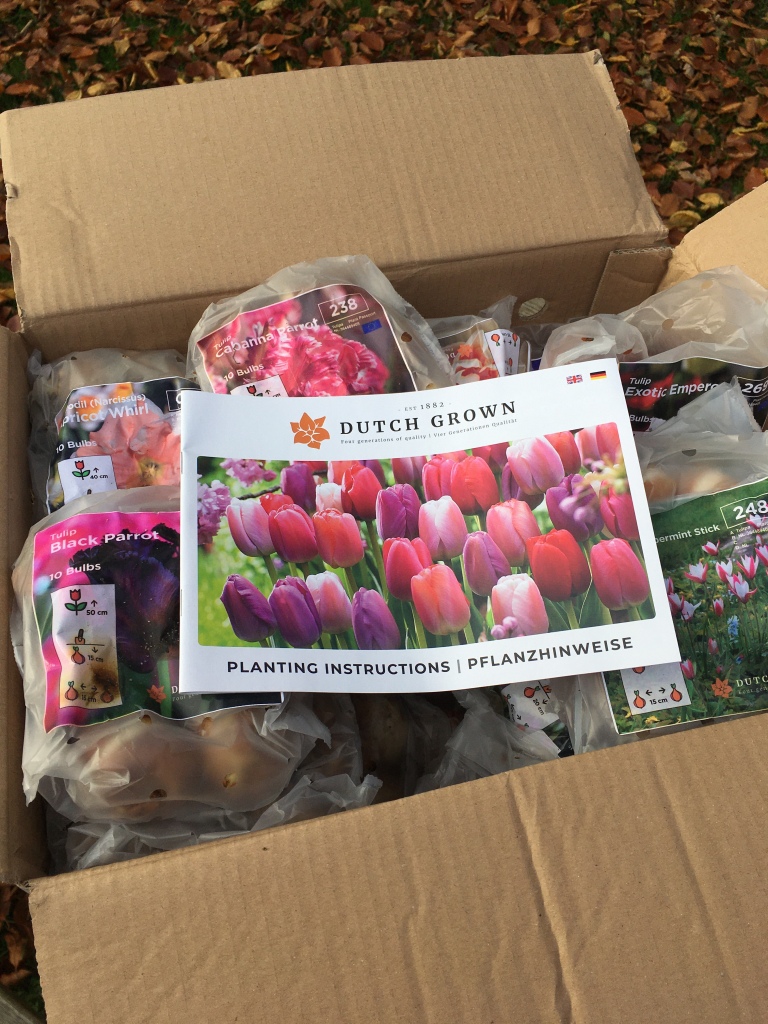
As regular readers know, I love to save money. If you wait until December, many tulips have been reduced in price. If you are looking for a bargain, try well-respected suppliers. I recommend:
Dutch Grown: (now sold out- but keep a note for next year)
https://www.dutchgrown.co.uk/collections/tulips
GeeTee Bulbs
Peter Nyssen
https://www.peternyssen.com/autumn-planting/tulips.html
If you are buying from garden centres, tulips will be sold in plastic bags with a cardboard front showing the photo of the variety and information about growing them. These are usually hanging up on racks. Gently squeeze the bulbs to make sure they are firm. Any soft mushy bulbs will fail to grow. They need to be firm and dry. Don’t buy any with a blue mould growing on them. Nice large, plump bulbs with the brown papery skin intact are best. I wouldn’t buy any that have been stored and displayed outside either, incase they’ve got frosted or wet. Choose ones stored inside the garden centre instead.
Here’s some inspiration for bulb planting from a previous blog I wrote. I’ll be planting my tulips up until the first week of January:
https://bramblegarden.com/tag/tulips-parrottulips/
MAKING CHRISTMAS DECORATIONS FROM THE GARDEN
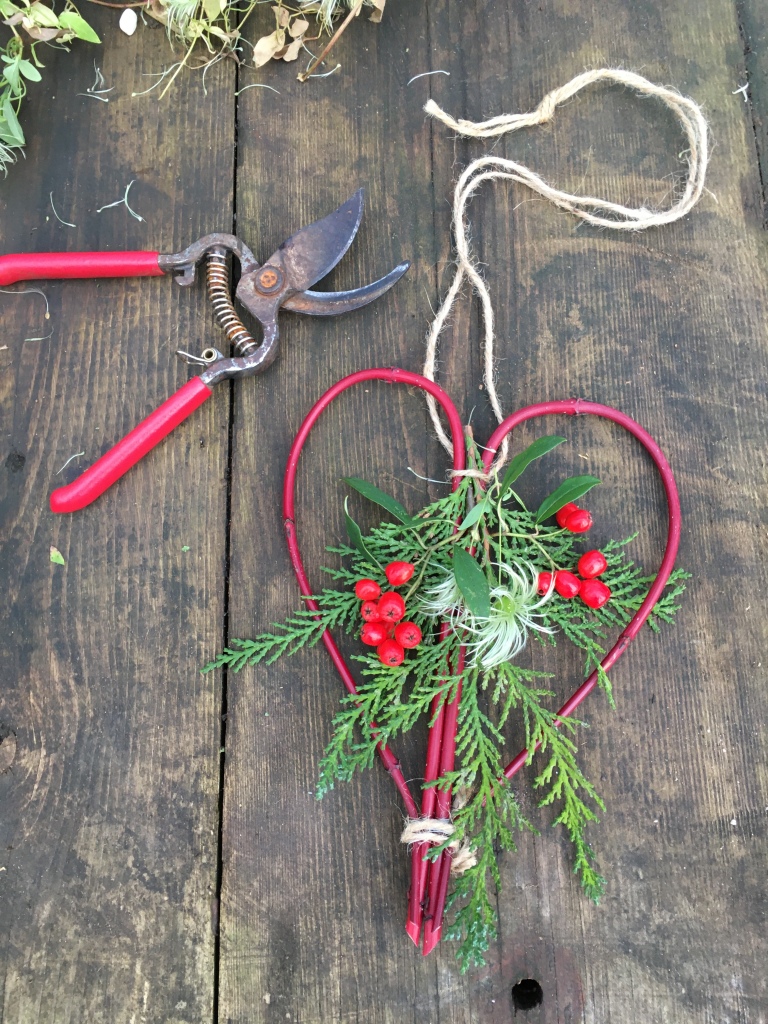
Dogwood hearts are really easy to make. Take two pencil thin stems of dogwood or coloured willow. Bend each side over to form the heart. Tie with florists’ reel wire or string to secure. Decorate with foliage and berries. I’ve used cotoneaster here. Add some fluffy seed heads, such as. ‘old man’s beard’ or wild Clematis Vitalba. I’ve used string, but you can use any type of ribbon to hang the decoration. These hearts can be any size. I make a giant one with four stems to create a double heart for decorating our five bar farm gate.

Some more ideas for using natural materials from the garden. I’ve threaded inexpensive, mouldable wire lights from Wilkos to these dogwood and willow stems. I sprayed hydrangea heads with florists’ silver spray.


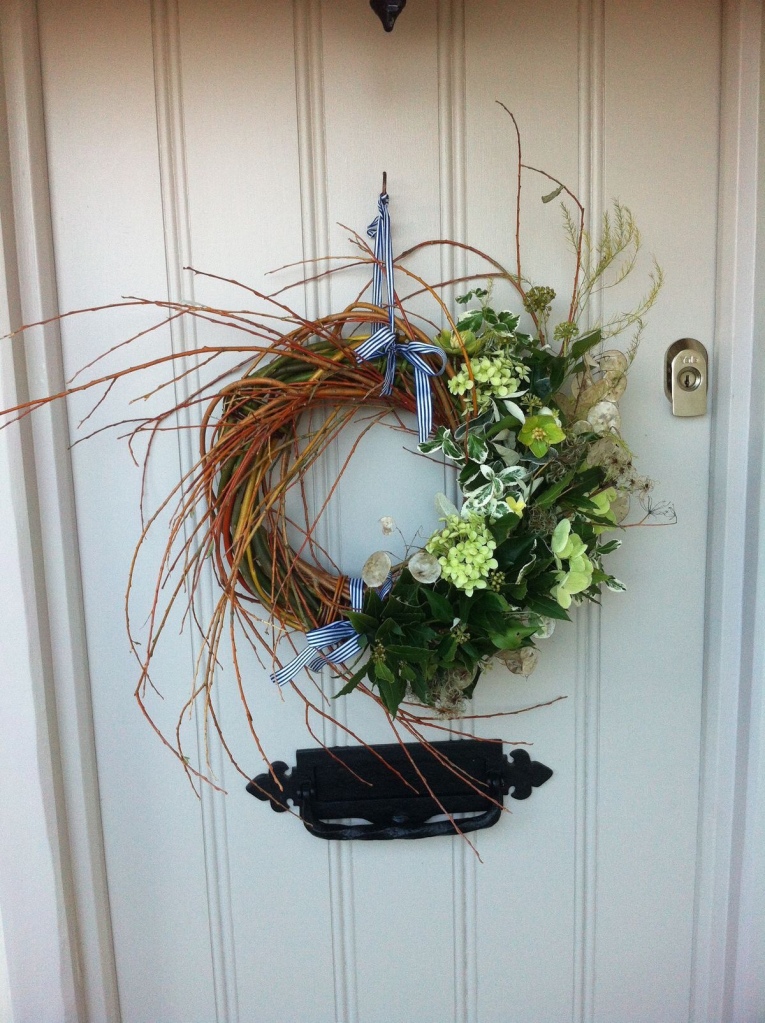
My front door wreath also has flowers and foliage from the garden. The flowers are hellebores from the Gold Collection. There’s a whole range of them, all recommended. Hellebore Jacob flowers for Christmas and is pure white. This one is Winter Gold, with white hydrangea flowers which have dried lime green.
I learned how to make these willow wreaths on a course by the highly respected florist, author and social media/ you tube star Georgie Newbery. Workshops in flower farming, creating a cut flower patch, growing sweet peas, and floristry, are highly recommended. Would make a perfect present for a gardener. There are also many on-line courses. Have a look at the you tube channel and on instagram to get some wonderful, original ideas.
https://www.commonfarmflowers.com/
BEETROOT…

We talked about growing beetroot today. Most of my beetroot is stored in dry sand or recycled, dry compost over winter in the frost free potting shed. I grew it in the spring and summer. I’ve left some in the ground, but it’s easier to lift and store, as it can’t be harvested from frozen ground. The best variety to grow is Bolthardy, which does what it says; it grows well without bolting or running to seed. Did you know you can eat the leaves? You can use them in salads and stir fries. You can grow just leaves now on the windowsill. Look out for Bulls Blood variety sold as windowsill growing seeds. Mr Fothergills (Johnson’s seed) sell them on-line and in garden centres. You can grow them in 9cm pots on a sunny window and harvest shoots and leaves when they are 4” tall. They will re-grow several times, making a tasty addition to salads and sandwiches.
BEETROOT CAKE
We talked about baking with beetroot and making chocolate beetroot cake. Here’s my recipe for a rich fruit/ beetroot cake. It’s tasty and good for you!
JOAN’S CHRISTMAS APPLE CHUTNEY RECIPE
Regular readers will know that my much loved wonderful mother-in-law Joan is in a care home in Oadby, Leicestershire. She suffers from mixed dementia. Before she became ill, I wrote down all the family favourite recipes and at Christmas I make them for her children, grand children and great grandchildren. It’s a wonderful way to ‘keep her with us’ even though, sadly, she can’t remember who we are.
Here’s the link for the blog piece with the recipe
https://bramblegarden.com/2020/11/21/joans-christmas-apple-chutney-recipe/
CUTTING GRASS IN WINTER
We talked about cutting grass in winter. Twenty or thirty years ago we used to send our lawn mowers off to be serviced in October and we didn’t see them again until March. It’s an indication of climate change that nowadays we are cutting our lawns all year round. Grass grows when the temperature is above 6C. There is no harm in ‘topping’ grass if it needs it, providing the conditions are dry. Set the cutters high for winter, and don’t scalp the lawn. We don’t cut the grass if the ground is wet or frozen, as it damages the lawn and makes muddy skid patches where weeds will grow. Never walk on frozen lawns as it damages the base of the grass stems and leads to fungal diseases. I would collect clippings over the winter too, and not leave them lying on the grass. Best not to walk on very wet ground as it causes compaction, which grass doesn’t like. Remember to leave some areas of the garden with long grass as a winter habitat for caterpillars and insects – these will be food for frogs, birds and mammals. Just a strip down the edge of the lawn will help.
HOME MADE CHRISTMAS PRESENTS

I mentioned my mint sugar and rosemary salt recipes which make lovely home made presents. Nearly all my presents are made from things grown in the garden.
Take 5 stems of mint, thoroughly dry leaves on kitchen towel. Strip leaves from the stems and layer them in a clean jam jar with 350g sugar. Stir every day for two weeks. Tip the contents into a sieve and remove the leaves. Pour sugar into clean jam jars and use within a year. Lovely for hot chocolate and cakes.
I recommend Stephanie Hafferty’s book The Creative Kitchen for seasonal plant-based recipes for meals, drinks, garden and self care.
https://bramblegarden.com/2018/11/18/the-creative-kitchen-book-review/
More recipes from the garden:
https://bramblegarden.com/2020/12/08/garden-news-magazine-recipes-for-december/
And finally, Arun mentioned that I had been shortlisted for Columnist of the Year for my Garden News magazine column, and Blog of the Year by the prestigious Garden Media Guild. I was delighted to be shortlisted in two categories. A really wonderful end to another challenging year. Thank you, every one of you, for reading this blog, listening to the radio on Saturdays, getting in touch and leaving encouraging comments, it is truly appreciated. Have a great gardening weekend!


You can listen back to the gardening show on BBC Sounds. It’s at 11.12.35 on the timeline. Or ask your smart speaker to tune in to BBC Radio Leicester on Saturdays from 11am. Questions are welcome via e mail, phone, text or WhatsApp. Start your message with the word Leicester, else it goes to other radio stations.
Latest news from the plot from Garden News magazine

To expand the photo to read, if using an i-pad or phone, place two fingers on the pic and spread thumb and finger. The picture will expand so you can read it easily.
Here’s the link for the recipe this week. It’s apple crumble cake, making use of the windfall apples.
https://bramblegarden.com/2017/10/22/paperwhite-narcissi-for-christmas-and-my-apple-cake-recipe/
Here’s the link for Fiona Cumberpatch art work and botanical tea towels:
Some more photos from the plot:





The weather has turned really cold here. We’ve had high winds and hail. I’ll be sorting through my seed box and making plans for next year this weekend. And keeping warm. All my tender plants have been stored in the greenhouse and poly tunnel, safe from freezing temperature. What gardening tasks have you been doing recently?
Have a lovely weekend everyone.
Overwintering pelargonium (geranium ) plants – BBC Radio Leicester phone-in questions for Saturday 6th November 2021
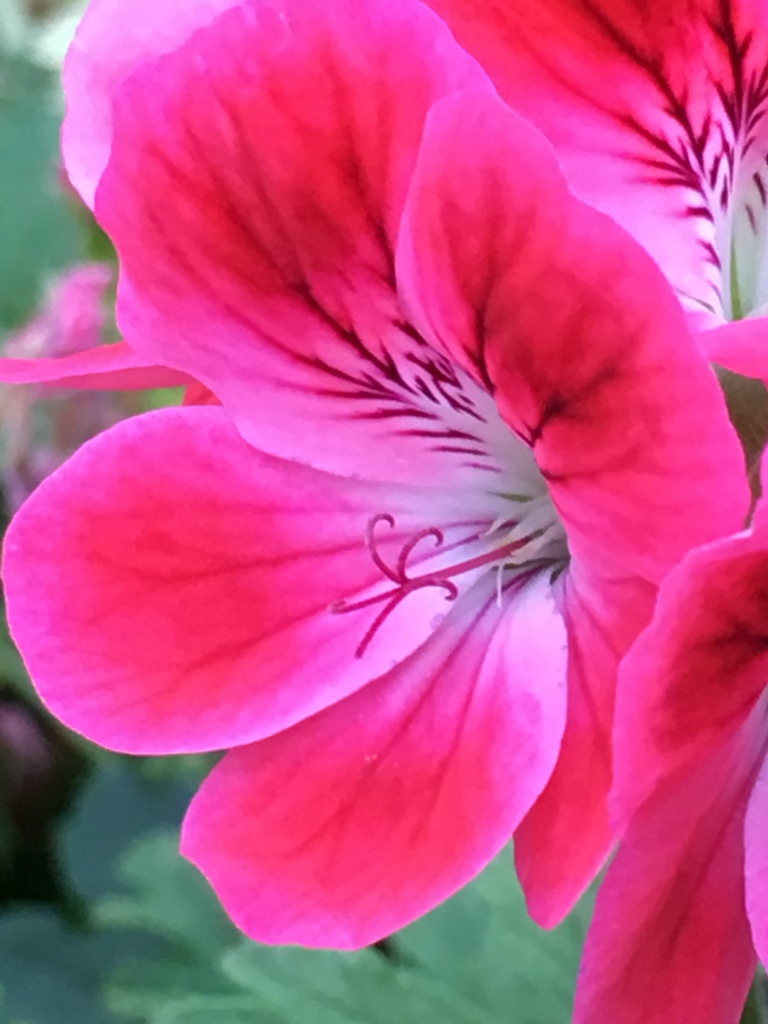
I grow a huge number of bedding pelargonium plants – better known as geraniums- for containers in the summer. They flower non-stop from June to November. They are little trouble and all I do is give them some potash liquid fertiliser once a week, and regularly dead-head them
These are tender evergreen perennials and can be kept over winter in a frost free place. This year I have nearly 100 4” pots, full of cuttings which will be kept in my heated greenhouse. This is a space-saving method to keep them from one year to the next. If you don’t have a greenhouse, a bright windowsill indoors is suitable. As long as the cuttings are kept frost-free they will fine. The secret is not to overwater them. In the greenhouse, I only water pots once when the cuttings are taken, and then I don’t water them again until next February when I want to start them back into growth. Cuttings kept indoors in the house will be watered very minimally as the temperatures indoors are higher than in the greenhouse. Full-size plants can carry on flowering all year round if they are brought indoors. Check them for pests and diseases before bringing them in and top the pots with horticultural grit to keep the surface of the compost dry. Wet compost promotes grey mould. Remove any damaged or diseased leaves. When watering, make sure to keep leaves as dry as possible by aiming the water at the base of the plants.
My father in law used to keep his prize-winning pelargoniums in the garage. He dug up his plants in autumn, shook off all the compost, removed all of the leaves and wrapped the remaining stumps and roots in newspaper. They were kept cool, dry and frost free until the spring. I’ve tried this method, but only found it partially successful as my potting shed got damp in winter.
Here’s a blog post I wrote about overwintering my pelargoniums: https://bramblegarden.com/2019/09/15/clearing-out-the-greenhouse-taking-pelargonium-cuttings-sunday-september-15/
Are you planning to keep your pelargoniums over the winter? Or do you sow yours from scratch each spring? Or buy them ready to plant from the garden centre in early summer?
This year I grew all my bedding plants, including some new varieties of pelargonium, from packets of seed. I was amazed how many pelargoniums could be grown from such tiny dust-like seeds. It was a money-saving option that worked out well.
Some more photos from my greenhouse and garden to brighten your day:


A collection of bedding pelargonium plants making a display in the greenhouse.
Common names can be confusing. Most people use the word geranium when they are talking about pelargoniums. But geraniums are a different plant genus. So to avoid confusion, people refer to them as ‘hardy geraniums’ – the sort you grow in beds and borders, as ground cover amongst other plants, and ‘tender geraniums’ (pelargoniums) grown in hanging baskets and containers.

A variety I’ve kept going for more than 20 years, taken from a cutting from my grandfather. It was his favourite pelargonium.
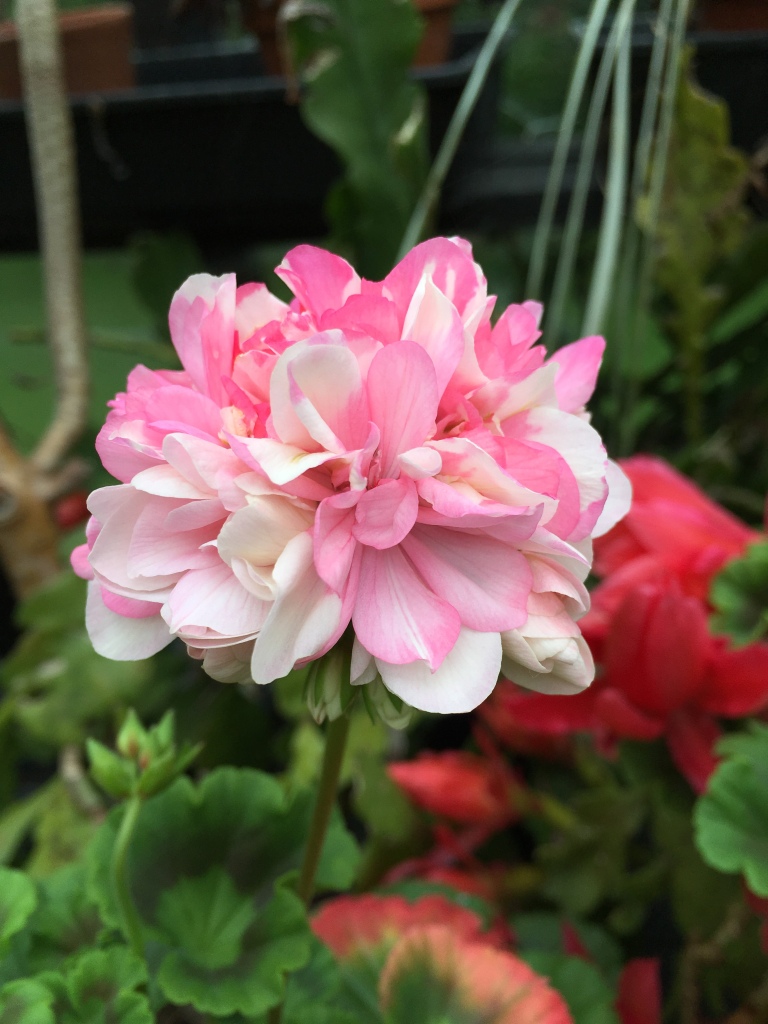
A miniature pelargonium which flowers all year round. This one came from Fibrex Nurseries, a specialist grower, highly recommended. https://www.fibrex.co.uk/. Miniature pelargoniums are wondrous things. I’ll write a new blog post explaining how to grow them. They are easy to grow and once you’ve grown one, you’ll want to start a collection. I warn you, they are addictive!
If you listen in to BBC Radio Leicester, the gardening programme has moved to Saturdays at 11am. Josie Hutchins and I take it in turns to answer phone-in questions and talk about what gardening jobs we are doing each week. If you have a question, please get in touch with The producer, Dale. We are one of the few local stations now offering gardening advice on the radio.
Overwintering Dahlias – BBC Radio Leicester phone-in questions for Saturday, November 6 2021

Dahlias have been fabulous this year, giving masses of cut flowers from mid June until November. We’ve had unseasonably mild weather, which means we still have flowers today. But other areas in the county have had night-time frosts. So now is the time to dig up and protect your dahlia tubers for the winter.
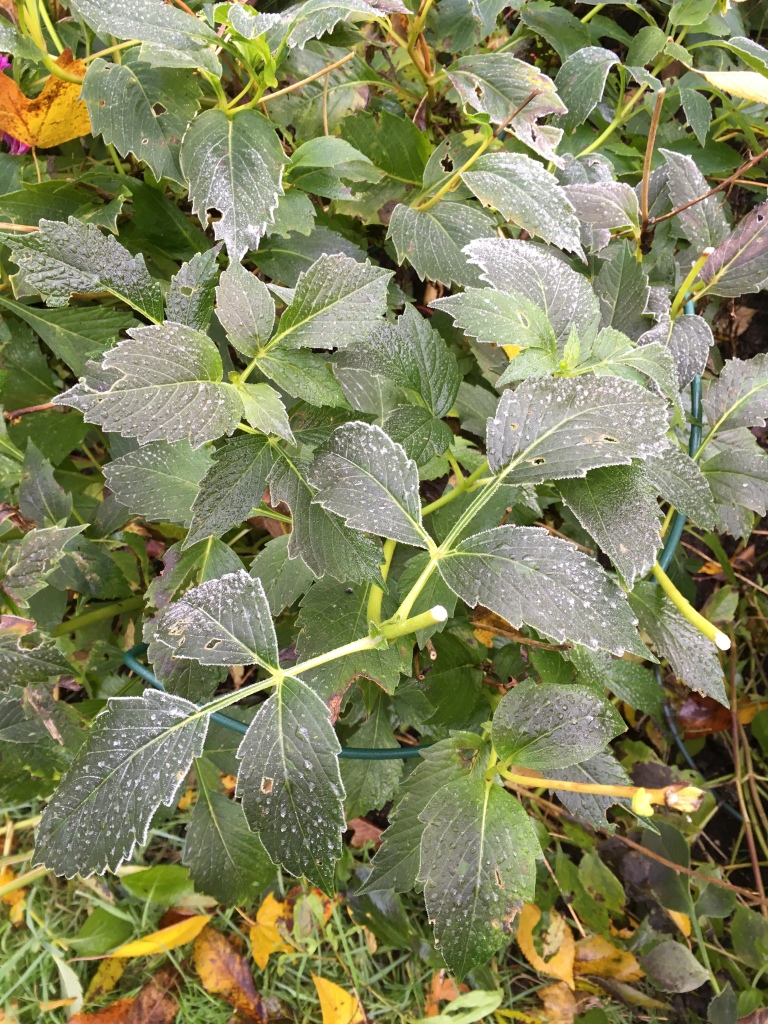
There are two methods for saving dahlias for next year. You can either dig them up and store them in a frost-free place, or you can leave them in the ground and cover them with dry leaves, straw or horticultural fleece. Leaving them in the ground is only possible is you have well-drained soil. In heavy clay, and or where gardens flood, the tubers will rot.
Method 1. Digging them up:

If you are planning to dig them up, wait until the foliage has been frosted. This makes the dahlias absorb goodness back into the tubers and sends instructions to become dormant.
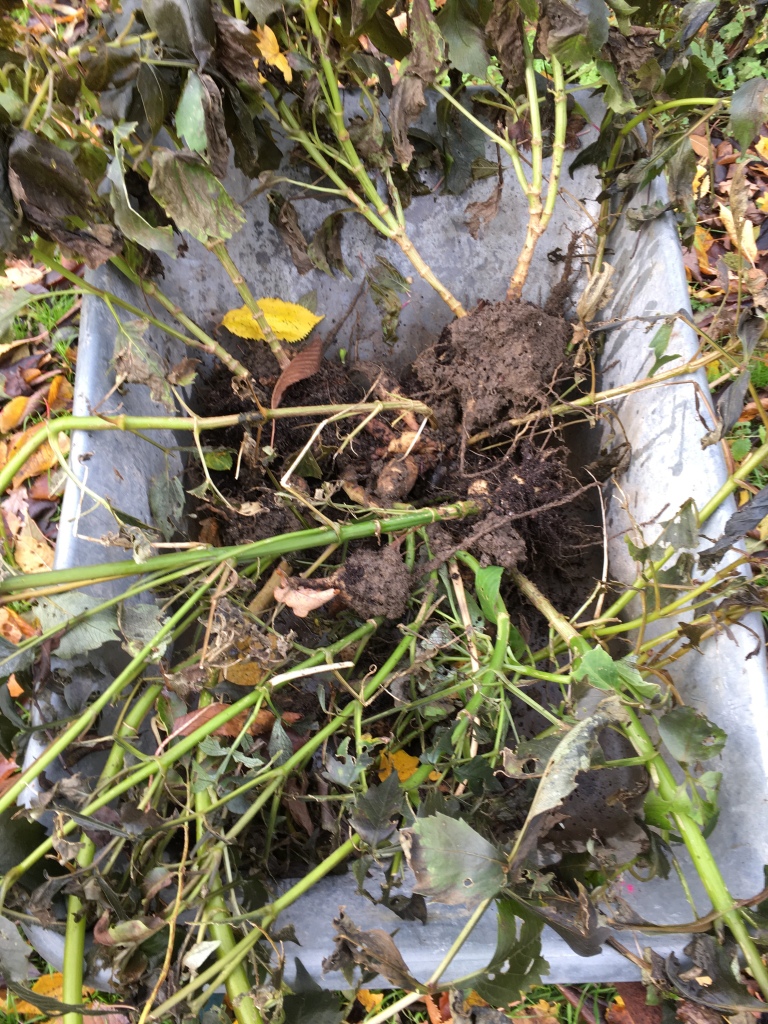
Using a fork, carefully dig up the tubers, taking care not to damage them. Remember to keep any labels with the tubers. Brush off the soil if you can. If they are wet and muddy you can wash off the soil and use a soft brush to clean them up. Or you can put them in a shed to dry and brush the soil off in a week or two. Washing and brushing helps to remove slugs and earwigs and other soil-borne pests and diseases .
Cut back the stems leaving about 3”. Turn the tubers upside down so moisture drains out of the stems. After a week, turn the tubers the right way up and store them in pots or seed trays. You can use dry compost or horticultural fleece to cover them. Keep them in a cool, dry frost free place such as a garage or potting shed.
Tip: You can plant tulips in the space left behind in the garden. I dig up the tulips next spring to make way for the dahlias again.
Method 2. Leaving them in the ground:

If you have well-drained soil, you can try to leave some dahlias in the ground. In a very cold, wet winter, this is risky.
To leave them in the ground, do not cut off the stems. Fold the stems over and collapse them back onto the tubers, this will stop the stems becoming like ‘straws.’ Cut stems will direct water straight to the tubers, causing rotting.
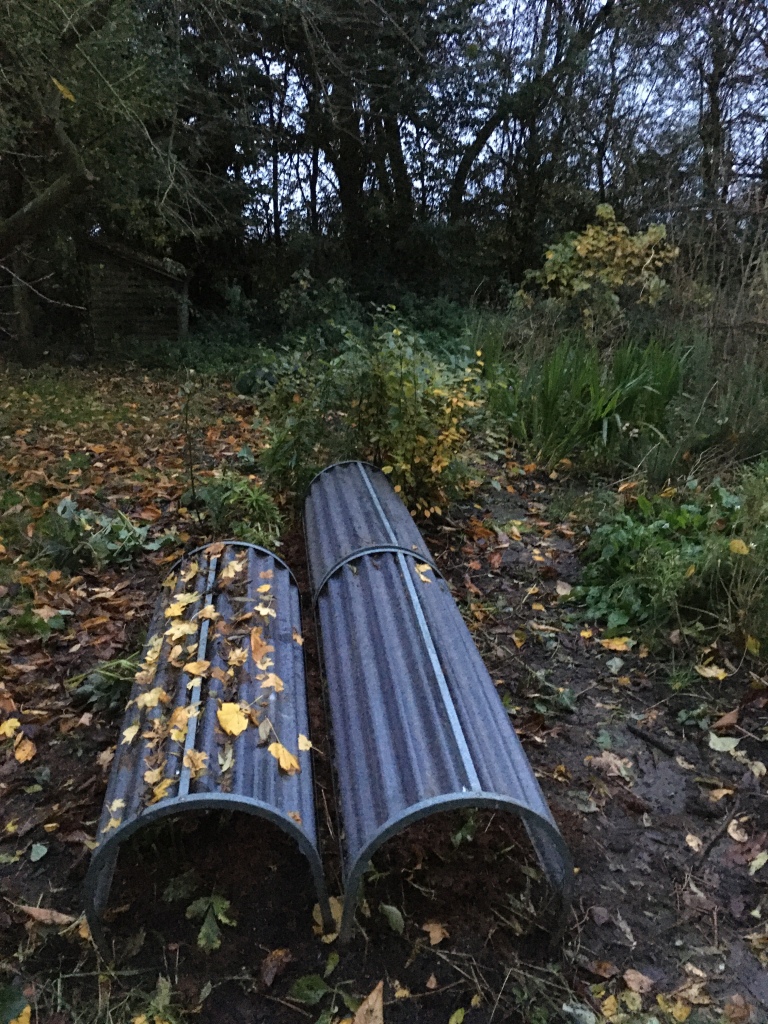
Cover the tubers with a thick layer of dried leaves, straw or horticultural fleece. I usually try to keep them dry by covering them with sheets of recycled corrugated plastic or old compost bags. Plastic cloches can also be used.
Tubers will be started back into growth next spring.

Here’s some dahlias from my plot. Nuit D’Ete with cosmos and persicaria.

My favourite orange dahlia, David Howard, shown here with chrysanthemum Swan.

Dahlia Evelyn with carnations and senecio grey foliage from the plot.
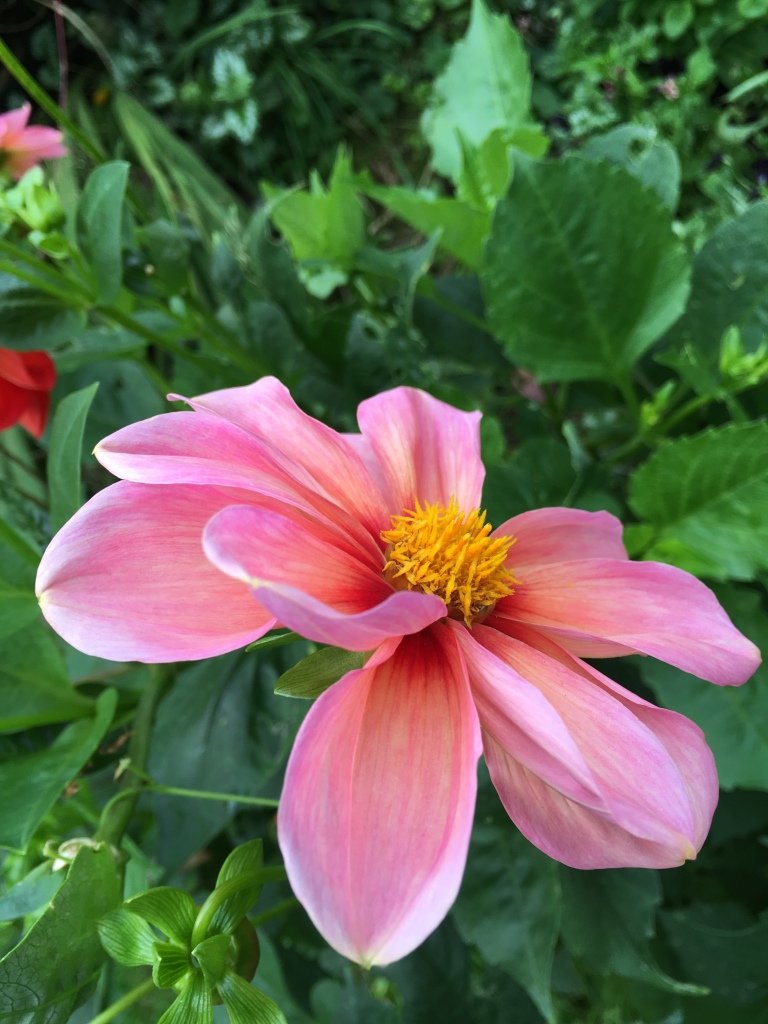
Dahlias can also be started from seed in early spring . This was from a mixed packet which included lots of jewel-like colours. This summer I’ve grown the ‘Bishop’s Children’ range which has lovely bright reds, purple and orange with attractive, dark-coloured foliage.
I wrote about Naomi Slade’s new book on dahlias here: https://bramblegarden.com/2018/06/24/dahlias-beautiful-varieties-for-home-and-garden/
How have your dahlias fared this year? Which method are you using to save them over the winter? Do you have any further tips to share?
Thanks for reading my blog, and listening in to BBC Radio Leicester for the gardening show on Saturdays at 11am. If you have any questions for either me or Josie, please leave a message here or get in touch with producer Dale. We are very pleased to still have a gardening programme when many other stations have now cancelled them.
I am @kgimson on twitter and karengimson1 on instagram.
Accidents in the Garden
Winter is just around the corner and there’s a feeling of urgency to get on with gardening jobs, before the weather turns cold. I’m always rushing around. There’s tender plants to bring under cover, pots to plant and bulbs to sort out. There’s never enough time to do everything. However, gardening tasks can end in accidents causing painful injuries. Here’s a reminder to take extra care this autumn and winter when working in the garden.
TAMSIN’S STORY

We were all shocked to hear news that Tamsin Westhorpe had suffered a fractured spine in a recent gardening accident. Tamsin is a writer, and editor and works as a gardener at her family’s farm, Stockton Bury Gardens, in Herefordshire. I wrote about Tamsin last year when she published her country diary book. Here’s a link: https://bramblegarden.com/2020/02/22/diary-of-a-modern-country-gardener/
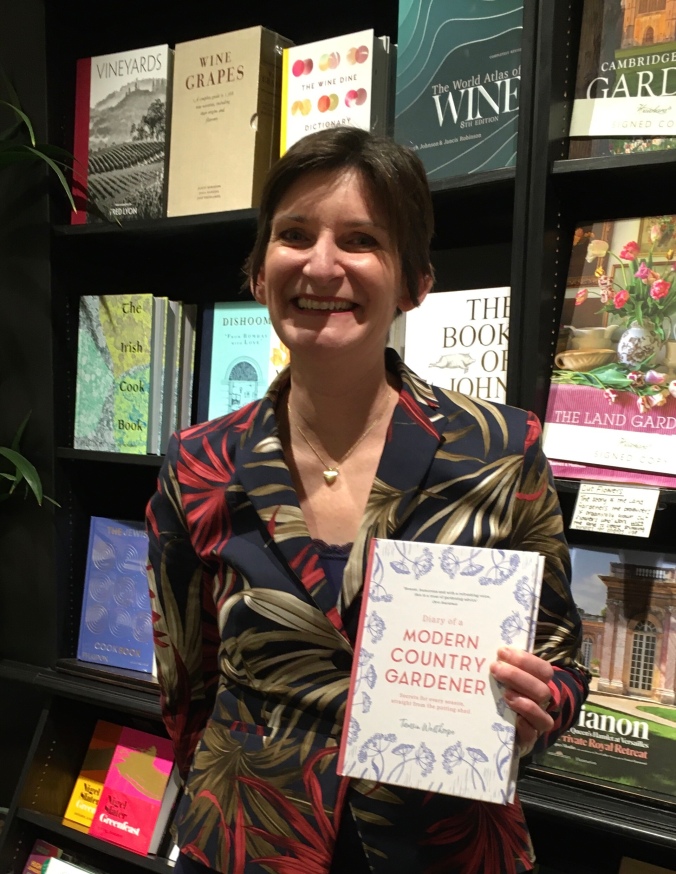
I asked Tamsin to tell me what happened when she had her accident in the garden, and here’s what she said:
It was a sunny Saturday at the start of September. I had a rare day off from work, so I was determined to make a mark on my much-ignored home plot. My day job is to help my uncles garden their four-acre open garden, so my plot gets pushed to the back of the priority list.
What task were you doing when the accident happened?
I have a row of six aronia trees that I like to keep to a manageable height of about 9ft. My aim was to remove the very enthusiastic young growth and give them a neater shape. To reach the centre branches I needed a ladder. In my haste a grabbed a lightweight A frame ladder and headed down the garden armed with enthusiasm and secateurs. I was on a mission to get as much done in a day as possible.
Describe what happened next.
Standing on one of the top steps I simply leant forward to reach a central branch and the ladder went from under me. It happened so quickly, and I found myself flat on my back on the lawn in agony.
What were your first thoughts?
My first thoughts were for the garden. Who would lift my dahlias and plant the tulips? Being part of a small family business, I was concerned how the other members of the family would be impacted. Physical fitness is essential for my work.
My second thought was that I’d been a complete idiot and should’ve waited for someone to hold the ladder. To say I was cross with myself was an understatement.
How did you get help?
My garden is in a rural location and not looked over by any other houses. I shouted but no one came as my family were out. I know only too well that you shouldn’t try and move if you have an accident, but I was struggling to breath, so somehow struggled to the house to get my phone. How long this took and how I can’t recall.
What were your injuries?
My spine has a stable fracture and I cut the back of my leg quite badly. However, I have been incredibly lucky. I’m so thankful that my spinal cord wasn’t damaged, and I didn’t hit my head. As far as I’m concerned, I have had a very lucky escape.
When working from a ladder in future I’m going to ensure that the pots and tools are placed well out of the way and I always have a friend or family at the foot of the ladder.
How long will your recovery take?
All being well I will make a full recovery in about 12 weeks. I should be able to plant my own tulips this year! For now, I’m not lifting anything and I’m focusing on doing all the right things to speed up my return to the garden. I’ve already seen the impact of trying to rush things so I’m not about to make the same mistake twice.
Anything happened like this before?
I’ve been gardening since the age of 16, spending time as a parks gardener, greenkeeper and interior landscaper. In all those years I have only succumbed to one nasty incident with a pair of secateurs (again caused by trying to rush a job) and a few splinters. So, all in all I’ve been lucky and don’t see gardening as a dangerous hobby – far from it in fact. Gardening has kept me physically fit for decades. I’m the only danger! By being impatient and trying to garden at speed I’ve caused this accident to happen and only have myself to blame.
Having said all that I think my steel toe capped boots have saved my toes on many occasions.
How do you feel now, mentally and physically?
I am feeling better by the day and although I can’t do anything for long, I’m seeing improvements in my physical heath. A gardening friend suggested I put comfrey oil on my back to help with the healing process. I have no idea if it is working but I love the idea of a plant being involved in my recovery.
Having not experienced an accident of this nature before I was surprised at how much shock has an impact on your mental wellbeing. It’s been difficult having to scratch out events in my diary, but I have the good fortune that I will recover. The messages from fellow gardeners have been a great help and I’ve been thrilled to hear from many who say they now won’t go up a ladder without an ‘assistant’. I’m glad that my accident might prevent others from having a similar experience.
This time has made me feel such concern for those who won’t recover from an accident or can’t tend their garden due to old age. I can only imagine how frustrating and devastating this must be. I’ve also experienced the healing power of nature. Thanks to a wonderfully warm September I have been able to recover under a blue sky outside. Watching the birds and insects flutter around me has been just the best medicine. It’s given me time to realise how important gardening is to me and my health.
What advice would you give other gardeners?
Invest in a proper gardening ladder for one. Secondly never use power tools and climb ladders when on your own in the garden. Thirdly keep your mobile phone in your pocket but put it on silent so your gardening time is undisturbed. But, the most important thing is to never rush gardening – sip it like a good glass of wine and savour every moment. It’s not a race.
Update: Tamsin has made a good recovery, and is now back at Stockton Bury making a start on light gardening duties.
Here’s some photos of Stockton Bury taken when I visited the garden this summer.

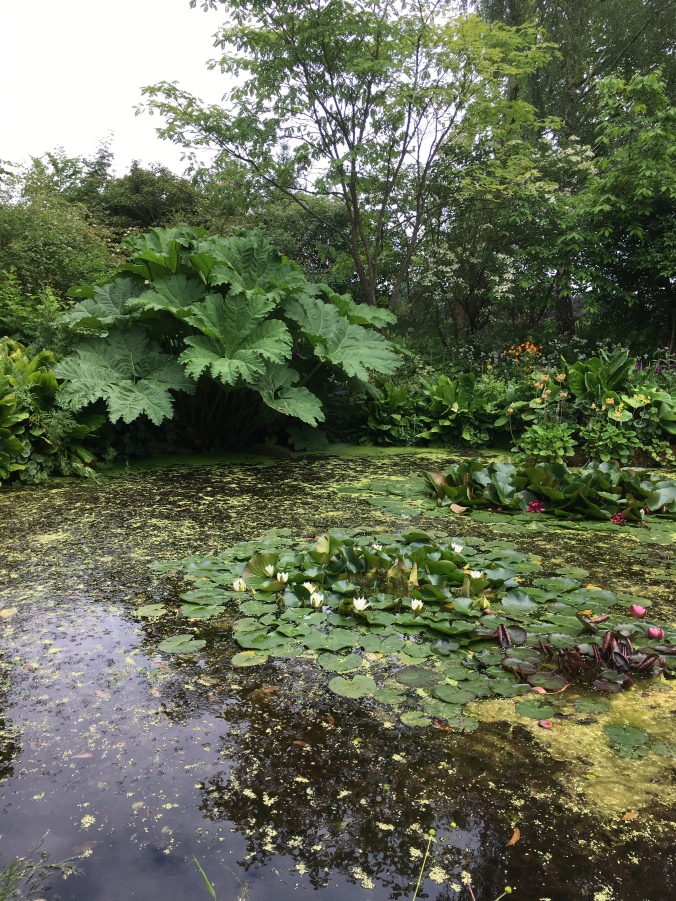

Have you any experiences to share involving injuries while gardening? Please share any advice and suggestions.
Please feel free to share this item on social media. Thank you for reading my blog.
Diary for Garden News Magazine
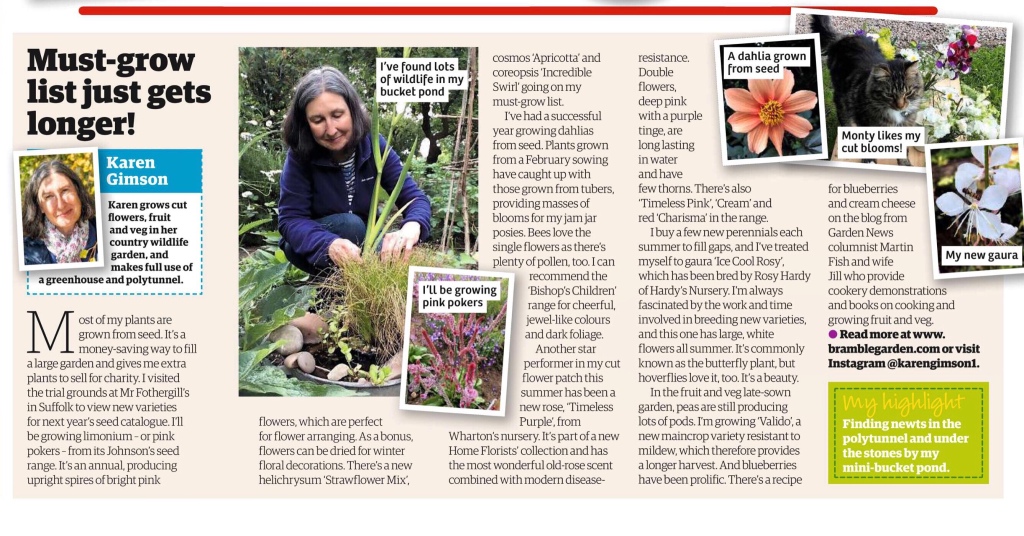
Latest news from the plot. Click on the photo to enlarge the print. There’s never enough room for all the photos I take. So here’s a selection of pictures to go with the diary recently published in Garden News Magazine.

I’m looking forward to growing this Limonium Pink Pokers next spring. The photo above was taken at Mr Fothergill’s seed trial grounds in August. I love the two-tone flowers and their delightful habit of twisting and turning as they grow towards the sun. They remind me of fireworks. I’ll start seed sowing indoors in February at 20C in a propagator and plant them out in June. They will be perfect for my jam jar posies. In addition, flowers can be hung up to dry. It will be useful to have flowers for winter decorations. Limonium, a half hardy annual, grows to 80cm and flowers from June to October. Available from Johnson’s seed, the premium range from Mr Fothergill’s.

In the article above, I mention growing dahlias from seed. I’ve been so delighted with the success of my seed-sown dahlias this year. I’ve had outstanding flowers, large single blooms with bright, jewel-like colours. It’s a money-saving option too. My Mum manages to fill her back garden with dahlias grown from a packet of seed. Started early in February, seedlings make small tubers and grow to full-size plants by mid-summer. There’s a non-stop supply of flowers for our vases. Plus bees love them too, so it’s an wildlife-friendly option. Pollinators have easy access to the flat, open centres of these flowers. You can sometimes see the ‘bee lines’ showing pollinators the way to the centre. If you don’t have any storage space for dahlia tubers over winter, don’t worry. You can get excellent results by starting from seed in spring.

this year with very good results. Each plant had dark leaves which set off the bright flowers a treat.

I mention the new Home Florists’ range of roses specially bred for cut flower gardens. I’ve been amazed by the sheer number of flowers these provided. Such good quality flowers which last a week in a vase, if water is refreshed each day. The scent is reminiscent of old roses, particularly old-fashioned bourbon roses. The roses, by Wharton’s Nursery, can be found in most good garden centres, or on line. Look out for Timeless Purple and Timeless Cream. Both recommended.
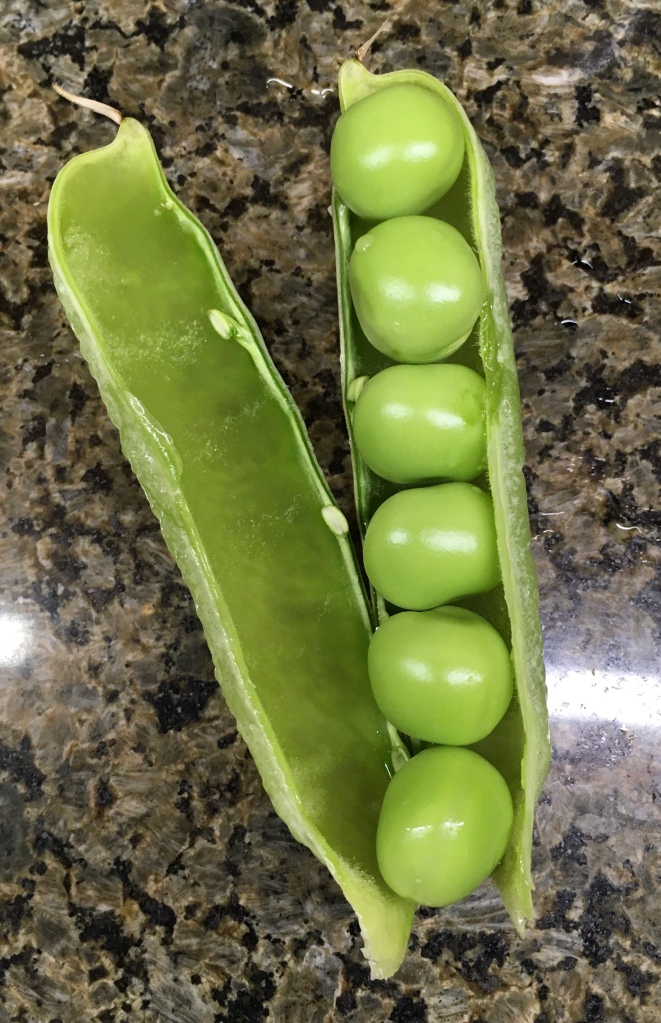
In amongst my cut flowers, I grow vegetables such as peas, climbing beans, courgettes, sweet corn and beetroot. I’m growing Valido peas, a new maincrop variety which is disease resistant. Luckily it is resistant to mildew which means the plants keep cropping right through to the autumn. Often pea plants turn brown as leaves and stems die back. Valido copes with anything the summer weather can throw at it, and produces a heavy crop of delicious peas. I’ve saved some of my seed for growing in seed trays over the winter. Pea shoots will be harvested just a few weeks from sowing – and won’t have cost me a penny. Lovely nutritious shoots to add to my salads and stir fries.

Monty Kitten is more like a dog than a cat. He follows me around the garden and likes to get involved in everything I’m doing. He followed me out onto the grass verge when I put my jam jar flowers out for sale.
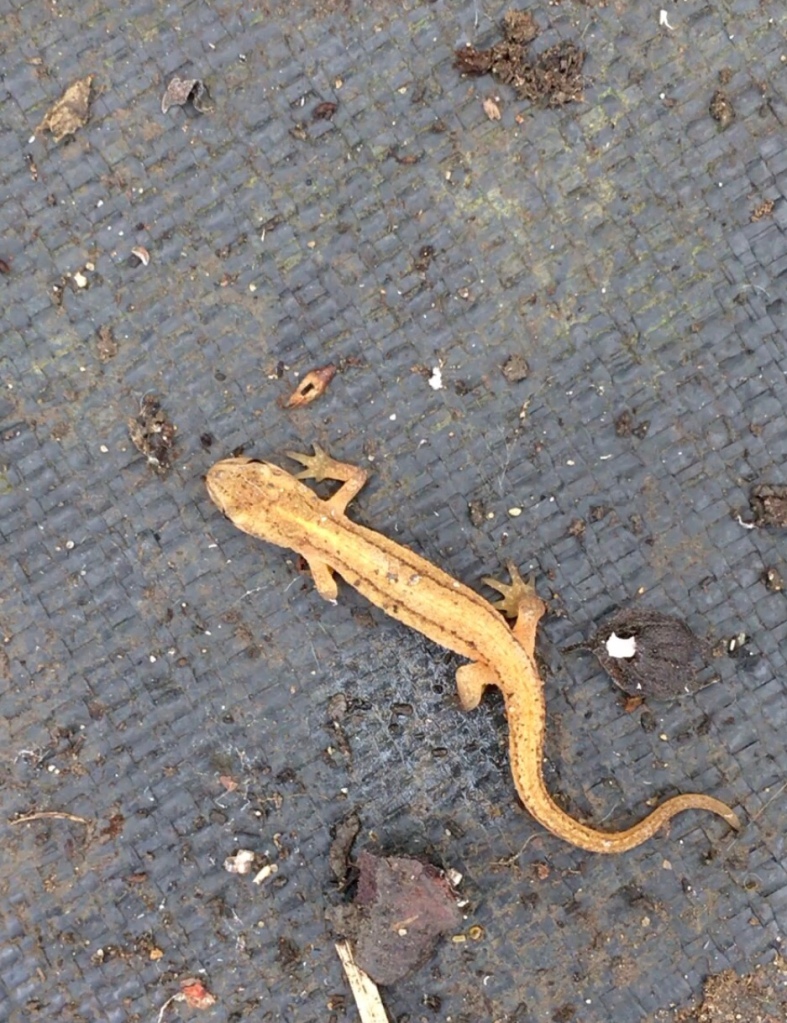
Finding newts in the garden is always a cause for celebration. It’s reassuring to find them under stones by my mini-pond, and in the greenhouse and polytunnel. They must be attracted by the moisture. I only use natural seaweed-type feeds, diluted in a watering can, to feed my fruit, vegetables and cut flowers on the patch.

Fruit and vegetables have grown well this year. In my basket there’s white-stem chard, perpetual spinach, herbs, white-flowered runner bean variety ‘Moonlight’ onions, tomatoes Blaby, Marmande and cherry types. There’s been a steady flow of blueberries from the plot. Ivanhoe is growing in a large 40cm diameter pot.

Here’s the link for the blueberry French toast recipe I mention: https://www.martinfish.com/in-the-kitchen/super-blueberries-in-julys-kitchen/
This is made by Martin and Jill Fish who provide cookery talks and demonstrations and have written a favourite book ‘Gardening on the Menu’ with advice on growing fruit and veg, and how to cook and preserve them.
Thank you for reading my blog, and my diary in Garden News Magazine. If you also listen to BBC Radio Leicester, the gardening show has moved from Wednesdays to Saturdays, 11am to 11.35. If you get in touch with the producers, I’ll answer any questions live on the show.
Have a great gardening week!
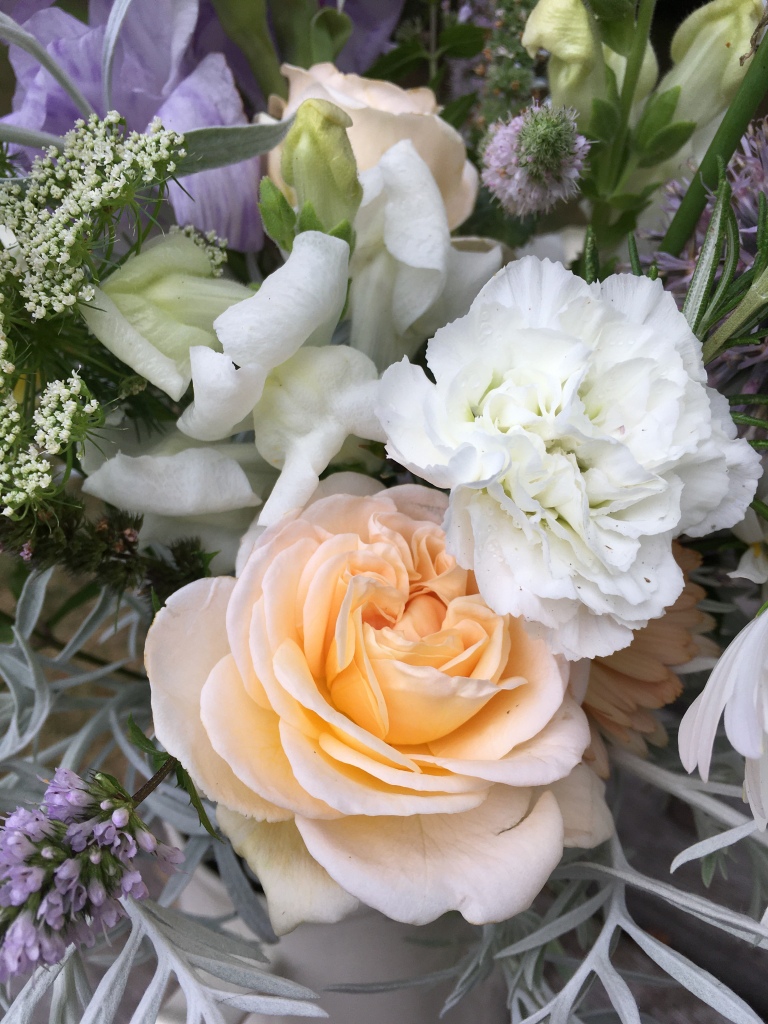
The View From Federal Twist- new book giveaway draw results.
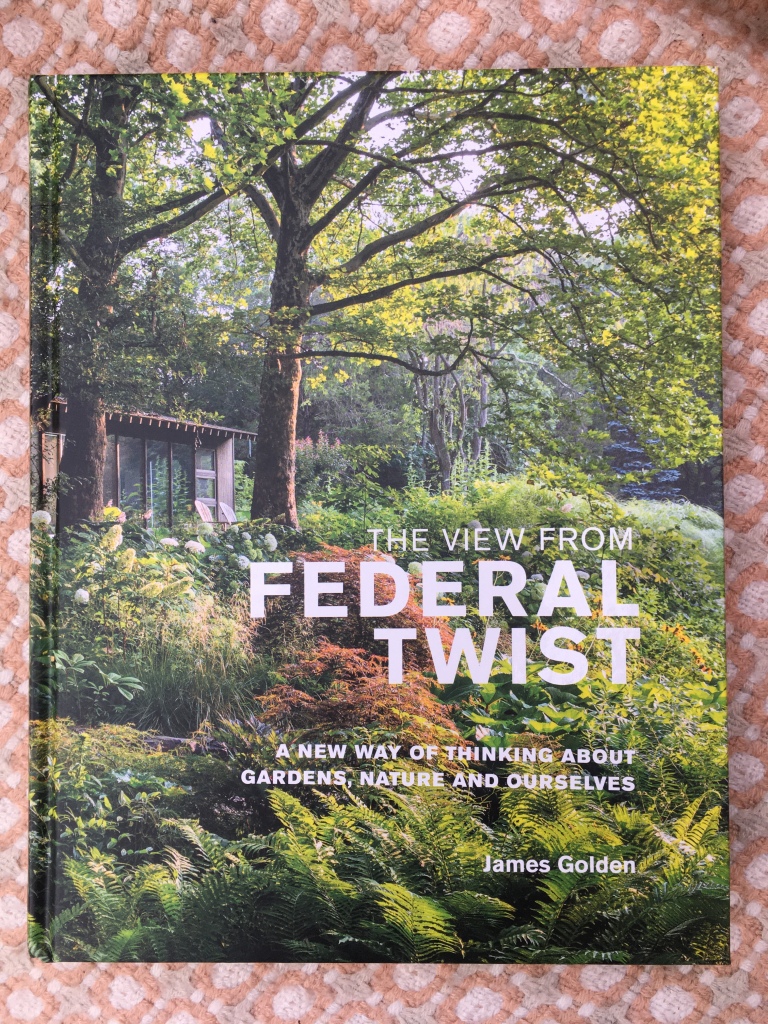
Thank you to everyone who read my recent review of James Golden’s new book published this week by Filbert Press.
A computer random name generator picked out two winters: Shaun and Jane.
I am also sending a selection of other new titles to Vanessa, Peter, Amelia and Sharon.
You can read my review here : https://bramblegarden.com/2021/10/28/the-view-from-federal-twist-book-review/
Thanks again to everyone who left comments. There will be more book and product reviews in the next few weeks. I’m very grateful to book publishers for sending out giveaway copies. Have a great gardening week everyone.



The View From Federal Twist- Book review
By James Golden
Published by Filbert Press
UK publication day 28 October 2021 £40
ISBN: 9 781999 734572
The publishers have kindly offered one copy to give away. Please leave a comment at the end of this review, and one name will be randomly selected on Sunday 31st October 6pm.

Books have a power to move. To tears, to joy, to despair. Sometimes they transport you to another place. James Golden takes you by the hand and leads you through the garden he’s created, and it’s one of the most beautiful, inspiring journeys you’ll ever take. In his new book, The View from Federal Twist, he describes what it’s like to create a garden from scratch in western New Jersey, USA. His garden is set in a clearing in the woods. He made a conscious decision not to improve the land. Instead he ‘listened to the site,’ placed large competitive plants into rough grass and watched and waited as sustainable plant communities emerged. The result is a magical place, a naturalistic garden -with a difference.

James describes the book as a retelling of the making of his ‘first serious garden.’ It’s a triumph of ecological planting and clear design aims. James is part philosopher, part experimental horticulturist. The result has such an emotional power- it’s breathtakingly beautiful. Evocative photographs capture the effects of light shining through the canopy of trees, grasses and shrubs. Just the scale of planting is mesmerising.


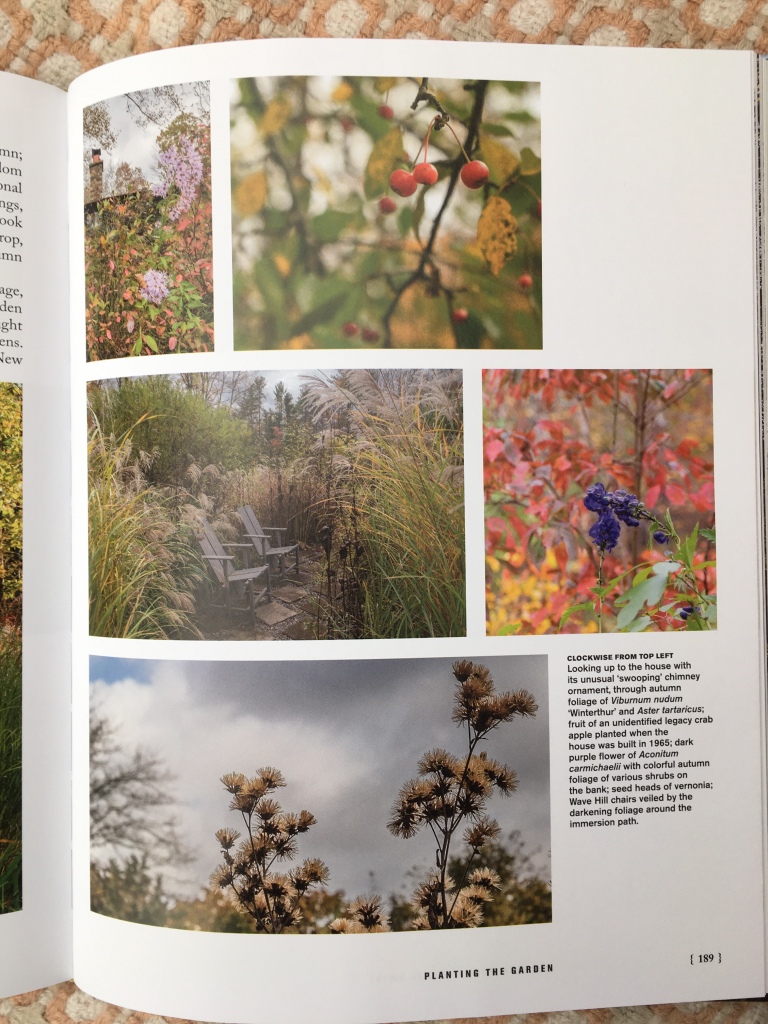





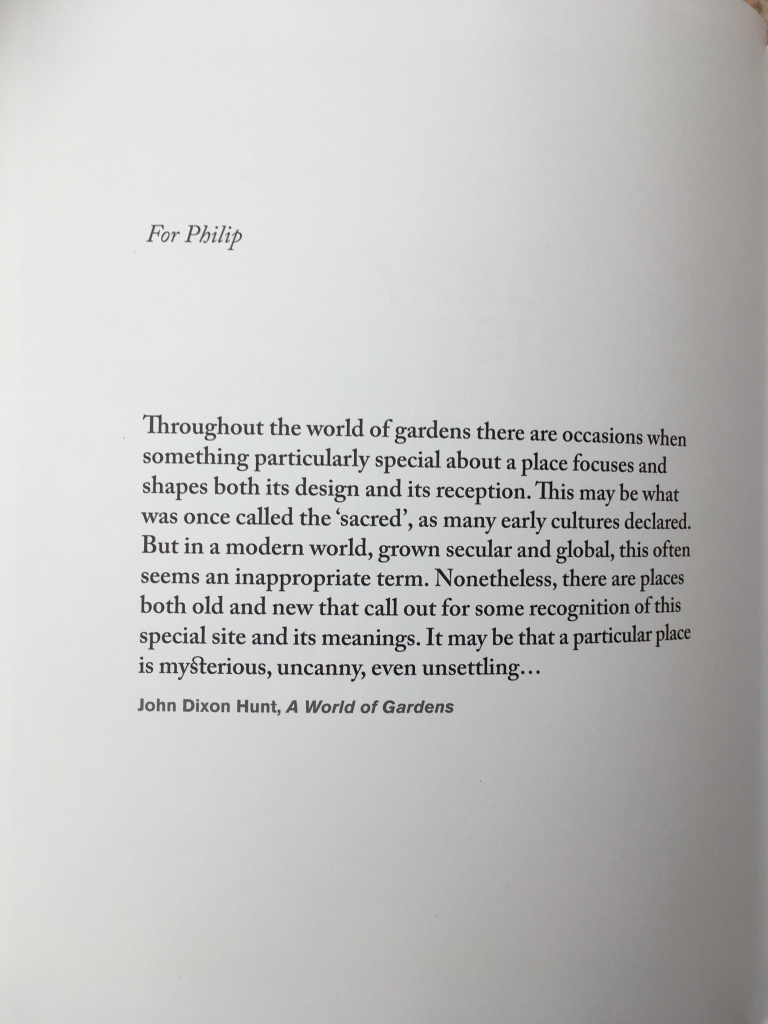

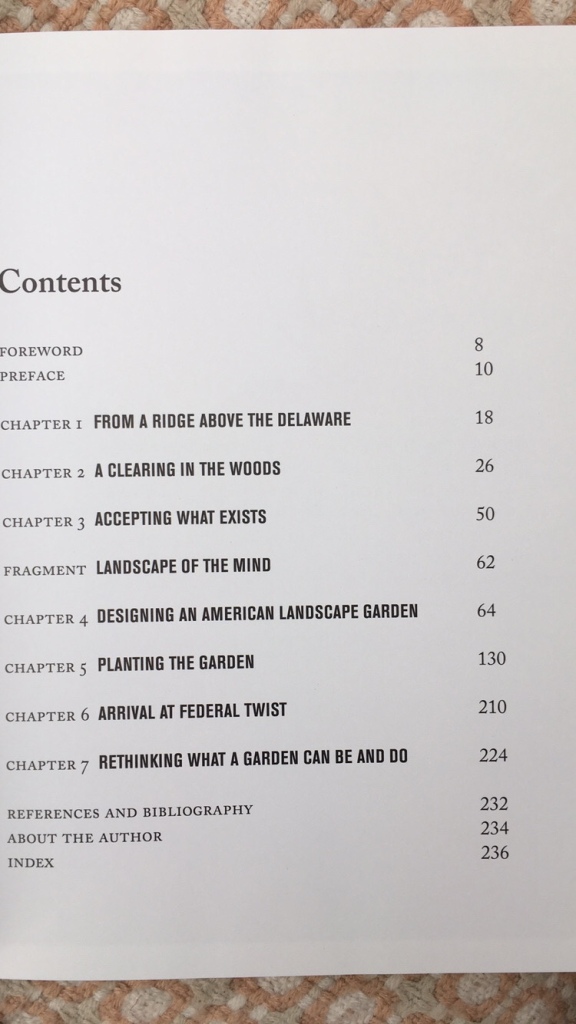

“I am Federal Twist,’’ says James. He realised this when he looked at photos of the garden from above. He put the images side by side with those taken from ground level. “When I put the two images side by side, my reaction was immediate- and astonishing. I felt icy fear. The drone image showed a flat piece of earth totally devoid of feeling, offering no comfort, no warmth, no humanity, no place for me. I felt as if I were seeing with the eyes of an alien being. In contrast, the ground-level photography held me firmly within the garden; it gave me a place to be, a protected place under trees; it made me feel a part of the landscape. I felt comforted, and a sense of belonging.”
Later, he writes “…my life and emotions are closely bound with this place I call my garden. I understand physics well enough to know that my physical body intersects with the garden, interacts with the garden, responds to the garden in some kind of mutual way. I ‘live’ the garden every day. I am Federal Twist.”
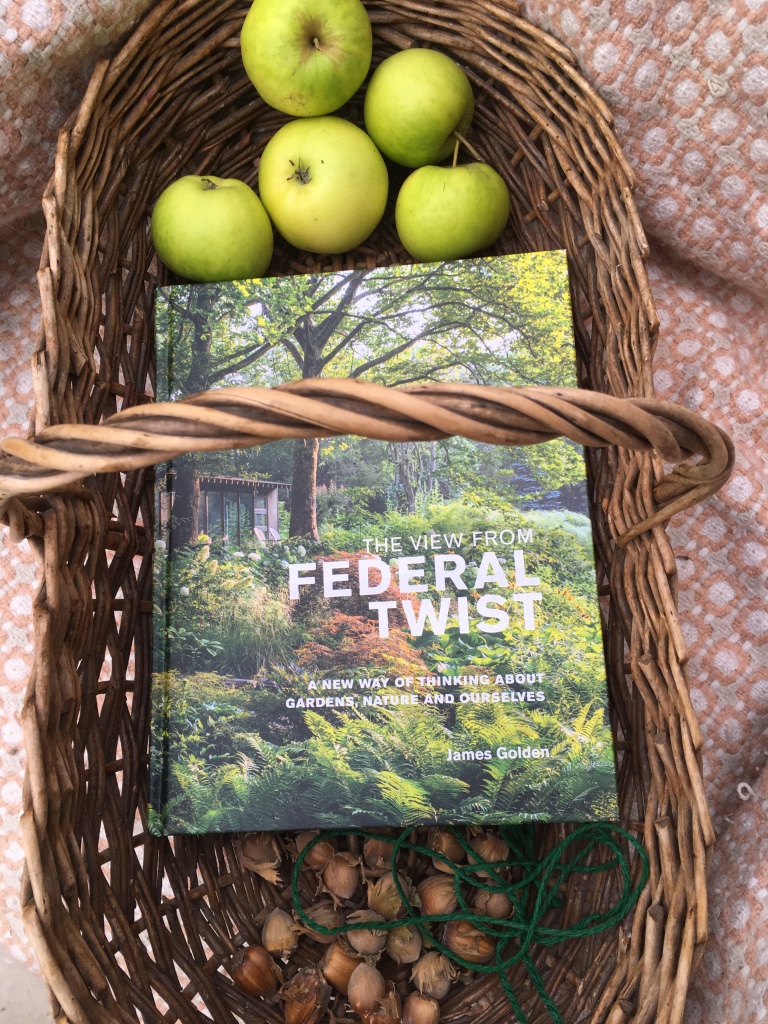
Thank you for reading my review. I believe some books come into your life at just the right moment. It’s almost as if they were ‘written’ for you. To give you joy, to give you inspiration; to give you hope. I haven’t been able to write for a while. Grief affects people in different ways. I’ve sat with grieving friends and relatives and they’ve wanted to talk non-stop for hours. Others write sonnets, pen poems, write books. Grief suddenly and unexpectedly silenced me. I didn’t want to talk. I didn’t want to write, I am someone who tries to make things better for everyone. Perhaps I just didn’t want to make anyone else feel sad. There’s no easy path back from grief, it takes time. But reading this book has helped. It’s put into words how I feel about my own garden- how my little plot has kept me afloat these past few months. I, too, feel I ‘live’ my garden. It responds to me; it’s like enfolding arms around me, lifting me up and helping to turn my face to the sun again.

BBC Gardeners’ World Live Show 2021

If you are attending Gardeners’ World Live this week, look out for the ‘Make Do and Mend’ garden by High Ground rehabilitation centre. It may only be 3m by 3m, but it’s packed with interest and colour – and everything has been created from recycled materials.

Andy Wright, therapeutic gardens manager, said 22 patients of the military rehabilitation centre were involved in creating the gold medal- winning garden. The garden has been designed and built with sustainability in mind. All of the hard landscaping and most of the plants will return to Stanford Hall, Leicestershire, where they will be used for the benefit of patients.

A former Royal Engineer created the shed out of packing crates from an MRI scanner delivered to the centre, and the path though the middle of the garden is made from end blocks of pallets.
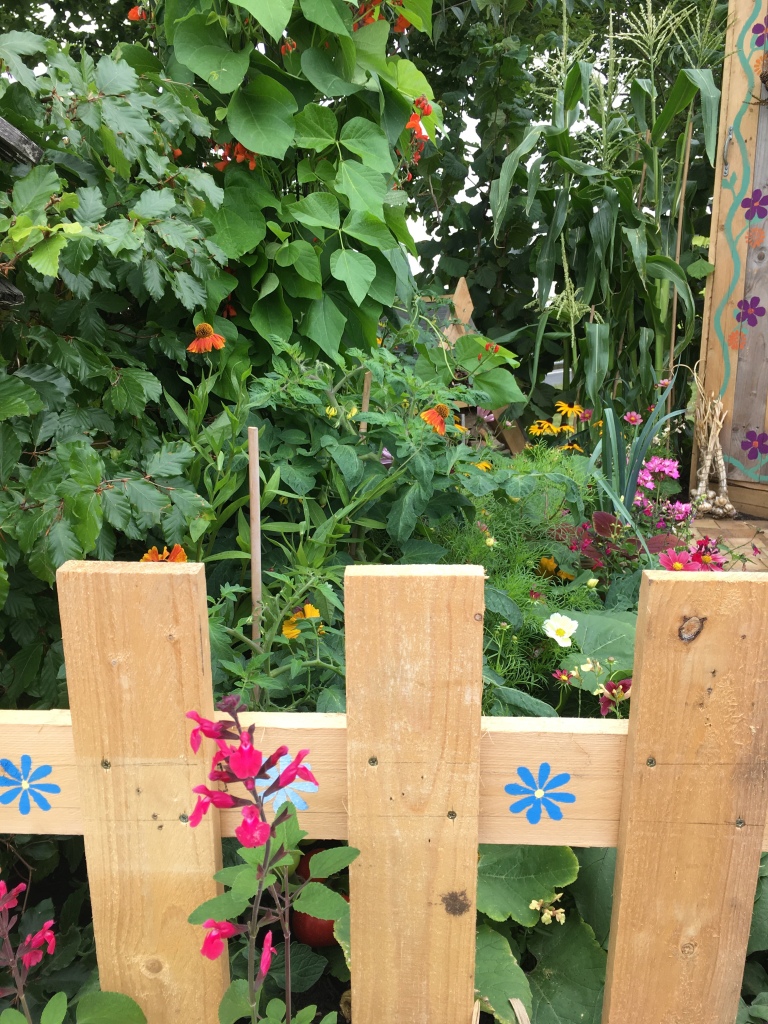
Pallets were also used to make a picket fence at the front of the garden, and there’s a wooden bug hotel and shelving unit.

A poppy sculpture made out of wire and metal stands at the front of the garden. It was made by a serviceman injured in Afghanistan.
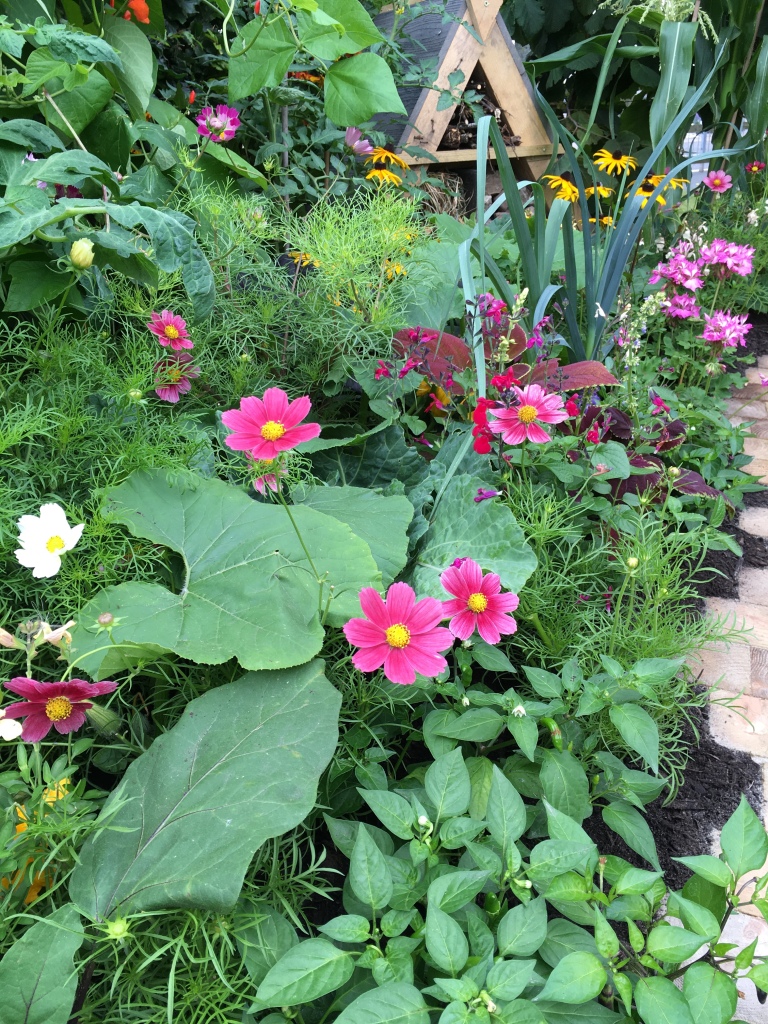
All the plants for the garden have been grown from seed and cuttings by patients.

HighGround charity was launched in 2013 by Anna Baker Cresswell and uses horticulture as a therapy and to improve the wellbeing and employment prospects of former members of HM Forces.
This garden was one of my favourites at the NEC Birmingham show. It was the one I most wanted to tiptoe into, and I could see myself sitting in front of the beautiful little shed. Even though it was only tiny, there were hidden features such as the bug hotel that drew you into the space. And the next time I get hold of a pallet, I’m going to take it apart and create a block path like this one. It’s simply stunning!
Are you going to BBC Gardeners’ World Live Show this year? If so, let me know which gardens are your favourites too. And good luck to Cathy, who won my prize draw a few weeks ago and has won two tickets for the show. After all the cancellations last year, it’s a relief to see shows like this going ahead again this summer.
*Cathy is at https://ramblinginthegarden.wordpress.com/category/gardens/in-a-vase-on-monday/
Flowers for the care home, at last….
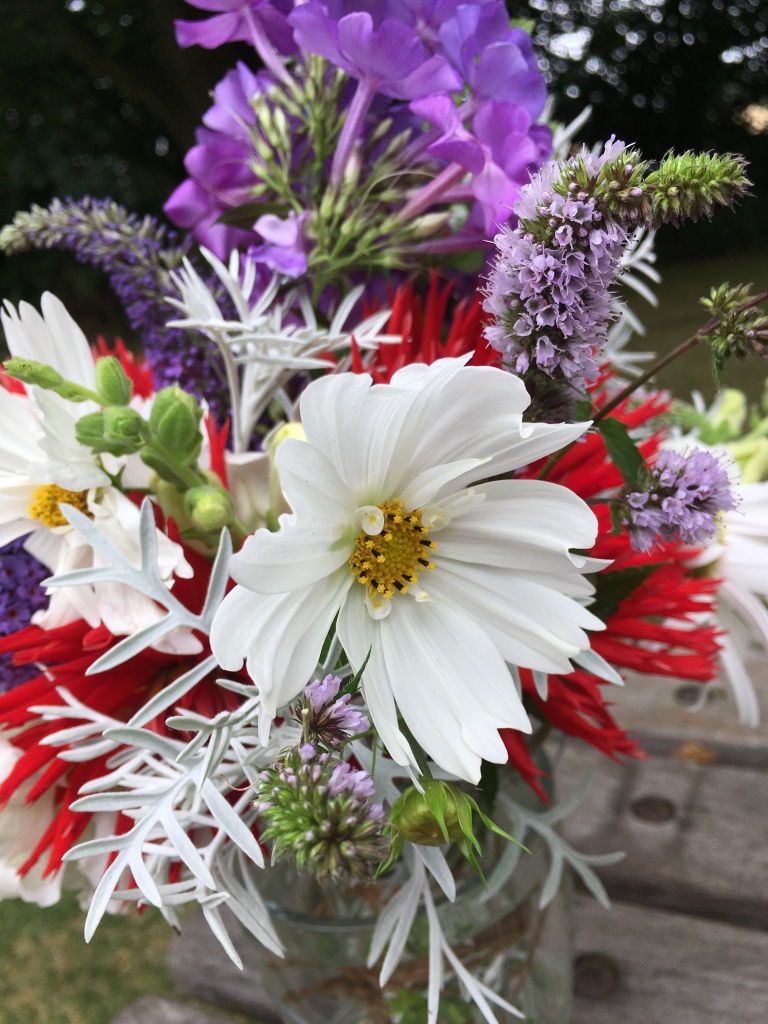
It’s almost two years since we’ve been allowed to take flowers into care homes. Any flowers, shop-bought or home-grown, were deemed a covid risk and banned. But this weekend the rules changed, and suddenly flowers are allowed again. I am beyond excited and relieved as flowers from my garden have a special meaning for my mother-in-law Joan.

I don’t think I’ve ever been so happy as I was this weekend wandering around my plot choosing flowers for Joan. It’s been such a sad time not being able to visit, or send flowers. I started growing cut flowers when Joan began showing signs of vascular dementia. Flowers have always been our special connection. We loved arranging them together. I realised she would one day forget who I was, but hoped the flowers would always remind her of me. And for many years it worked. Even when she forgot my name I was ‘someone who brought flowers.’ While she was still in her own home, I took armfuls of flowers- one of everything in flower- and foliage as well, to give a flavour of what was growing in my garden. I didn’t make them into arrangements, they were just loosely tied with string. Then Joan would spend the day creating her own posies, selecting vases and deciding where to place them- one in the front window to cheer up passers-by, one on the hall table to welcome carers who came twice a day, a few vases for the fireplace. We sat and surveyed her work, ate home-made cake, sipped tea and marvelled at the beauty of flowers, noting all the different colours and shapes. I included lavender, mint and rosemary for scent and the memories they evoked. Joan remembered a lavender bed at her childhood home and the Sunday meals with mint sauce and rosemary. It’s strange how childhood memories are the last to fade. We talked for hours about the flowers, fruit and vegetables her father grew. They had bee hives at the bottom of the garden, and the taste of honey took her right back to those happy times. There have been many heartbreaking moments, but one I particularly remember is Joan thinking her father was just upstairs. I had the choice of going along with it, or telling Joan her father had died many years ago. Neither was an easy choice, and whatever I said, five minutes later, we’d have to go through the same conversation. Flowers were a welcome distraction and something we could both agree on. Eventually, Joan lost the ability to arrange her own flowers. I did them for her and raged at the disease for stealing something that Joan so much enjoyed. Dementia, bit by bit, destroys all happiness as the processes for even the smallest task are completely forgotten. And people too, are forgotten, even those who’ve been very close and much loved. It’s so sad to watch someone desperately fighting to hold on to names and relationships. Joan would say, “I know you are someone dear to me, but tell me who you are and who am I to you.” When Joan moved to the care home, I continued the tradition with the flowers. But the pandemic meant the home was locked down for almost all of last year. Leicester remained in lockdown when other cities were released from restrictions. There were 16 deaths at Joan’s care home. Just a few weeks ago we were all set to visit when the home was locked down again due to another covid outbreak. This weekend the all clear was given and we were allowed in, and here’s some of the flowers I took with me.

I’m so pleased to be able to join in with Cathy and ‘In a Vase on Monday’ meme again as you’ve all followed my journey from the beginning. It’s been a comfort to write about my ups and downs here on the blog. There’s been laughter at times- there have been quite a few predicaments as you can imagine- and many challenges. I can’t pretend there haven’t been many tears too, and rage and sadness. But now there’s a kind of acceptance and peace. Joan doesn’t have the faintest idea who I am, but she does think I’m a ‘very nice lady’ come to visit her, and I can live with that. And the flowers still give us something cheerful to talk about.

Thank you for reading my blog. I hope my story helps if you are going through a similar situation. At any rate, keep trying, because any small kindness will always be appreciated. Even if it’s just a few flowers.

I chose bright red dahlias as Joan’s husband used to grow these for flower shows and at one time almost all the back garden was given over to straight rows of dahlias and chrysanthemums.

I took jam jars filled with sweet peas. Joan recognised these immediately as they had once been grown by her father, and she remembers picking them and arranging them in vases for chapel. It’s so sad that dementia is almost like a time travelling disease. It transports Joan back to when she was a young girl, but completely erases the past 80 years and with it her husband, three children, grandchildren and two new great grandchildren. She’s left walking amongst the ghosts of long dead relatives- her mother and father, cousins and school friends. It’s a tragedy for her, and all of us trying, and loosing a battle to keep her in the present.

Rudbeckias, calendula and green seed heads from Ammi majus

Joan loves sunflowers, but they aren’t quite ready in my garden yet. These rudbeckias grown from a mixed packet of seed look just as bright and cheerful.

These calendulas are seedlings of C. Snow Princess, a lovely pale butter -yellow flower. They bloom from May to October if deadheaded regularly. Very good for attracting bees and butterflies.

Flowering marjoram, rosemary and mint add a lovely fragrance. As soon as you lightly touch the posies, the herbs release their scent, and unlock all the memories associated with them.


A photo of Joan on her wedding day carrying a bouquet of carnations and asparagus fern. The photo is in a metal Players cigarette box frame my father-in-law made to protect the picture while he carried it around during National Service in Korea in the 1950s. He didn’t smoke, I hasten to add, but he was good at recycling and ‘making-do’ all through his life.
There’s nothing nicer than being able to give someone a gift of flowers you’ve grown yourself. Are any of you growing flowers for cutting this year? I feel as if I haven’t any other weapons in my battle to defeat dementia. Flowers are holding us together, that little bit longer. Let’s hope they continue to work a kind of magic. I’m hopeful they will. I’ll keep you updated.
Notes and links:
For more information and help with dementia: https://www.dementiauk.org/
Calendula: Mr Fothergill’s https://www.mr-fothergills.co.uk/Flower-Seed/Calendula-Seed/Calendula-Snow-Princess-Seeds.html#.YUMiaxB4WfA
Cosmos: https://www.mr-fothergills.co.uk/Flower-Seed/Cosmos-Seed/Cosmos-Psyche-White-Seeds.html#.YUMi9hB4WfA
Rudbeckias: https://www.mr-fothergills.co.uk/Flower-Seed/Rudbeckia-Seed/Rudbeckia-Rustic-Dwarfs-Mixed.html#.YUMlPhB4WfA
Rudbeckias: https://www.mr-fothergills.co.uk/Flower-Seed/Rudbeckia-Seed/Rudbeckia-Gloriosa-Daisies.html#.YUMlmRB4WfA
Sweet peas: https://www.mr-fothergills.co.uk/Flower-Seed/Tall_3/Sweet-Pea-Horizon-Mixed-Seeds.html#.YUMmLRB4WfA
Heritage sweet peas: https://www.visiteaston.co.uk/shop/easton-walled-gardens-sweet-pea-mix/
Ammi: https://www.mr-fothergills.co.uk/Flower-Seed/A-Z-Flower-Seeds/Ammi-majus_2.html#.YUMmeRB4WfA
Herbs from https://www.pepperpotherbplants.co.uk/
Dahlias from https://www.gee-tee.co.uk/product-category/summer-bulbs/dahlias
Peat free compost I use is from https://www.dalefootcomposts.co.uk/
Plant mulch and feed I use from https://www.plantgrow.co.uk/
You can also find me @kgimson on twitter and karengimson1 on instagram.
Silver Medal for John and Anna in Tokyo Olympics 2021
Well, it’s been a really exciting week at Bramble Garden! My nephew John Gimson and team mate Anna Burnet won silver in the Nacra 17 race in Japan. To say we are all overjoyed is an understatement. To be selected to represent Britain was exciting enough, but the cherry on the cake was winning that silver medal. Here’s some photos of them. Their happiness shines through and you can’t help smiling back at them. Determination and hard work certainly pays off.







John wrote the above message on his social media accounts.

We send huge congratulations to the pair. I’m a very proud aunt indeed. We can’t wait to see John and Anna and hope there’s a family celebration soon!
I wrote about John and Anna sailing in the Olympics here: https://bramblegarden.com/2021/07/30/my-nephew-is-competing-in-the-olympics/
Thank you for all your lovely comments on here, and for sharing in our happiness. It’s wonderful to have some good news and happiness to spread about the world, isn’t it.
Photos credit: @sailingenergy and British Sailing and RYA.
Butterfly House winner….…
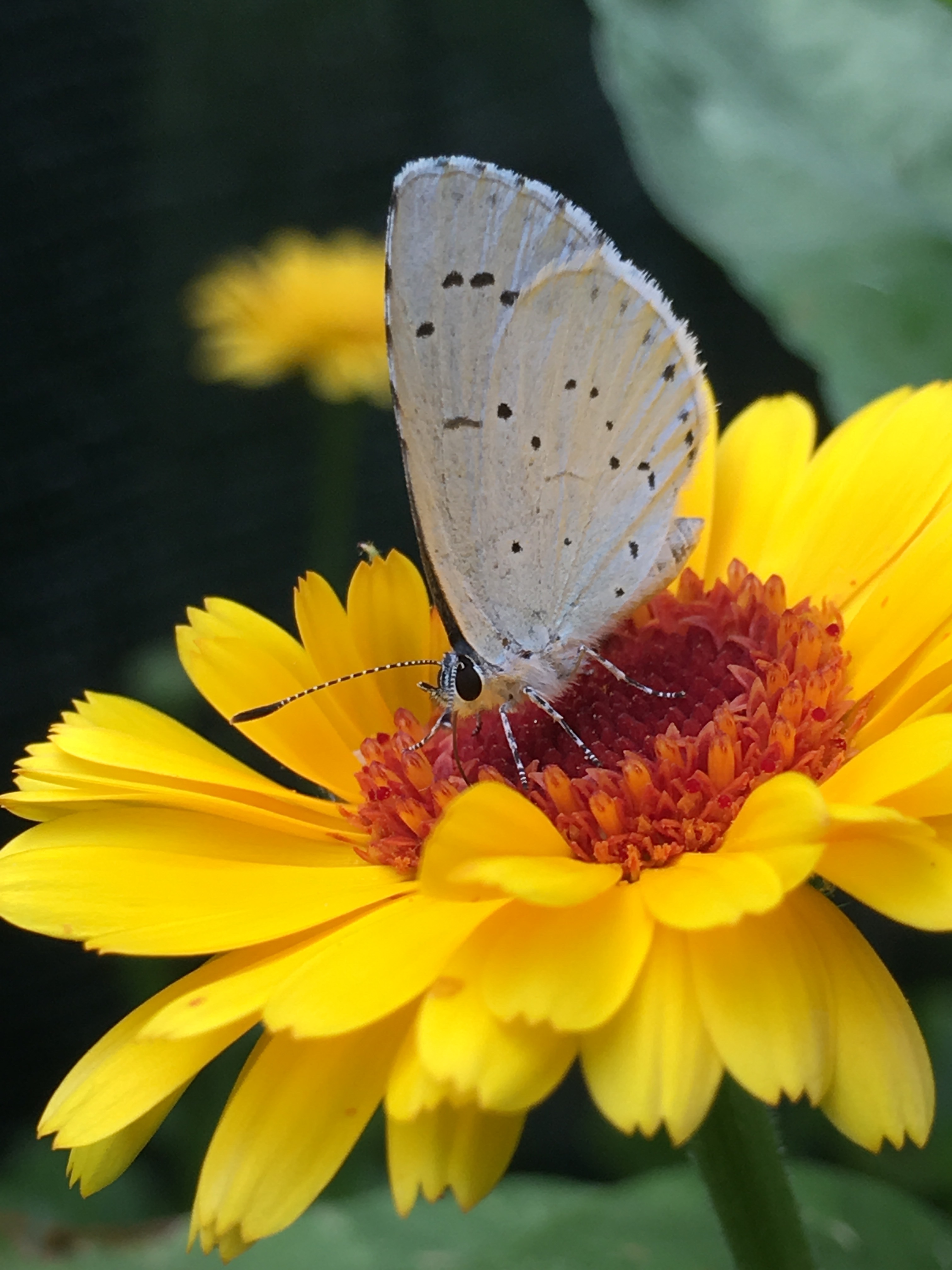
Kate Elliott has won the butterfly house in the Vivara prize draw. Thank you to everyone who read the blog and left a comment.
Here’s the link to the blog post: https://bramblegarden.com/2021/07/31/vivara-butterfly-house-review-and-giveaway-bigbutterflycount-butterflyconservation/

You’ve got until 8th August to submit your Big Butterfly Count survey results. So far I’ve had mostly cabbage white butterflies, a few Meadow Browns, two Commas, two Tortoiseshell, two Peacock butterflies, two Holly Blue, one Painted Lady, and a stunning Ghost Moth! You can also submit reports for moths you encounter during your 15 minute survey. Let me know how you get on with yours. My figures were disappointing compared with last year and the year before. However, even poor numbers are worth recording as Butterfly Conservation, who are organising the event, says the citizen science survey is ‘like taking the pulse of nature.’ It’s an indication of how insects are coping with our changing climate.

Vivara wildlife suppliers
Butterfly Conservation: https://butterfly-conservation.org/
My nephew is competing in the Olympics…
Something cheerful to report. My nephew, John Gimson is sailing for Britain in the Olympics in Japan.

Here he is, with team mate Anna Burnet, flying the flag in the Olympic mixed multihull Nacra 17 class.

We’ve been cheering from home and sending lots of love and encouragement. There have been a few tense moments, but so far John and Anna have won two races and come second in the third.

We’ve been wowed by these photos posted by the British Sailing Team on social media. It’s so wonderful to see John out there in Enoshima doing what he loves best. Particularly as the Olympics were cancelled last year. It’s been hard for all sports people to keep training to such a high level for another year.

This is a photo of John and Anna when they became World Champions in February last year in Geelong, Victoria. No doubt their home sailing club at Rudyard Lake in Cheshire, where John learned to sail, will be delighted to see how well they are doing.

We are incredibly proud of John and Anna. It’s been humbling to watch their determination to reach the top. And it’s fabulous to be watching the Olympics, knowing my nephew is competing. I’m a very proud aunt indeed.
You can join in and watch live coverage on Eurosport player or Discovery+. The BBC is providing daily reports at 4.30pm and hopefully the medal races next week will be live on the BBC.
Also follow on Instagram @britishsailing. And for John it’s @teamgbnacra. Search for the hashtag #britishsailingteam. I’ll send updates as soon as we know more.
There’s more information on the British Sailing Team website at https://britishsailingteam.rya.org.uk/
Isn’t it exciting to be watching all our fabulous sportspeople excelling in their chosen fields. Are you enjoying watching the Olympics this year? Get in touch and let me know.
Thanks, as ever for reading my blog, and for all the kind messages on here and via email letting me know how much you enjoy reading my posts. I’m so pleased to hear that my gardening stories have cheered you up these last few years when things have not been easy for any of us. Admittedly, today this isn’t a gardening post, but I thought I would share it as it’s something happy to celebrate. Take care and have a good weekend.
I am @kgimson on twitter and karengimson1 on instagram.
Gardeners’ World Live tickets winner…

Thank you everyone who joined in with the prize draw for tickets for this year’s Gardeners’ World Live Show. Names were put into a computer random generator and the winner is Cathy from Rambling in the Garden. Congratulations Cathy and enjoy your day out! My next prize draw is for a summer reading bumper box of gardening books. There’s been some stunning books published this summer and the publishers often send me an extra copy to give away. More details to follow. Thank you again for reading my blog. Have a great week! Karen G.
Gardeners World Live – two tickets to give away

Gardeners’ World Live is a favourite show. I get the chance to see stunning show gardens, buy plants and meet friends for a catch up. Luckily, it’s a relatively short car journey to the NEC in Birmingham – there’s no travelling into London and battling for space on a seat on the underground. It’s a fairly straightforward journey and easy parking. It’s always a lovely relaxing experience, with plenty of space to move about.
The organisers have kindly offered two free tickets in a prize draw for readers of this blog. The tickets are for Sunday 29 August only, with an entry slot from 12pm onwards. To enter, just leave a comment below and your entry will be put into a computer random name generator to select the winner. Please note, if you wish to park, there is a charge. The prize only relates to the show entry ticket. Details below for parking. There is no cash alternative, and the organiser’s decision is final.
Here’s some photos I took when I last attended the GWL show in 2019. Enjoy the virtual tour!

The Watchmaker’s Garden won best in show in 2019. My sister in law Rozanne and her husband Paul grew some of the plants for the award-winning garden, including the watercress shown in the stone tank by the front door.
I wrote about the show garden here : https://bramblegarden.com/2019/06/14/bbc-gardeners-world-live/
Here’s some more photos from the show:


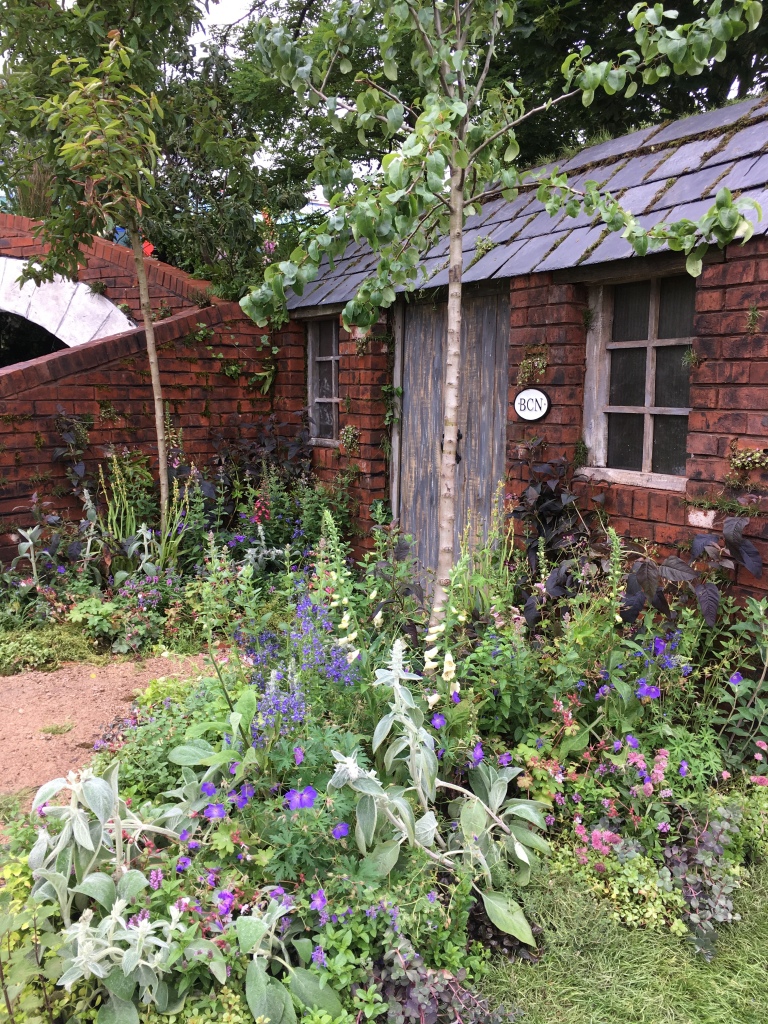
A canal-side cottage garden.



Prize winners will be announced on the blog on Monday evening 5th July. Please be aware of scams. No one will contact you about this, other than a message on my blog. It’s sad we have to worry about these things, but we just have to be careful.
Regarding parking, the organisers provided the following information:


Prize winners will need to redeem their e ticket by 19 August to attend on the 29th August.
Thank you for reading my blog. Enjoy the weekend.
Plants on Trial – from Love Orchids
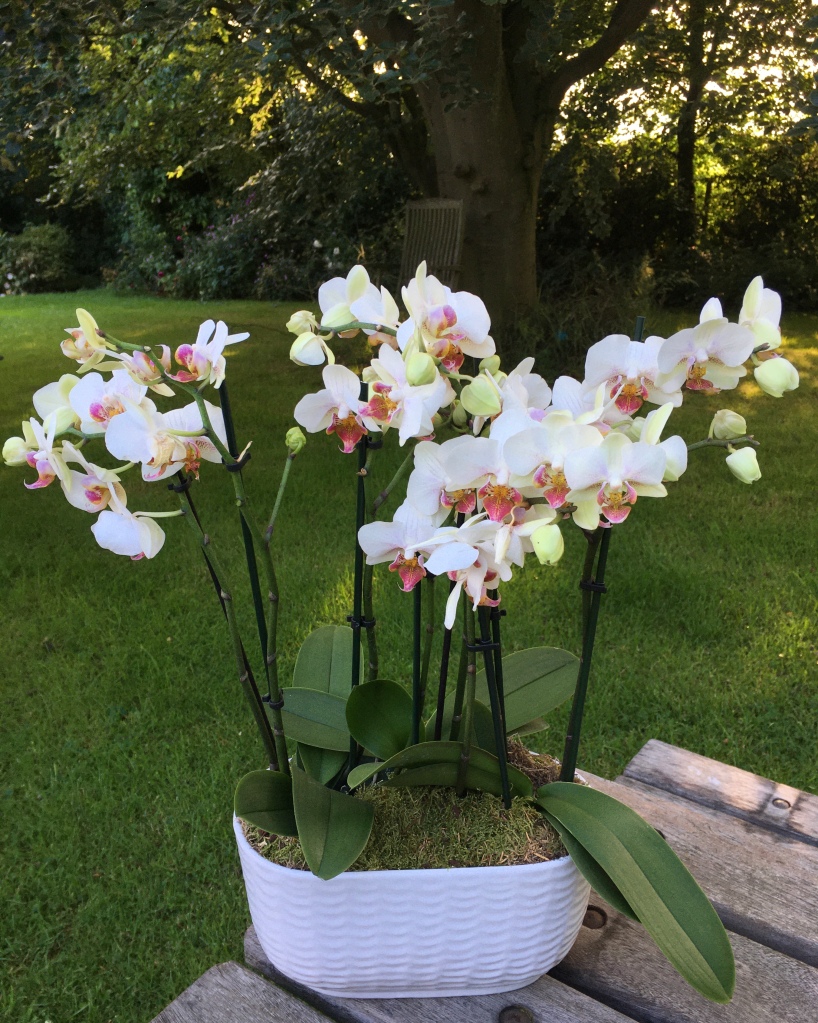
I always seem to have a bowl of orchids somewhere in the house, usually on the hall cupboard or kitchen table. They are easy to grow and often flower for several months with minimal care and attention. Love Orchids have sent a sample box to try out. I haven’t paid for this orchid, but in common with other bloggers, I’ve accepted their gift in return for an honest opinion. Maybe you would like to treat yourself, or want to send a gift to someone for a birthday or other celebration. In which case, you might find the review helpful in deciding whether to buy and send orchids mail order.

I’ve chosen a white and pink orchid in an oval white ceramic container. Plants arrived in good condition, well packaged and there’s plenty of flowers and buds for more blooms to follow. My orchid was already planted in its container and flower stems were well staked. The pot was topped with moss which is a pretty finishing touch.
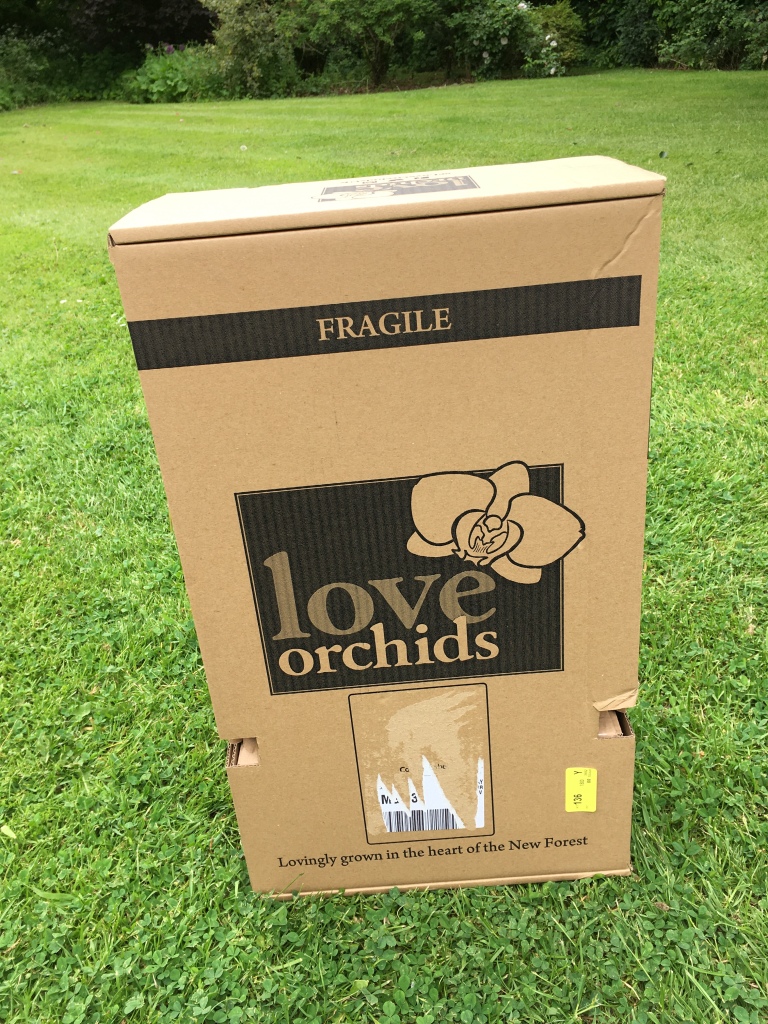
The ordering process online was simple to follow and straightforward. Plants arrived promptly in a sturdy cardboard box. The parcel delivery company handled the box carefully and it had obviously travelled the right way up- which always helps! It wasn’t just dropped from a height on to the doorstep, but carefully set down, which I much appreciated.

The box is designed to open out, so no pulling plants out the top and potentially damaging them, which I’ve done in the past in poorly-designed boxes.

Plant pots are securely held in another box taped to the base. There was also a spare pack of orchid compost as the company supplies extras for your own potting- up purposes.

Orchids are wrapped carefully in cellophane. I must admit, a compostable wrapper would be preferable, and I would be willing to pay more for a more eco-friendly material. However I just decided to use it to cover my cuttings and seed trays to maintain humidity, so mine will be re-used and won’t be put in the bin.

As you can see, the flowers spread out as soon as they were unwrapped.

There are three plants in my container, with eight flower stems. I’ve brought the pot outside simply to take advantage of the light in order to take photographs. It was too dark in the house. However, my orchids will live indoors, out of direct sunshine.
Regular readers of my blog will know that I like to highlight and support family businesses. The Stevenson family have been growing plants at their New Forest nursery for more than 60 years. When the pandemic struck, the family launched an on-line company, Love Orchids, to market and sell plants via mail order.
The family say they started out ‘with little more than a few glasshouses and a can-do attitude.’ They have grown and developed into a multi-generation business and say they are the largest growers of phalaenopsis orchids in the UK.
For sustainability, they use a biomass boiler, turning waste wood products into heat for the greenhouses.
Here’s some care tips provided by the nursery :
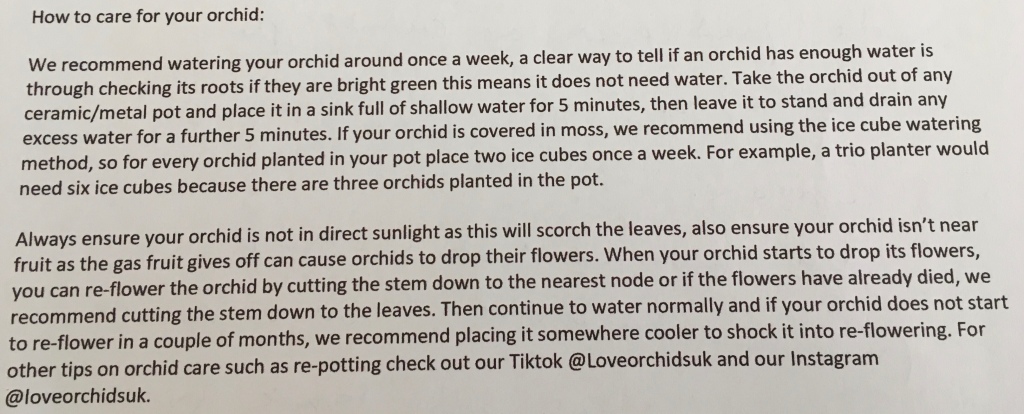
I signed up for a newsletter and received a discount code for future purchases. In fact, I sent an orchid to a friend for her birthday, and one to a relative who recently suffered a bereavement. Both sent photos of their orchids and were delighted with them. Orchids last much longer than a bunch of flowers and the plants from Love Orchids are top quality and expertly grown. The range of good quality containers also means there’s plenty of options for everyone.
For more information, here are the links for Love Orchid:
https://www.Facebook.com/LoveOrchidsUK
https://instagram.com/loveorchidsuk
And on the website https://www.loveorchids.co.uk/
Have you tried mail order plants before? Get in touch and let me know of any recommendations. We are all finding new ways to obtain our plants and gardening materials. It’s good to share news and views when we find an excellent supplier.
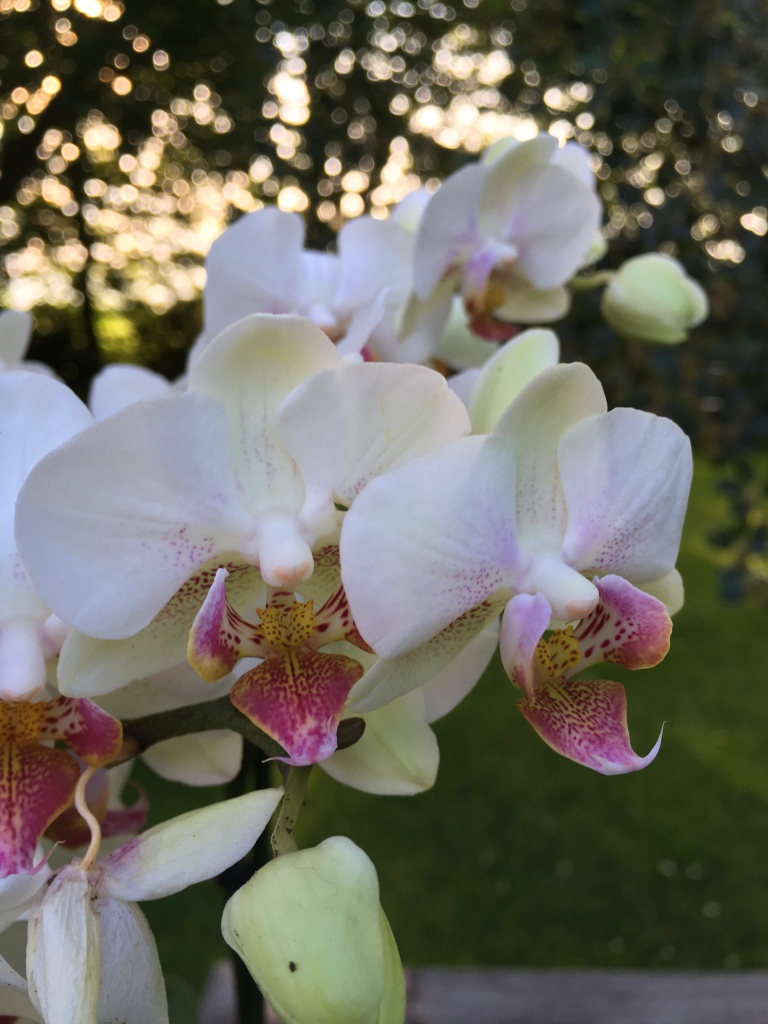
I also mentioned Love Orchids in my Christmas, birthday, anytime present list here : https://bramblegarden.com/tag/loveorchids/
Prize draw winner- The Flower Yard by Arthur Parkinson.

Thank you to everyone who read my review and left a comment. The prize draw randomly selected a winner. Sarah from the “Garden Deli” has won the book. Thanks again for joining in. Keep an eye out for more books to follow.
My review was here: https://bramblegarden.com/2021/06/11/the-flower-yard-book-review-and-giveaway/




Products On Trial – Weed Control Paper Mulch
I’m trying out a sample roll of paper mulch in an attempt to cut down on weeding in the flower and vegetable garden. I haven’t paid for this product, but in common with other bloggers, the agreement is to unconditionally try it out and give an honest opinion.

Monty kitten was keen to help. To be honest, he gave more help than was strictly necessary, getting in and under the paper roll. He’s such good company in the garden, always by my side, climbing in and out of my wheelbarrow and tool bag. But paper’s a new attraction for him!

Instructions say place a heavy stone on each corner as you start to unroll the paper, and toss soil along both edges to prevent wind from blowing it away. Monty jumped all over it, which kept it in place nicely until I’d sorted out stones and compost.

I used a Hori-Hori to cut the paper to length, then set out the plants. I’m trying the mulch for dahlias and cosmos in the cut flower beds , and for courgettes, squash, sweetcorn, and strawberries in the veg beds. It would be good for garlic and chard too.

These are the cuttings I’ve been taking since February from dahlias overwintered in the potting shed. They are exact clones of the parent plants, so I now have about 100 new plants for free. All my favourite varieties.
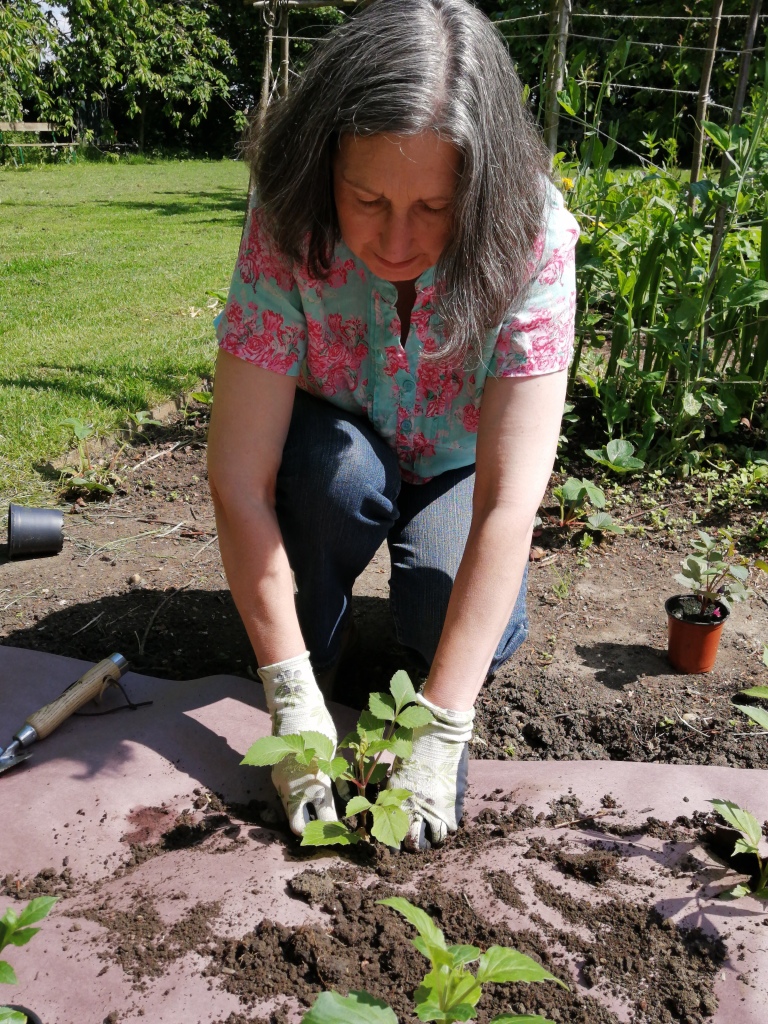
I used my Hori-Hori knife to cut a cross in the paper and then dug out planting holes for the dahlias. A new sharp-pointed trowel made the task quick and easy.
The paper is thick enough to block out light, and therefore suppress weeds, but there are microscopic holes to let air and water permeate. Plants are so far growing well. I’m having to do much less watering than usual.
This product is supplied by Mulch Organic, a family business which offers environmentally-friendly alternatives to black plastic for mulching. They say the products are natural, made from renewable sources and eliminate the need for chemical herbicides. The paper mulch is 100 percent organic and biodegradable. It should last a whole growing season, and at the end of the year, can simply be tilled into the soil to decompose naturally.
There’s also a crepe version, with expansion ribs to allow for stretch for use over mounded beds. These also work well with drip irrigation systems, and can be used in poly tunnels.
As well as the paper rolls, there’s a mulch film made from cornstarch.

Here’s one last photo of Monty. We were out in the garden until 10pm as the temperatures were too hot in the day. I’m hoping the mulch will save time – giving me more time to spend sitting in the garden reading, with Monty on my knee. That’s the plan anyway. I’ll let you know if it works out!

Here’s some of the dahlias I’m growing again this year. This one is Nuit d’Ete.
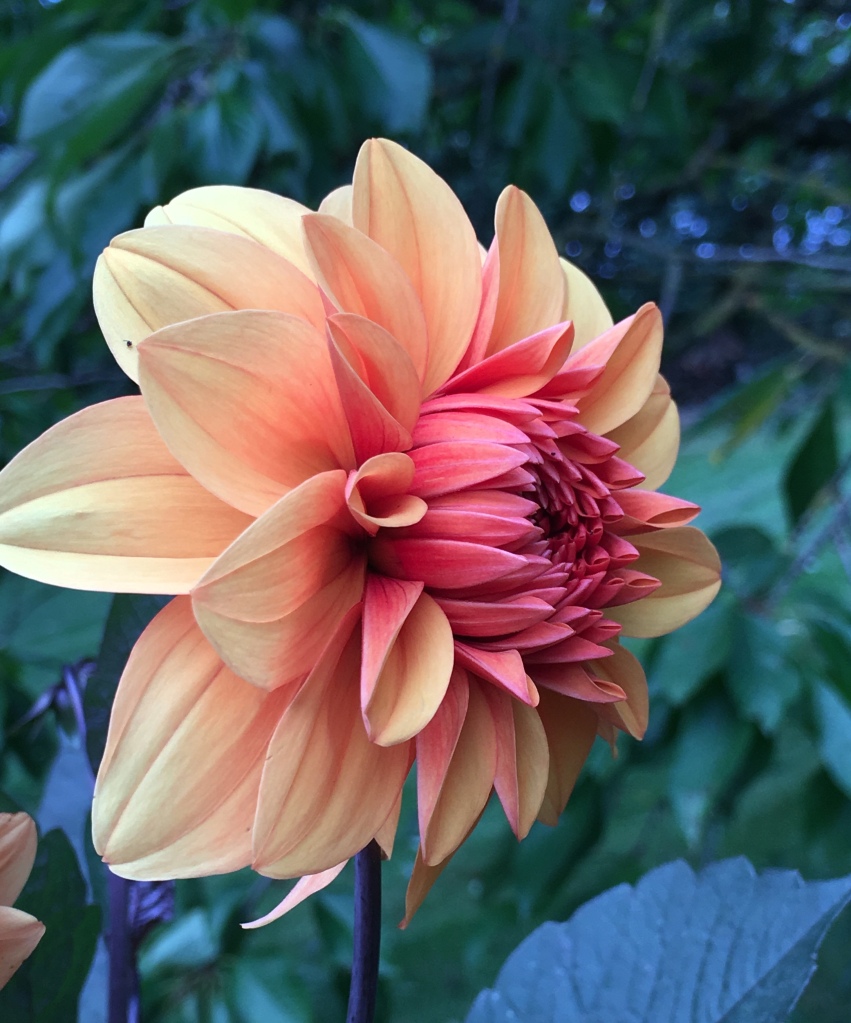
Dahlia David Howard. A lovely deep orange flower. Cut flowers last 10 days in a vase.

Eveline is a lovely white decorative dahlia with a delicate blush pink centre and tips to the petals.
Thank you for reading the blog. Have you tried any products to combat weeds? Let me know how you are getting on with your gardening projects.
Here’s the links for more information: https://mulchorganic.co.uk/
I wrote about the Hori-Hori here https://bramblegarden.com/2020/07/10/niwaki-tools-review-and-some-garden-snips-to-give-away-gardening/
The trowel I’m using is this one: https://marshallsgarden.com/products/kent-and-stowe-capability-trowel-10907234?variant=32599100424243¤cy=GBP&ds_rl=1278790&ds_rl=1284267&ds_rl=1278790&ds_rl=1284267&gclid=Cj0KCQjw8IaGBhCHARIsAGIRRYoqnS-u91aeS1AJK273Nb2YXeLUfNBNiKVEBso0HNaTi-PeyK5Fiq4aAp6zEALw_wcB&gclsrc=aw.ds
Lilies: New Book Giveaway Winner

Many thanks to everyone who read my review of Naomi Slade’s new book, Lilies – beautiful varieties for home and garden. I wrote the review here: https://bramblegarden.com/2021/05/25/lilies-book-review-and-giveaway/
The winner is: Darran Jaques. Names were put into a random generator and computer selected.
The next book up for review and giveaway is the stunning and unusual The Flower Yard by Arthur Parkinson. Pages are full of exotic tulips and jewel-coloured dahlias and, it has to be said, lovely little bantam hens! Coming soon…
Meanwhile, here’s some more photos of lilies from Naomi’s book, as quite honestly one can’t have enough pictures of lilies to drool over. They are absolutely glorious. Enjoy your week everyone, and thanks for reading my blog and getting in touch. It’s always appreciated.





African Queen






Lilies is published by Pavilion RRP £25. Photographs by Georgianna Lane.
Get Up and Grow: book giveaway winner…

Announcing the winner of my prize draw for Get up and Grow by Lucy Hutchings. The winner is Kate Elliott. Thanks so much to everyone for reading my review and leaving a comment.
The next book up for review and giveaway will be ‘Lilies’ by Naomi Slade.
My review for get up and Grow is here: https://bramblegarden.com/2021/05/16/get-up-and-grow-book-review-and-giveaway/
Thank you to the publishers, Hardie Grant Books, for supplying a free copy for the prize draw. The book is hardback, 159 pages. Lucy creates 19 projects and shows how anyone can grow pretty much anything in their back garden, courtyard, balcony or kitchen- or even right by their work desk. There are unusual and inspirational growing ideas for herbs, fruit and vegetables, and all look as beautiful as any ornamental garden. Living walls, hydroponics and daylight spectrum grow lights are all explained with step-by-step instructions.





Windowsill growing space for herbs, fruit and vegetables.

Thank you again for reading my blog. It’s much appreciated.
You might also be interested in reading:
https://bramblegarden.com/2019/07/05/gardening-on-the-menu-book-review/
https://bramblegarden.com/2018/11/18/the-creative-kitchen-book-review/
https://bramblegarden.com/2019/09/27/an-orchard-odyssey-book-review-and-prize-draw/
Prize draw winner: ‘herb/a cook’s companion’ by Mark Diacono

Thank you everyone for reading my review of Mark Diacono’s latest book and for taking part in the prize draw.
The winner is Suzanne! Names were placed in a hat and the winning name was selected randomly.
There are more book give-aways to follow and some gardening tools and equipment too. Thanks again for reading and leaving comments.
My book review was posted here: https://bramblegarden.com/2021/04/30/herb-a-cooks-companion-book-review/



Lemon Crunch Triangles Recipe

Temperatures are reaching 16C here today, just a week after snow and lows of -5. I’m working in the garden in shirt sleeves. Heavy coats and warm jumpers are left indoors. My lemon trees in the greenhouse have started to grow and I’m feeding and watering them now. They have been relatively dry over the winter. To promote more flower and fruit, I’m harvesting all the lemons and making cakes and biscuits. Spare fruit can easily be frozen whole and microwaved when juice and zest is needed.

Here’s a tasty recipe for a February pick-me-up. You can eat these lemon crunch triangles on their own with a cup of tea, or add vanilla icecream. They can also be frozen. I’m making some for now, and a batch for when we can open up the garden for visits from friends and family. I can hardly wait to see everyone! This has been a long winter and one we will never forget. I’m making videos of the garden to send to my mum, and to relatives and staff in the care home, to give them a flavour of spring. They can’t get out to see any flowers are the moment, so the videos of our snowdrops, hellebores and crocus are an escape to the outdoors for them. You can see the videos over on instagram where I am karengimson1.
Let me know what spring flowers are growing in your gardens. Are you cooking anything new this week? Freezing temperatures are due to return by the weekend, so I won’t be putting anything delicate outdoors just yet. But it’s lovely to see all these jewel-like spring flowers, and fresh lemons from greenhouse are very welcome indeed.
Here’s a link to my recipe for lemon crunch triangles:
https://bramblegarden.com/2019/02/08/lemon-crunch-triangles-family-favourite-recipes/



Herbs, cooking and reading blogs. Keeping cheerful through lockdown.

One of the ways I’m keeping upbeat at the moment is reading blogs. Barbara Segall writes about the Japanese rice recipe Seven Herbs of Spring in her ‘Garden Post’ blog. I was immediately inspired to go out into the garden and find seven herbs to make my own revitalising rice dish.

Barbara explains that the severn herb dish is a kind of porridge eaten during the first weeks of January as a way of detoxing and giving the digestive system a boost. Simple food after all the excesses of Christmas. I didn’t quite have the herbs Barbara mentions, but rather than just giving up, I searched out and used what I could find. I was delighted to discover small amounts of mint, fennel, rosemary, thyme, marjoram, Welsh onion, and chervil. Most were in self-watering containers placed in the greenhouse for winter protection. Rosemary grows by the back door, and perennial Welsh onions are in the polytunnel. They are a good source of fresh onion-flavouring when chives have died back for the season.

Just searching about the plot and discovering small amounts of herbs was a joy. The scents released as I snipped the herbs into a colander made me think of summer when I planted these containers. I perhaps use fresh herbs more in summer than I do in winter. It requires more of an effort to go out in the cold, ice crunching underfoot and wrapped up against the chill wind. Much easier to reach for the dried herbs (dare I admit to using such a thing). But the taste was worth it. Every mouthful was a burst of flavour – transporting me back to sunshine and summer heat.
I boiled some organic long grain brown rice to go with my herbs. A nice easy meal, in contrast to all the complicated, lengthy cooking of the festive season. The rice was ready in 25 minutes. I roughly chopped the herbs and sprinkled them over the steaming rice. I found some tiny emerging spring broccoli and nasturtium leaves to add to the dish and yellow broccoli flowers, which are edible and should not be wasted.

Delicious! Using what I have about the place and keeping things simple. It made me feel as if I was looking after myself. Which is no bad thing just at the moment when we are all rather stressed and in lockdown.
Do read Barbara’s blog and learn more about Japanese cooking traditions. Barbara’s writing is like silk. It’s a joy to read. And you never know, it might inspire you to grow more herbs and cook something delicious and good for you. Let me know if you do!
Thank you for reading. Take care.
Barbara’s blog is here : https://thegardenpost.com/a-new-dawn-and-it-is-2021/
January in the Garden

Here I am, pottering about in my garden again. I must say, the weeks fly by and it’s soon time to write another column for Garden News Magazine.
I hope you enjoy today’s article. I’ve had some lovely letters of support from readers saying my ‘potterings’ have kept them upbeat and busy during the pandemic. I’m pleased to see many readers have been inspired to have a go at different gardening techniques, or decided to grow something new. And many say the recipes are tasty, and always turn out well. What a relief!
Here’s some additional photos the editor didn’t use for the column. It’s fascinating to see which ones they choose. I submit about 10 for them to select from. It takes about a day to decide what to write about, take the photos and then actually sit down and compose the piece. It’s 350 words – which is actually quite a challenge. I try to say a lot in not many words. I edit it three times before I send it, taking out any spare words each time. What a luxury it is to write the blog. No one is checking the word count on here.

My hazel plant supports in the snow. New rods have replaced any that snapped, and have been woven along the centre to add strength. We seem to be getting stormier summers, so plant supports have to be extra sturdy.

Some sweet peas I grew last summer. I’ve sown some in autumn, but the second sowing now will provide plants that flower right through to November. Successional sowing extends the season.
Seeds come from https://www.mr-fothergills.co.uk/Flower-Seed/Sweet-Pea-Seed/#.X_dxARDfWfA.
And https://www.visiteaston.co.uk/shop/gardening/seeds/easton-walled-gardens-mix.

Here’s a photo of ‘Sunshine’ climbing French beans. Highly recommended, easy to grow and prolific. We have a freezer full, and they only take a few minutes to cook from frozen. All the flavour and goodness is captured for tasty winter meals. I’ll be starting my bean seed in May. Don’t start them off too early as they cannot be planted out until the first week of June. If sown too early, they become leggy and weak. They are very fast growing.
Bean seeds come from https://www.mr-fothergills.co.uk/Pea-and-Bean-Seeds/Climbing-Bean-Seeds/Climbing-French-Bean-Sunshine.html#.X_dw0hDfWfA

Here’s a larger photo of the willow heart flower arrangement in the potting shed window. It’s made from Paperwhite narcissi, alstroemeria from the poly tunnel and dried gypsophila and honesty seeds from summer. The foliage is eucalyptus saved from Christmas floral arrangements. Flowers are held in a jam jar covered in moss which has garden string twined around it, kokadama -style. We are all trying to do without florists’ foam, and using jam jars, and tiny glass test tubes works really well.
See more ideas, join zoom -and in person lessons- with Georgie Newbery at Common Farm Flowers : https://www.commonfarmflowers.com/collections/workshops
Paperwhites came from Gee-Tee Bulbs https://www.gee-tee.co.uk/
Gypsophila and honesty seeds from https://higgledygarden.com/

I mention new birds boxes. I wrote about CJ Wildlife supplies here: https://bramblegarden.com/2019/01/30/nest-boxes-and-bird-feeders-for-the-garden/
The RSPB nesting material is from: https://shopping.rspb.org.uk/nest-box-accessories/nesting-wool-refill.html

And finally, the rhubarb upside down cake recipe can be found here: https://bramblegarden.com/2020/04/18/rhubarb-cakes-family-favourite-recipes/
Thank you for reading and getting in touch. It’s much appreciated. And a very Happy New Year to you all.
I’m @kgimson on twitter
Karengimson1 on instagram
Do say hello on social media.
Christmas Cake Recipe

For my daughters, who are making their own Christmas cakes this year.
I stand on this lane, and what I want more than anything else in the world is to see your cars driving this way. But it is not to be. We must all keep to our own homes, until we’ve had a vaccine, which hopefully will be soon. I’m so proud of you both. Not a single complaint has been heard this year. Things have not been easy for you, but you’ve taken everything in your stride and met every challenge with courage and determination. I’m so heartened to see you have both turned into such capable young women. Keep strong, as I know you will. And look forward to the day when we can all be together again, around our table, with grandparents, cousins, aunts, uncles, celebrating all the occasions we’ve missed this past year. Love Mum xx
Grandma’s Christmas Cake Recipe
9″ loose bottom cake tin, 4″ deep
Baking paper to line. Foil for the top
Oven preheated at 140C
INGREDIENTS
1lb currants
6oz sultanas
6oz raisins
2oz glacé cherries, cut in half
2oz mixed peel
Soak all the above ingredient in 3tbsp brandy overnight.
8oz plain flour
1 tsp baking powder
1/2tsp salt
1/4 tsp nutmeg
1/2 tsp mixed spice
2oz chopped or flaked almonds
2oz ground almonds
8oz soft brown sugar
1 tbsp black treacle ( run spoon under boiling water so treacle won’t stick)
8 oz unsalted butter or vegetable margarine (vegan)
4 eggs, or egg substitute (vegan) lightly beaten.
1 lemon rind
1 orange rind
METHOD
Sift flour, and all dry ingredients together.
Soften butter in microwave and mix with black treacle.
Mix all ingredients together using a wooden spoon.
Make a wish!
Spoon into the prepared cake tin and place a double layer of foil on top.
Cook for 3.5 – 4 hours and check with a skewer to see if it’s cooked. The skewer will come out clean if cooked. Cook for another 30 minutes if not ready. Leave in the tin to cool for several hours or overnight. Re-wrap with fresh foil and place in a tin in a cool dry place. You can ‘feed’ the cake with table spoons of Sherry or more brandy. Make holes with a skewer and drip the alcohol over.
This cake is best made in November, but will be fine make now and iced nearer to Christmas. Add ready rolled marzipan, icing and decorate.



Have a wonderful first Christmas in your own homes. Hopefully, you’ll remember all the happy times growing up here with simple pleasures. They are always the best.

Garden News Magazine recipes for December

If you’ve received your copy of Garden News Magazine this week, here’s the recipes I mention in my column. Above is the summerhouse where I write my pieces, and where I sit and make my cherry marzipan chocolates.

The recipe link for Cherry Marzipan Chocolates is here :
https://bramblegarden.com/2018/12/04/family-favourite-recipes-chocolate-marzipan-cherries/
They are very quick to make and children love creating them. They make tasty home-made presents for Christmas.

I also write about Chocolate and Orange Panettone. Start saving your tins now to make these delicious treats. They are very easy to make and look beautiful. Get the children to make potato stamp labels. Be as creative as you like. Everyone can get involved.
Here’s the link: https://bramblegarden.com/2019/12/02/christmas-recipes-chocolate-panettone/
I write about turning my satsumas from the greenhouse into a liqueur. The recipe comes from Bob Flowerdew, replying to me on twitter when I asked what I could do with this year’s prolific harvest. It’s been a good summer for growing citrus. Bob always has great suggestions for what to do with produce from the garden, and is generous with his advice.
Here’s Bob’s recipe for Satsuma Liqueur :


And finally, I was talking on the radio last week, when I mentioned I was making Sloe Gin. Here’s the recipe, with thanks to garden writer Barbara Segall, who inspires me on a daily basis to try something new.
Sloe Gin
450g sloe berries -or whatever you can find. If you only have 300g, use those.
350g caster sugar
710ml gin
Kilner jar or lidded jar
Place the ripe sloe berries in the freezer to break the skins. Add all ingredients to a large kilner jar. Swirl the contents every day for a week, every week for a month, and every month for a year. Strain the gin. Use the berries for cakes or trifle.
It’s wonderful to have a bottle on the north-facing kitchen windowsill. Mine has changed colour now and it’s a joy to see. Almost like a stained glass window.

Barbara Segall has written many garden books, all highly recommended. One of my favourites is The Christmas Tree. A beautiful stocking-filler. Find out more here : https://thegardenpost.com/category/christmas-tree-book/
https://www.ebay.co.uk/itm/The-Christmas-Tree-book-by-Barbara-Segall-NEW-/174501320740?_trksid=p2349624.m46890.l49292
For more suggestions on books, I also recommend The Creative Kitchen by Stephanie Hafferty. I reviewed the book here:
https://bramblegarden.com/2018/11/18/the-creative-kitchen-book-review/

Here’s a link for Georgie Newbery at Common Farm Flowers for growing cut flowers, floristry and Christmas wreath workshops and courses, in person, and on-line. Vouchers make a great present for any gardener. https://www.commonfarmflowers.com/collections/workshops
Thanks for reading! Have a great week.
In a Vase on Monday- virtual flowers for Joan

Chrysanthemums are in full flower in the poly tunnel. They’ll provide cut flowers from now until January. I grow hardy varieties in 10″ pots. They stand out on the gravel paths, next to the greenhouse all summer. Chrysanths can cope with the cold, but wet weather spoils the flowers, so I lift the pots into the unheated poly tunnel the first week of November.

I don’t know the name of this bright yellow chrysanthemum. It came from my father-in-law Keith. He had been growing it since the 1950s, having been given a cutting from Aunty Dorris. When Keith was no longer able to garden, I took over the tradition on growing the yellow flowers for his wife, Joan. Until this year, I’ve managed to supply Joan with a bunch each week through November and December. They are her favourites. This year, covid has interrupted our plans – and I’ve had to e mail photos of the flowers instead.

I’m growing these pretty little white chrysanthemums too. These are called Stallion. They are multi -headed and last at least a fortnight, sometimes three weeks, in a vase. Flowers have a bright yellow button centre, and take on pink tinges as they age. Very useful as a filler in a bouquet.

We’ve had a message from the care home saying one family member can visit before Christmas. They will have to take a rapid covid test, sit in their car for half an hour to wait for the results, and then spend 30 minutes visiting our relatives in their own rooms. We can’t visit any communal spaces. And we still can’t take flowers, for some reason. But we can take tins of biscuits and jars of jam- anything that can be disinfected before being giving to the residents. I’m writing about it here because the blog has become a record of our times, living through this covid pandemic, and the effect it’s had on people living in care homes.
Hopefully, soon we will be able to have the vaccine and this nightmare will come to an end. I’m hopeful it won’t be long now.

Thank you for reading. I’m celebrating reaching the milestone 100,000 readers on the blog. When I started writing, I had no idea so many would read my potting shed musings. Thanks for being one of them. Have a calm and happy week.
In a Vase on Monday : Cathy https://ramblinginthegarden.wordpress.com/category/gardens/in-a-vase-on-monday/
Turning Garden Twigs into Christmas Decorations
As a few of you know, I talk on the radio once a fortnight, chatting about what I’m doing in my vegetable and cut flower plot. This week, I tried valiantly to make a few twigs from my garden sound exciting. It really tested my powers of description! Anyway, if you were listening in, here are the photos to go with my interview with Ben Jackson. I was waving my arms around, explaining how you can gather foliage and off-cuts from the garden, make them into a twiggy bouquets, add lights, and plunge them in a pot. I do hope it enthused a few people to have a go and make their own Christmas decorations.

Willow stems, dried oak twigs, pine foliage and Hydrangea Annabelle flower heads with orange lanterns, Physalis alkekengi.

I decorated the hydrangea heads with some florists’ silver spray from Oasis. You only need a tiny amount.

Some old man’s beard, wild clematis vitalba adds a fluffy texture and movement to the arrangement.
Mouldable copper wire fairy lights from supermarkets only costs a few pounds. Mine came from Wilkos and use rechargeable batteries.

Tiny flowers from the hydrangea heads flutter down around me. I scoop them up and use them as table decorations. They are like nature’s confetti.

Wire lights can be threaded through dogwood stems and any greenery from the garden. This ‘bouquet’ of twigs is pushed into a plant pot of garden soil and stood by the front door. It looks like a container full of expensive plants, but in truth, it has cost me nothing. Stems will stay fresh until after Christmas due to cold and wet weather. They can be composted in the new year. So there’s no waste to go into bins.
I’ve used pine, spare Christmas tree stems (the tree was too tall), ivy, dogwood and willow to give height, and skimmia at the front. You could pop some hellebores and white heather either side to cover the base of the pot. If you have plastic pots, why not cover them with hessian to give them a natural look.

Here’s some more ideas using willow. Wind the willow or dogwood into a rough circle and keep adding more stems. Eventually you can pull it into shape and secure it with thin lengths of willow. Kept dry in the shed, wreaths will last for years. Each Christmas, I add new foliage, pine and rosemary for scent, rosy-hued hydrangea heads and clematis seeds. These are simply fed in amongst the willow stems and secured with string or florists’ reel wire.

You can add rosehips and crab apples to the willow frame. Birds tend to enjoy them, so I have to replenish the decorations every day. We were very excited to see some very small birds, possibly long-tailed tits enjoying the clematis seeds. It becomes almost a cross between a Christmas decoration and a bird feeder.

Add whatever you can find in the garden and hedgerow. In this silver birch wreath, I’ve added ivy, with green and black ivy berries, and dried cow parsley seed heads. The wind sometimes blows the clematis across the back fields, but there’s plenty more in the potting shed, ready for the festive season.

These willow stems have been folded over to form a heart. Hold ten stems in one hand. Bend half of them over and tie in the middle. Bend the other half over to form the other side of the heart, and tie in. Tie further up the stems to keep the heart shape secure. Disguise the ties -or the mechanics, as we call them- with a mini bouquet of foliage. Here I’ve used Holly, ivy, Garrya elliptica, hydrangea flowers and a few crab apples.

Willow wreaths don’t always need any decorations at all. A pretty ribbon is all that’s used on this wreath for a simple shepherd’s hut.

I decorate five bar gates around the plot. A single heart is often all that’s needed. It will cheer any Christmas Day revellers, walking along the lane. From this gate we can hear the church bells ringing. The sound carries far across the fields. It’s a wonderful spot to stand and listen for a few moments, mug of tea in hand.
Let me know what decorations you are putting up in your house and garden this year. Will it be old favourites, like mine, or something new? Get in touch and let me know, and thanks, as ever, for reading. Today, I’m celebrating my milestone 100,000 blog visitors. When I started writing, I thought just a handful of people might see my posts. I’m absolutely thrilled to see 100,000 have read about my little plot. Have a great weekend everyone.
Links:
Listen to Radio Leicester, Christmas decorations, at 3.16.57 on the timeline on BBC Sounds https://www.bbc.co.uk/sounds/play/p08ymt0t
I learned how to make my wreaths at Common Farm Flowers with Georgie Newbery. Georgie is running online courses and sells wreath -making kits.
https://www.commonfarmflowers.com/collections/workshops
I wrote about Georgie’s courses here: https://bramblegarden.com/2020/07/01/online-hand-tie-posy-course-with-georgie-newbery/
There’s also lots of Christmas recipes on the blog. Just scroll down to view them.
Candied Orange Peel for Christmas

This year, more than ever before, we are rolling out the Christmas family favourite recipes. It seems more important than ever to have reminders of all the happy celebrations from the past.
Candied orange peel is easy to make and fills the kitchen with a wonderful, comforting scent. If you need to get into the Christmas spirit, take some oranges and sugar and turn them into these irresistible treats. You can add dark chocolate and give them as little gifts to friends and family. You can’t buy anything as good. Honestly.

INGREDIENTS
4 large oranges (unwaxed if available)
300g caster sugar
Water
Granulated sugar to coat
Dark chocolate (optional)
METHOD
Scrub the oranges in hot water, especially if they have been waxed.
Peel wedges of orange skin from the top to the bottom of the fruit.
They should be 5mm thick and include the pith as well as the skin.
Lay the wedges down and flatten. Cut them into matchsticks 7mm wide.
Place peel in a saucepan and cover with water. Bring to boil and simmer for 5 minutes.
Drain and throw away the water.
Cover peel with fresh water and simmer for 30 minutes.
Drain and reserve the liquid. You’ll need about 300ml. Add 300ml of sugar and heat until dissolved.
If you have more peel, the ratio is always 100ml of water to 100g of sugar.
Return the peel to the syrup (sugar/water mix) and simmer for 30 minutes.
Drain and place the orange peel on a wire rack set above some baking paper to catch drips. Put the rack and paper in an oven on the lowest setting for approx 30 minutes to dry.
You can use the reserved syrup in orange drizzle cakes, sponges and trifles.
Put some granulated sugar in a basin and add a few strips of peel at a time. Use a fork to toss them in the sugar and liberally coat. Lay on a clean wire rack to dry in a warm kitchen.
Optional: after adding the sugar, you can coat half of the sticks in dark chocolate which makes a delicious treat. Wrap in little packets of foil to give as home-made presents.
Variation: use lemon. Simmer and discard the water three times to remove bitterness.
Store candied peel in an airtight container. It will keep for 6-8 weeks.
Use for Christmas cakes, or toppings for sponge cakes, muffins and biscuits. Or just on their own as a teatime treat with hot chocolate or coffee. Utterly delicious. Enjoy 😊

Let me know what family favourite recipes you are cooking this year.
We have decided not to mix the households – even though the rules say we can. We can’t risk the health of elderly relatives. Especially when there’s a vaccine on the horizon. We must just be patient for a little longer. Everyone must decide what is best for them. Visits to the care home are still currently barred as we are still in tier 3. No flowers can be sent to my darling mother-in-law, J. But we can send jars of jam and home made treats and chocolates. So I’m concentrating on making this a Christmas we will all remember- and hopefully the last one we have to spend separated from one another.
More recipes to try:
Chocolate Panatone https://bramblegarden.com/2019/12/02/christmas-recipes-chocolate-panettone/
Chocolate marzipan cherries : https://bramblegarden.com/2018/12/04/family-favourite-recipes-chocolate-marzipan-cherries/
Apple Chutney: https://bramblegarden.com/2020/11/21/joans-christmas-apple-chutney-recipe/
In a Vase on Monday- flowers for my Mum

I’m catching up here. This is in fact last week’s IAVOM. Internet and computer problems defeated me. We are on the old copper wire telephone line, and not the new super duper cable -type. It’s too expensive for BT to extend the cable down our lane, so we are stuck with speeds that are too slow to upload photos or do internet banking. Anyway, the internet may have set me back, but I wasn’t to be defeated by the imminent national lockdown, I just managed to get this posy of flowers to my mum in time. Dahlias have been the stars of the cut flower garden this year. They have flowered non-stop since June. Pictured above is Dahlia Nuit d’Ete. It’s a semi-cactus type with long twisting, curling petals. Such a rich deep red. Flowers last ten days in a vase. The centre keeps opening out and the flowers curve back until they look a little like sea urchins.

Here are the dahlias tucked in amongst the last of the cosmos, salvia, scented white carnations, with grey senecio foliage and plum coloured Physocarpus Diabolo.

The carnation is Dianthus Bridal Star. Highly scented, but requires staking as it has a floppy- growing habit. I grow it in the greenhouse as rain spoils the flowers. Worth growing though for constant flowers from June to November.

Salvia viridis blue, (centre of photo) an annual, sown in March and planted out end of May. I grow these at the base of the sweet pea A-frame which makes good ground cover.

There are also pink and white varieties of this annual salvia. Masses of flowers from a £2 packet of seed. Well worth growing.

A surprise discovery this summer was eucomis flower spikes. These got knocked over by the cat and puppy playing football….. I’m sure the cat thinks it’s a dog, as it joins in with all the ball games, and tries to come for a walk down the lane with us. We usually end up carrying him home. Anyway, Eucomis Sparkling Burgundy, known as the pineapple lily, lasts 4 weeks in a vase. They make wonderful centre pieces. I shall grow some specially for flower arranging next year.

Another surprise came from a row of sweet williams, planted out last month. They have decided to flower in November. I’ve cut the flowers for the house, and I’m hoping they will flower again next spring. They look good, strong plants, grown from seed in June. Perhaps the unusually mild autumn has confused them.

I found one last white dahlia flower, Eveline. This decorative dahlia has beautiful pink-tipped edges to the petals.

As with everything I do now, Monty likes to join in. He’s recovering from a small operation. As you can see, he’s doing really well and gaining weight nicely, after a troublesome start in life. Just look at those whiskers. And those chubby paws. You can tell he’s much loved. Adored in fact. He’s made such a difference and is helping to keep our spirits up during the pandemic.
I hope you’ve enjoyed this whistle-stop tour of my cut flower bouquet-making, even if it is a week late!
How are you all coping with the lockdown? I’m getting the veg plot ready for next year. It will be the first time I’ve managed to get all the jobs done by Christmas. Really, I’m not going anywhere at the moment.
Thanks for reading. Keep in touch.
Links : In A Vase on Monday with Cathy and everyone all around the world. See what everyone is growing and putting into their vases this week: https://ramblinginthegarden.wordpress.com/2020/11/09/in-a-vase-on-monday-7th-anniversary-still-life-with-pine-cone-rosehip-and-moss/
Salvias, sweet william and cosmos: Mr Fothergills https://www.mr-fothergills.co.uk/Flower-Plants/Cut-Flowers/Salvia-Viridis.html#.X6lKQRDfWfA
Carnation: Six Acre Nursery https://www.sixacrenurseries.co.uk/
Pear and Almond Pastries- family favourite recipes

It’s been a bumper year for fruit. There’s crates of pears in the spare room, and little piles of rosy red apples all along the windowsills. The whole house smells like pear and apple crumble! I’ve never managed to reach the top of the fruit trees before. Our old ladders were too wobbly. But this year I’ve a fabulous new addition to the garden- a Henchman tripod ladder. It’s made everything easier – and safer. All the best, tastiest fruit- always at the top of the tree- has been harvested. This year, more than ever, it feels as if nothing should be wasted. Spare fruit has been distributed to friends and family in little paper bags. Damaged, over-ripe fruit has been enjoyed by hedgehogs and blackbirds, so wildlife has not been forgotten either.
One of our favourite autumn recipes is Pear and Almond Pastries. As usual, just a few ingredients are needed, and the little parcels of tasty pears only take minutes to make. Have a go at making them, and let me know how you get on.
INGREDIENTS
1 pack of ready rolled puff pastry
3 or 4 ripe pears
1 tbsp dark brown sugar
3 tbsp ground almonds
1 tsp ground cloves
1/2 tsp cinnamon
2tbsp flaked almonds for the top
1 egg, beaten (optional- use almond milk for vegans)
Icing sugar for dusting (optional)
Baking tray with baking paper or silicone sheet.
190C oven 15-20 minutes
METHOD
Unroll the pastry and cut into squares. Lay them on the baking tray.
Peel and halve the pears. Place slices on top of the pastry squares.
In a bowl, mix the sugar, ground almonds, ground cloves, cinnamon together. Pile spoonfuls of the mixture on top of the pears.
Take the corners of the pastry and draw them together to make a rough parcel. The pastries will stretch and turn out all shapes, and it doesn’t matter. They will still taste the same.
Brush the top with beaten egg (or almond milk) and sprinkle over the flaked almonds.
Cook in a preheated oven for 15 -20 minutes. Check them after 10 minutes to see how brown they are. The pastries will be ready when they are risen and light brown. They burn easily, so keep an eye on them. 20 minutes might be too long for fast ovens. Dust with icing sugar, if you have some.
Can be eaten cold or warm. Can be frozen for 3 months. Delicious with clotted cream, or custard. We also love them with home-made vanilla icecream.
Thanks for reading. Have a great gardening week and keep in touch.
Links: Henchman ladders https://www.henchman.co.uk/
Fruit trees: Six Acre Nursery, Costock, Leicestershire.
Silicone sheets are reusable from http://www.kitchenrangecookshop.com/

Photos above show two packets of puff pastry.


Six on Saturday – 10th October 2020 -photos from my garden

Sunflowers have been the stars of the autumn garden. This one is multi-headed Helianthus Black Magic. I sowed seeds in March in 3″ pots and planted them out the first week of June. They survived high winds and torrential rain, even hailstones mid-summer. Summer now seems to see a pattern of stormy weather with winds gusting up to 40 miles per hour. Plants have to be sturdy to survive- and well supported, with a scaffolding of 6ft hazel poles. Many times I’ve feared for my sunflowers and tall-growing cosmos and salvias. They were bowed down, but never beaten. Much like us, really. With all our covid worries.

White dahlia My Love, with a mixed selection of sunflowers, rudbeckias and calendula, grown from seed from Mr Fothergills and Burpees Europe. This summer I took part in a social media campaign with the hashtag #GrowSomeSunshine. We grew sunflowers and made a donation to the NHS, posting photos of our flowers on twitter and instagram. The campaign, run by gardening journalist, David Hurrion, raised £3,175. I’m hoping David will repeat the campaign next summer. It’s been a cheerful way to support our wonderful nurses, doctors and NHS volunteers. I’ve had sunflowers right across the front garden, lining the path to the front door. People passing by the garden gate lean in and smile. Garden gate conversations have become a ‘thing,’ with friends from surrounding villages walking along footpaths to visit us and chat. Only two people have actually been in the garden. On sunny days, I set out chairs 2 metres apart and served biscuits in individual little wrappings. They brought their own flasks of tea. Small dispensers of hand gel sat neatly amongst the potted plants on the garden coffee tables. Things like this are starting to feel more normal now. I’m writing this here as a reminder in the future, when I want to look back and see how we lived in the summer of 2020.

I love the range of colours in modern sunflowers. This one grew from a packet of seed called All Sorts Mixed. Well-named as there were eight different sunflowers in the mix.

This one is almost pink. A lovely range from a packet of Helianthus Evening Sun. plenty of pollen. A magnet for bees. As pretty as a stained glass window.

And another photo of Black Magic, which starts off a deep, dark chocolate colour, and fades to beautiful bronze.
Scrumptious. Almost good enough to eat. Which is what will happen to them over the winter. I’ve saved seed heads and dried them on the greenhouse staging. A few will be brought out each day over winter. A feast for the birds. Sunflower stems are hollow, and make homes for ladybirds and lacewings. I’ll bundle stems together and stuff them in my ‘twiggery’ which is just a pile of twigs and stems, left in a quiet corner for insects to hibernate.
What’s looking good in your garden right now? Join in with the #SixOnSaturday hashtag on twitter and instagram and look to see what other gardeners are growing in the UK and around the world. I use it to plot and plan what to grow next year. There’s plenty of good ideas from keen gardeners. A cheerful way to spend an hour or two on a rainy autumn Saturday.
Thank you for reading.

Links for more info :
Six on Saturday :https://thepropagatorblog.wordpress.com/2020/10/10/six-on-saturday-10-10-2020/
Black Magic https://www.mr-fothergills.co.uk/Flower-Seed/Sunflower-Black-Magic-F1-Seeds.html#.X4G00xB4WfA
Evening Sun: https://www.mr-fothergills.co.uk/Flower-Seed/Sunflower-Evening-Sun-Seeds.html#.X4G08xB4WfA
GrowSomeSunshine https://www.crowdfunder.co.uk/grow-some-sunshine
Burpee Europe seeds https://www.burpeeeurope.com/sunflower-pikes-peak/
Allsorts Mixed https://www.mr-fothergills.co.uk/Flower-Seed/Sunflower-Allsorts-Seeds.html#.X4G1dhB4WfA
Rudbeckia mixed https://www.mr-fothergills.co.uk/Flower-Seed/Rudbeckia-Seed/Rudbeckia-Rustic-Dwarfs-Mixed.html#.X4G1nRB4WfA
My Love Dahlia https://www.peternyssen.com/my-love.html
Book Review: American Gardens
By Monty Don
photos by Derry Moore
Published by Prestel
Hardback 223 pages
ISBN: 9783791386751
Published autumn 2020
£35

Such a lot has changed since Mum and I sat, side by side, watching Monty Don’s American Gardens television series over the winter. Little did we know corona virus was on the way, and we wouldn’t see each other for most of the spring and summer. One of our simple pleasures in life is to watch the gardening programmes mum has recorded the week before. Enjoying our home-made cake and cups of tea, we would um and ah over the gardens- much more fun than watching alone. We were unanimous in our admiration of glorious, colourful, plant-filled gardens, and sternly, dismissively critical of others. And laughter. There was much laughter. Such fun. Just watching in companionable silence too. I miss those moments. Mum has to be extremely careful. So our fledgling visits to each other’s gardens have been cautious and metres apart. Indoors, and television -watching, is rationed. I touch nothing and keep a distance. This is how it will be until we have faster, easier corona virus testing. Or a vaccine.
Just as I’m mulling over all the changes to our lives, and trying to solve a few impossible problems, Monty’s new book arrives. And I sit down and read it. From cover to cover. Monty Don asks, ‘What is an American garden.’ Well, if he can be as bold as to attempt to find the answer to that question, I’m sure I can overcome one or two tricky dilemmas of my own. I clearly remember Monty saying “The belief you can do anything, if you believe in it enough, is what defines the American Garden.” Reading his new book transports you to another place where anything is possible. And that’s certainly a message we all need right now.
Here’s some of the gardens I picked out to show you, and ones I enjoyed in his new book.

The Federal Twist garden, Stockton, New Jersey is one that stands out.
I’m still chuckling over the quote from owner James Golden, who says,”I forgot to mention that I hate gardening.”
Monty notes “It was probably a well-rehearsed line but, given the extraordinarily beautiful garden he has created and the deep pleasure that it clearly gives him, an effective show-stopper. Why? I asked. ‘I hate getting my hands dirty. I hate struggling to separate roots and then digging a hole. I have someone to do that for me. I place the plants, pull plants out. I’m constantly working out what I need and where to move things. I don’t feel it necessary to dig or plant to be fully engaged with the garden.’ I suspect that the British, and in this I include myself, fetishise the actual process of gardening too much, sometimes to the extent that the hardworking, skilful means justify the rather dull ends.”
A revealing portrait of the gardener, and of the garden visitor, Monty Don.
These are my i-phone photos of the book taken in the potting shed, and do not do justice to the clarity of the stunning photography by Derry Moore.

Federal Twist.

Federal Twist.

The swimming pool at the Bob Hope House, Palm Springs.

Inside the Amazon Spheres in Seattle.

Climbing fig (Ficus pumila) in the orangery at Dumbarton Oaks, Washington DC.

Vizcaya, Miami, Florida. The house reflected in the Tuscan-inspired pool.

Prairie Garden Trust, New Bloomfield, Missouri. A field of coneflowers.

Central Park, New York City. The two towers of the San Remo apartment building designed by Emery Roth in 1930.

Longwood Gardens, Kennett Square, Pennsylvania.



Monty sitting under a banyan tree. He looks lost in thought. The sheer scale of the trees and the landscape. It’s mesmerising.
You’ll have to read the book to see what conclusions Monty arrives at. I found it a joy to read in these troubled times. If humans can create gardens such as these, surely it gives us hope. Anything is possible. And at the end of the day, that’s what we need most of all at the moment. Hope.
Links:
Leave a comment in the box at the bottom of the page, and Prestel will select one reader to receive a free copy. Sorry, uk addresses only at the moment. I’ll run another draw when the book is published in America. It would make a wonderful Christmas present. It’s certainly a ‘wow’ production, with glossy double page spreads of photographs and thought-provoking writing.
Prestel publishing: https://prestelpublishing.randomhouse.de/book/American-Gardens/Monty-Don/Prestel-com/e570814.rhd
Federal Twist garden: https://federaltwist.com/
I’m @kgimson on twitter and on instagram https://www.instagram.com/karengimson1/?hl=en.
Thank you for reading.
Update: Flowers for Joan. September 2020

Last Monday I wrote about my mother-in-law Joan and the flowers I take to her each week from my garden. Covid meant the care home where she’s living stopped all visits for almost six months to protect residents from infection. We had just resumed visiting and were meeting in the garden in 30 minute appointment slots.
The day after writing my piece, we received an e mail cancelling all further visits due to rising covid numbers in the UK. We can stand in the car park and wave through a window. Or we can attempt video calling.

I’m writing now to say thank you to all of you who’ve got in touch with kind messages and helpful suggestions. You’ve generally bolstered me up at a difficult time. I’m writing this blog as a diary of my gardening life, and also as a record of the times we are all going through, and the situation for the elderly, especially those with dementia who cannot ‘see’ their families in person. No criticism is meant for the care home. They are doing an unimaginably difficult job keeping everyone safe, and we are enormously grateful for everything.

Here’s some photos of Joan with my bouquets of flowers from the garden. The photos were taken when she was still living in her own home.

The flowers were loosely tied so that Joan could spend a few happy hours arranging them in assorted vases and fill the windowsills with colour. She especially loved having flowers in the house as carers would always comment on how cheerful they were and how much they enjoyed visiting Joan and her husband Keith. The carers said the couple were their favourites, and I’m sure it was because Joan and Keith tried to be as little trouble as possible -and there was always chocolates, biscuits and cake for them. They tried to look after the carers, and show their appreciation. A very special couple, and I’m proud to call them my in-laws.

This is a favourite photo of Joan on her wedding day on the steps of Cosby Methodist Chapel. Joan arranged the flowers for the chapel, while keith played the organ twice on a Sunday and for weddings and funerals, for more than 60 years.

I found this old photo in a family album. Florence May, Joan’s mother, is on the left, with Florence’s sisters, Jess, Hattie and Marion. All of them were to suffer from dementia. I stare at this photo and feel so sad. These young girls had no idea what was ahead of them. None of us ever do.
Thank you for reading.
This is what I wrote last week : https://bramblegarden.com/2020/09/21/in-a-vase-on-monday-flowers-for-joan/
And here : https://bramblegarden.com/2018/09/30/sunflowers-for-joan/
Thank you to Cathy for her #IAVOM meme, which I first joined in with when Joan was diagnosed with dementia and I started growing cut flowers to take to her.
#InAVaseOnMonday : https://ramblinginthegarden.wordpress.com/category/gardens/in-a-vase-on-monday/.
A video from the care home. https://www.facebook.com/MHAaigburth/videos/1565414246976429/. Please do not view this video if you are feeling overwhelmed with sadness at this time. Wait until you are feeling stronger.
UPDATE FRIDAY 2 OCTOBER. ‘Window’ visits have now also been cancelled, due to the rising covid numbers. Thank you again for reading my blog.
In a Vase on Monday- Flowers for Joan

I started growing cut flowers, and writing about them, when my mother-in-law-Joan was diagnosed with dementia. Joan loved flower arranging- she did the Methodist chapel flowers for 65 years. It was a passion we both shared. I instinctively knew Joan would start to forget me, and by taking flowers each week, I hoped to hold on to her for as long as possible. To keep a connection going. It was all I could think of. Before lockdown, Joan started to forget my name. But she never forgot the names of the flowers, and my posies gave us something cheerful to talk about. It gave Joan confidence. She could chat about a subject she understood when everything else in her life was confusing. Lockdown was an agony. I tried to send letters. Phone calls were too distressing, Joan couldn’t understand exactly why we couldn’t visit. Hearing loss caused further upset. I sent photos and updates about the family and her grandchildren. Leicester remained in localised lockdown, and the care home where Joan lives with her husband Keith, was within the extended lockdown area. So it was more than six months before we were able to visit.
And these are the flowers I took to Joan. Daisies have always been her favourites. The yellow rudbeckias came from some roots I saved when we had to sell their house. They lived in the same house, brought up three children, and enjoyed their garden for 63 years. The whole family worked together to help them live at home for as long as possible. But dementia not only steals memories of friends and family, eventually it takes away the ability to do even simple tasks. It was heartbreaking to watch Joan try to make a cup of tea. And yet she still wanted to try, because she loved looking after us. I really looked forward to popping around for a cup of tea and a piece of cake. Her cake tin -before dementia- was always full of flapjack, coconut chocolate squares, and fruit cake. I often write the recipes here on the blog so they are not lost in time. Joan made my life happier. She always cared, backed me up and sympathised, helped where she could. I miss it. I miss having someone who would always stop what they were doing and just listen. Some things in life cannot be changed, but to have a sympathetic ear makes all the difference. To have someone always on your side. I’ve been lucky, I know. I was so determined to hold on to Joan, but covid defeated me. On our visit, I could hardly breathe, hoping Joan would recognise me. But she had no idea who I was. And I wasn’t even allowed to give her the flowers. It’s against the rules. Even a simple bunch of flowers could be deadly. The virus could be on the stems where I’ve touched them. So after showing her my flowers, the care home staff asked me to lay them on the garden path, where they stayed, looking as lost and forlorn as I felt. I don’t disagree with the rules- the staff have an unimaginable job to keep everyone safe. But I feel sad that my small bunch of flowers couldn’t go on Joan’s bedside table to bring her some joy at this difficult time. I’m updating you all, as you have followed my journey these past few years and kept me company whilst I’ve pottered about my garden and tied up my bunches of flowers for Joan. It’s been a comfort to share my thoughts on here. I’ll not give up, of course. As soon as I’m allowed, I’ll take flowers again. There will be hellebores and scented hyacinths at Christmas, catkins and forget-me-nots in spring, and roses and daisies all summer. In a care home, it’s easy to lose touch with the seasons and Joan loved visiting my garden. She enjoyed the beauty of flowers and the countryside around us. Let’s hope we can make up for lost time soon.

Rudbeckia Goldsturm (black-eyed Susan) flowers from July to October and cut flowers last ten days in a vase.

Verbascum nigrum grows to 1.5m on the vegetable and cut flowers plot. Spikes of bright yellow flowers emerge all summer. Pollinators love the flowers too.

Achillea millefolium (yarrow) grows in a small patch of wild flowers, sown from a packet of mixed seed last summer.

There’s oxeye daisies, with wild carrot flowers as a pretty filler. The carrot turns green as it goes to seed, perfectly matching the green rim around the centre of the daisy flowers.

If you look carefully, you can see the tiny hearts of Capsella bursa-pastoris or Shepherd’s purse. There’s hope, and lots of love, in this small bunch of flowers.
Thanks for reading.
In a Vase on Monday : https://ramblinginthegarden.wordpress.com/2020/09/21/in-a-vase-on-monday-also-rans/
Tomato and Thyme Tart – family favourite recipes

Suddenly, at this time of the year, the kitchen windowsill is covered with tomatoes. All sizes from giant heritage beefsteak Marmande to tiny cherry types such as Sweet Million and Red Robin. Some are bright sealing-wax red, soft and ready to eat. Some shine like emeralds, green and firm. They will ripen over the coming weeks.
Here’s a favourite recipe, perfect for utilising your tomato harvest. As usual, it’s a quick and simple idea. It takes 10 minutes to make, and 15 minutes to cook. Tomato and herb tarts travel well and are suitable for picnics too. Enjoy!
INGREDIENTS
1 pack ready rolled puff pastry
1 egg yolk -beaten
7oz /200g cheese ( can be Cheddar, gruyere-or whatever you have)
14oz /400g tomatoes, thickly sliced
Few sprigs of thyme – leaves only
1tbsp olive or rapeseed oil
Salt and black pepper
METHOD
Preheat the oven to 210C /190C fan/ gas mark 7
Cover two baking trays with either re-usable silicone sheets or baking parchment to prevent the tarts sticking.
Roll out the pastry. Use a 7” tea plate as a template. Lay the plate on the pastry and use a sharp knife to cut a circle.
You’ll get two 7” round tarts, or one 7” and four 4” tarts from a roll of pastry. The off-cuts of pastry can be used for cheese straws. Just add grated cheese and twist to incorporate.
Transfer the circles of pastry to the baking trays. Use a blunt knife to score an edge to each circle, 1.5cm or 1/2” wide.
Brush each border with the beaten egg. Use a fork to prick over the base of the tarts to stop them rising.
Pile grated cheese into the centre of the circles. Take care not to get any filling on the edges, or they won’t rise.
Arrange slices of tomato in concentric circles on top of the cheese.
Season with salt and pepper and scatter over the thyme leaves.
Drizzle over a few drops of olive or rapeseed oil
Bake in the oven for 12-15 minutes or until the pastry edges have risen and are golden brown and the filling is bubbling. Garnish with some fresh herbs.
Can be served warm or cold. Can be frozen.
For a vegan alternative, omit the egg and use melted vegetable margarine and use vegan cheese.


My Marmande tomatoes were prolific this year. I sowed seeds in February, pricked seedlings out in March and planted them in their final 12” pots in May. I grew mine in an open-ended poly tunnel, which protected them from the worst of the weather.
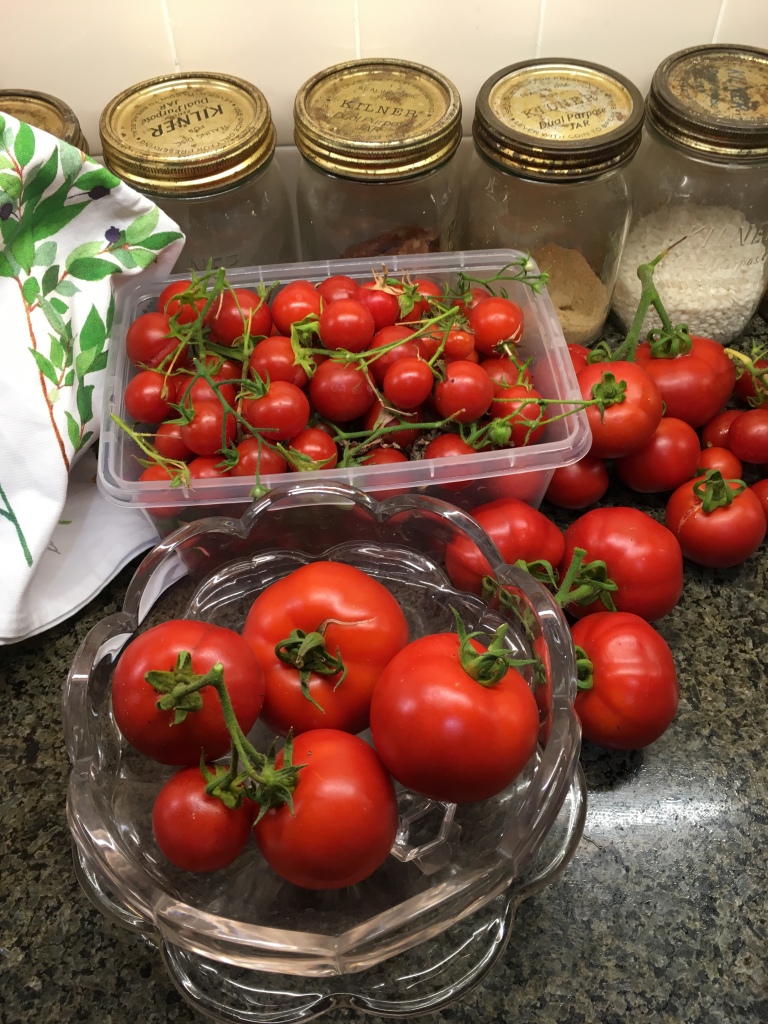
I listened to a podcast called Fresh from the Pod this week. Gardener and writer Tamsin Westhorpe was interviewing Chris Collins. Tamsin is the gardening world’s version of Michael Parkinson, in my opinion. It’s fascinating to get a real insight into the lives of our gardening personalities. Anyway, half way through the interview, Tamsin says she never turns any opportunities down. She never says no to anything. Always has a go, because you never know where it might lead. So, this gave me courage to try something new this week. As you know, I love cooking. My happiest memories are sitting around a table with my parents and grandparents and just being fed the most delicious meals. Just that feeling of being loved and cared for. It lives on in my memory like an indelible photo album. Well, it’s gradually become my turn to produce memories for other people. I’ve loved cooking for my children and the recipes here are written down for them, incase they ever need them. And today I also recorded my first “grow it, cook it, eat it” for Ben Jackson at BBC Radio Leicester. They have a ‘Food Friday’ segment which I’ve always wanted to have a go at. Remembering Tamsin’s words, I ventured forth! It was a shaky start, as we were cooking outdoors (social distancing) and the wind was blowing my bits of baking parchment about. The cat wanted to join in. He usually “helps” when we are gardening. And the neighbour’s dog started barking. Ah well, nothing is perfect in real life, is it. It was a fun thing to do and I hope you enjoy listening. It’ll make you laugh, I’m sure.
At 2.08.26 in the timeline. https://www.bbc.co.uk/sounds/play/p08nvhpx
A Walk Around My Garden, Sunday 23 August 2020
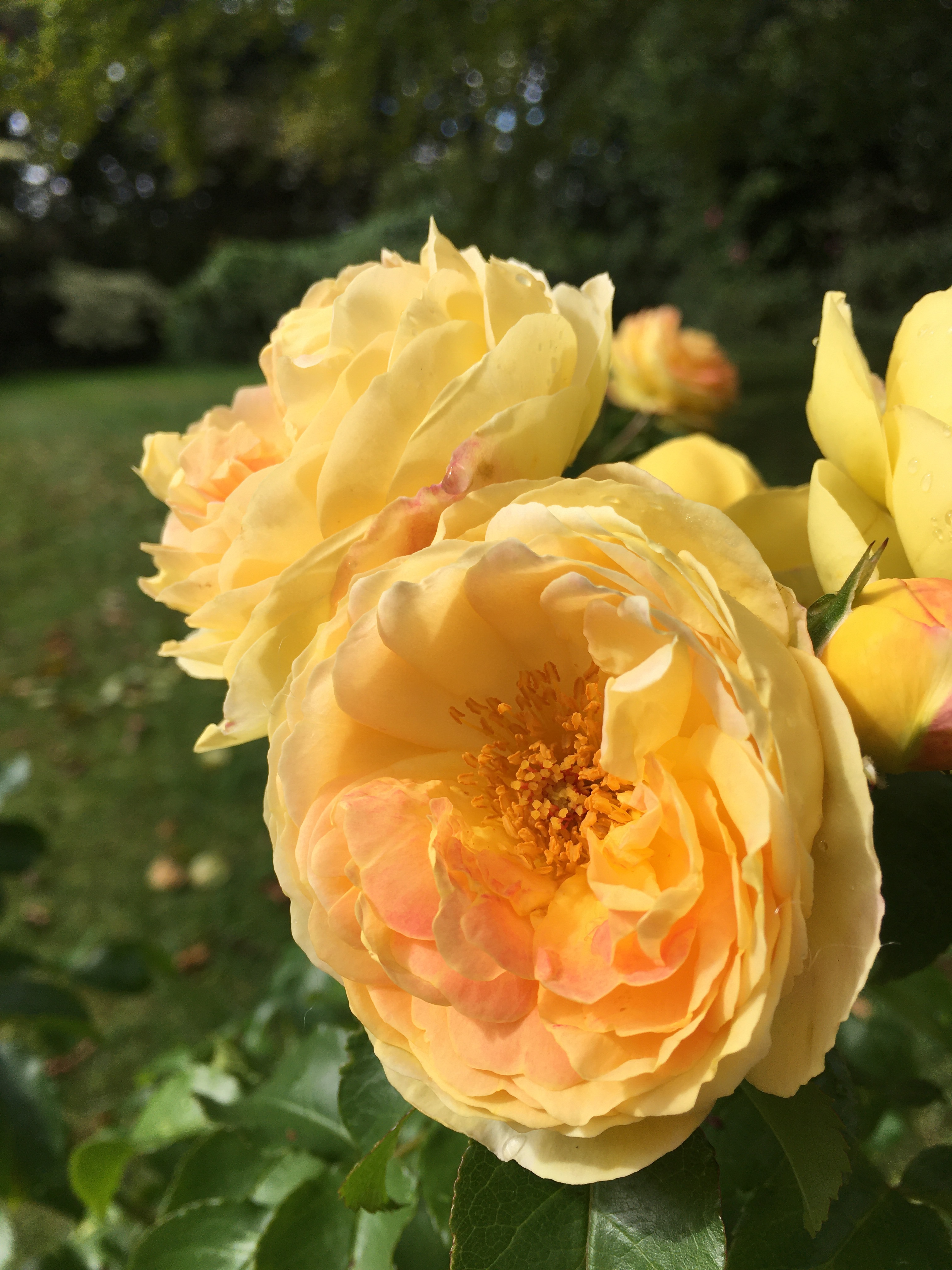
It’s been a challenging few weeks. We wanted rain. And we got it. A month’s worth in four days. Followed by Storm Ellen and 40 mile per hour winds. Anything not firmly staked, flopped over. Sunflowers and cosmos took a bashing. It’s taken a couple of days to prop up plants, tie them in, and sweep up twigs and leaf litter. I sometimes wish I was passionate about interior design instead of gardening. Wouldn’t it be lovely to create a scene, and have nothing smash it to pieces. But, sadly, I’m not remotely interested in being indoors. I’m only really happy when I’m outside, in the fresh air. Anyway, to cheer us all up, here’s some photos of what’s in flower in my garden today.
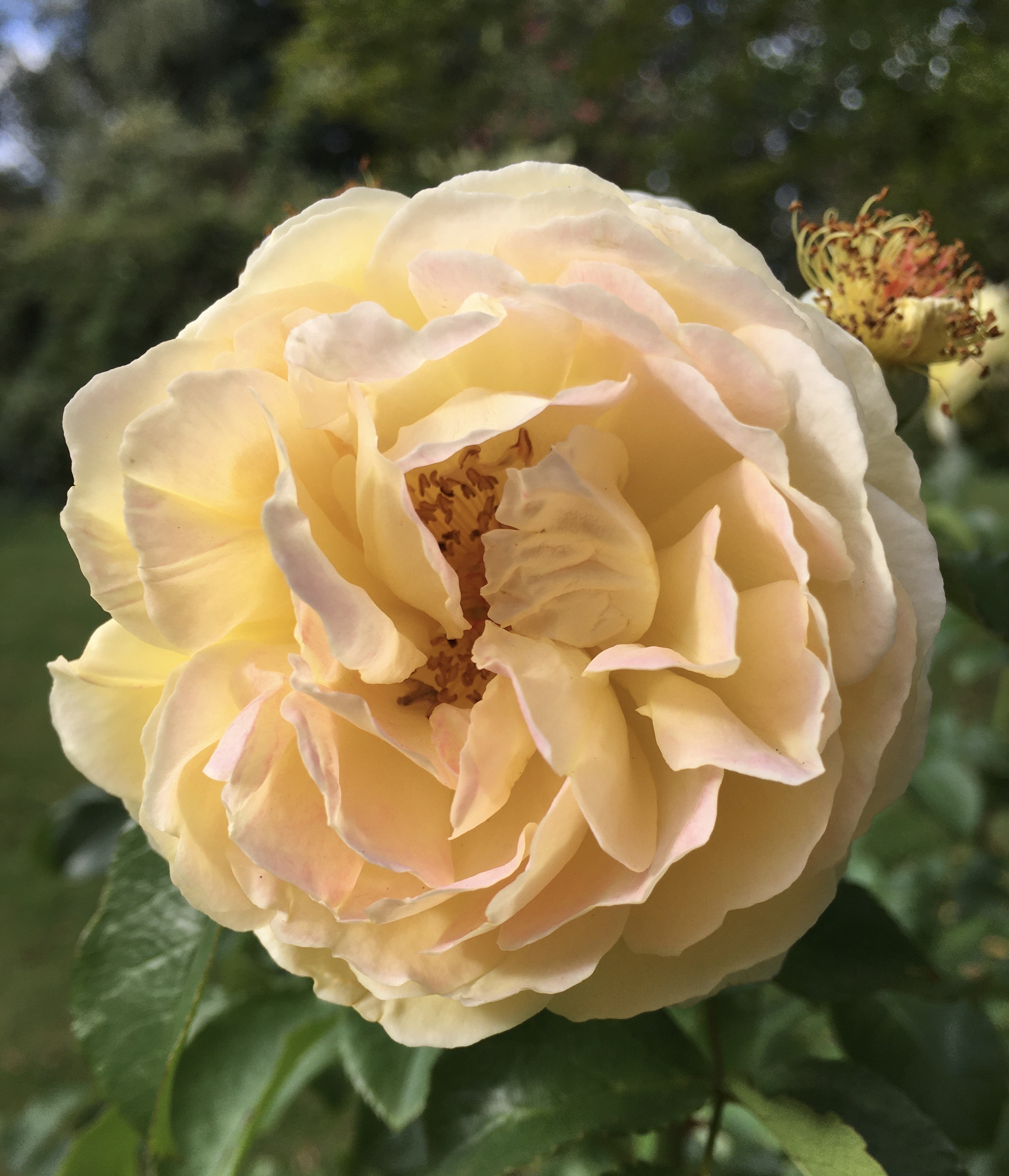
My new rose, Belle de Jour. Rose of the Year for 2021. Flowers open clear, bright yellow and fade to sunset shades of peaches and cream. There’s a delicate fruity scent and plenty of pollen for bees. Nice healthy green leaves, which is good for an organic garden like mine.

I think we can definitely say these flowers stand up to the weather. Some roses ‘ball’ in the rain. They fail to open and turn to mush. Luckily, Belle de Jour copes with a deluge; there’s not a mark on the petals. My rose came, by post, from Roses UK which promotes the British rose trade. I’m sure the new rose will be a huge success. It’s looking lovely in my garden already. And I’m always pleased to support British nurseries.
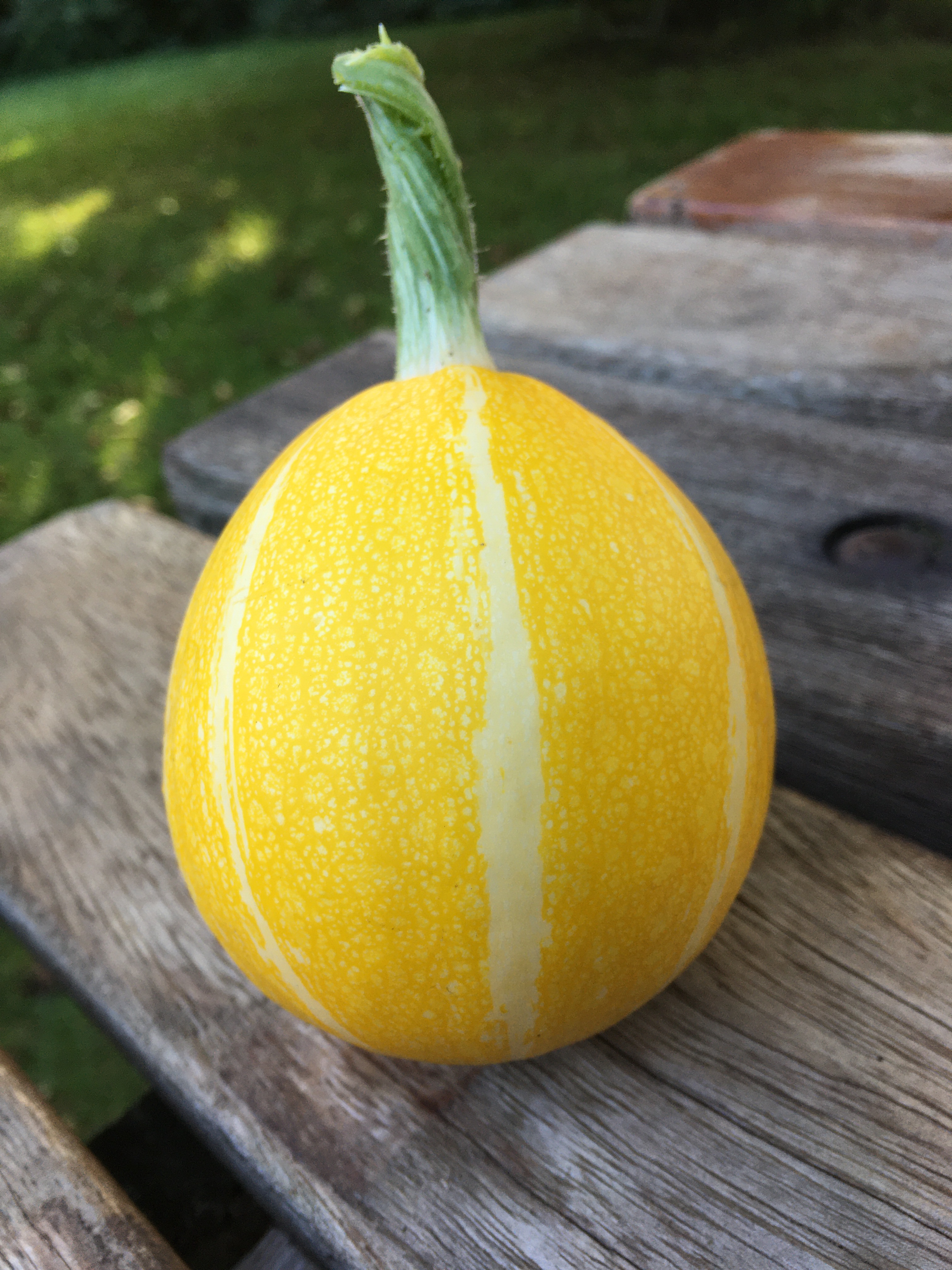
I’m growing a new variety of courgette, ‘Summer Holiday.’ Isn’t it pretty. I don’t know why, but this photo makes me so happy. It looks such a gorgeous little thing, bright yellow, with a twisty green stem. It’s a joy. And so easy to grow. I’m in favour of anything easy, this summer. Everything seems to have been hard work, so a highly productive trouble-free plant is very welcome. There’s a recipe for courgette and cream cheese soup to follow. It only takes ten minutes to cook.
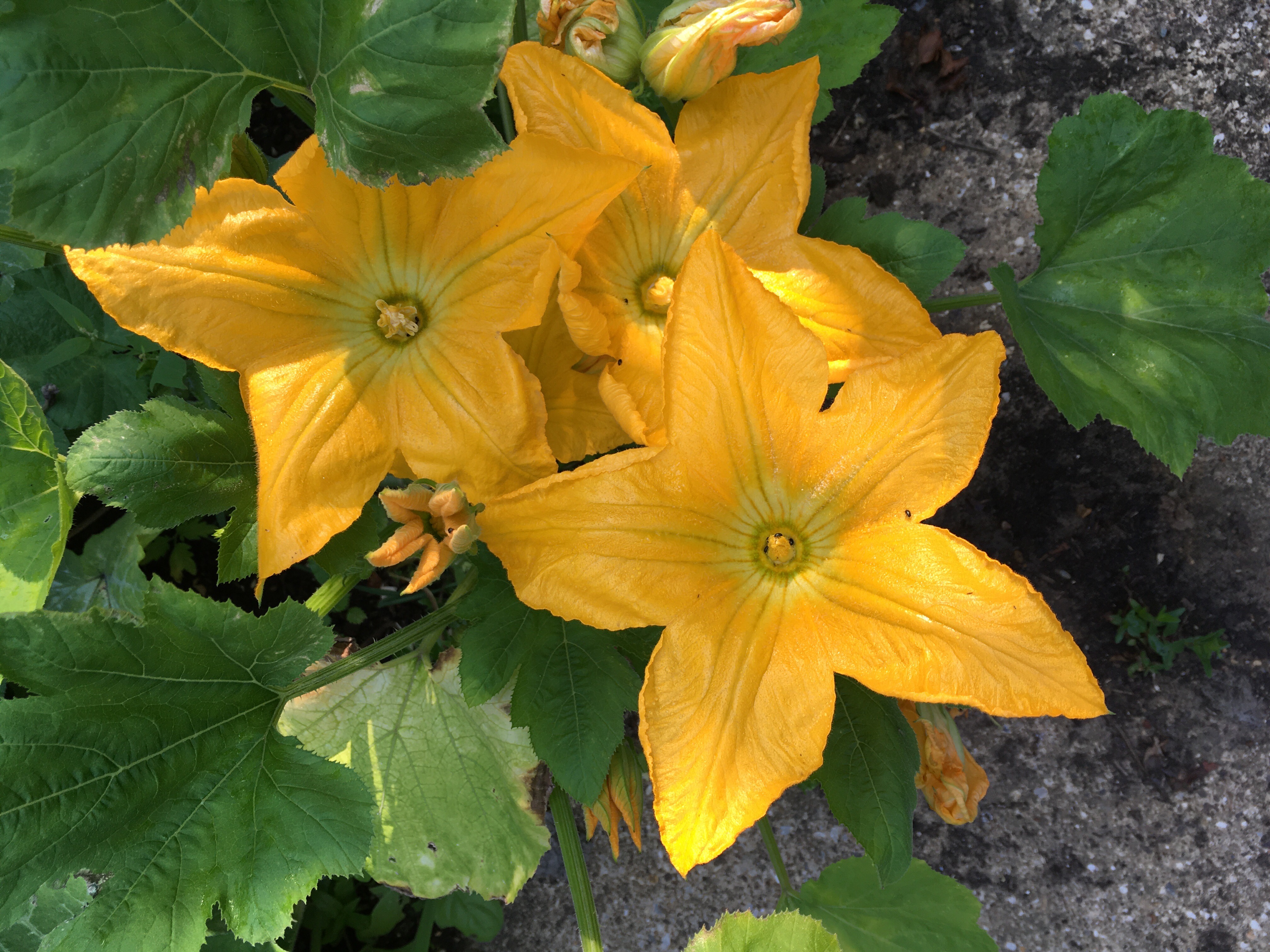
Courgette flowers look beautiful too. They only last a day, but are a sunny, joyful sight. I’ve planted courgette and squash all along the base of my climbing bean frame. They make good ground cover and smother weeds.

Here’s the beans I’m growing this year. Don’t they look colourful.
Yellow: Climbing French bean ‘Sunshine’. A new variety.
Green: Climbing French bean ‘Limka’.
Purple: Dwarf French bean ‘Red Swan’.
All growing together along the hazel A-frame support, with blue morning glory intertwined. The dwarf French beans grow to around 122cm (4ft). Climbing beans are around 2.5m (8ft). Every day, I’m gleefully throwing handfuls of beans into the freezer. They will be such a treat mid-winter when fresh greens are in short supply.
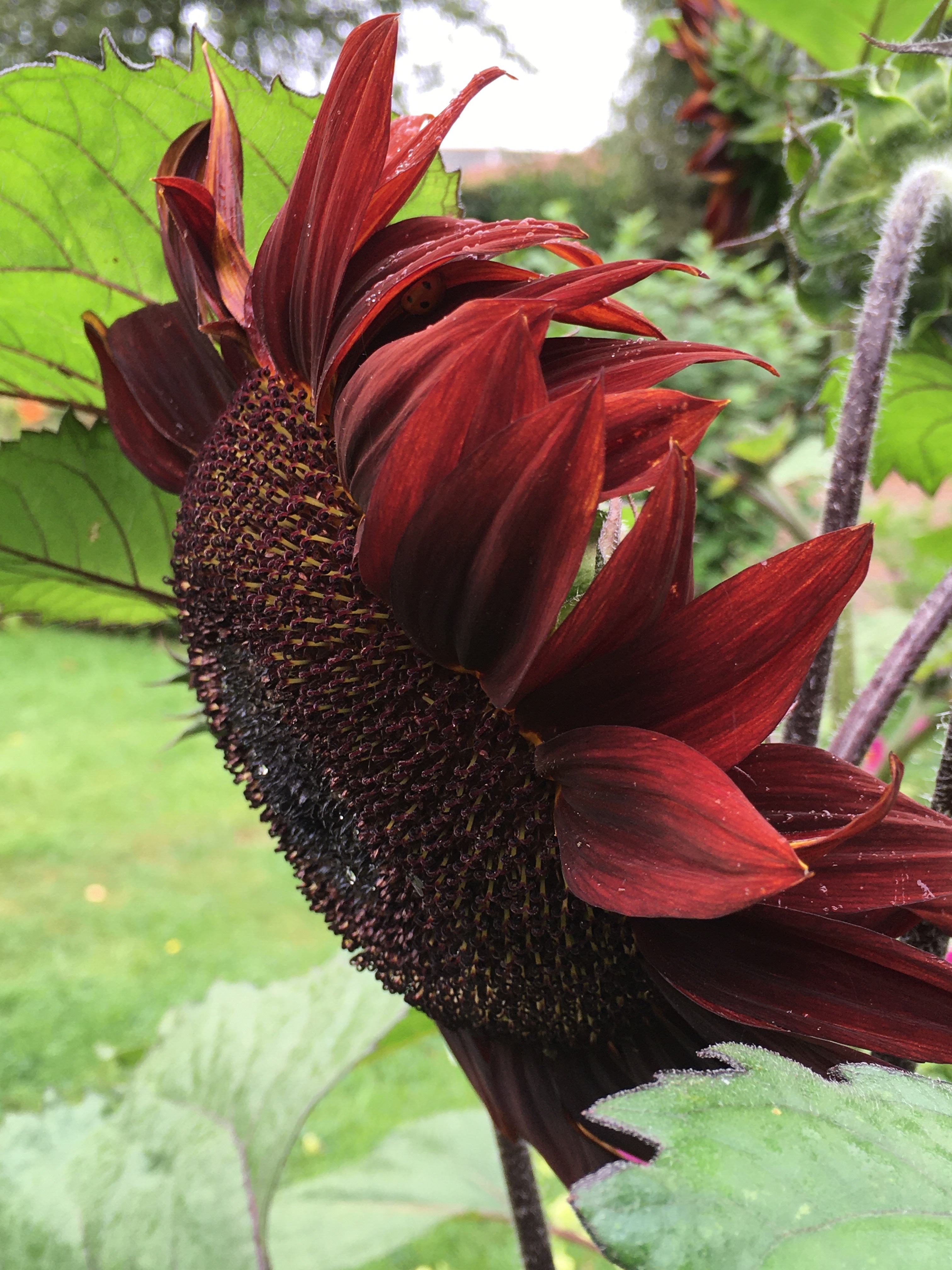
I have a newly-planted border all along the path to the front door. It was infested with couch grass. Over the winter I dug out all the plants and turned over the soil, searching for every scrap of tiny white couch grass roots. I had to do this four times before getting on top of the problem. In May, I planted the border with annuals; sunflowers, nicotiana, cosmos, and underplanted them with salvias, which I treat as bedding plants as they are not very hardy here.
I favour dark dusky-coloured sunflowers. This one pictured above is ‘Black Magic.’ It’s a multi-headed sunflower the colour of dark chocolate. Bees love it, and the seed will feed birds in winter. I won’t bother growing ‘Italian White’ again. The first sign of a gale and the petals curled up and dropped off. Not hardy enough for my windswept plot.
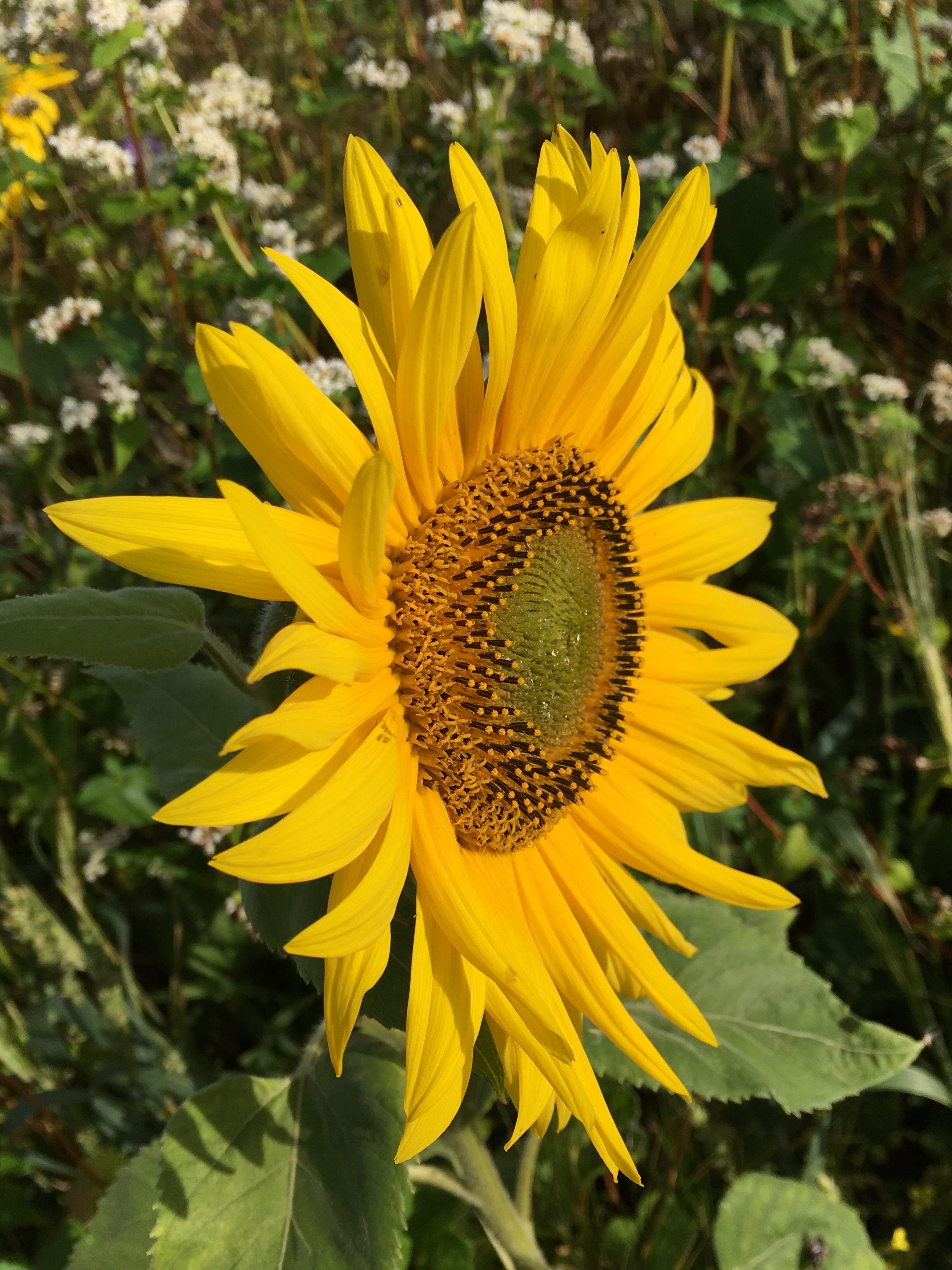
If you like yellow sunflowers you would love these, growing in the back fields behind my garden. We cheered when we saw the farmer sowing the seeds in spring. It’s a wildlife -friendly mix to attract pollinators, and the seedheads feed birds and mammals over winter.
The ridgeway footpath goes all along the side of the sunflower field. We walk along it twice a day, as we are still in the habit of our lockdown exercise regime. And some of us are still not venturing far, as we can’t take any risks. I’m still getting over a serious illness from three years ago, and although surgeons gave me a second chance, I’m not strong enough to fight off infection. Doctors nowadays are forthright. And mine, straight to the point, said a ventilator wouldn’t be an option. So there we are. I have to be careful. I’m not dwelling on it. I’m just grateful for small mercies, sunflowers included, as I can gaze at them and feel happy. I don’t know how, but I can.
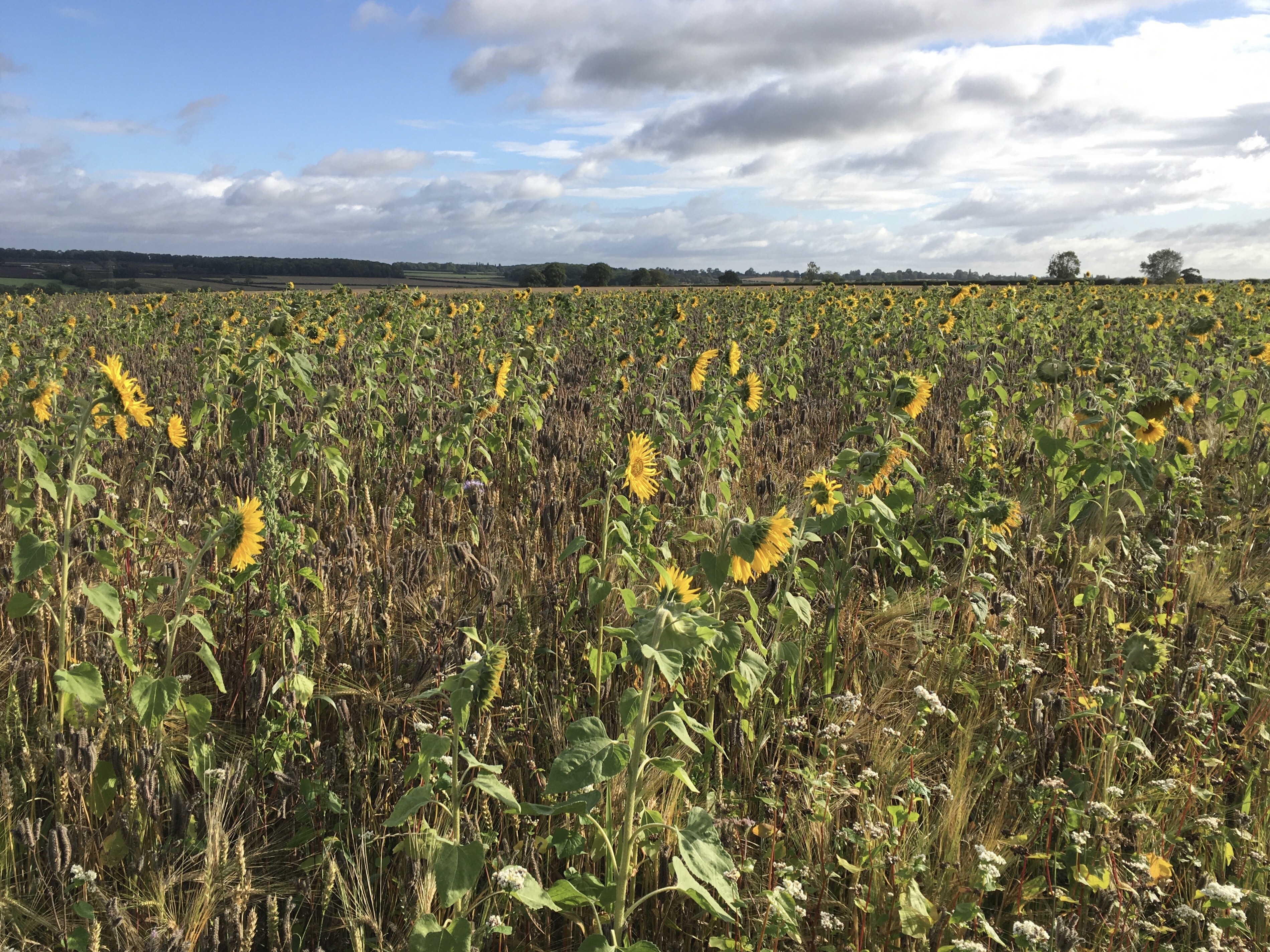
We still have swallows flying here. They must be finding plenty of insects. I’ll miss them when they go. I think of the journey they have to make, such tiny birds. Such a long way. It’s always an anxious time waiting for them to return in spring. Maybe, I’m going to have to get my courage up, and be like the swallows. Set off into the unknown. I can’t stay here forever, as lovely as it is, and as tempting as it’s become to say how well I’m coping. Someday soon, I have to set forth. Wish me luck!

On the footpath, going home, I pass by this old crab apple tree. It must be 100 years old, the size of its trunk. It makes a natural arch over the pathway. I like to gaze into the distance and wonder how the view might have changed over the past century. Probably not a lot as it’s still all farmland round here. But the people who’ve passed by this tree, their lives would have been very different 100 years ago. We have so much to be grateful for.
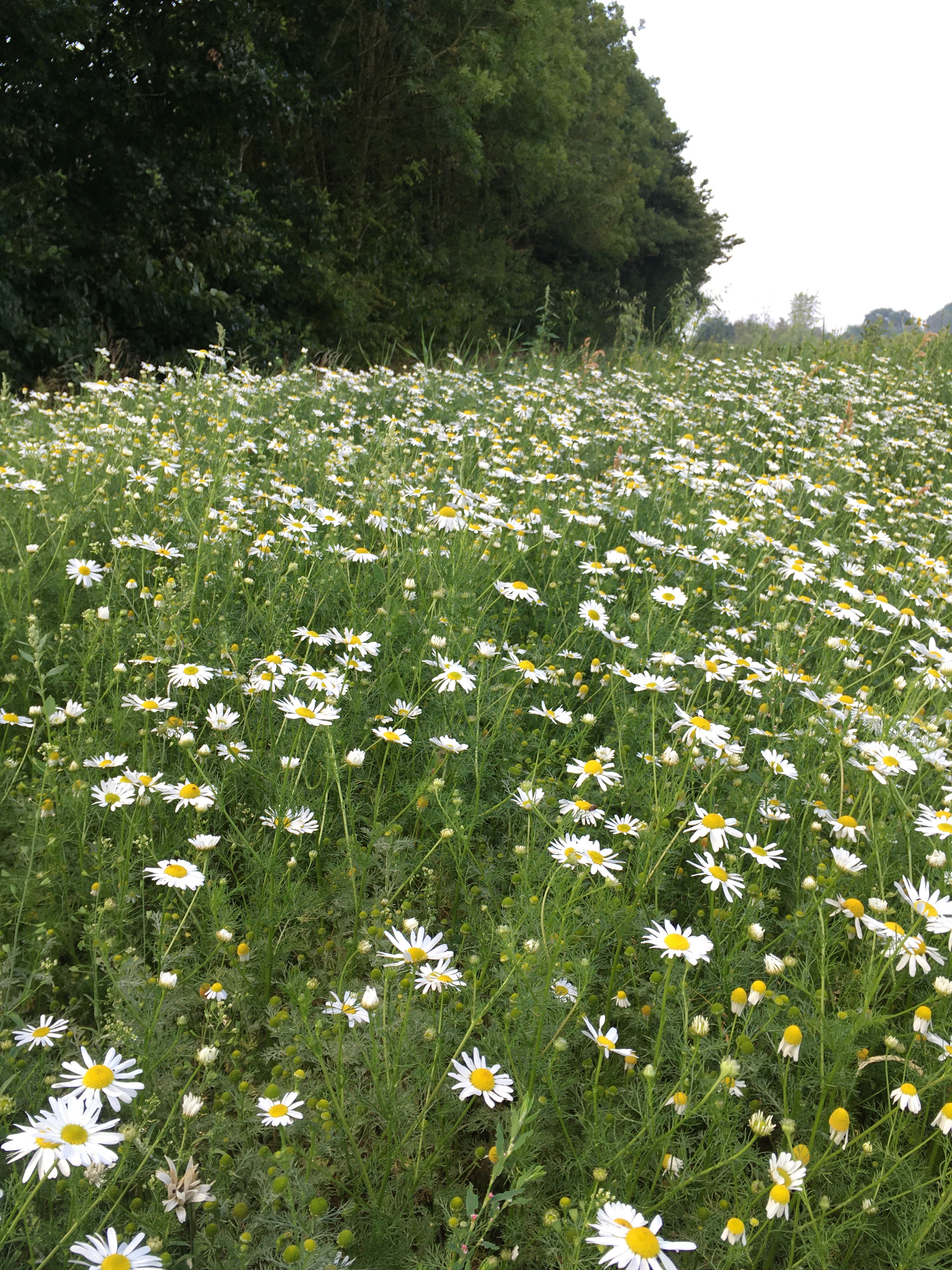
Nearing home, by our field gate, you can see the row of trees we planted 30 years ago when we were in our 20s. We never thought those little saplings would grow into a wood. And we didn’t know how much joy they would give us, watching the leaves change through the seasons, and giving a home to birds and wildlife. This summer, these daisies suddenly appeared. On sunny days, they have a strong chamomile scent. They may only be weeds, but they are a lovely sight, even so. Don’t you agree.
How has your garden fared this summer with the heatwave, drought and storms? It feels like we have faced many challenges, all round. Let me know what’s looking good in your garden right now, and whether you are managing to get out and about yet, or like me, waiting for your moment.
Links:
Karengimson1 on instagram and @kgimson on twitter
Roses UK: https://www.rosesuk.com/
Rosa Belle De Jour: https://www.apuldramroses.co.uk/
Summer Holiday courgette: https://www.mr-fothergills.co.uk/Vegetable-Seeds/Courgette-Seed/Courgette-Summer-Holiday_2.html#.X0GQChB4WfA
Beans: https://www.mr-fothergills.co.uk/Pea-and-Bean-Seeds/Climbing-Bean-Seeds/#.X0GQPhB4WfA
Sunflowers : https://www.mr-fothergills.co.uk/Flower-Seed/Sunflower-Black-Magic-F1-Seeds.html#.X0GQbRB4WfA
Six on Saturday meme : https://thepropagatorblog.wordpress.com/2020/08/22/six-on-saturday-22-08-2020/
Gooseberry Crumble- family favourite recipes

When I was a teenager, I was taken on as a trainee reporter at the Melton Times weekly newspaper. One of our jobs was to go out into the town and obtain comments from residents. These were called ‘doing a vox pop.’ We would ask for views on local planning applications, council proposals, and any controversial subjects the editor could think of. There were no mobile phones in those days, so with no-one keeping track of us, we would be out about about for hours. Vox pops were one of my favourite jobs because I loved chatting to people. We just knocked on doors, said who we were, where we were from, and people let us in! Two hours later, we would leave, with our one paragraph comments, nicely replenished with home-made cake and numerous cups of tea. One elderly gentleman that stays in my memory was called Albert. I can’t remember what the vox pop was about, but when I knocked on the door, he took me straight through to the garden where he showed me his fruit and vegetables. He had rows and rows of gooseberries- green ones, yellow, and red, glistening in the sunshine as if they had been polished. The pruning demonstration and growing advice took an hour, and at the end we sat down and had the most delicious crumble I’ve ever eaten, gooseberries flavoured with elderflower syrup and crunchy almonds on top. At that moment, I was happy. I think we store up such moments in our memories, and come back to them from time to time. I have a picture in my head of me, sitting on a dining room chair brought out into the garden, enjoying the sunshine, eating delicious food. Albert, a widower in his 90s, lived alone. For one afternoon, he had someone’s rapt attention while he talked about his passion for growing fruit. I was very glad that I’d knocked on his door. In those few short hours, I learned about the generosity of gardeners, how a love of growing things, and sharing with others, drives some people. And kindness. I learned a lot about kindness. Looking back, I’m grateful and relieved to say most people I’ve chanced to meet have been kind. I’ve tried to honour their memory in this blog.
Here’s my Gooseberry Crumble Recipe – with grateful thanks to Albert, and his two ginger cats, who made me equally welcome in their garden.
RECIPE – CRUMBLE TOPPING
8oz (225g) plain flour
5oz (150g) soft light brown sugar
3oz (75g) butter or dairy alternative
2 tbsp flaked almonds (optional)
1 level tsp. baking powder
METHOD
Place the flour and baking powder in a large bowl and add the butter. Using your fingertips, rub in the butter until it has all been dispersed fairly evenly and the mixture looks crumbly. Add the sugar and almonds and stir well to combine.
GOOSEBERRY CRUMBLE
Use 2lb (900g) gooseberries
2 tbsp elderflower syrup or cordial
Top and tail the fruit and place in a large pie dish. Sprinkle over the elderflower syrup and cover with the crumble mixture.
Bake in the centre shelf of an oven at 350F/ 180C/ gas mark 4 for 30- 40 minutes. Check to see if the topping is getting too brown after 30 minutes and cover with foil to finish cooking.
Keeps three days in a fridge, or can be portioned up and frozen for three months. Thaw before reheating.
Serve with custard, or thick double cream.
Enjoy!

My crumble mixture. Without almonds as a guest had an allergy to nuts.

All that was left of our family gooseberry crumble. I was lucky to have this piece left for the photo!

Gooseberries from my garden.
I recommend Hinnomaki Red, green Invicta, and yellow Early Sulphur. These can be grown in a shaded position. Like many fruit that is ‘tart,’ sunshine isn’t needed to make high sugar levels. So you can grow gooseberries, blackcurrants, redcurrants, raspberries and sour cherries such as Morello in shade.
Gooseberries will grow in full sun, but they are tolerant of shade, so it’s much better to save your sunny beds and borders for peaches, sweet cherry (Celeste is a good variety) gages and plums.
Thank you for reading this blog. I hope you enjoy the recipes. Have a great gardening week. Karen ❤️
Links: You might like to read https://bramblegarden.com/2018/07/26/summer-fruit-harvest-and-making-garden-jam/
Also: https://bramblegarden.com/2019/08/20/plum-crumble-family-favourite-recipes/
Gooseberries: https://www.chrisbowers.co.uk/category/gooseberries/
Garden Diary for ‘Six on Saturday’ – 8th August 2020
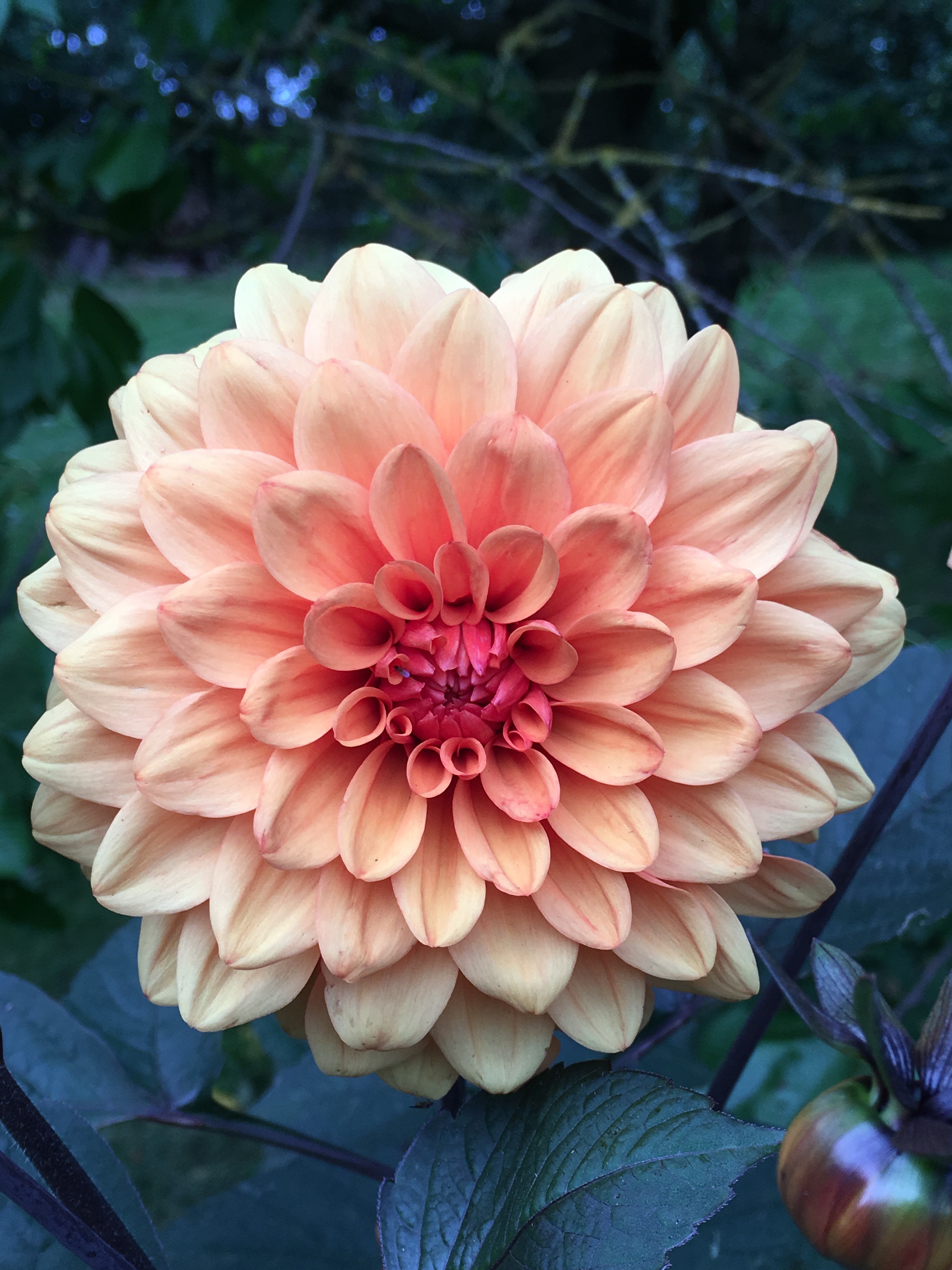
Peach and blue tones feature in my garden diary this week. Dahlia David Howard is usually a much brighter colour than the flower pictured above. But we’ve had sweltering temperatures the past few days and heat has faded some of the blooms. I rather like this delicate hue. I’ve waited until dusk to take my photos. The dahlia bed is next to the orchard, and I can hear hedgehogs shuffling through the dry twigs and grass in the undergrowth. If I wait quietly, they will come out and feast on fallen plums. I never knew how much they loved plums until a few years back when we had a massive harvest and, each night, five baby hedgehogs turned up. It was magical to watch them enjoying the ripe and juicy fruit. In the day, there are butterflies sipping the juice, meadow browns and peacocks in abundance this year. Not so many painted lady butterflies as last year though.

Here’s my second ‘peach’ photo. Rosa Phyllis Bide. It’s a medium-size rambler with large sprays of semi-double flowers 6cm wide. I grow it because it is disease resistant and doesn’t need spraying with chemicals. All my roses have to be tough. If you choose carefully, there are many varieties less likely to suffer from the fungal disease black spot. Phyllis Bide is easy and trouble-free, and repeat flowers from June to November. There are sometimes a few blooms in December, eagerly snapped up for Christmas table decorations. Flowers are gorgeous set amongst creamy white beeswax candles. Bees also love the pollen, and catering for wildlife and pollinators is often at the heart of everything I do. In my garden, Phyllis Bide grows up a wooden post and into a lilac tree, adding interest when the lilac is out of flower. It’s about 2.5m tall with a 1.5m spread.

This is a late-flowering Phyllis Bide rose, covered in snow on 11th December. Sunshine soon melted the ice, and the flower was still perfect. Isn’t it beautiful. A heart-sing moment, captured with an old i-phone camera.

My third photo is from the polytunnel. I’m growing pots of dwarf peach and nectarines. This one is Prunus Nectarella. It grows to about 1.5m by 1m in a 60cm container. I’m also growing Garden Lady and Bonanza. Planted in pots, they can be carried into the greenhouse or poly tunnel over winter, which helps protect early flowers from frost. They flower in February when there’s few pollinators about, so blossom has to be pollinated with a soft paintbrush. It’s a lovely calming occupation on a cold winter’s day, and gives hope spring is not far away.
Peaches and nectarines suffer from a disease called peach leaf curl. It’s a fungus which infects leaves causing them to distort and blister. It results in early leaf fall, reducing vigour. Wet conditions are needed for the disease to thrive, so keeping them indoors over winter helps to protect them. All the effort of growing them is worth it. Eating a peach or nectarine that’s been allowed to ripen naturally on the tree is a delight. Shop-bought fruit just can’t compare.
I wrote about my peach crumble cake recipe here. Do try it – with any fruit you have, apples, pears, plums- or peaches, and let me know what you think. It’s become a family favourite here.
https://bramblegarden.com/2017/08/22/peaches-and-plums-crumble-and-jam/.
 Now for the ‘blue’ photos this week. I’ve chosen morning glory, Ipomoea purpurea. This is a seedling from a selection I’ve grown for years. Morning glory is an annual climber reaching 4-5m given a warm sunny fence or wall. Mine grow up through my climbing French beans. I’m hoping the flowers will attract pollinators which will benefit my vegetables. You can see the nectar guides in this photo. Flowers have visible and UV guides or lines directing bees to the nectary. Sunshine has highlighted the lines. It’s almost mesmerising. I save my seed each summer and store it in a cool, dark place over winter. I’ll start them off again in 3″ pots on the kitchen windowsill in February. Recommended varieties include Star of Yelta, Grandpa Ott and Heavenly Blue. All easy to grow, and once you’ve bought a packet of seed, you’ll have morning glory for ever more. Such a lovely thought!
Now for the ‘blue’ photos this week. I’ve chosen morning glory, Ipomoea purpurea. This is a seedling from a selection I’ve grown for years. Morning glory is an annual climber reaching 4-5m given a warm sunny fence or wall. Mine grow up through my climbing French beans. I’m hoping the flowers will attract pollinators which will benefit my vegetables. You can see the nectar guides in this photo. Flowers have visible and UV guides or lines directing bees to the nectary. Sunshine has highlighted the lines. It’s almost mesmerising. I save my seed each summer and store it in a cool, dark place over winter. I’ll start them off again in 3″ pots on the kitchen windowsill in February. Recommended varieties include Star of Yelta, Grandpa Ott and Heavenly Blue. All easy to grow, and once you’ve bought a packet of seed, you’ll have morning glory for ever more. Such a lovely thought!
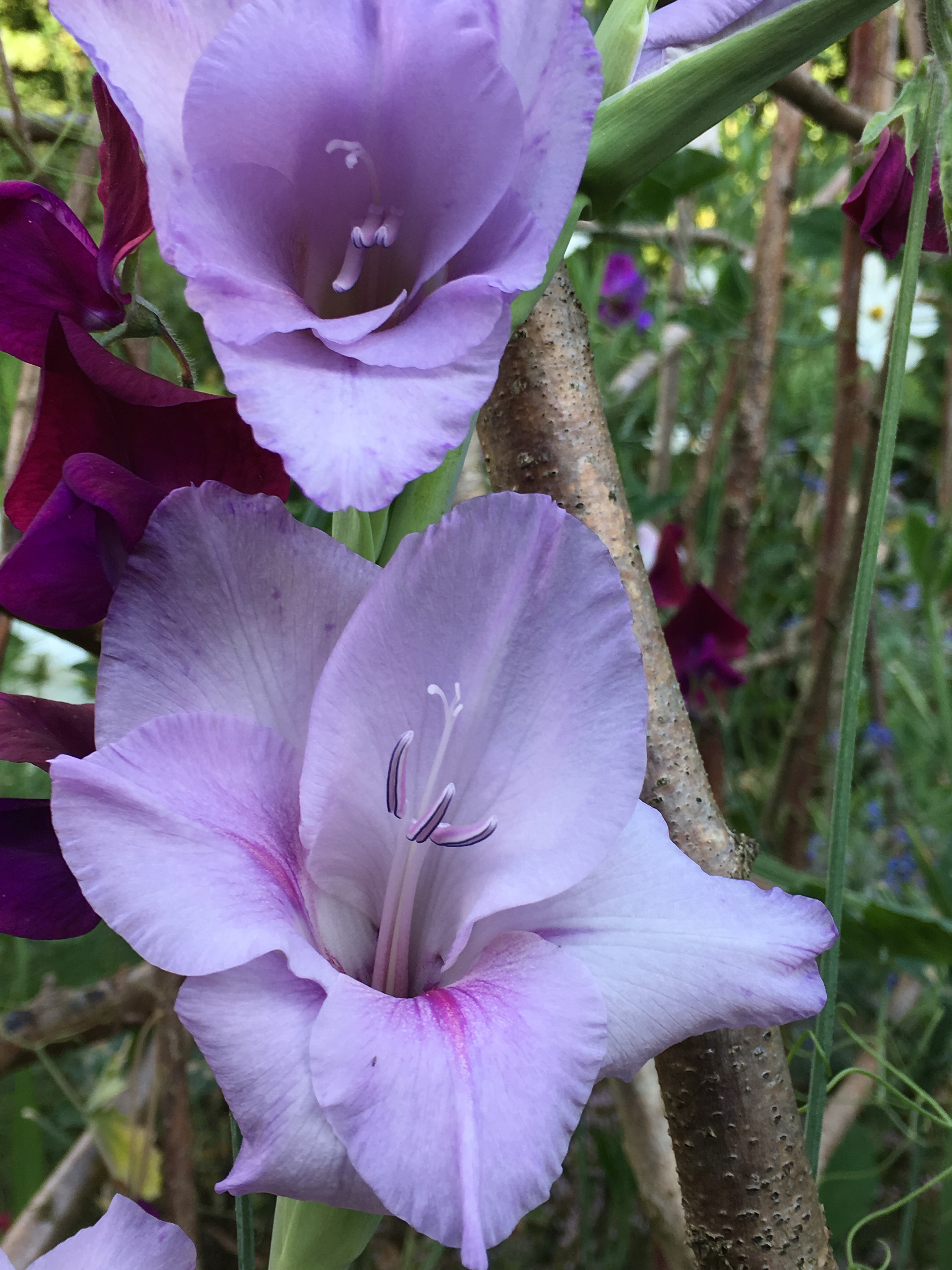
My second ‘blue’ photo is gladioli. Another summer treat. This one came in a blue-mix assortment from Gee-Tee Bulbs. I plant them down the centre of my hazel rod sweet pea A-frame, where they grow quite happily without needing stakes. As soon as the heads pop out of the side of the frame, I harvest them for my cut flower posies. Gladioli can grow tall and floppy, and in the high winds we seem to be getting more and more, they often end up crashing to the ground. Grown with sweet peas, or though a climbing bean frame, they’ll get plenty of support. Corms are lifted in autumn when I pull up sweet peas. I let the leaves die back naturally and then I take off the little offset corms which grow beneath the ‘mother’ corm. I’ll keep them dry and frost free over winter and replant them next spring. If you have lovely, free draining soil you could leave the gladioli in over winter. But I have cold, heavy clay which seems to be flooded every winter now. Corms would rot in the wet. Links for bulb suppliers are at the end of this piece.

And finally, my sixth photo is meadow cranesbill or Geranium pratense. Again, you can see the violet and silver bee guides. So delicate, it reminds me of a butterfly wing.
I wrote about my wild geraniums here. https://bramblegarden.com/2017/06/28/wordlesswednesday-wild-geraniums-on-the-march/
I hope you’ve enjoyed this week’s voyage around my garden. My plot has kept me up-beat during the covid pandemic, giving me something cheerful to focus on. Thank you for all your kind messages. It’s lovely to hear so many of you feel you’ve have had a brief respite from worry, just for a few minutes, reading my blog and virtually ‘walking’ around the plot with me. Keep in touch, and let me know what has helped you through this difficult time. Have you grown anything new, or found comfort in familiar things. Thanks for reading. It’s much appreciated.
Links:
Dahlia David Howard. https://www.gee-tee.co.uk/bulbs/dahlias
Rose Phyllis Bide: https://www.davidaustinroses.co.uk/products/phyllis-bide
Peaches, apricots and nectarines: https://www.chrisbowers.co.uk/dwarf.php
Morning glory: https://www.mr-fothergills.co.uk/Flower-Seed/Morning-Glory-Seed/#.Xy_rxhB4WfA
Gladioli: https://taylors-bulbs.com/summer-flowering-bulbs-advice/
Geranium pratense: https://www.naturescape.co.uk/product/meadow-cranesbill-plugs/
I am @kgimson on Twitter, karengimson1 on instagram.
Six on Saturday is a meme where gardeners from all around the world post six or more photos of what’s growing on their plots each week. It’s fascinating to see what’s looking good. Sometimes it’s the same plant as I’m growing, but in another country millions of miles away. https://thepropagatorblog.wordpress.com/2017/09/18/six-on-saturday-a-participant-guide/
Introducing Monty. 7th August 2020 – a new addition to Bramble Garden

I am typing this one-handed. The other hand is wrapped around a tiny tabby kitten. Usually, this blog is all about my garden and what I’m growing. I share with you my trials and tribulations as I coax seedlings into growth, set them out and watch over them. Just about everything seems determined to munch on, peck at and generally stunt my treasured seedlings. Gardening certainly teaches patience. Well, this time I am nurturing a kitten. We have called him Monty. And the process is rather like growing a delicate seedling. It requires plenty of patience. He has been a heap of trouble!

Monty had a life-threatening condition which wasn’t apparent until he arrived here. On his first morning, he was lively enough, but as the day wore on it was like watching a wind-up toy running out of power. He sort of wound down and stopped. I noticed he wasn’t eating anything, or using his litter tray. Luckily, I’d booked a vets appointment for vaccinations, but instead of getting his jabs he was put on a drip and given antibiotics. His problem turned out to be a blocked bowel.

While he was with his mother, in a familiar place, with his siblings, he survived. The mother’s milk sustained him. But taken away from his mother and moved to a new home, he crashed. I had never heard of this happening before and the vets warned kittens can sometimes die unexpectedly. The owner wouldn’t have known anything was wrong, so there’s absolutely no criticism being made here.

The crisis spurred me into full-speed rescue mode. Special baby milk arrived from the vets, complete with little bottles and teats. Monty became so weak he couldn’t lap the milk, so I measured out tiny amounts, 10ml at a time, and tipped him on his back. It was a struggle. Every few hours, I’d boil the kettle and mix the powder into a paste and then into a liquid. Any little lumps, and he wouldn’t drink it. Too cold, he’d refuse. He wasn’t at all helpful in this campaign. But I was determined he would survive.

There’s been so much I’ve not been able to change these past five months, so many things out of my control. I’m used to being able to do something to make things better. With covid, I felt I could do little to make a difference. But when Monty came along, I put all my efforts into encouraging him to live – it was something positive to do.
Now, after a few weeks, he is lapping milk and starting to eat.
Prescription kitten mousse arrived from the vets. Tiny amounts offered on the tip of my finger, to start with. Then I tapped the edge of the plate to encourage him.
After all this nursing, back and forth to the vets for subcutaneous fluids, Monty, is starting to thrive and is gaining weight. He’s still on the baby milk, and I’m reading -and re-reading the ‘ kitten paediatric weaning’ leaflets given to me by the vets to work out how to move him on to dried food. I’ve realised that nothing is going to be easy.

Carrying him around, and literally willing him to live, he is bonded to me now. I know all his funny little ways, and I expect he knows mine too.

He likes to lie down the side of the armchair in the summerhouse, rather than on my knee. He is somewhat squashed in, but I assume he feels safe there.
Monty has been as much trouble to nurture as a rare and exotic flower. But just as rewarding as anything I’ve ever ‘grown.’
I hope you’ve enjoyed this diversion from the usual tour of the garden. Have you ever had to nurture something as much as I have with Monty? Isn’t it rewarding – and exhausting. But so worthwhile. Thanks, as ever, for reading the blog and keeping in touch through these difficult times. It is much appreciated.
Six on Saturday – photos from my garden 1st August 2020

This is the place where I’m spending most of my time at the moment- my cut flower and vegetable patch. There’s a never-ending list of tasks; tying in, propping up plants, weeding and harvesting. I’m not complaining. Mentally it’s a ‘covid-free’ zone. As soon as I step into this place, my thoughts are solely on gardening. The covid problem, and all the questions in my head, quickly melt away. It’s become an essential sanctuary. A breathing space. Literally.

The orchard and view though to the veg patch in February. Sometimes I look at these photos from just a few months ago, and want to turn back the clock, go back to a time when life was less complicated, when we could go out without face coverings and hand gel. When the words social distancing, isolation, PPE didn’t exist. However, it’s not in our power to go back, only forward. And I’m finding comfort in the ever-changing pace of the veg plot. Tiny seedlings are now towering flowers. Dahlias are five foot tall. Bean shoots are spiralling anti-clockwise along rustic hazel poles and soon there will be a harvest to fill the freezer. For the past 30 years I’ve stood on this vegetable plot, and dug the soil, planted the seeds, hoed the ground and harvested the crops. Everything in the outside world is unfamiliar, but here on the veg plot, plants are performing just as they always have. Nature is carrying on regardless. Humans are changing a lifetime of habits. No hugging, no hand shakes, keeping a distance. The house and garden, usually so full of laughter, is quiet. And yet, there’s plenty of butterflies, bees, grass snakes, hedgehogs, owl chicks, swallows- all thriving in the peace and solitude.

And I’m picking plums. As I always have. A bumper harvest this year. The variety is Victoria. Sweet-tasting and prolific. I’ve made jam and I’m sharing it with friends in the village. One good thing to come out of covid, we are all sharing what we have, spare plants, surplus food, knowledge, hints and tips. We share bread, cakes, face masks, fabric for making scrubs. There’s a strong feeling of caring, and helping one another get through this time.

Here’s my plum and almond jam. Delicious in jam tarts, cakes and simply with bread and butter. In winter, I line up jam jars along the kitchen window. It’s like looking through stained glass. Very cheerful on a cold, dark day.

I’m picking flowers. Dahlia David Howard is doing well. Photos taken at dusk seem to glow. Beautiful bright orange flowers set against dark foliage. Flowers last nearly 10 days in a vase. I cut stems early in the day and immediately drop them into a bucket of cold water. Perfect for cheering up the kitchen table.

And another favourite, semi-cactus Dahlia Nuit d’Ete. I love the dark red centre and the curled and twisted petals. These are on my bedside table, combined with sweet peas. It’s wonderful to wake up to the scent of summer flowers, windows flung wide open and the hum of bumble bees under the eaves.

Looking out from the garden, I can see crops ripening in the back fields. Soon there will be the sound of harvesting. Another sign the season is moving on.
What’s looking good in your garden this weekend? Have you found solace in gardening during these difficult times? Thank you for reading and leaving your comments. It’s nice to know I’m not talking to myself on here.
Links: My plum jam recipe is here : https://bramblegarden.com/2017/08/22/peaches-and-plums-crumble-and-jam/
Dahlias : https://www.gee-tee.co.uk/bulbs/dahlias
Plum trees: https://www.chrisbowers.co.uk/
Orchard Odyssey : https://bramblegarden.com/2019/09/27/an-orchard-odyssey-book-review-and-prize-draw/
Recipes and ideas on what to do with the harvest : https://bramblegarden.com/2018/12/04/book-prize-draw-winner-the-creative-kitchen/
Making flower posies, courses and flowers: Georgie Newbery : https://bramblegarden.com/2020/07/01/online-hand-tie-posy-course-with-georgie-newbery/
Six (or more) on Saturday: https://thepropagatorblog.wordpress.com/2020/08/01/six-on-saturday-01-08-2020/
Talking on the radio – notes and photos for wednesday 22 July, BBC Radio Leicester Gardens Hour
I’m still talking on the radio once a fortnight – from the peace and quiet of my potting shed. It’s lovely to be at home rather than having to drive into Leicester. And when the music is playing between chats, I get on with a bit of watering or prick out a few seedlings, and nobody knows.

This week we talk about sweet peas. I’m growing new variety, Ripple Mixed, pictured above. It has mauve, pink, and purple markings on a pale pink background. The scent is strong, and stems are nice and long, making them ideal for cut flower posies. One to keep on my list for autumn sowing. I’m ordering seeds now to ensure I get the varieties I want. This year’s experience of buying plants and seeds – and the long delays receiving them- has taught me to plan ahead and order early.

Here’s a selection of sweet peas I’m putting in jam jars on the village green to raise money for Rainbows Hospice for children and young people. Rainbows cares for children with life-limiting illnesses and nearly all its funding comes from donations. The hospice has lost almost £1 million in fund raising this year, due to events being cancelled because of covid. I put leaflets alongside the flowers, hoping it might encourage someone to learn more about the hospice and make a regular donation. Every little helps.

Here’s the Wiltshire Ripple variety I mention, with its delicate picotee edge. I wouldn’t be without this one. Always a good strong performer.

This is Mayflower 400, another new variety, celebrating the 400th anniversary of the Pilgrim Fathers sailing to the New World. It’s highly-scented and a good strong grower. Long stems, and flowers last a week in a vase.

After talking about flowers, we move on to what I’m growing and harvesting from the plot. Plums are prolific again this year. This is Victoria, delicious and reliable. I’m making jam. It’s such a treat in winter to have a taste of summer. I stand the jars along the kitchen window and admire them. It’s like looking through pink stained glass. Very cheerful on a cold, dark day.
The recipe for plum crumble cakes and plum jam is here : https://bramblegarden.com/2017/08/22/peaches-and-plums-crumble-and-jam/

When my children were little, we fed them apple purée as their first solid food. BBC Radio Leicester programme host Naomi Kent is having a baby in two months, so we talk about the varieties of apple trees she might plant in her new garden.
I’m growing Spartan, a gorgeous deep red apple with a sweet honey taste. Apples are small and numerous, the perfect size for children’s lunch boxes. Lovely for juicing which is a somewhat messy process, but worth the effort.
I also grow Greensleeves (above) for cooking and eating. It’s sweet enough on its own, so you won’t need to add sugar for cakes, purée and puddings. Kept somewhere cool, apples will store until February.
Supermarkets often only sell a few apple varieties, typically Cox, Golden Delicious and Braeburn. Often they’ve been grown abroad and flown in. Sometimes they are coated with chemicals to improve their keeping qualities. And yet, in the UK, we have perfect conditions to grow your own apples. Traditionally, apple trees would have been 6m tall, but plant breeders have produced some compact varieties for small gardens and containers. Lubera have a range of ‘column’ fruit trees which have short side shoots and a narrow, vertical growing habit. I’m growing Malini Top Model which looks as if it will be about 50cm wide and eventually 3m tall. I’m growing it in a large plant pot and it has a good crop of apples in its third year. Lubera also have column types of pear, cherry and plum varieties on their website.

We had record amounts of cherries this year. I’ve been freezing them and preserving them in alcohol for winter treats. There’s a cherry marzipan chocolate recipe mentioned in the links at the end.
My cherry tree is Stella, a self fertile variety bred in Canada and introduced to Britain in the 1960s.
If you’ve got a small garden, opt for a cherry tree on dwarfing Gisela rootstock, which makes a compact tree. It’s much easier to protect trees from frost, if they are small enough to cover with fleece or an old bed sheet.
Good varieties to try include self-fertile Sunburst, Summer Sun and Celeste.

I’m fond of pears too. I have a Conference pear which provides plenty of fruit. If you are short of space, pears are easily trained along a fence or wall, in an espalier shape. Pears need more sunshine and warmth than apples, so it is a good idea to give them the protection of a warm wall. I’m going to plant a Concorde pear on the south wall of the house. Concorde is possibly a more reliable cropper than Conference.
If you have a more shadier garden, and you want to grow fruit, I’ve found success with Morello cherries, damson and quince, and crab apples for making jelly.

As well as apples, pears, plums and cherries, I wouldn’t be without my mini peach trees. I’m growing dwarfing variety Garden Lady and Bonanza in 45cm pots. We don’t get very many peaches yet, but the taste is so delicious and sweet. It’s a special treat to have home- grown ripe and tasty peaches.
I’d love to grow my own apricots. I’ve seen compact varieties Aprigold and Isabelle at nurseries. Our neighbour, Arthur, at our first house, had a fan-trained Moorpark apricot. He never did any other gardening, leaving it all to his wife Dorothy, but every day he fussed over his apricot tree, watered it and covered it up on cold nights. When it produced a magnificent crop each summer, he gave bags of fruit to his neighbours all along the little row of terraced houses. Happy memories of wonderful, kind neighbours. We have been so lucky to always have lovely people living next door.
So, to sum up, you don’t need a huge garden to grow fruit. It is possible to have a whole orchard- in pots on your patio. No need for rolling acres. Dwarfing varieties designed for growing in containers, some large pots, 45cm diameter, and John Innes no3 compost is all you’ll need. Set up an automatic drip watering system, or water the pots every day in summer. I add potash-rich seaweed feed every fortnight, and I refresh the top of the pots, taking out a small amount of compost and adding in some new compost, every year.
What fruit trees are you growing at home. Have you any recommendations for small gardens. Get in touch and let me know how you are getting on with your growing this summer.
Links:
Sweet pea seeds: https://www.mr-fothergills.co.uk/Flower-Seed/Tall_3/Sweet-Pea-Ripple-Mixed-Seeds.html#.XxrSvBB4WfA
Mayflower 400 : https://www.mr-fothergills.co.uk/Flower-Seed/Sweet-Pea-Seed/Sweet-Pea-Mayflower-400.html#.XxrS4hB4WfA
My plum jam recipe : https://bramblegarden.com/2017/08/22/peaches-and-plums-crumble-and-jam/
Apple and Almond Slice Recipe: https://bramblegarden.com/2019/11/07/apple-and-almond-slice-family-favourite-recipes/
Cherry marzipan chocolates: https://bramblegarden.com/2018/12/04/family-favourite-recipes-chocolate-marzipan-cherries/
BOOKS TO READ:
An Orchard Odyssey by Naomi Slade
https://bramblegarden.com/2019/09/27/an-orchard-odyssey-book-review-and-prize-draw/
The Creative Kitchen by Stephanie Hafferty
https://bramblegarden.com/2018/11/18/the-creative-kitchen-book-review/
BBC Radio Leicester : https://www.bbc.co.uk/sounds/play/p08jzr94. Gardening starts at 3.11.48 on the timeline.
Six on Saturday – my garden 18 July 2020

Calendula Snow Princess. Starts off butter yellow and fades to cream. Edges look as if they have been dipped in chocolate. Each flower is different. Such a pretty thing.

I talk about my calendulas in this week’s Garden News magazine. It’s quite a challenge to say a lot in just 350 words. But luckily I like a challenge. And I’m getting some lovely feedback from readers who say they enjoy hearing what I’m getting up to on my plot.

I have to weave in and out of the calendulas along the path. Verbascum provides a lot of flowers for minimum space. If cut back repeatedly, it flowers until first frosts, and certainly brings in plenty of pollinators.

Sweet peas are in full production. There’s Wiltshire Ripple in the foreground, and Mayflower 400 behind.

We’ve had four hoglets born in the garden this summer, one less than last year. They are all thriving and putting on weight. I’m remembering to put water out for them every night. They drink from the tiny bucket pond on the veg plot and the horseshoe wildlife pond. Early- ripening plums are falling to the ground in the orchard, providing a feast for the hedgehogs. Luckily there’s enough for all of us to share.

And my sixth picture this week, isn’t strictly speaking from the garden, but this little kitten has come to live here and is currently keeping me company in the potting shed. He’s slept all day in a fruit crate, having kept us awake half the night with fun and games. We haven’t decided on a name yet. Suggestions welcome. He’s very bossy. Brave and intrepid. We’ve never had a kitten before. All our cats have been adults or seniors from the RSPCA. But this little fellow is here because of covid. Vets cancelled all neutering operations, and the inevitable happened when the mother cat managed to get out. I like to think that he is something positive to have come out of this challenging time. Certainly we will never forget the year he was born. And he’s making us all smile -when we haven’t really had much to smile about recently. Honestly, who could resist!
Let me know what’s making you happy this weekend. How’s your garden looking at the moment? Have you managed to meet up with family and friends? Get in touch and let me know.
Niwaki winner… prize draw

Thank you to everyone who read my Niwaki garden tools review. I got a message from WordPress saying my ‘stats were booming!’ Whatever that means! I am very grateful for all your support.
The winner for the prize draw for the Niwaki garden snips is Gardening Alice.

Keep an eye out for more reviews and prize draws. There’s plenty more to come…. Thank you again. And thanks to Niwaki for providing the garden snips.
You can read the review here: https://bramblegarden.com/2020/07/10/niwaki-tools-review-and-some-garden-snips-to-give-away-gardening/
Niwaki : https://www.niwaki.com/
Niwaki Jake : https://www.niwaki.com/jakehobson/
Gardening Alice https://gardeningalice.wordpress.com/
I am @kgimson on twitter and karengimson1 on instagram. And karen gimson on Pinterest.
Do come over and say hello. There’s a thriving and supportive gardening network on social media. I don’t know what I would have done without my twitter friends these past five months. They have distracted me from worrying and helped me focus on gardening-related matters. It’s been like team work.
Six on Saturday. A walk around my garden 11 July 20209

Phacelia is a bee magnet. I’m growing it around the edges of the vegetable plot. It’s an annual, but self-seeds readily. It can also be grown as a green manure crop, but for this use, it has to be turned into the soil before it flowers. I’ve been re-reading Jean Vernon’s Secret Lives of Garden Bees. Writing about Phacelia, she says: ” Look closely at foraging bees and you’ll notice the blue pollen balls that they collect from these flowers. ”

Geranium pratense. Meadow cranesbill. A native wild flower found along the grass verges here. Seed has blown into the garden and it grows along the hedgerows and amongst ornamentals. It’s very welcome.

Occasionally it throws up a white variant, and also flowers in delicate shades of lilac. I love the green ‘veins’ on the flowers. It reminds me of the markings on a butterfly wing.
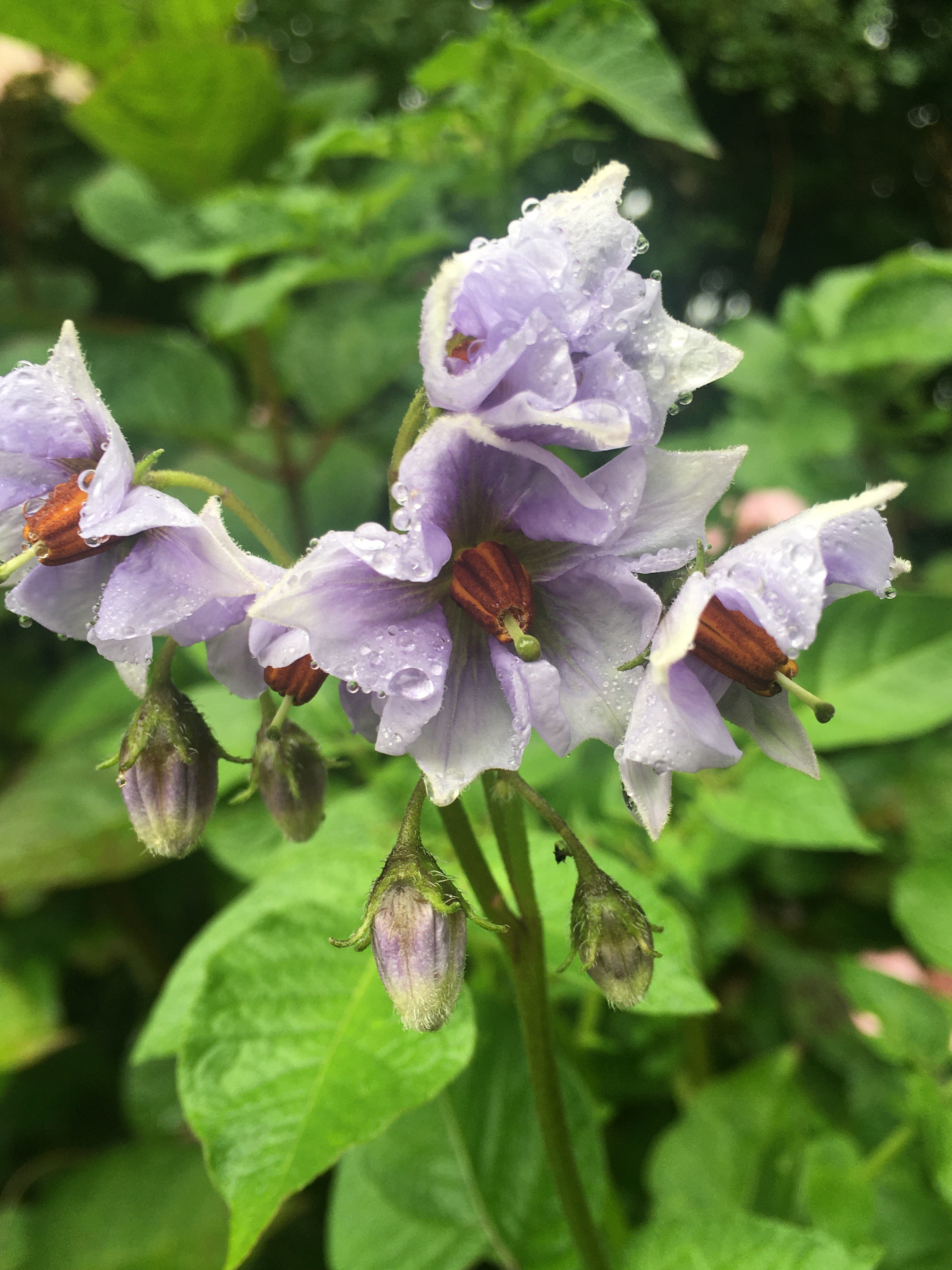
Over on the veg plot, I found these flowers this week. They are potato flowers from the Shetland Black tubers growing in compost sacks. Aren’t they beautiful. You can tell the potatoes are part of the deadly nightshade family. I’ve never grown black potatoes before, so I’m eagerly awaiting the harvest.
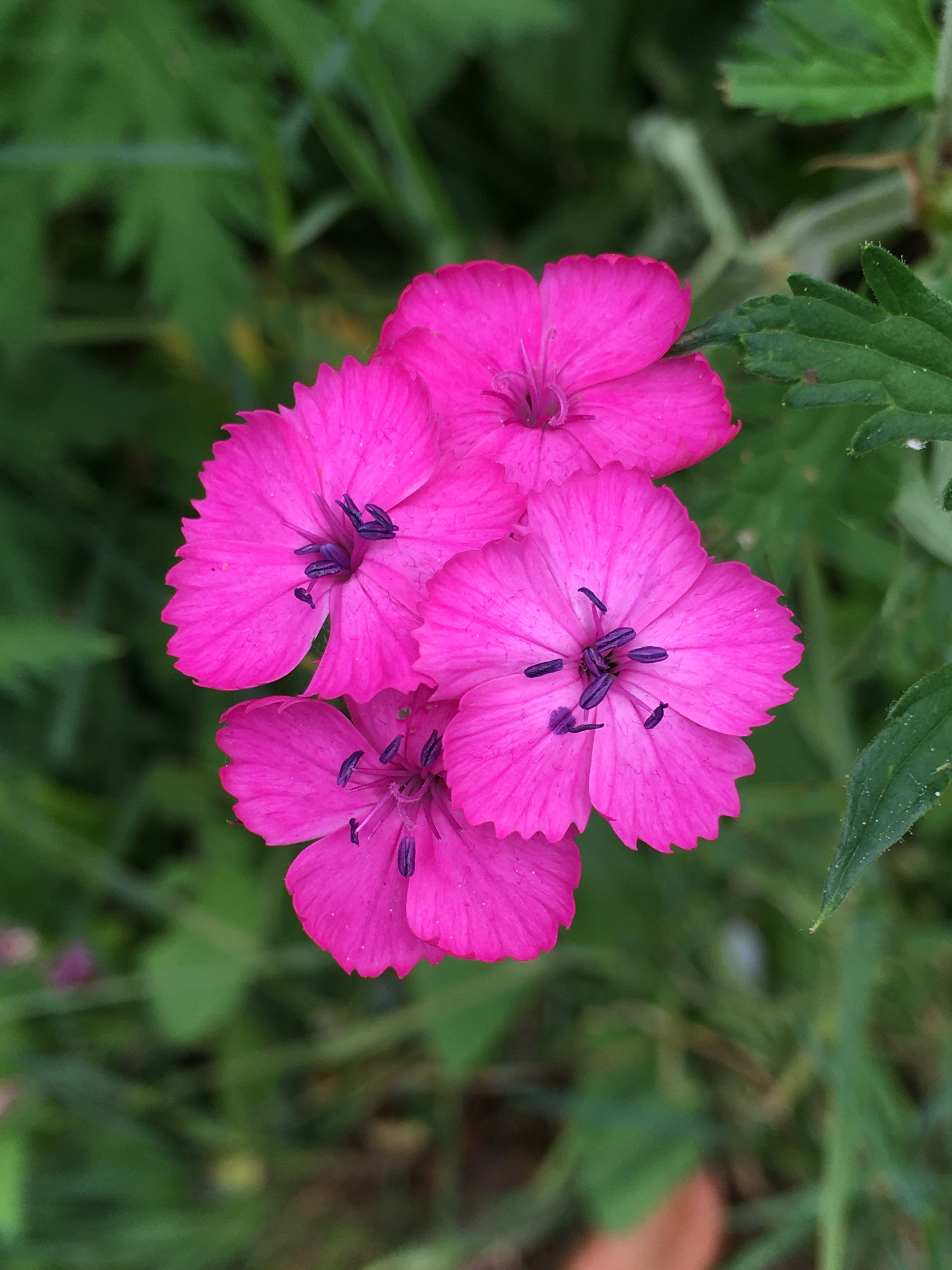
Dianthus cathusianorum. In the gravel edges on the front drive, these bright pink flowers wave about on 50cm stems. They must love the free-draining conditions. We have to remember to drive around them. The scent is wonderful. Spicy. Heady. Memorable.

And finally, sweet peas. These are from a range called ‘Ripple Mixed.’ I’ve grown Wiltshire Ripple for many years, but the mixed pink and purple- striped flowers are fast becoming new favourites. Highly scented. Nice long stems. Long lasting in a vase. Recommended.
That’s my six for today. What’s looking good in your garden this weekend?
Why not go over to the propagator’s blog and see what everyone is selecting for their six today. It’s fascinating to see what everyone is growing, all around the world.
Links: https://thepropagatorblog.wordpress.com/category/six-on-saturday/
Phacelia :https://www.chilternseeds.co.uk/item_977A_phacelia_tanacetifolia
Geranium: https://www.naturescape.co.uk/product/meadow-cranesbill-plugs/
Shetland Black potatoes :https://marshallsgarden.com/products/shetland-black-seed-potatoes-10506756
Dianthus: https://www.claireaustin-hardyplants.co.uk/products/dianthus-carthusianorum-ruperts-pink
Sweet peas: https://www.mr-fothergills.co.uk/Flower-Seed/Tall_3/Sweet-Pea-Ripple-Mixed-Seeds.html#.XwowbBB4WfA
https://bramblegarden.com/2020/04/02/the-secret-lives-of-garden-bees-book-review/http://addictedtobees.com/. Jean Vernon
Don’t forget to read the next blog down, all about Niwaki garden tools. There’s some Niwaki garden snips to win.
Niwaki tools review – and some garden snips to give away

I don’t use chemicals in my garden. Some weeds are allowed to thrive, if they are useful to insects and pollinators. Dandelions are particularly good for bees, especially in early spring when pollen is scarce. There are some types of solitary bee that only feed on dandelions. I wouldn’t want to deprive them of their vital sustenance. But, I don’t want a lawn predominantly covered in dandelions. It’s all about striking a balance, so I start to thin them out in mid-summer. Niwaki sent a Hori Hori knife for a trial and It’s perfect for deep-rooted weeds such as dandelions. I was using a trowel before, which often didn’t get to the bottom of the tap root, and was hard work over a large area. The Hori Hori is sharp enough to easily slice through grass, and strong enough to gently lever weeds out of the soft wet ground. I notice, on the website, it says the knife is: “Mighty, but not invincible. It’s best not to stick it in heavy clay and yank back hard.”

When I’ve removed the dandelions, plantains and thistles, I pop a Seedball into the hole that’s left. Seedballs are wildflower seeds encased in clay. They can simply be scattered around the garden. They come in selections named bee, butterfly, poppy, urban, bat, bird and beetle. Hopefully, in time, I’ll end up with a flowering lawn, full of cowslips, self heal, wild marjoram and primroses. I’m aiming for a tapestry carpet effect.

The Hori Hori has a strong canvas holster which I think could be attached to a belt. The hand-forged carbon steel blade runs right through the handle, for strength. Tough and strong, it seems built to last. The handle is FSC beech wood and the blade is 7″ 17cm long.

As well as digging up weeds in the lawn, my knife is great for removing weeds from between paving slabs. I also spent a happy hour digging up ‘free’ plants which had self-seeded in the gravel. I found bellis daisies, perennial geraniums, sedums, erigeron daisies and several seedling trees- silver birch, maple and mountain ash. Much easier to lever them out with a sharp blade than using a trowel.

Bellis daisies seed readily around and make lovely bedding plants for borders and plant pots. Free plants are always welcome here.

Here’s a seedling mountain ash rescued from the gravel path. Beautiful spring flowers for bees, and autumn berries for birds. Great for any wildlife garden.

Erigeron karvinskianus also seeds readily between paving and in gravel. Another ‘free plant,’ dug up and transplanted into a 9cm pot.
My Hori Hori has quickly become a tool I reach for whatever task I’m doing, planting, weeding, slashing bramble roots. It’s comfortable to use and makes life much easier. And that’s what gardening is all about for me, managing the weeds, not totally obliterating them, just tipping the balance, and keeping me in charge, rather than always rushing around desperately trying to keep up.


I’ve asked the team at Niwaki to offer a reader prize. They have currently sold out of Hori Hori knives, probably due to the upsurge of interest in gardening over the covid period. So they are offering some forged garden snips instead. Keep an eye on the blog, and when they send me another item to try, the Hori Hori will probably be back in stock for a prize at a later date.
Meanwhile, to enter for the garden snips, just leave a comment in the box below and Niwaki will randomly select a name. Usual rules apply. Niwaki’s decision is final and there’s no cash alternative.
A winner will be announced on Monday. Please check back. Thank you.
Do you have any favourite garden tools. Nearly all of mine belonged to my grandfather Ted Foulds. And some belonged to his father, so they date back to the 1930s. They have certainly stood the test of time, and I wouldn’t be without them.
Links : Niwaki https://www.niwaki.com/store/hori-hori/
Seedball : https://seedball.co.uk/product/bee-matchbox/
I write for Garden News Magazine: https://www.gardennewsmagazine.co.uk/minimag
Six on Saturday- Peachy Shades- July 4th 2020.

We are not going to the Caribbean this year. Or any year, I should imagine. I’m frankly not planning to go further than the the next village. However, I can bring a bit of sunshine into the garden with my planting. This nasturtium is a seedling from a range called Caribbean Crush. It has predominately pink, apricot and peachy shades. A lovely change from the usual bright orange and yellows. This plant is an overwintered seedling, so it flowered early. It hid away in a raised bed of brassicas in the unheated poly tunnel. It’s been wonderful to have one or two flowers all winter. Leaves and flowers are edible and add a peppery taste to salads. And a few stems in a jam jar make a pretty posy for the kitchen table. If I save seeds from this plant, the offspring will be variable. But, I want to keep this particular unusual pale peach colour. So I’ll take shoot cuttings and put them into jars of water to root. Shot glasses are the ideal size. I take cuttings about 9cm (3.5″) long from the tips of healthy plants. I’ll carefully cut off all but four small leaves so the cutting doesn’t lose too much moisture. The glasses are placed under the staging in the greenhouse, out of direct sun, but in a warm and sheltered place. A north-facing window indoors would also be fine. Cuttings will root within two to three weeks and then I’ll put each cutting in a 9cm pot in gritty compost. I use peat-free compost with a handful of grit to improve drainage. When roots emerge from the bottom of the pot, I’ll plant them outdoors – and some will be put into a large terracotta pot to be kept frost- free over the winter. This ‘rooting in water’ technique can also be used for salvias, mint, and all types of impatiens. A good way to preserve special varieties and an insurance policy against winter losses.
Here’s a link for Tropaeolum majus Caribbean Crush : https://www.plantsofdistinction.co.uk/edible-flowers/edible-flowers/nasturtium-caribbean-crush-1947a
Looking around, here’s some more plants in lovely shades of peach and apricot. Enjoy this week’s tour of the garden.
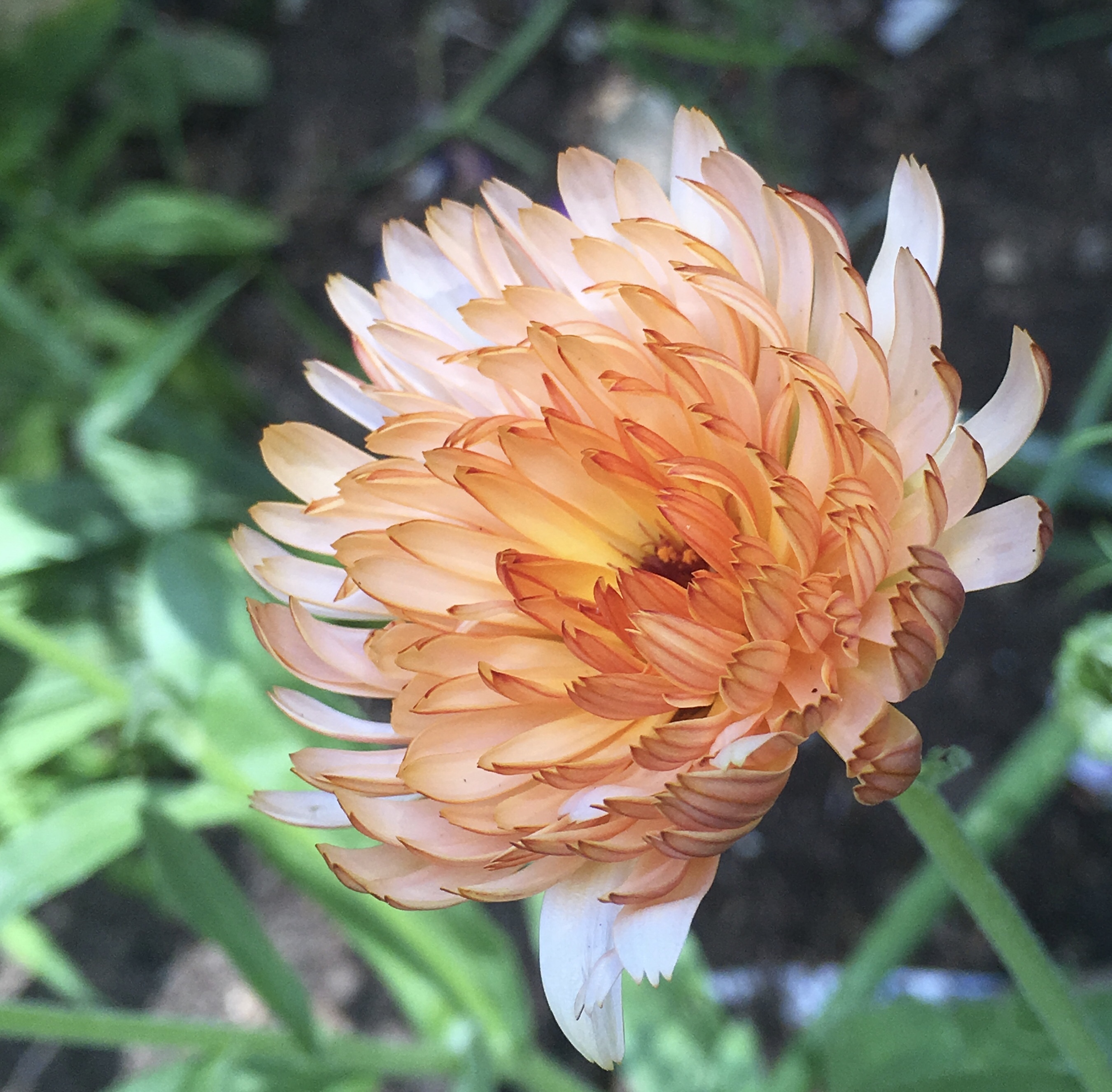
Pot marigold, Calendula Sunset Buff. Petals look like they have been cut with pinking shears. There are pretty striped markings on the back of the petals too.
https://www.mr-fothergills.co.uk/Flower-Seed/Calendula-Seed/CALENDULA-Sunset-Buff.html#.XwDgKBB4WfA
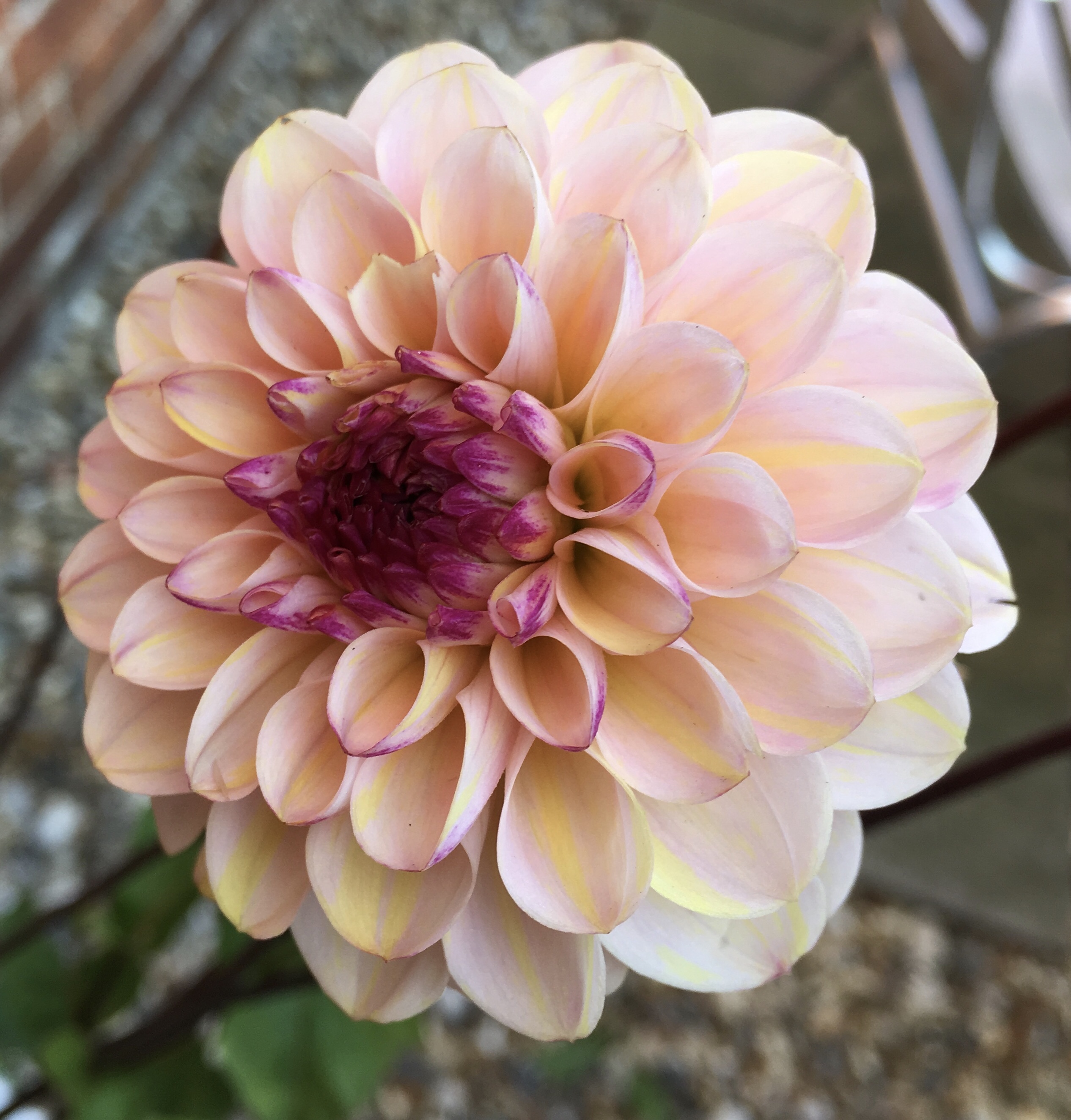
Unknown dahlia – purchased from East Ruston Old Vicarage. A lovely memory of a Norfolk holiday. Maybe someone reading this will know what it is called.
Update: Chloris from The Blooming Garden (see comments) confirms the dahlia is Wine Eyed Jill. I shall duly label it, and take cuttings next spring to increase my stock. It is such a gorgeous colour. Thank you Chloris.
https://www.peternyssen.com/dahlia-wine-eyed-jill.html
http://www.e-ruston-oldvicaragegardens.co.uk/pages/view/564/home.htm
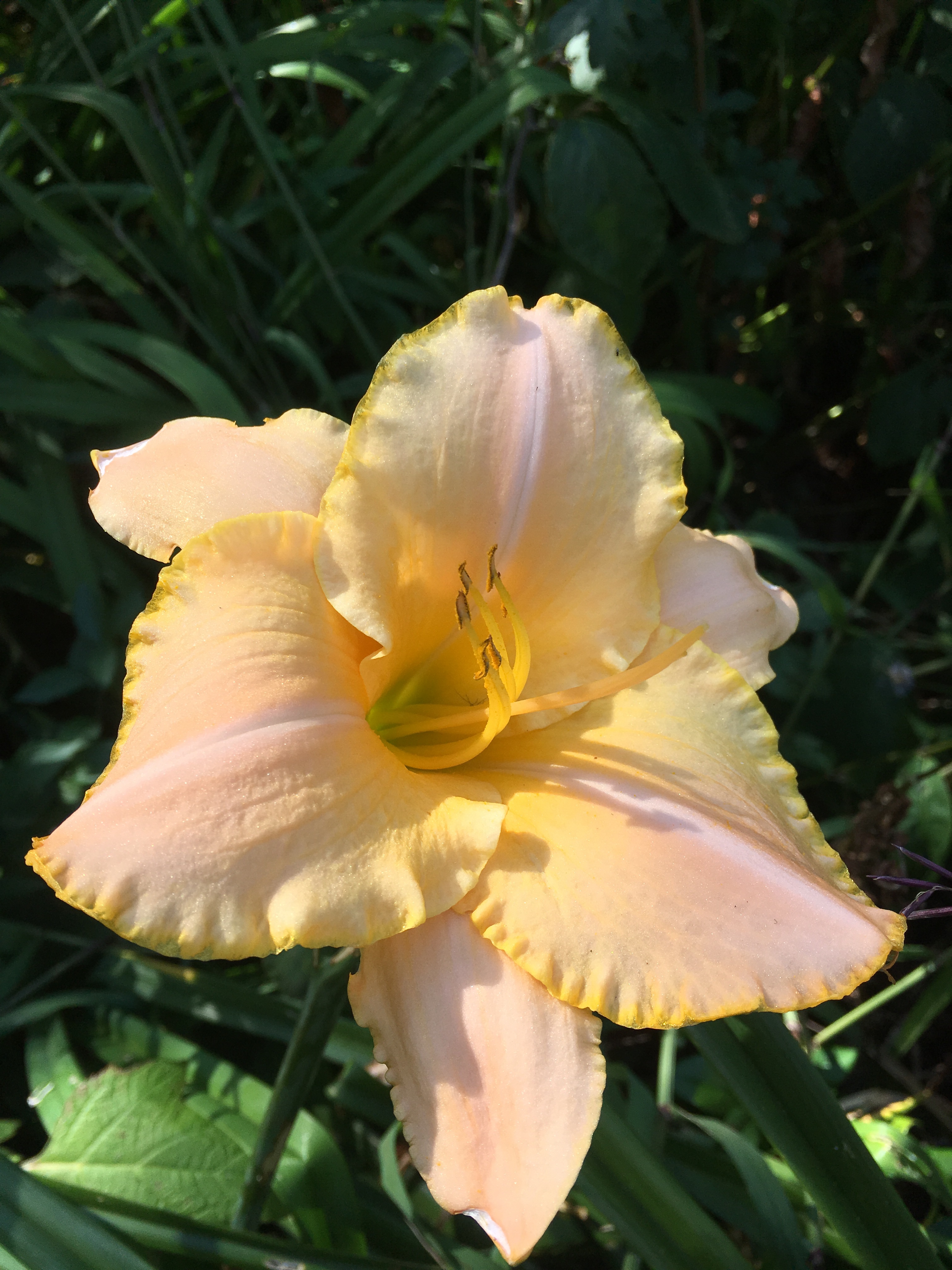
Seedlings from Pollie’s Daylillies. Pollie Maasz has been growing daylilies at her nursery in the New Forest, Hampshire, for almost 20 years. She has 1500 cultivars and breeds new hybrids, specialising in unusual and spider forms.
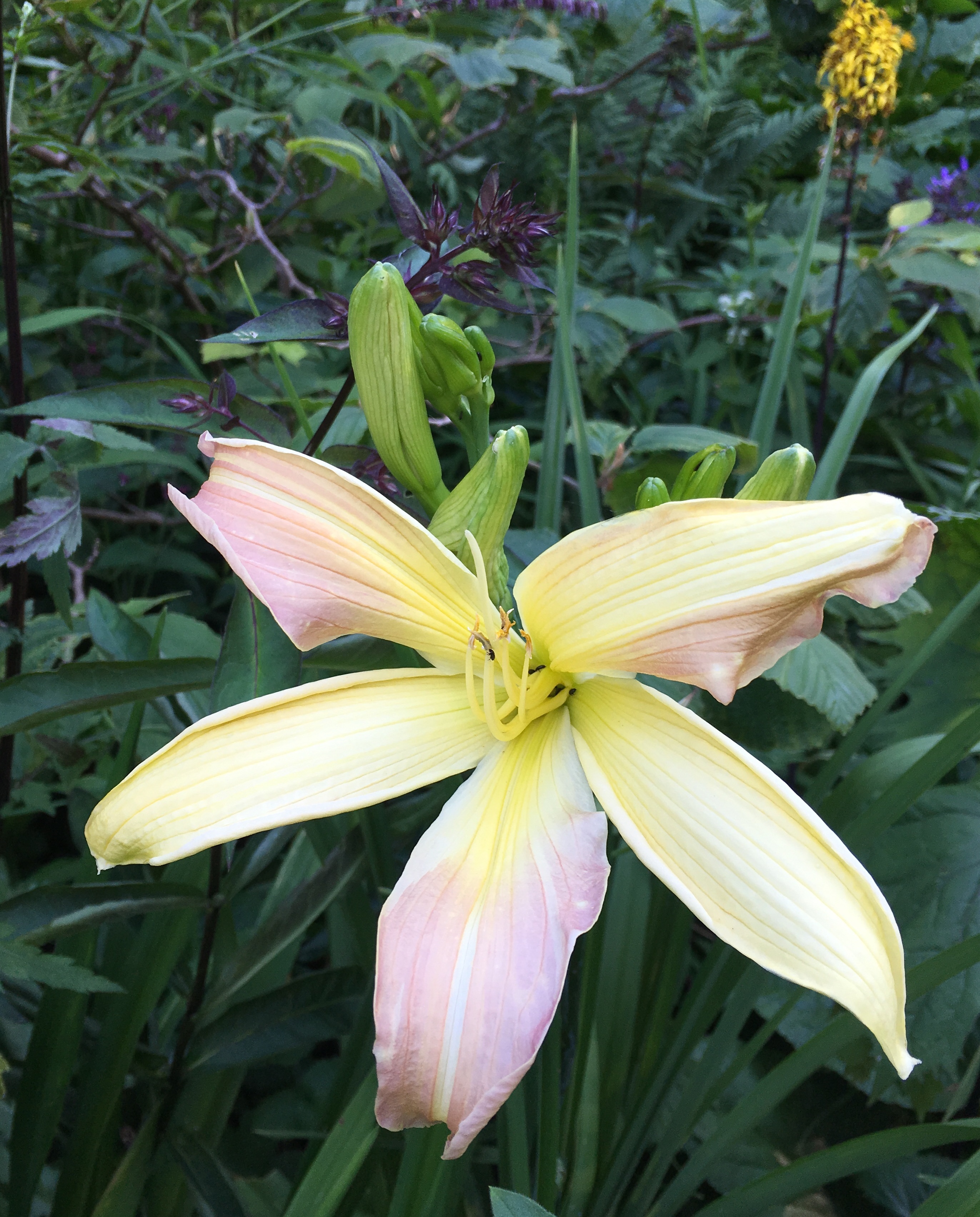
The spider daylilies have a more open flower than the usual trumpet-types, and petals twist and turn. Very eye-catching. They seem to dance about in the breeze. They are my favourites.
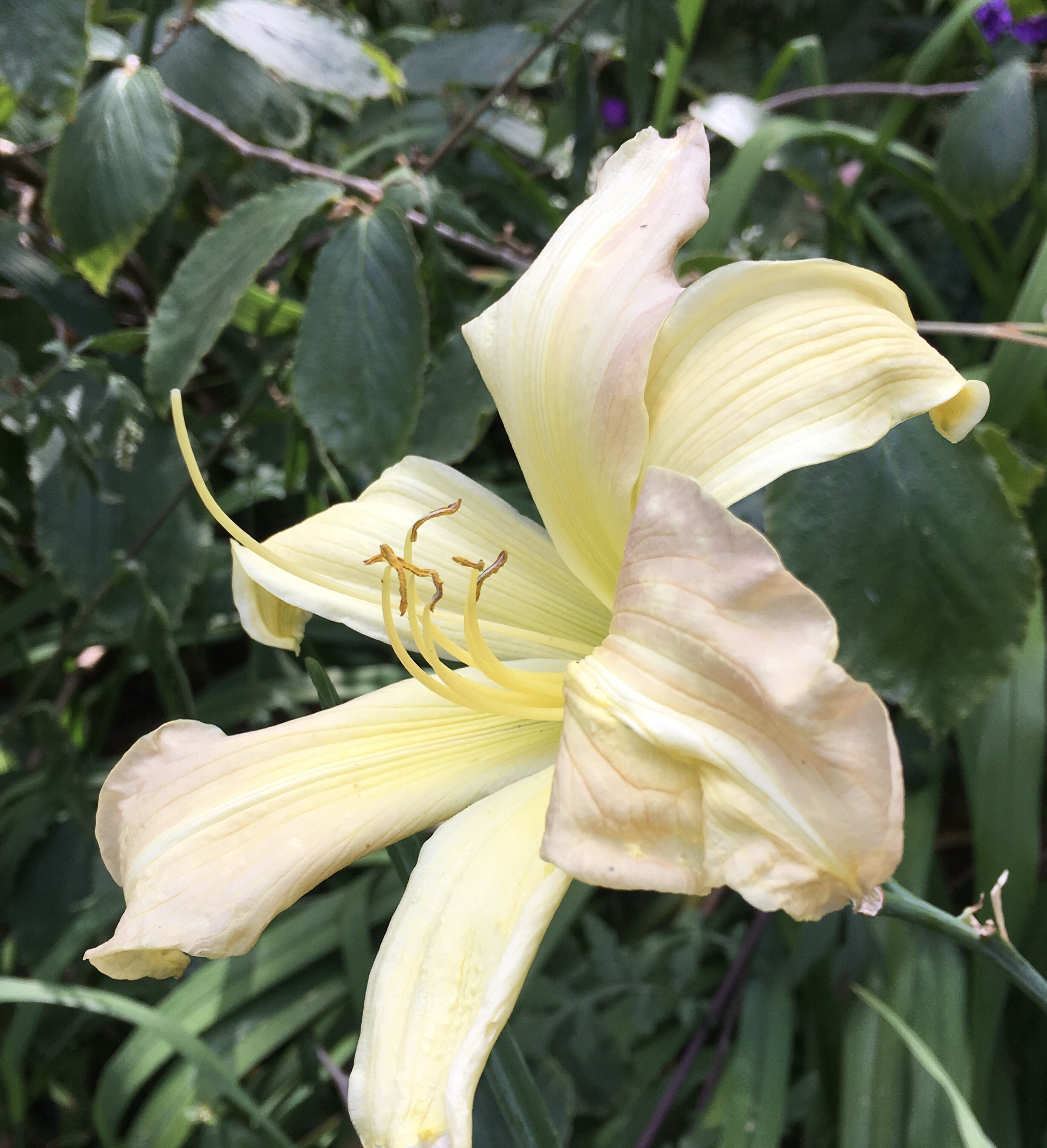
You can buy new un-named seedlings which produce some exciting and unusual flowers. It’s like a lucky dip! And as a bonus, you can name them yourselves.
https://www.polliesdaylilies.co.uk/
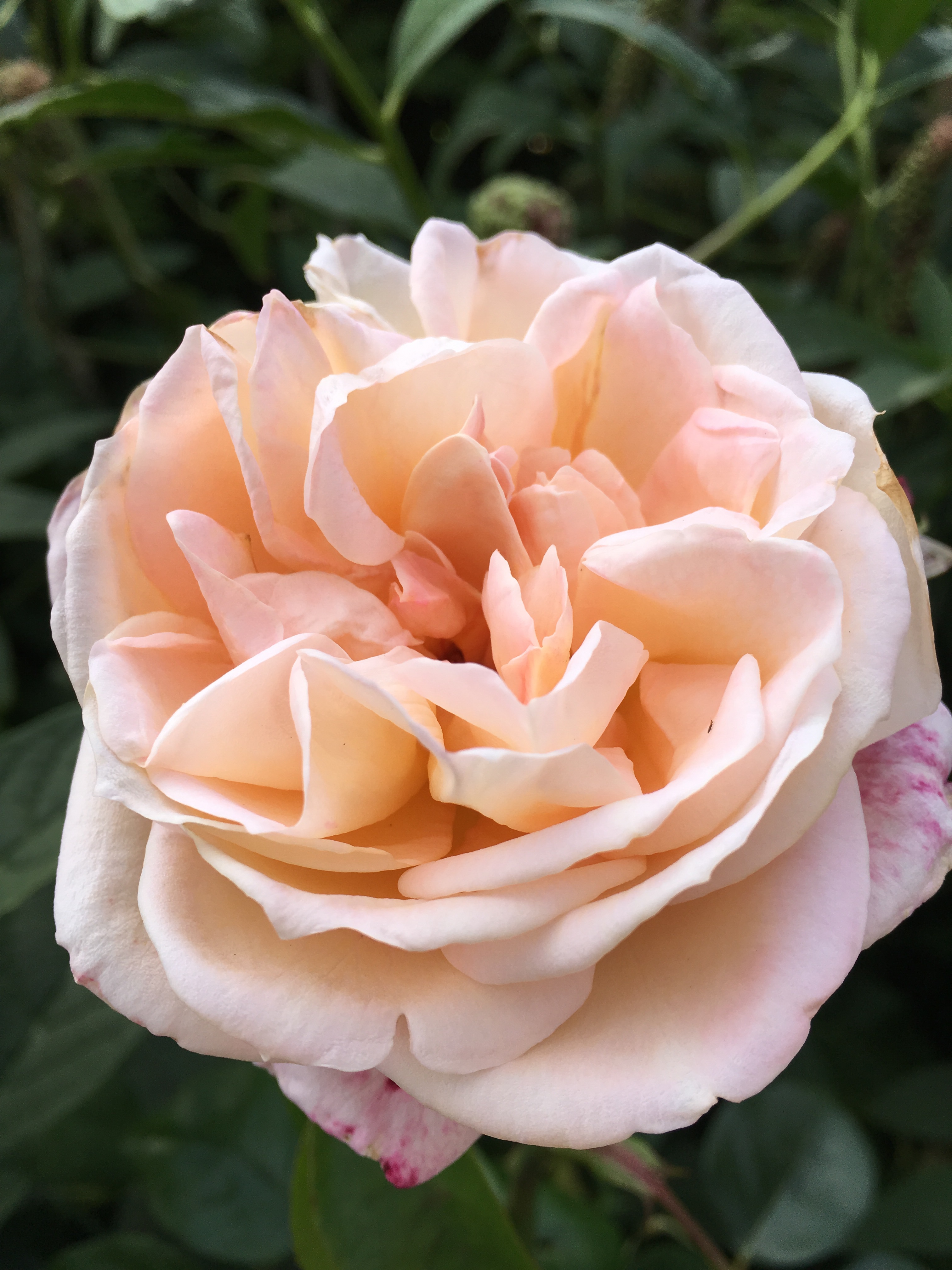
I’ve forgotten the name of this rose. My new year’s resolution is to improve the labelling system in the garden. I’m terrible for planting something and forgetting to label it properly. Very frustrating when friends come to visit and want to know what something is called. Perhaps someone reading this will know the name.
It’s either from David Austin or Peter Beales Roses.
Update: Peter Beales have helped me out and found the name. It’s the beautifully-scented climbing rose, Gloire de Dijon. Very free flowering in June and repeat flowers in late summer. Grows 12′ x 8′ ( 3.6m x 2.4m) has large, tea-scented flowers, and by the time I’d written this, I’d also found the label in the potting shed. I really must get some nice labels to hang on the shrubs. White plastic ones never look good. Maybe you could recommend something? I’d welcome any suggestions.
https://www.classicroses.co.uk/gloire-de-dijon-climbing-rose.html
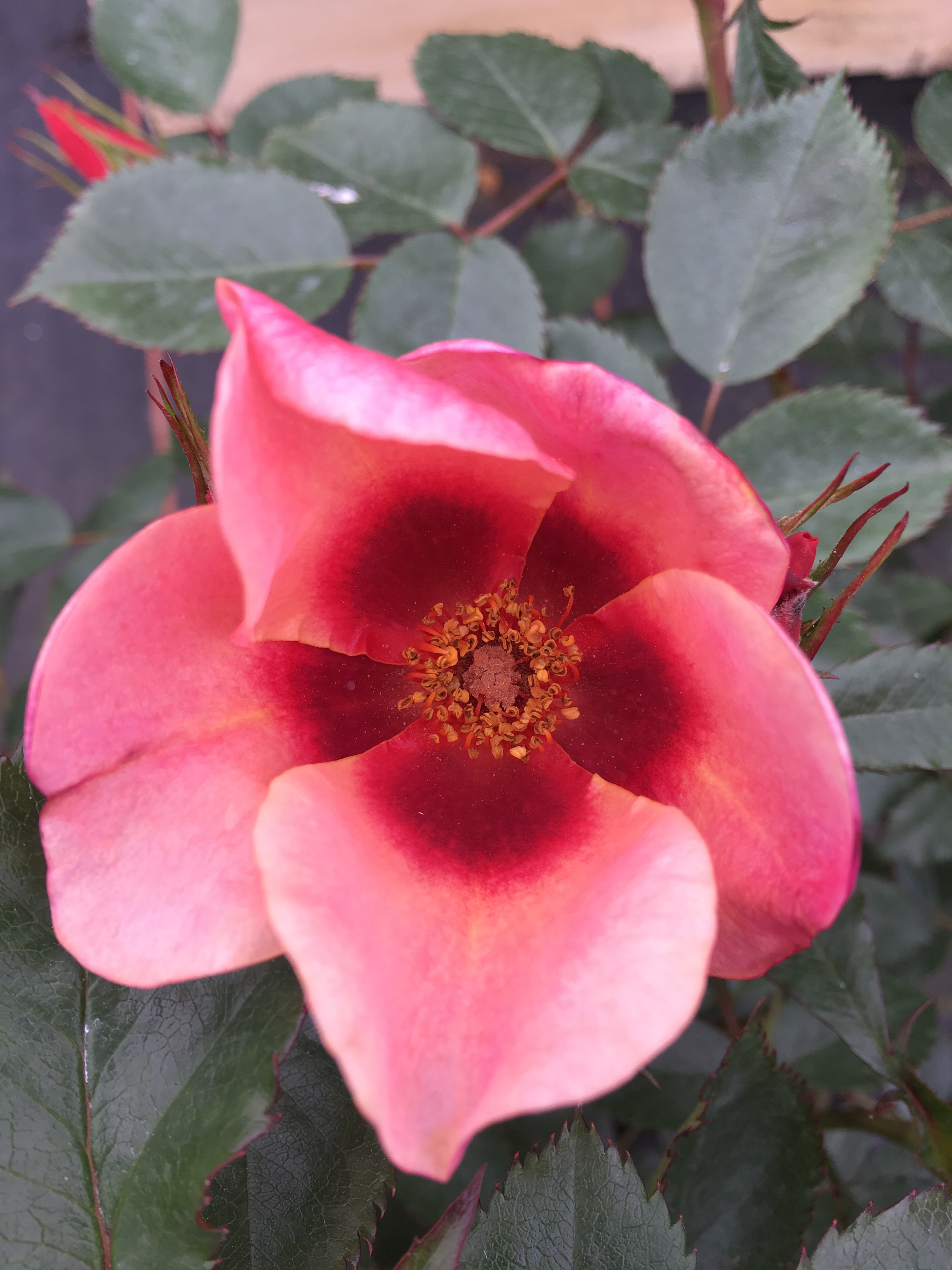
But I do know this rose. It’s new. For Your Eyes Only. Repeat flowers all summer. Disease resistant and good for pollinators. Lovely in a bouquet. Lasts well as a cut flower.
https://www.classicroses.co.uk/for-your-eyes-only-bush-rose.html
Well, I hope you’ve enjoyed my peach selection this week. What’s looking colourful in your garden at the moment? Have you got a favourite plant or favourite colour right now. Leave a comment at the bottom of the page and let me know.
Six (or more) on Saturday: https://thepropagatorblog.wordpress.com/2020/07/04/six-on-saturday-04-07-2020/
I am @kgimson on twitter and karengimson1 on instagram, should you feel like reading more. Thank you for reading this blog and getting in touch. Karen
Online Hand Tie Posy Course with Georgie Newbery

Flowers for my Mum.
Finally, after four months, I can take flowers to my Mum. It’s been the hardest part of Covid, being separated from our families. It’s the first time in my life, I haven’t had her by my side. She’s usually there in everything I do, supporting me, encouraging me, passing on her knowledge. My setbacks and sorrows are hers. My successes and triumphs are hers. We are linked by invisible ties. If I stumble she is there to catch me. We are a team.
And we share a love of flowers. Mum has always helped me in the garden, bringing seedlings, divisions and cuttings from her plot. I grow them on, and take them back to her in simple bunches of flowers each week. It’s something I have really missed these past few months.
Luckily restrictions are easing and we can meet up again in the garden. And my little bunches of flowers are going with me.
And to add to my joy, I was invited to take part in a zoom lesson by flower farmer Georgie Newbery -just in time to make my first flower posy for mum.

I sat in my summerhouse with my i-pad on my knee- and just for an hour, forgot all about the desperate worries of the last few months. I’m sure I’m not alone in having fears for frail elderly relatives – and for youngsters. My youngest daughter is a newly qualified nurse, and my eldest works at a children’s hospice. No one is safe. The danger has been on my mind day and night. It’s been unrelenting worry. And yet, I’ve got through, concentrating on all the good people are doing- the inventiveness, finding ways to cope, the kindness.
Georgie is one such kind soul. I’m grateful for the invitation to join her first zoom session. She is launching online courses this summer, and asked me to be on a trial panel for the first lesson. I can’t tell you how excited I was to have something to put on my calendar, something to look forward to. It meant a lot.

Georgie, who runs Common Farm in Somerset, started the course by talking about the flowers chosen for the day’s arrangement. There’s the most sumptuous coral – pink Boscobel rose partnered with pink penstemon and a pretty mixed ‘ripple’ sweet pea. Purple fennel was added for scent. I could almost smell them from here! A dark chocolate-coloured Physocarpus Diabolo provided complementary foliage.
Georgie gave tips on harvesting flowers. They are cut early in the morning and plunged straight into cold fresh water while still out in the field. Leaves are stripped as flowers are picked. That’s a tip I’ll use to save time in future. And there’s a bucket of fresh water alongside which Georgie uses to plunge her hands and arms into. Sap from plants such as Alchemilla mollis and Ammi majus can cause an allergic reaction. Washing them straight away helps prevent painful sores.
There’s a special way to hold the flowers between thumb and finger, and something called a ‘florists twist’ which essentially means adding stems at 45 degrees and making a quarter turn with each additional new stem. The result is a posy that has flowers all the way round. And with a bit of practice your creation will stand up on its own, with all the flowers spiralling out like a beautiful layered ball gown. Georgie describes it as being a bit like “Painting with flowers.”
And here’s what I made with my own cut flowers after one session with Georgie on zoom:

The posy was swiftly popped into a glass vase of water. But I was so pleased to see my creation passed the ‘stand-up-alone’ test. The first time I’ve managed to do this.

In my posy, I have Cosmos Apricot Lemonade, a new variety I’m trying this year. The colour is a delicate pale lemon, with purple shades on the back of the petals. A perfect partner to Verbena Bonariensis.

I’m using pot marigold Calendula Snow Princess, a new variety launched three years ago. It has delicate pale overlapping petals that look as if they have been cut with pinking shears. I love the tiny stars in the centre of the flower. Beautiful in bud and at all stages of flowering.

I’m growing calendula down the centre of my sweet pea ‘A-frame.’ This creates weed-suppressing ground cover, and encourages the flower stems to grow tall, making them more suitable for floristry. I’m also growing butterfly gladioli down the middle. I tried this last year and it worked well. It saves time as there’s no need to mess about with canes and bits of string. The frame keeps them upright. They all seem to work well with sweet peas. Cosmos grows at the front of the border, tied in to the hazel frame to stop them flopping over the path.

It’s a jumble of flowers and vegetables. Not posh, or tidy, but I love meandering around the little paths, weaving in and out of the herbs, flowers billowing out of the borders.

One bed is full of wild flowers. You don’t have to have a meadow to enjoy them. My bed is 3.5m long by 1.3m wide. There’s pink campion, oxeye daisies and quaking grass.

Oxeye daisies make a lovely addition to any flower arrangements. They are good for bees and butterflies too. I like to attract pollinators to the plot.

There’s blue Campanula poscharskyana, Phlox Blue Paradise, Nigella love-in-a-mist, and yellow Verbascum in my posy.


Tomorrow, I’m attempting a much larger posy with 30 stems. Georgie advises to take flowers straight from the bucket, and not set them out on a table in a row -which is how I’ve been doing it until now. I’ve always wondered why my flowers look flat on one side. It takes some practice, but the results are amazing.
My hour or so was packed with information on growing the best cut flower varieties, how to condition stems, what materials to use, how to create everything from kitchen table flowers, to ‘all of the garden’ huge bouquets. There’s a chance to ask questions, and Georgie provides a fact sheet to accompany courses.
Georgie has new online courses on 10th and 17th July. Here’s the link to the website for more information: https://www.commonfarmflowers.com/workshops.html.
David Austin Boscobel Rose: https://www.davidaustinroses.co.uk/boscobel
Calendula Snow Princess : https://www.mr-fothergills.co.uk/Flower-Seed/Calendula-Seed/Calendula-Snow-Princess-Seeds.html#.Xvz8kxB4WfA
Phlox Blue Paradise: https://www.claireaustin-hardyplants.co.uk/products/phlox-paniculata-blue-paradise
How are you finding ways to cope with Covid and social distancing? I’d love to know if gardening has been a saving for you, as it has for me. I don’t know what I would have done without my garden to keep me busy. Thanks for reading my blog.
Six on Saturday – my garden in June 2020
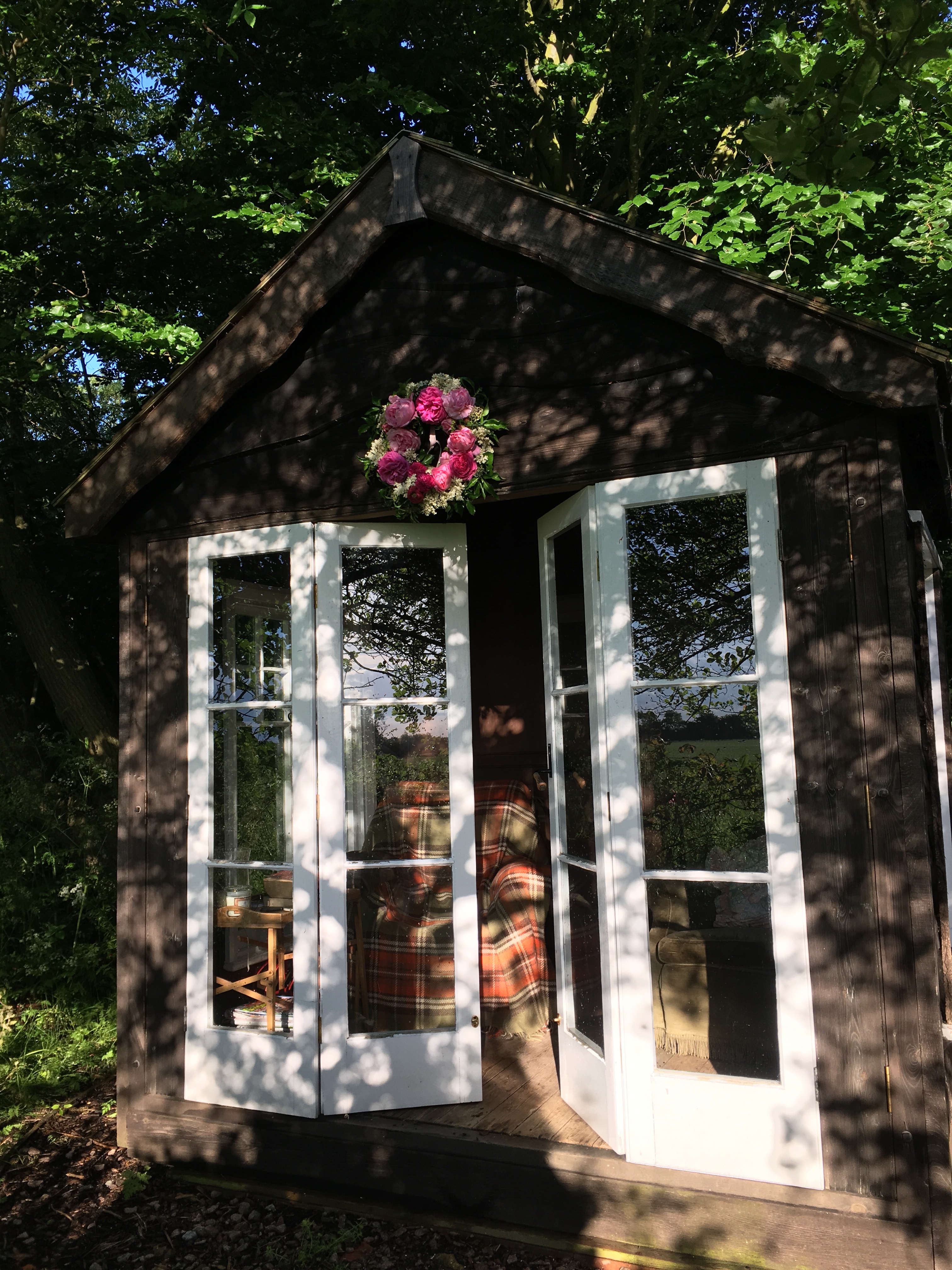
Peace and calm.
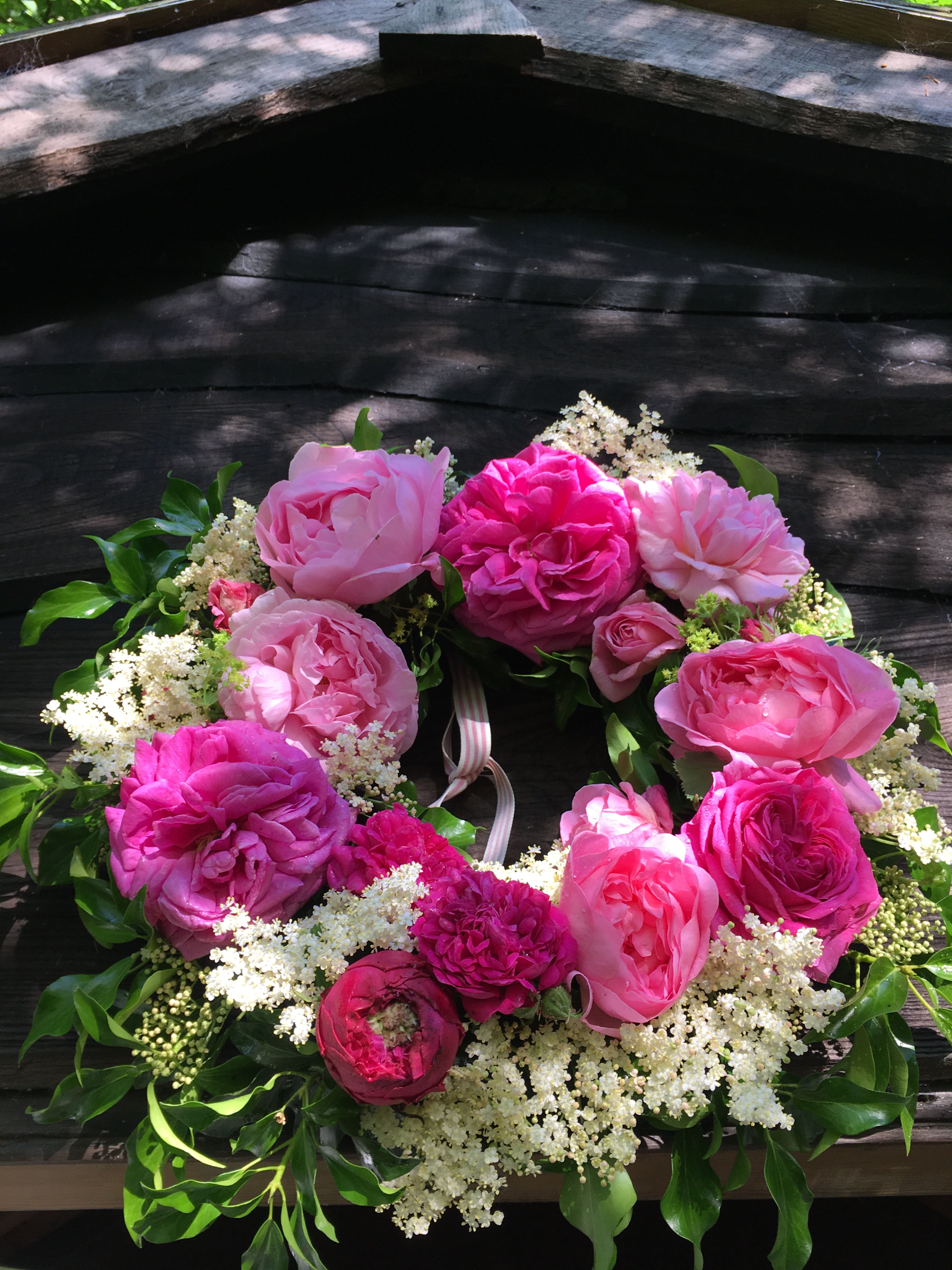
The scent! Roses from the garden, and elderflower. I’ve been making elderflower cordial. A taste of summer, for when days get shorter.
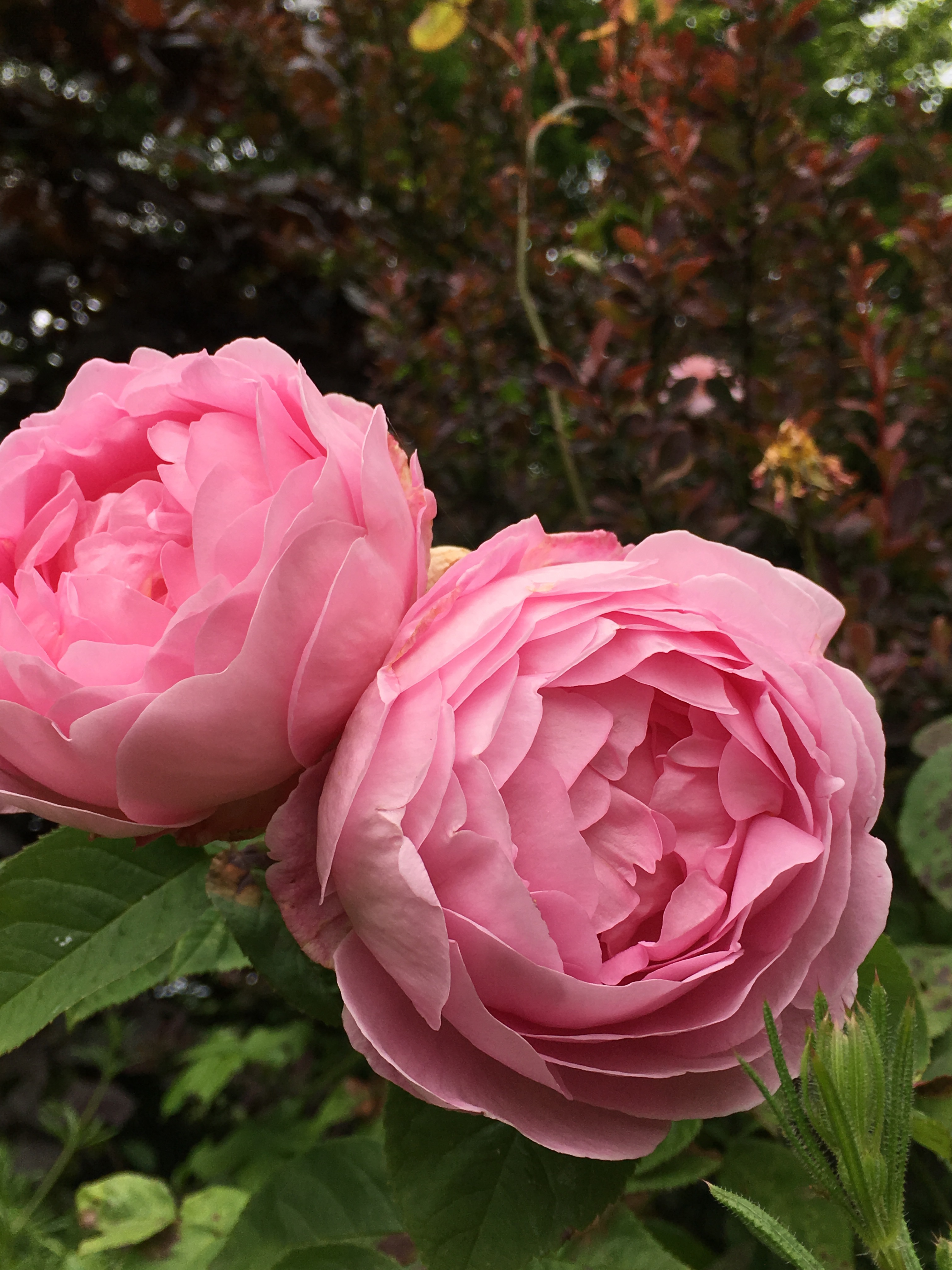
Constance Spry. Planted when our youngest daughter Rachel was born. It weathers any storm. Reliable and hardy.
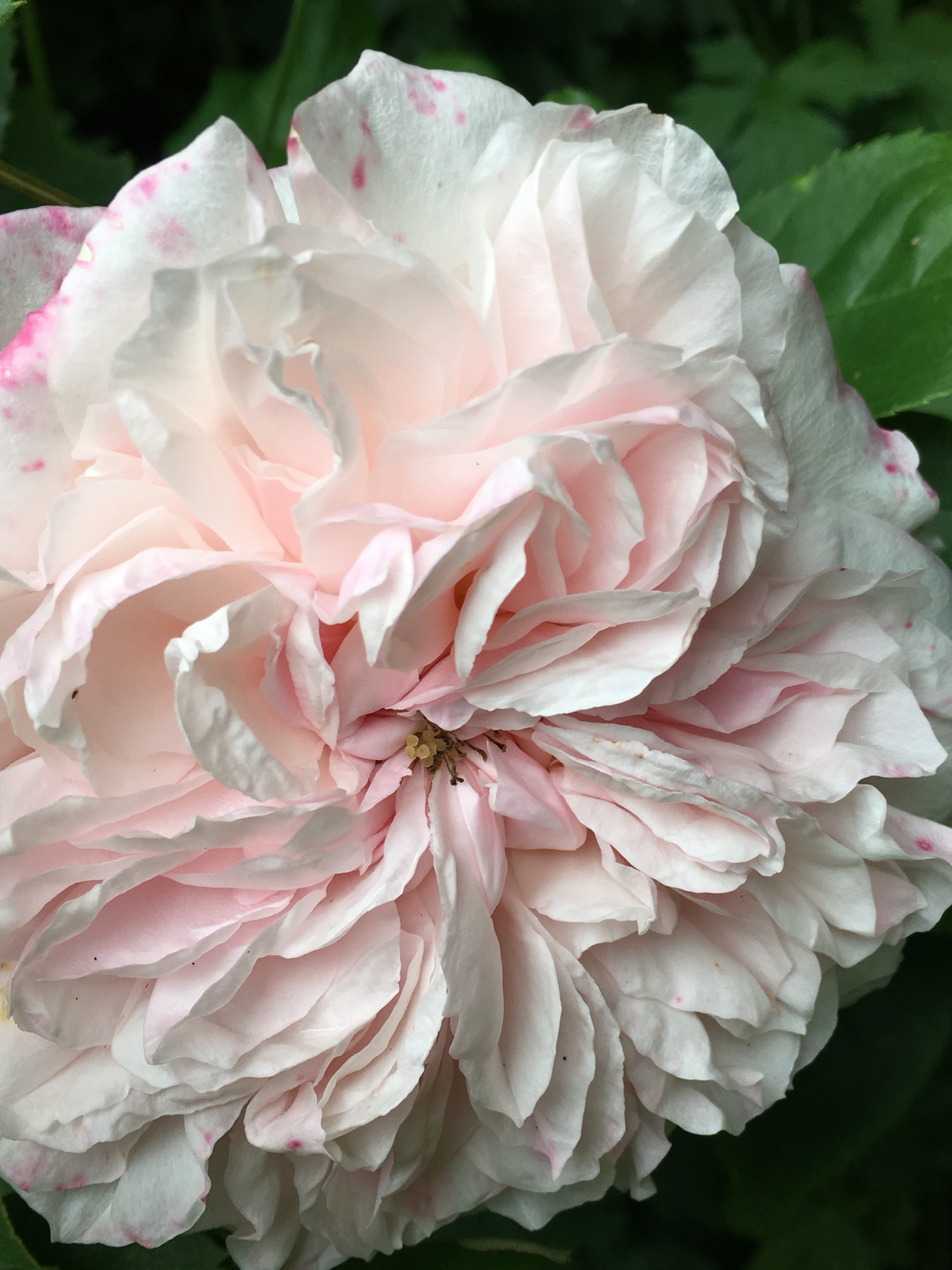
Rosa Claire, planted when our eldest daughter – also called Clare, without the i though- was born. Just beautiful. So many twists and turns and folds in the petals. Just like the patterns of life. Nothing in nature is ever a straight line. And there’s no direct journey to where you are heading.
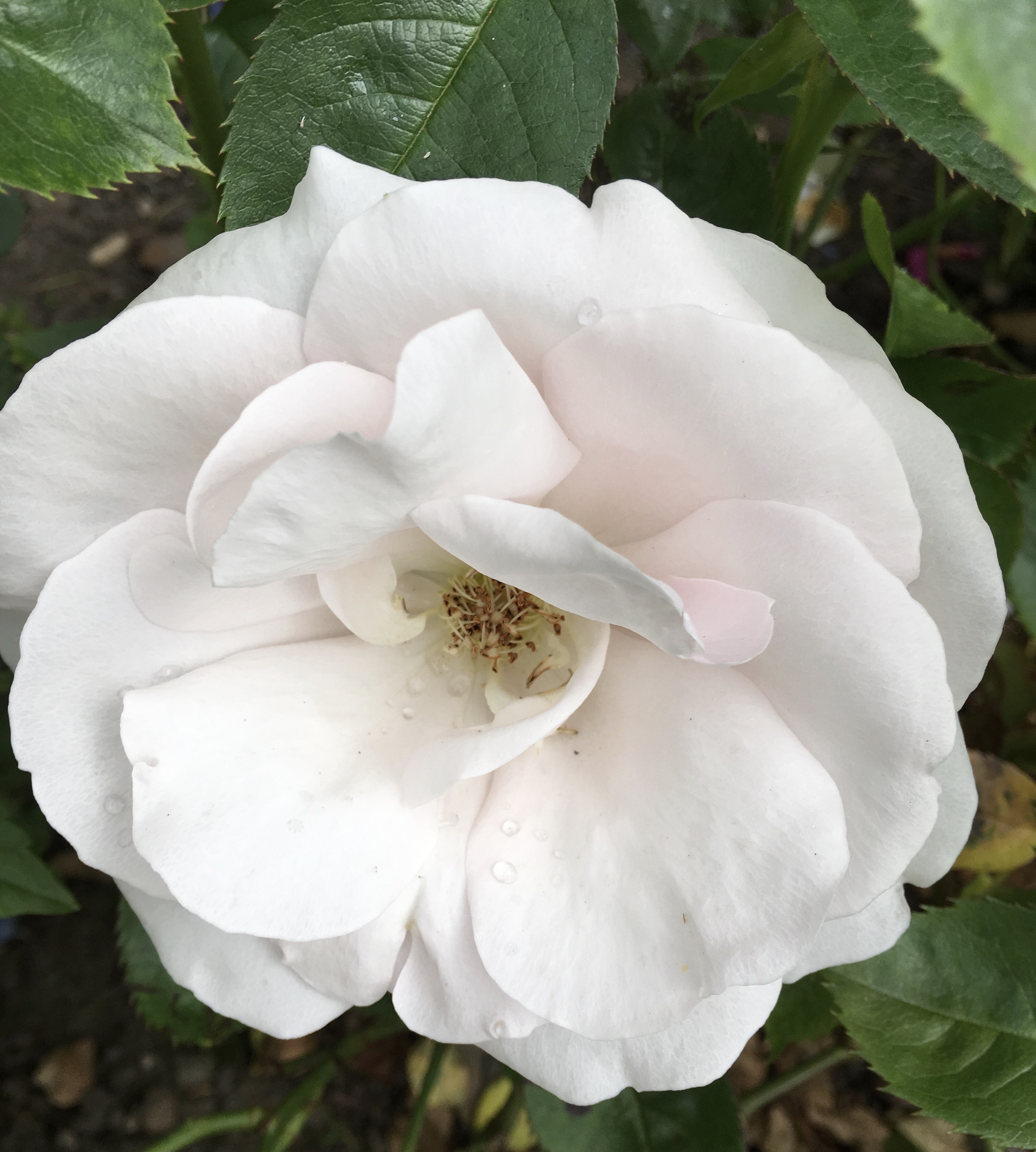
Rosa Many Happy Returns. A lovely, long- lasting memory of happy events.
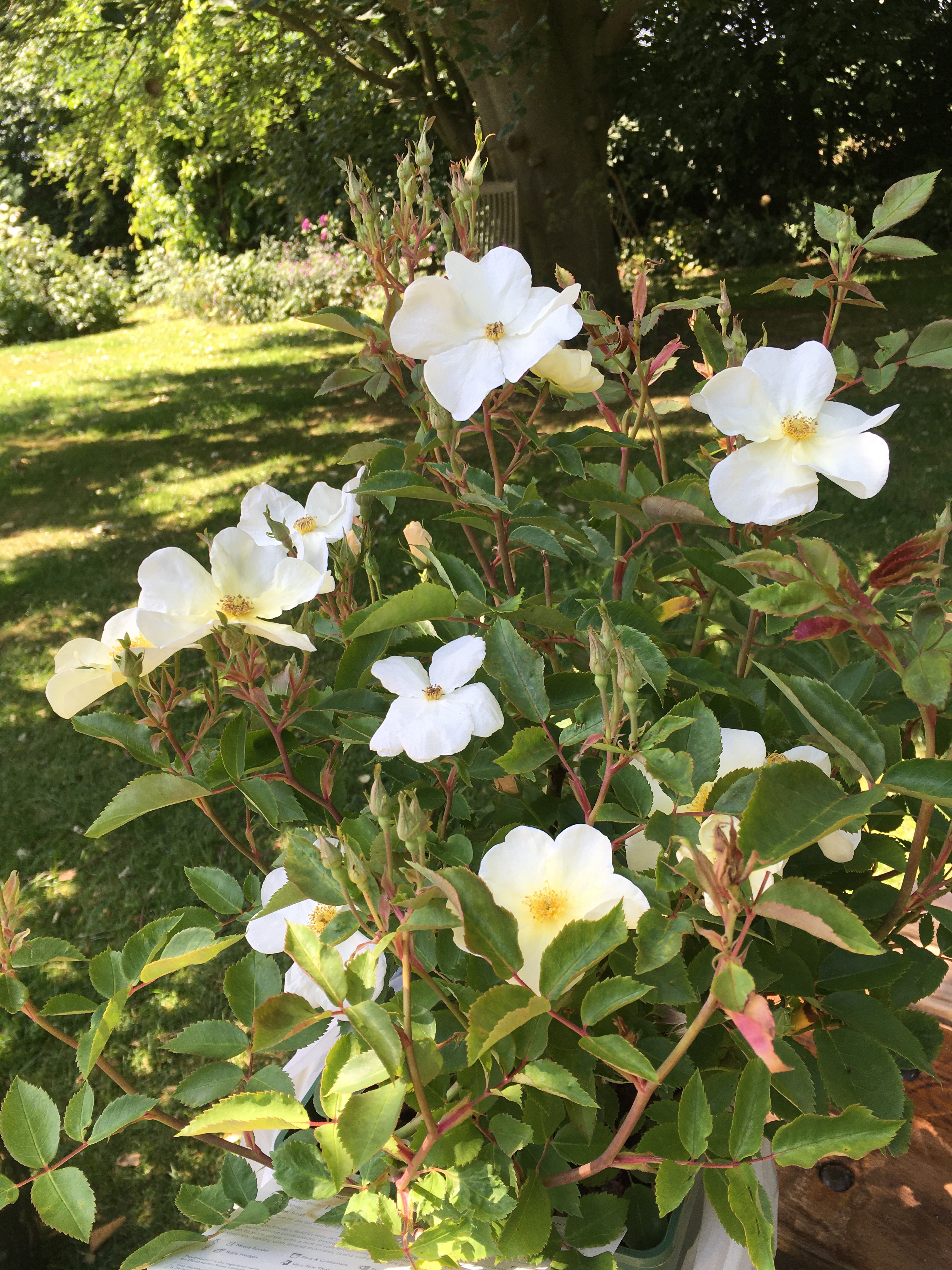
New rose. Kew Gardens. Sent to us by the team at David Austin to celebrate our wedding anniversary. A kind gesture after I posted this photo on twitter. I was amazed to see it viewed 74,000 times. We had so many lovely comments.

On our wedding day, I distinctly remember saying life might not always be a bed of roses. But we’d be ok if we worked together and helped each other.
Thank you for all your wonderful messages on here and on twitter. It literally made my day.

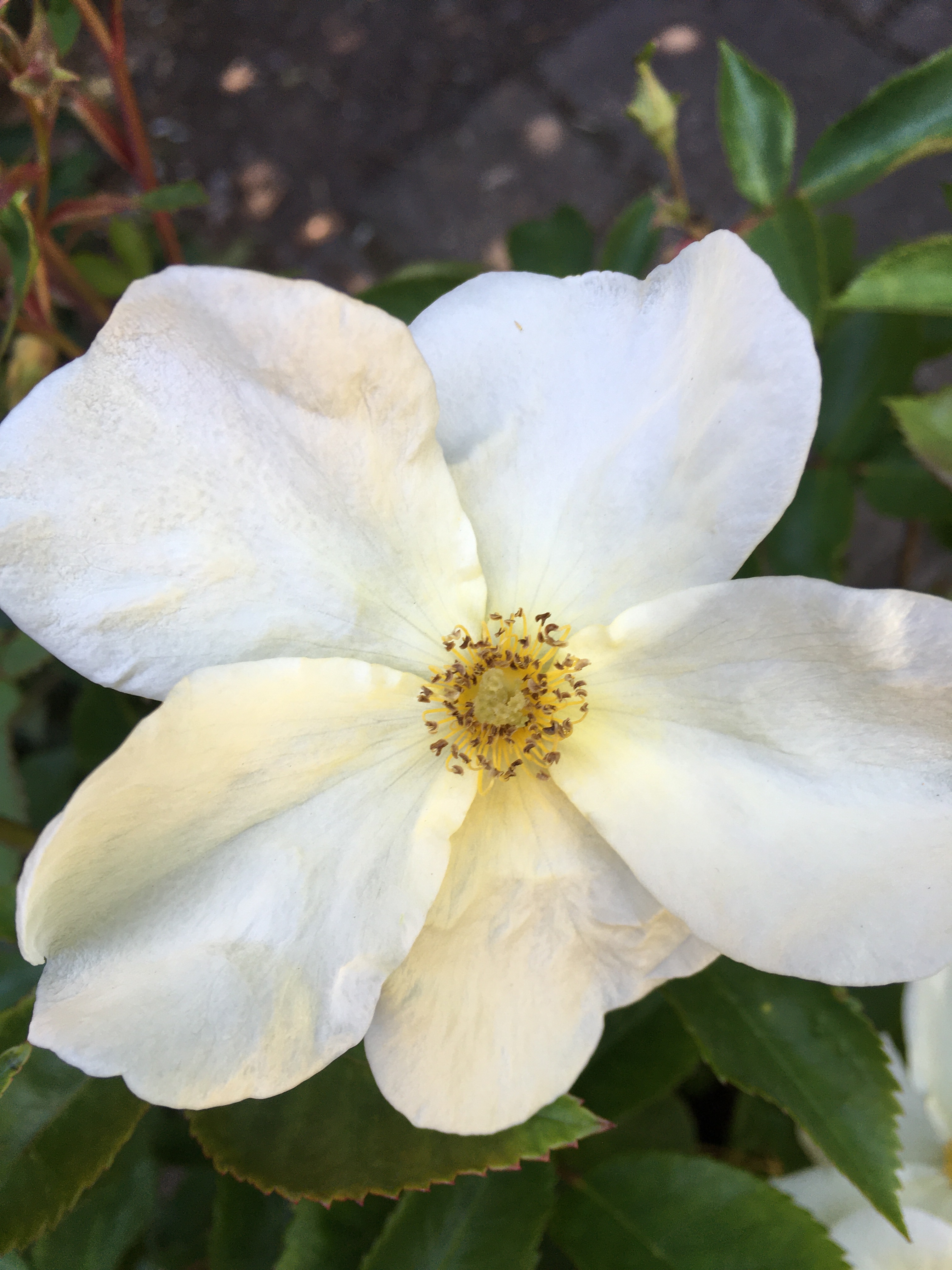

Links: SOS: https://thepropagatorblog.wordpress.com/category/six-on-saturday/
Kew Gardens rose : https://www.davidaustinroses.co.uk/kew-gardens
Rosa Claire https://www.rosesuk.com/roses/claire-rose
Hydrangeas Book Winner…..
Would SHIRLEY please get in touch. You left a comment on the blog for Naomi Slade’s new book Hydrangeas and you have won a copy. Many thanks for taking part in the prize draw. The publishers selected your name in a random draw. All the best, Karen at k.gimson@btinternet.com





Review here: https://bramblegarden.com/2020/06/05/hydrangeas-book-review-and-1-copy-to-give-away/
Winners of recent prize draws: https://bramblegarden.com/2020/06/12/winners-thank-you-for-entering-the-prize-draws-on-this-blog-here-are-the-recent-winners-names/
Thank you for reading and for leaving your comments. It’s much appreciated.
Winners! Thank you for entering the prize draws on this blog. Here are the recent winners’ names:
Hydrangeas by Naomi Slade.

Hydrangeas by Naomi Slade was won by Shirley . If she would kindly e mail me, I’ll ask the publishers to forward a copy of this gorgeous new book. k.gimson@btinternet.com.
Review : https://bramblegarden.com/2020/06/05/hydrangeas-book-review-and-1-copy-to-give-away/

Blagdon Pond-in-a-box : won by Jacksb50. Who was also sent some Blagdon pond clean pods to try out.
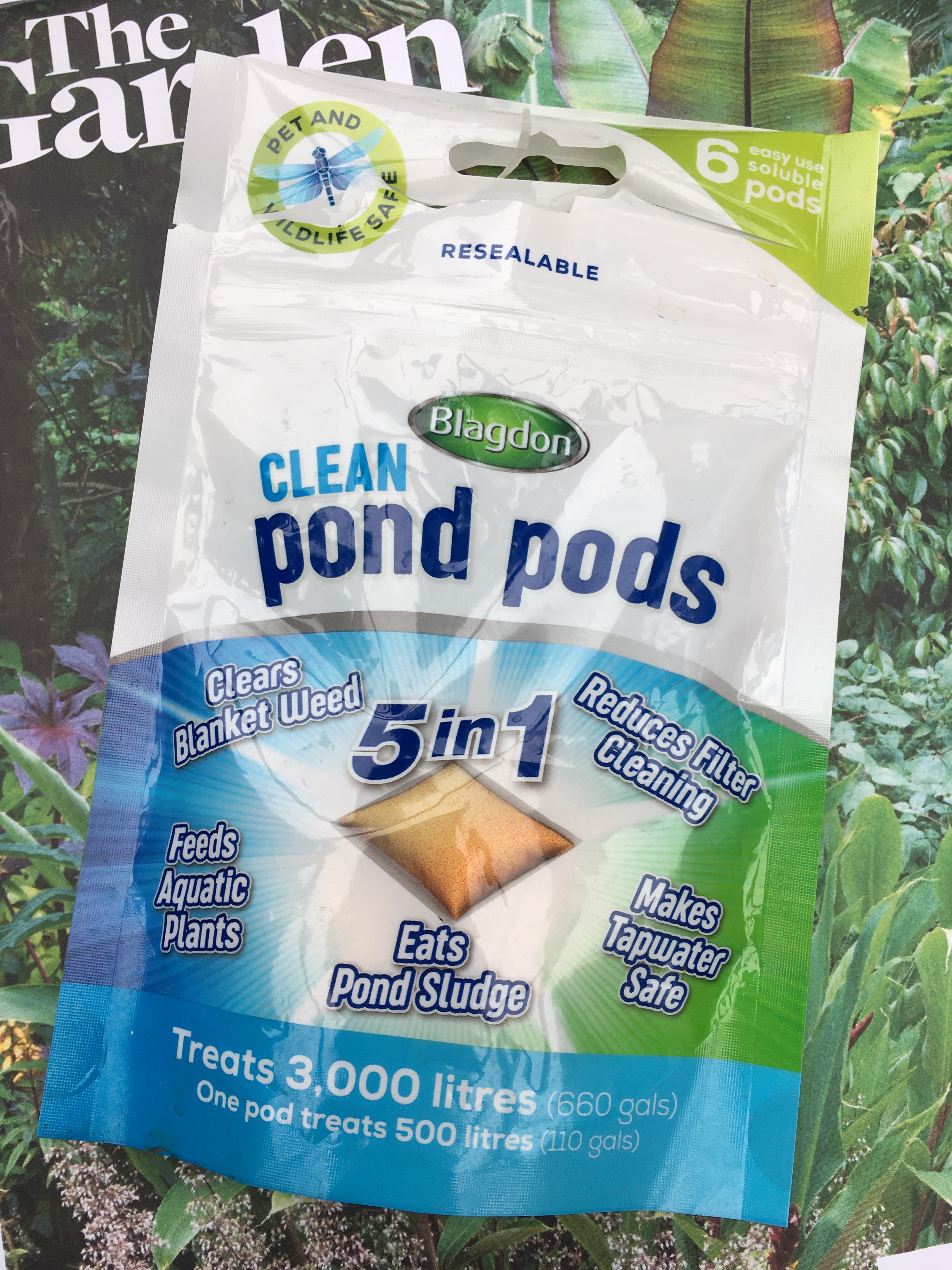
Review: https://bramblegarden.com/2020/05/07/blagdon-pond-in-a-box-review-and-prize-draw/

Corokia -My Adventrue by Mona Abboud. Won by Suella, who also won a bundle of new products including : Activearth sample.
https://bramblegarden.com/?s=Activearth

Hozelock Pure Bokashi composter was won by Lucy Corrander.


Hozelock Tuffhoze was won by Mary Thomas.
Review: https://bramblegarden.com/2019/12/05/hozelock-tuffhoze-on-test-at-bramble-garden/

Wildlife World Wildlife Observation Camera was won by Sean.
Review: https://bramblegarden.com/2020/03/17/wildlife-watching-camera-on-trial-and-prize-draw-for-readers/

Diary of A Modern Country Gardener by Tamsin Westhorpe, won by Cathy Lyon -Green
Review: https://bramblegarden.com/2020/02/22/diary-of-a-modern-country-gardener/
I’m very grateful to all the gardening suppliers and companies offering prizes for readers. I love trying new ideas. I’ll try anything, providing it is suitable for organic gardening and doesn’t harm any living creature. I never accept payment for trying the samples. I prefer to be free to give my honest opinion.
Thank you also for reading and for leaving comments. Look out for more gardening books on the horizon, a Hozelock liquid feed kit, some Japanese Niwaki garden secateurs and some new organic pest and weed control products. It’s interesting to see what’s available for gardeners in modern times. My grandfather would have been amazed by the wide choice of products. He would have loved trialling them as much as I do. Things certainly have changed since he gardened in the 1940s and 1950s. Many products make life a lot easier, all round.
Walk Around My Garden – Saturday 6 June 2020 #SixOnSaturday

This week, it’s mostly all about roses. As you would expect, wild roses have my heart. The garden is surrounded on two sides by tall hedges. We’ve never pruned them in 30 years. It’s one of those jobs we’ve always put off as being too big to tackle. Secretly, I love the wildness. Who says hedges have to be manicured. Who cares what people think. I love the tangle of honeysuckle and wild dog roses cascading from the top of 30 foot hawthorn. It’s a sight that gladdens my heart. I don’t mind if people assume we are too lazy to keep the hedgerow trimmed. I’ll hold my head up high. I’ve always been rather stubborn, you see. It can be a good thing when life gets tough. I’m quietly determined. I don’t make a big noise, but it’s amazing what can be achieved with calm tenacity.

Just pause for a moment and gaze at this pink hawthorn. This opens white, and fades to a beautiful shell pink. The hedgerows around here are mostly snowy-white Crataegus monogyna. Every now and again, there’s a pretty pink variant. It stops you in your tracks. You can’t fail to just stand and stare, it’s so breathtakingly lovely.

Rosa Canina takes full advantage and climbs high into the branches of trees and along the hedgerow. It’s a good year for flowers. Plenty of pollen for bees, and there will be masses of bright red hips providing winter food for birds.

Climbing through a mature willow next to the pond, there’s pale pink New Dawn. Again, I never prune this rose, or spray it. It just rambles where it likes. I expect the wind blowing through the tree keeps the rose disease-free. Blackspot tends to thrive in gardens where roses are surrounded by still air. In this windswept garden, luckily we have no trouble from either pests or diseases. It’s even too windy for aphids to get too plentiful. Those that survive, get eaten by birds.

We have a very overgrown pergola. The phrase ‘overgrown’ seems rather prevalent this week, I’ve noticed. The pergola goes from the back of the house, right round to the front drive. For half of it’s length, there’s this glorious rose Constance Spry. For about three weeks it has enormous highly-scented flowers. It only flowers once, but what a display! I’ve planted clematis, jasmine and ivy to extend the season. It’s a Rose I would never be without.

Constance Spry makes a lovely cut flower. Here’s it’s partnered with Sweet William which is just starting to bloom. It’s time to sow some more Sweet William for next year. I’ll use a half seed tray, good seed compost, and I’ll sprinkle the seeds sparingly. The tray will go at the base of the house wall on the north side, and seeds will germinate in about two to three weeks. I’ll then prick the seed out and put them in their own 3″ pots to grow on, or I’ll plant some in a holding bed on the veg plot. In August, they can be dug up and put in their flowering positions or planted out from the 3″ pots.

Here’s Constance Spry in a cutting basket with highly-scented Mme. Isaac Pereire, a heritage bourbon rose which dates back to 1841. This repeat-flowers all summer and mingles beautifully with Clematis Purpurea Plena Elegans. Plena means double, and these flowers are like purple pom-poms from August/ September onwards.

Finally, here’s the old china silk rose, Mutabilis. Much loved by bees. And, as you can guess, also grows quite happily without much attention, if any, from me.
As usual, after we’ve looked in the garden, there’s always a walk along the ridgeway path at the back of the garden. Today, there’s a video of skylarks. Turn the sound up loud. The farmer has planted wide bands of wild flowers around all the field margins. There’s a whole field of sunflowers and millet for wildlife. This year we have many skylarks. A few years ago we had a very poor summer with only one skylark. There is nothing sadder than the sound of a lonely skylark.

We’ve had some spectacular sunsets this week. I hope you’ve enjoyed this Saturday’s walk around the garden. Are you growing any roses in your garden? What’s looking good where you are this week. Thanks again for joining me in my garden. All welcome, for virtual visits!
LINKS:
I like to follow the Six on Saturday meme and see what everyone is growing. #SOS
https://thepropagatorblog.wordpress.com/2020/06/06/six-on-saturday-06-06-2020/
Dog rose: https://www.woodlandtrust.org.uk/trees-woods-and-wildlife/plants/wild-flowers/dog-rose/
Common hawthorn: https://www.woodlandtrust.org.uk/trees-woods-and-wildlife/british-trees/a-z-of-british-trees/hawthorn/
Rosa New Dawn https://www.classicroses.co.uk/new-dawn-climbing-rose.html
Rose Constance Spry https://www.davidaustinroses.co.uk/constance-spry-climbing-rose
Rose Mme. Isaac Pereire. https://www.davidaustinroses.co.uk/mme-isaac-pereire
Sweet Williams. https://www.mr-fothergills.co.uk/Flower-Seed/Sweet-William-Seeds/
Rose Mutabilis https://www.trevorwhiteroses.co.uk/shop/china-roses/mutabilis/
Skylarks: https://www.rspb.org.uk/birds-and-wildlife/wildlife-guides/bird-a-z/skylark/
Clematis : https://www.rhs.org.uk/Plants/210954/Clematis-Purpurea-Plena-Elegans-(Vt-d)/Details
Hydrangeas – book review and 1 copy to give away
HYDRANGEAS
By Naomi Slade
Published by Pavilion Books 9th July
RRP £25.00 hardback 239 pages
Photography: Georgianna Lane
ISBN 978-1-911641-23-0

Photo: my i-phone photo of Hydrangea Bluebird from Naomi Slade’s new book.
Having a beautiful book to read has helped me cope with the Covid Lockdown. Learning about favourite plants, and how to grow them, has given me something positive to focus on. And there is nothing more colourful and wonderfully inspiring than ‘Hydrangeas’ by Naomi Slade.


Photo: Hydrangea Polestar.
Naomi brings the subject of hydrangeas right up to date by focussing on the very latest plant breeding successes. Polestar, for example, only grows to a height of 50cm and is compact enough for a container. It’s one of the earliest to flower, and in my garden it’s in bloom from early June and continues right through to October. Even in winter, the papery, dried flower heads hold interest, as snow and frost settle on them. Truly, if you can have only one hydrangea, this would be the one. It would even fit in a window box or balcony garden.

Photo: Runaway Bride Snow White.
Runaway Bride Snow White, the Royal Horticultural Society’s Plant of the Year in 2018, produces flowers at the tips of the stems, like most other hydrangeas, and also from every leaf node along the stem. Naomi describes it as “airy and graceful, the modest green shrub adorned with pearls and strewn with confetti; a vision of purity that starts off a fresh, green-tinted white, and blushes to pink as maturity takes hold.”
I’ve always wanted to know the background to all these lovely varieties. Naomi selects the best hydrangeas and reveals how they were developed. Runaway Bride is the work of Japanese breeder Ushio Sakazaki who created many bedding plants, including the popular Surfinia petunias. He turned his attention to hydrangeas when he found a remote Asian species in the wild and, seeing its potential, crossed it with common Hydrangea macrophylla. The resulting plant produces wispy ‘lacecap’ flowers from late spring until Autumn. It makes a striking container plant, or would happily cascade over the top of a low wall.

As well as showcasing the latest hydrangeas, Naomi highlights heritage varieties such as the beautiful pale blue Otaksa. This cultivar dates back to the 1820s and was, rather romantically, named by Philipp Franz von Siebold after his Japanese wife. It is suggested the variety might have been naturally occurring and was discovered while Philipp worked as a physician and scientist for the Dutch East India Company in Japan. The couple had a daughter, Kusumoto Ine, who also became a practicing doctor – thought to be the first Japanese woman to have received medical training at this level.

It’s fascinating to learn then, that one of my favourite sky blue hydrangeas, Generale Vicomtesse de Vibraye, is a hybrid of H.m. ‘Otaksa’ crossed with H.m. ‘Rosea.’ Bred by Emile Mouillere in 1909.
The back story of how hydrangeas were discovered, hybridised, and sent to Britain as early as in the 1700s, adds interest to a plant that I’ve always loved, but rather taken for-granted. Naomi’s easy-to-read writing style carries you along and takes you on an international journey from North America, Japan, Korea, China and through Europe. And along the way you’ll learn that in Victorian times, a bunch of hydrangeas left on your doorstep implied the sender thought you a braggart! A rejected suitor might similarly send hydrangeas as a floral slap in the face and accusations of frigidity. Nothing surely would rescue the breakdown in that relationship!

Naomi captures the very essence of hydrangeas and what makes them special. I shall look at my own plants and appreciate them all the more, knowing where they have come from and what work has gone into growing them for today’s gardeners to enjoy.
NOTES: The publishers have one copy to give away. Please leave a comment below to be included in the prize draw. Names will be randomly selected by Pavilion Books.

Naomi Slade is a writer, broadcaster, author, consultant, speaker and photographer. A biologist by training, a naturalist by inclination, and with a lifelong love of plants, she writes regularly for national newspapers, magazines and other gardening media.
Georgianna Lane is a leading floral, garden and travel photographer whose work has been widely published internationally in books, magazines, calendars and greetings cards.
Hydrangeas features 50 of the most beautiful varieties from the elegant and airy to the bold and brilliant. There’s tips on growing in pots, hydrangeas as houseplants, feeding, propagating, pruning, and dealing with pests and diseases.

These are i-phone photos of pages of the book for the purposes of the review and, as such, do not do justice to the quality of the photography. Copyright of original photos: Georgianna Lane.
https://www.pavilionbooks.com/book/hydrangeas/
Naomi has a web book shop where there’s signed copies of all her books. There’s a 20 percent off offer on Hydrangeas at the moment, and books are available ahead of the 9th July publication date : http://www.naomislade.com/shop
BBC Radio Leicester Gardening show. Link to the programme. Starts at 3.14.50
https://www.bbc.co.uk/sounds/play/p08dnt84
Talking from the potting shed again, working from home, for the BBC Radio Leicester gardening programme. The gardening section starts at 3.14.50 on the timeline. We had questions from Ash about growing lemon trees. And a question from Christine about growing foxgloves from seed.

Here’s a video from my greenhouse this week. Some of the citrus need cleaning up, but the bees are enjoying the flowers at the moment. The trees will be moved outdoors next week when this unusual cold spell passes and we return to higher temperatures and sunshine. They will do well outdoors in a sheltered place.
Thanks for reading. Enjoy your week. Karen
In a Vase on Monday #IAVOM #MondayMotivation
Finding comfort in familiar things, I’m joining in with the weekly In a Vase meme. And this week it’s the first bunch of sweet peas – for my daughter Rachel, for her kitchen window at her first home. We still can’t believe she’s managed to complete the purchase, in the middle of a pandemic. Well done to her and her partner Sam for determination, riding the wave of crisis and uncertainly, and keeping strong along the way. It’s not been easy. But we will look back and laugh at all the ups and downs, I’m sure.

Photo: Albutt Blue.
I sowed my sweet peas in October in root trainers. I used Melcourt multi -purpose peat-free compost and added 25 percent grit for drainage. Sweet peas hate soggy feet. I started them off in the greenhouse to defeat the mice. Mice give up when the shoots are about 5″ tall as all the energy from seeds has gone into roots and shoots.

I’m growing heritage types varieties and a new sweet pea called Pilgrim 400 to celebrate the 400th anniversary since the Pilgrim Fathers sailed for the New World. The heritage types include lovely creamy white Mrs Collier. Seed came from Easton Walled Gardens near Grantham.

I made my sweet pea supports in February using hazel rods. These are usually used in hedge laying and are the binders that go along the middle of the hedge. Farm suppliers sell them for not much money.

I wrote about creating the rustic supports for my regular column in weekly Garden News magazine on 25th February. I must say, having the writing to concentrate on has helped me cope with the lockdown. It’s given me something cheerful to focus on. It’s lovely to be part of such a supportive team and I’ve appreciated the editor’s letters each week summing up our thoughts on the covid crisis and ‘steadying the ship’ with calm and sensible advice. It’s made a difference.

A week after I’d made the sweet pea supports we had high winds and snow. Luckily my frame stayed solid. A testing time for the garden- and us.

I planted out my seedlings on April 12th. The root trainers open out like a book, so there’s little damage to roots when you transplant them. Admittedly, these are made from plastic, but I’ve had mine for 6 or 7 years so far, and treated carefully, they will last a long time.

And here they are this week. The first bed has Charlotte potatoes. We’ll be eating those soon. The second bed has two rows of sweet peas. In between the A-frame there’s a row of gladioli, and calendula Snow Princess is grown as ground cover. There’s no room for weeds. Last year’s frame has been propped up, repaired and has climbing beans and squash planted this time.

I’m growing Wiltshire Ripple which has speckled flowers with a picotee edge.
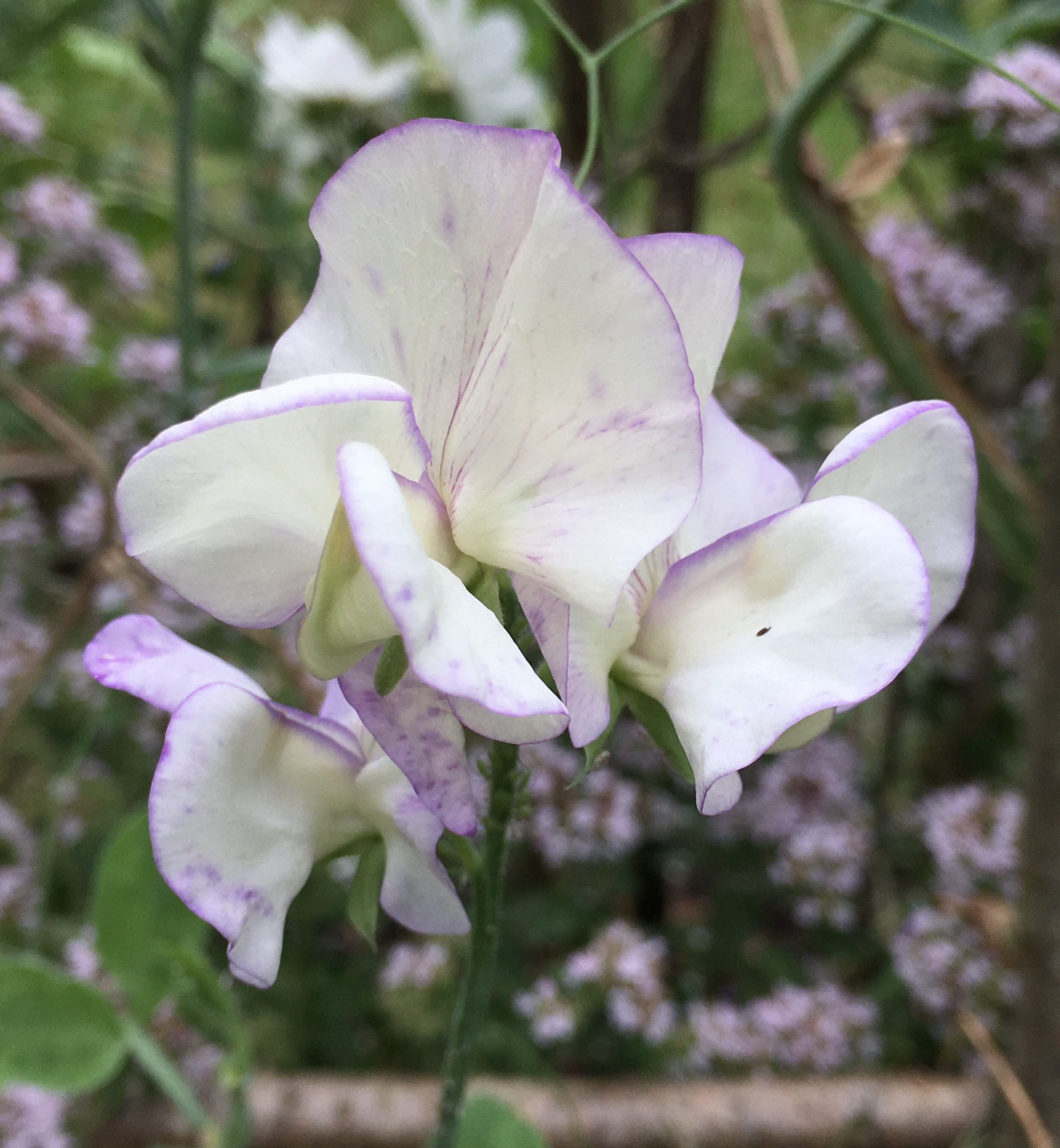
This is High Scent. Another lovely picotee edge and wonderful scent.

Mayflower 400.

Old fashioned, highly scented mix.

I’ve planted new cosmos Apricot Lemonade in front of the frames. I’ll tie them in as they grow. There’s not an inch of space to spare, which is the secret of reducing watering, by covering the ground.

And here’s the first pickings. Such a joy. This scent is worth waiting for all winter and just speaks of glorious long, sunny, summer days.

With a little bit of Sweet William at the base, just coming into flower on the veg patch now.

And here’s a photo of Rachel when she was little, with her guinea pig Rosie. Thank you for all your lovely comments last week. And for your good wishes for Rachel and Sam. I was very touched by all your kind words. Thank you 😊 x
Links : Thanks to Cathy for hosting the IAVOM meme. Why not go over and see what everyone is growing and putting in their vases this week. It’s a world -wide community of gardeners. https://ramblinginthegarden.wordpress.com/category/gardens/in-a-vase-on-monday/
Albutt Blue https://www.visiteaston.co.uk/shop/gardening/seeds/albutt-blue
Pilgrim 400 :https://www.mr-fothergills.co.uk/Flower-Seed/Sweet-Pea-Seed/Sweet-Pea-Mayflower-400.html#.XtTdGBB4WfA
Cosmos Apricot Lemonade: https://www.thompson-morgan.com/p/cosmos-bipinnatus-apricot-lemonade/ka9983TM
Haxnicks root trainers :https://www.haxnicks.co.uk/garden-products/rootrainers
Walk Around My Garden Saturday 30 May 2020 #SixOnSaturday

Rose Constance Spry. Planted when my youngest daughter was born. Roses speak of celebration, and this one really shouts a welcome -to-the-world for Rachel. It flowers for three weeks in early June and fills the garden with a glorious fruit-salad perfume.

Where I am today. Up a ladder. Trying to control the tangle of clematis, jasmine and ivy. This has been allowed to run wild for four years. Little and often might be my approach to tackling the problem. Otherwise, it seems an impossible task. The pergola runs from the back garden to the front drive. A shady walkway in the heat. I’m not going to rush the task. Luckily I’ve got a new Henchman ladder to help with the task. No more wobbling on unstable step ladders.

Alongside the pergola there’s a wedding cake tree, Cornus controversa variegata. Some of the layers have deteriorated. I need to take advice on pruning to try to get it back in shape. Pruning the pergola will give it more light. Behind, climbing to the top of a mature ash tree is Rosa Cerise Bouquet which flowers on and off right through the summer into October.

Another rose looking lovely at the moment is Rhapsody in Blue which has been moved three times. Just goes to show, you can move roses, despite what it says in the books. Highly recommended. Disease resistant and free flowering. Lovely scent and unusual colour.

My grandfather’s rose, Zephirine Drouhin. He gave me this before he died. It’s wonderful to have something from his garden to remember him by. I know it was a favourite of his. I’m sure he knew it would give years of joy. And especially at the moment when everything seems uncertain and Covid has caused so much stress. It is as if he is still helping me, through all the plants coming into flower now. A reminder that life goes on, the seasons keep going. So must we.

My grandfather grew all his fruit and vegetables. People did in those days. Luckily, I watched, followed like a shadow and learned. And he gave me some of his garden tools, so when I’m hoeing the garden, I think of him, working his veg plot and feeding his family. I wonder what he was thinking while he was hoeing his garden. Did he find the peace that I’m finding right now. Was it a comfort to him, as it is to me, through all the trials and tribulations life throws at you.

Foxgloves have seeded in one of the veg plot beds. I’m digging these up and putting them in the wild garden, to make room for winter greens, Brussels sprouts and kale. Flowers will be picked for jam jar posies. I’m putting flowers on the village green again this summer to raise money for Rainbows Hospice for children. There will be an honesty box for donations.

The first sweet peas. Always popular in my jam jar posies. These were sown in root trainers in October. I’ve just sown some more for late flowering through to November. This one is from a packet of seed called Wiltshire Ripple Mixed. All have speckled flowers and a picotee edge. The scent is just wonderful.

As usual, when we’ve walked around the garden, there’s a short ramble along the ridgeway path to my ‘hole in the hedge’ porthole. It’s a viewing point I discovered a few years back. I didn’t make it, nature did, and I watch deer, rabbits, foxes, birds, owls, and hares, quietly and unnoticed.

Today, the May blossom has gone over, but there’s beautiful dogwood flowers framing the view. In an ancient hedge, there’s always something of interest. A tapestry of flowers, rosehips, crab apples, and seeds.

It’s just a humble wild dogwood. But it is as beautiful to me as any ornamental and expensive cornus tree.

And finally, after all that walking, sit a while in my 1930s summerhouse -on-a turntable. In the heat, it’s turned to the shade, facing the wood and pond. A perfect place to contemplate life and all the reasons to be grateful. All the things I value are not the things that can be bought. Hopefully my grandfather would be proud of the person I have become. I’d love to tell him how things have turned out. And that I’ve been happy, thanks to his good advice.
Links : I like to read and join in with the hashtag Six on Saturday why not go over and see what other gardens look like today, all over the world. https://thepropagatorblog.wordpress.com/category/six-on-saturday/
Henchman ladders like mine: https://www.henchman.co.uk/?gclid=CjwKCAjwiMj2BRBFEiwAYfTbCgG1JcfaQwtYjZ_lj7F3XBMAvXjIpri5d5vqMGjRlDY0i6E414m6RBoCRQMQAvD_BwE
Sweet peas :https://www.mr-fothergills.co.uk/Flower-Seed/Sweet-Pea-Seed/#.XtIkQBB4WfA
ACTIVEARTH soil conditioner – product review

I’m extremely careful with products I bring into my garden. I’m mindful of the creatures that share this patch of earth with me. There’s the obvious: birds, hedgehogs, hares, rabbits, frogs, toads, grass snakes and newts. Then there’s the less noticeable, all the insects and beetles which fascinate me and play their part in the food chain for all the other inhabitants here. So I don’t use chemicals. No fertilisers, weed killers or poisonous pest and disease sprays are used. And yet, the garden thrives and is beautiful and productive. Flowers and food crops do well.

It’s well known I’m an organic gardener, so I’m often asked to try out new products. Recently I had a delivery of Envii Activearth an organic ‘soil fertility activator.’ This contains nutrients and beneficial bacteria which helps to enrich poor soil and encourages worm activity. I care about my earthworms, so the product was ‘sold’ to me when the makers said it would benefit them.
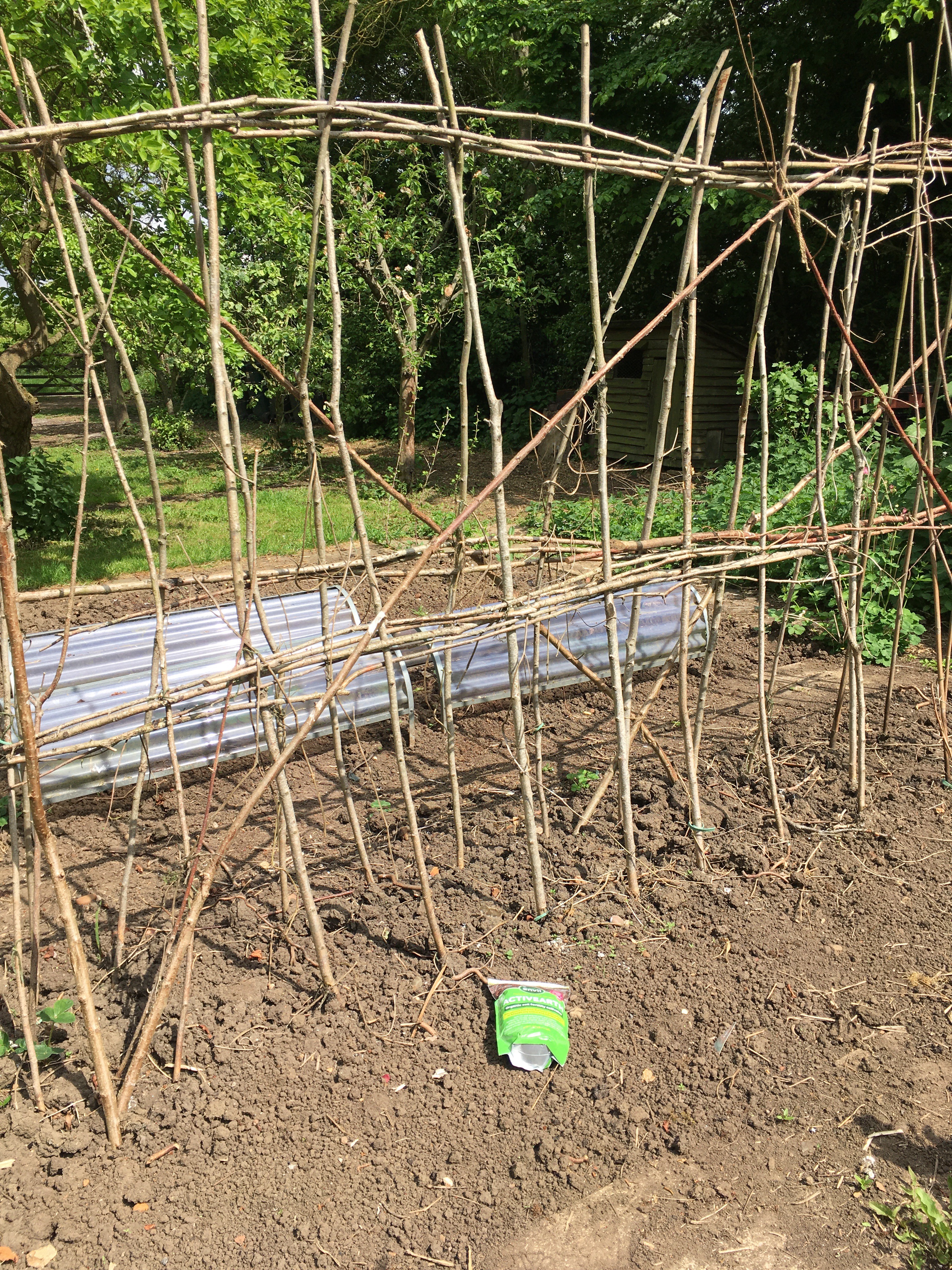
I sprinkled the granules around in my veg plot, especially where I’m growing some beans which need good fertile conditions to do well.
The product smells pleasantly of chocolate. A small sachet goes a long way. I spread it at about 40g per square metre. I saw on the packet the product is also suitable for flower borders and lawns. It contains magnesium, calcium, hydrogen and potassium.


I was pleased to see the packaging can be composted and doesn’t have to go into landfill. Mine went into my green compost bin.
Here’s a peaceful stroll around my garden. Aren’t the birds loud this spring, I can’t ever remember so much birdsong. Or perhaps I have just always been too busy to stop and properly listen. If you love cow parsley you’ll enjoy my woodland walk at the moment. The paths are lined with gorgeous lacy white flowers. I’m planting white foxgloves amongst them just now for next spring’s display.

There’s a patch of wild garlic and three-cornered leek too. I’ve tried making soup with the garlic. Very useful when there’s little in the cupboards at the moment. I’m still not getting out and about, keeping safe and busy at home. I’m resisting attempts to call me back into the world for work. I’m quite happy mooching here in the potting shed. It’s so peaceful here.

This is the view from the potting shed. A favourite layered viburnum. Possibly Viburnum plicatum Mariesii. There were wild violets all around the base. They are still there, hiding under the stinging nettles. I’m working on reducing some of the nettles and adding wild flowers this summer.

We planted these foxgloves, Pam’s Choice, last summer. They brighten up a shady patch round the back of the pond. They stand up to high winds, which is just as well as we’ve had gales gusting 42 knots (says my husband – who is a sailor).
I hope you’ve enjoyed today’s ramble around the garden. What’s looking good in your gardens today, and what plans have you for new plantings this summer?
Disclaimer: I didn’t pay for my sample product, but in common with most other bloggers, I only accept samples for review if there’s no payment given, and I can freely give my honest opinion.
In a Vase on Monday – revisiting RHS Chelsea Flower Show.
Well, we should all be at the Chelsea Flower Show today. But it’s been cancelled, like most spring and summer events. So instead I’m sharing photos from last year. Plants and flower arrangements I made a note of, for my own garden. Enjoy this dip into my photo album.

Kelways Peonies. I love Lemon Chiffon, (cream) Seashell, (pink) Avalanche, (white) Nymph, (pink).

They don’t last long, but such a glorious sight in mid May. I wouldn’t be without peonies.

Lupins from West Country Lupins. Just perfection. I bought this one

And this one. Lupin Masterpiece. Such a glorious plum colour.

David Austin Roses. This one is new variety, Tranquility. Very calming colour.

And new rose Desdemona. Beautiful at all stages from tight bud to wide open. Gorgeous scent. Stands up to the weather really well. Flowers shrug off rain and don’t ‘ball.’ Recommended.

Pinks. This is the new Tequila Sunrise. Lovely changes of colour as the flower ages. Amazing scent.

It’s wonderful to have the pinks side by side so you can compare them. The scent is just amazing in the heat, and contained by the roof of the marquee. A lingering memory of Chelsea.

Some of the amazing flower arrangements at the show. It really is a florists’ paradise.

These were still being created on press day. I stood for a long time watching the process.

This tower of flowers was spectacular.

Close -up detail of the flower-filled tower.

This explosion of foxgloves and cow parsley is my favourite.

Details for this lovely arrangement.

I also studied this arrangement created using test tubes. Really simple and lovely. Simple is what I always go for. As you know.

So I came home and made this from flowers in my garden. Inspired by all the lovely blooms I’d seen at Chelsea. There’s wild daisies, blue corn flowers and cow parsley as a background with green ivy covering the mossy wreath.
I hope you’ve enjoyed this re-visit of last year’s Chelsea Flower Show. I’m going to be watching all the on-line and televised content. This year, it is all about finding ways around problems and learning how to enjoy the things we love. Gardening – growing food and flowers- has been a saving for me. It’s kept me occupied and stopped my thoughts running away. It’s kept be grounded and focussed on keeping calm and helping others. Gardening is also a shared joy. Although we can’t see our friends and family, we can still talk about our gardens and share photos. It keeps us connected, and reminds us we are not alone.
If you listen in to BBC Radio Leicester, send your photos to mid-morning host Ben Jackson. Sharing our gardens is a lovely thing to do. And I’ll be talking about what I’m growing on Wednesdays and Thursdays, alternating with my gardening team member Josie Hutchinson. And also now and again on BBC Radio London.
Links: RHS Virtual Chelsea Show https://www.rhs.org.uk/shows-events/rhs-chelsea-flower-show
Kelways Nursery : https://www.kelways.co.uk/category/peonies/1/
West Country lupins : https://www.westcountrylupins.co.uk/index.html
David Austin Roses :https://www.davidaustinroses.co.uk/delivery
Join in with the In a Vase on Monday meme and see what eveyone is growing and putting into vases this week, all over the world. : https://ramblinginthegarden.wordpress.com/2020/05/18/in-a-vase-on-monday-the-jewels-and-the-crown/
Six on Saturday – A walk around my garden 16 May 2020

A seedling sorbus mountain ash. Sometimes nature delivers such beautiful surprises. We didn’t plant this tree, it arrived all by itself. We allow plants to grow and any that fit in with our wildlife-centred scheme of things are allowed to stay. This seedling produces beautiful creamy white flowers. Much loved by bees. Then in the autumn, rich orange berries. Much loved by blackbirds. My youngest daughter Rachel has just bought her first house. What a time to be negotiating a house purchase, in the middle of a pandemic. It’s been extremely stressful. But holding on to our hats and keeping calm, between us we have steered our daughter through choppy waters. And she and her boyfriend Sam have a (rather scruffy) old house with a very large garden. So today I’m digging up a few sorbus seedlings and potting them up for her new plot. I’ll also search out for some wild cherry, maple and oak saplings. The same size as those we planted when we moved here 30 years ago, our heads full of dreams to create a lovely home and have children. Now we are watching the youngsters cross the threshold of their first home, and it brings back all our memories. History repeating itself. We get to re-live our joy, as we watch them start their lives together.

As you can see, our little saplings have grow tall. The mini-wood is carpeted in bluebells and patches of wild garlic and three cornered leak.

Here’s the view from the pond. The turntable summerhouse is turned to the garden today to catch the morning sun.

The leaf-mould paths are lined with white lacy cow parsley. A favourite time of the year.

Wild flowers sweep along the edges of the paths. These are starry stitchwort, or stellaria.

Our little plot provides all the firewood we need for our log burner. A habitat for hedgehogs and beetles, insects and grass snakes too.
By the pond there’s a huge mature viburnum. I believe it is Viburnum plicatum Mariesii. It looks beautiful all year round. In May, it’s covered in flat creamy white flowers, and in winter the snow and ice settles in layers on the branches.

I hope you’ve enjoyed this week’s walk around my garden. I’ve made a sunny place to sit and read in the front garden. Just right for mulling over the past, and looking forward to the future. I’m sure you’ll all raise a glass and join us in wishing Rachel and Sam many congratulations. Good luck with everything, and always be happy. Life’s not always a bed of roses, but if you stick together, help one another and always be kind, you’ll have a wonderful life together.
Karen xx
Links SOS : A favourite blog. Why not go over and see what photos other gardeners are sharing from their plots today, all over the world. https://thepropagatorblog.wordpress.com/2020/05/16/six-on-saturday-16-05-2020/
Please leave a comment at the end of the blog, and feel free to share this blog on any social media platform . Thanks for reading.
Strawberry Cheesecakes- vegan family favourite recipes from my daughter, Clare

Try these tasty treats. They are perfect for summer picnics and special occasions. And vegan friends and relatives will love them.
INGREDIENTS
Makes 3 small ramekins. We re-use the glass ones from Gu.
Base:
190g cashew nuts
1 tbsp. vegan margarine
1 to 2 tbsp. maple syrup
Topping:
150g Creamy Violife – original flavour (cream cheese substitute)
1 tbsp. icing sugar
1 tbsp. caster sugar
1/4 tsp. Vanilla essence
1 tbsp. soya milk
strawberries to decorate
1 tbsp. maple syrup to drizzle over strawberries.
METHOD
For the Base:
Roast the cashew nuts in the oven at 190C for 5 to 10 minutes. Keep checking and remove from the oven when the nuts have turned light brown. They easily burn, so keep an eye on them.
Whizz the cashew nuts in a food processor. Add the margarine and maple syrup.
Spoon the mixture into glass ramekins and place in the fridge to cool.
For the topping.
Cream all the ingredients together and spoon on top of the base.
Slice the strawberries and place on top of the cream mixture. Drizzle the maple syrup over the top.
Delicious! And very quick to make. The cashew nut base makes a change from biscuits and is healthier.
Enjoy!
Blagdon Pond-In-A-Box. Review and prize draw

The sight of goldfish takes me back to my early 20s when I travelled several times to China. I was lucky to get the chance to visit many gardens, while working for a newspaper. The Leicester Mercury was invited to send a representative to the army base of the Leicestershire Regiment, stationed at Stanley Fort in Hong Kong. Luckily, the editor chose me. And while there, I flew back and forth all over China, including to Shanghai and Guilin to view the gardens. It was the experience of a lifetime, something I’ll never forget. Some of the gardens had huge ceramic bowls of water, filled with goldfish. I’ve always wanted a goldfish pool, to remind me of those fabulous care-free days of travel. Here at bramble garden, we have a large horseshoe pond with a stone and gravel beach. But it is mainly for wildlife and it’s away from the main house, in the paddock. I thought it would be lovely to have a pond right by the back door, under the kitchen window.
I’d heard of the pond-in-a-box concept, and recently, Blagdon asked if I would like to try one of their ‘Affinity’ ponds. This has been a wonderful project to work on during the covid lockdown. It’s given us something lovely to work on together. And the calming sound of water is very welcome. We haven’t finished our project. There’s no fish or pond plants available at the moment. But I thought I would share this with you now, especially as Blagdon have offered a smaller ‘ Affinity corner pond’ as a prize.
So here’s what arrives in the post:

It’s hard to believe that everything for the pond arrives in one box! The word ‘Tardis’ springs to mind.

There does seem to be an overwhelming number of parts to start with. But if you can put together a piece of furniture from IKEA, you can manage to make a pond. The instructions are clear, and after the initial panic, sorting all the parts into little piles and working methodically through the assembly leaflet, it’s possible to make the pond in just a few hours. We didn’t have any difficulty once we settled down to follow the step-by-step guide.

We first created a framework. We did this in the lounge in front of the fire. It might be much easier to work out on the patio. And a lot less overheated! Luckily we were able to turn it sideways and get it out of the doorway, which we hadn’t thought about when we started!

The side panels slide into the frame. I’d say this is easier with two pairs of hands. But you would manage, if you were on your own. A feature of the pond is the ‘porthole’ insets. Children will love being able to view the fish through the sides.

Here it is taking shape.

When it is all put together, there’s a liner that fits inside. Then it is just a case of carefully dropping in the pond pump. There’s lots of fountain and /or waterfall options. We started off with a sort of mushroom and played around with it until I found the gentle burble effect I was after.

There’s an LED spotlight that comes on automatically at dusk. And the Blagdon Inpond filters the water and keeps it clean. You can find out more about it on the website.

Here’s what it looks like at night. I must admit, sitting next to it at dusk, watching the fountain and hearing the splash of water is very soothing, especially in these troubled, stressful times.


Like any new feature, it can stand out and look quite stark at first. But I ‘dressed’ the sides of the pond with acers, ferns, hostas, grasses and rosemary plants. It blended in with the patio furniture then, and didn’t look so harsh. This is no criticism of the product, except to say that it is very new and fresh, and therefore stands out against ‘old’ paving and walls. Foliage definitely softens the hard edges. Pond plants would also help. There are planting pockets included in the package.

Luckily, I’ve got a few large potted grasses, which match the woven panels perfectly. I must admit, we forgot to remove the protective film from the portholes. The view is much clearer now!

I’m delighted with my pond-in-a-box. It’s been a fun project to focus on during a difficult time, and I’ve got all the pleasure of choosing fish and new pond plants to come. And finally I’ll have something that reminds me of those interesting times trekking all around China!
For the chance to win an ‘Affinity View’ corner pond, similar to mine, but with three woven front panels with viewing port holes, please leave a comment in the box below, right at the bottom of the page. A winner will be randomly selected by Blagdon. No purchase is necessary, and the usual rules apply. There’s no cash alternative and Blagdon’s decision is final.
Disclosure: I have not paid for my pond, or been paid to write about it. Views are my own and I’m free to comment as I wish.
Update: Two pond skaters, a water beetle and a water boatman have moved in! Within one day of setting it up. And a blackbird has decided it is a perfect place for a dip, balanced in the planting baskets at the side.
Links. Read all about Blagdon here: https://www.blagdonwatergardening.co.uk/Products/Ponds/Affinity-Pools-Complete-Kits
Available from all good aquatic retailers and also online.
Six on Saturday- A walk around my garden 25 April 2020

Bluebells. These came from my grandfather Ted Foulds’ garden originally. A lovely reminder of him. There was only a small patch to start with. Now they run from the front to the back garden. It’s surprising how fast they spread, without any help from me. There’s some wild garlic in amongst them too, which I’m trying to control a little this year.

Trees are leafing up so quickly in the sunshine and heat this year. The bluebells will have to be quick to flower and set seed before they are shaded out. This is the path past the summerhouse to the pond.

The view from the summerhouse. It looks like a jungle already. There’s oak, beech, hornbeams, cherry, willow and ash in the mini-wood. All the trees came as saplings from the borough council when we moved here 30 years ago. There was a scheme to plant trees on farmland. I think it was linked to the woodland trust. We applied, and they delivered 260 saplings for us to plant. The whole family set to and helped us plant them in a day or so.

All along the woodland paths there’s a lovely white starry flower, I think it’s called stitchwort. I didn’t plant it, but it’s very welcome here.

It seems to be all green and white shades today. May blossom or hawthorn is suddenly in flower.

Such a beautiful sight at dawn. These flowers were just in bud yesterday. The hedgerow is so beautiful just now with sections of crab apple, maple, hazel and viburnum all in a hurry to wake from their winter sleep. The scent from the crab apple blossom is something I’ve never noticed before. I think the heat is enhancing the scent.


Oops, that eight photos. I’m sure no one’s counting…..

Enjoy your weekend. Here’s a view through my ‘gap in the hedge.’ I didn’t make this portal, nature did. I love to peer through and watch the wildlife. There’s always something happening in the back fields. Lovely to see some green shoots in the fields too. Fields have been bleak and bare all winter, after the flooding.
Links: Six on Saturday : https://thepropagatorblog.wordpress.com/category/six-on-saturday/
Please leave a comment at the bottom of the page. The comments box is below all the hashtags and social media sharing buttons. Please feel free to share too. Thank you.
BBC Radio Leicester Gardens Hour 22 April 2020

If you were listening in to BBC Radio Leicester for Gardens Hour today, I’ve written some notes to accompany the programme.
I’m working from home at the moment. The oak tree above has just burst into leaf. I can see the tree from the top of the paddock. The swallows returned here last Wednesday, and we’ve seen pipistrelle bats over the garden.

Blossom has been fabulous this year, with no rain to spoil the flowers. I’m sitting under this Prunus Kanzan cherry tree today to answer questions and talk about my gardening tasks.

We had a question about an apple tree failing to establish.
If your tree is failing to thrive, it usually indicates a problem with the growing conditions. Poor growing conditions will stunt any tree or shrub.
Water any newly -planted trees well. Soil may be dry around the roots even when the surface appears moist. Check with a trowel to see how far the water is penetrating the ground.
Weeds and grass compete with trees for moisture. Keep a weed and lawn -free zone at least 1m in diameter around the plant.
Mulch locks in the moisture and helps feed the tree. Apply a mulch a good couple of inches deep around the tree, avoiding the trunk. (mulch piled up against the trunk can cause ‘drowning,’ so take care it doesn’t get pushed up against the tree).
You can use your own home-made compost or composted bark for the mulch. Do not apply to dry ground, as it can also lock -in drought.
You can place a drainage pipe in the ground alongside the tree at planting time, which helps water reach the roots. However, take care, as too much water can cause water logging, which is also detrimental.
Feed with a potash fertiliser, which promotes fruit and flowers.

Salix Flamingo – wiki commons photo.
We had a question about a Salix Flamingo willow tree failing to thrive. The tree has come into leaf and the leaves have shrivelled.
I’ve found this tree difficult to grow. It’s grown for its new, shrimp pink leaves which emerge in April. These leaves are delicate and easily damaged by cold winds and frost. Too much direct sunshine on emerging leaves can also cause them to shrivel. We have had a combination of high daytime temperatures, cold east winds, and plummeting night time temperatures. In a sheltered garden you would have no problems, but in a slightly more exposed spot, the tree struggles. Also, being from the willow family it requires plenty of moisture. We haven’t had any rain for several weeks and the ground is parched- despite all the record-breaking amounts of rain we’ve had over autumn and winter.
Usually, the tree recovers and produces a new set of leaves to replace the ones that have shrivelled. Watering and throwing some fleece over at night usually nurses it along until we get more even growing conditions in early summer. I’ve known them to suffer from a type of rust, and also canker. But apart from that, they are very pretty trees. They either like you, or they don’t though!

We had a question about a montana clematis failing to flower. This is my clematis Montana Wilsonii. The one the caller had was a pink variety, planted last year and growing in a pot next to an archway. The clematis on the other side of the arch was doing well.
Clematis montana flowers on the previous season’s wood. The caller hadn’t pruned it, but sometimes a montana clematis will take 2-3 years to settle into flowering as its first thought is to grow to the top of the archway.
Clematis don’t do as well in pots, unless they are a really good size and you can keep up with the watering requirements. So it would be best to plant the clematis in the ground and keep it well fed and watered. Potash feed, again, for flowers. And prune immediately after flowering, although I hardly prune my montana clematis to be honest. It’s pretty low maintenance, once established.

And finally, we had a caller wanting to buy a Venus fly trap. They are usually sold at local garden centres, which of course, are not open at the moment. However several are making deliveries, so it’s worth ringing round to source supplies of plants. I’ve found this one on line from QVC. I’ve bought various plug plants, bedding and bird food from QVC and found the service to be quick and reliable. However, I’ve never bought any fly trap plants from them, so can’t say more than I have managed to find a supplier.
I hope you’ve found these notes useful. Please listen in on Wednesdays at 12.30 with Ben Jackson and on Sundays (usually) with Dave Andrews at 1pm on your smart speaker, DAB 104.9FM or on BBC Sounds.
It’s great to be involved with local radio gardening and we try to offer something for experienced gardeners wanting to try new varieties and grow for shows, and also for those who have never grown anything before. All questions welcome. We will try our best to help. I am part of an experienced team.
Comments box is right at the bottom of the page, below hashtags, social media sharing and links.
BBC Sounds to listen back: https://www.bbc.co.uk/sounds/play/p088w205. At 2.37.30 on the timeline.
BBC Radio Leicester Gardens Hour 19 April 2020

Notes for anyone listening to BBC Radio Leicester today. You can send e mails, texts and messages for free gardening advice. I’ve been a travelling head gardener and a garden designer for 25 years. I write for weekly Garden News Magazine. I grow my own fruit, veg and flowers at home on a one acre plot created from a ploughed field. Currently, I’m speaking each week from the potting shed during the corona virus epidemic. Here’s the view from the potting shed, for anyone who likes blossom. Turn up the sound to hear the birdsong.
We cater for everyone. So if you’ve never gardened before and want some essential tips to get started, get in touch. We can help experienced gardeners wanting to grow the latest varieties or try something new. Maybe you want to grow more salads and veg for the family. Or you might fancy the challenge of growing for a “virtual” flower show. We can help.
This week we talk about growing tomatoes. I’m growing classic beefsteak variety Marmande for cooking, and tasty cherry tomato, Tumbling Tom for salads. My plants are 12cm (5″) tall and the roots are coming out of the bottom of the pots, so I’m potting them on. They’ve been growing in 7.5cm (3″) pots and I’m moving them up to 12.5cm (5″) pots. They will eventually go into 25cm (10″) pots and window boxes, but they have to be moved up in stages as tomatoes don’t like lots of cold wet compost around their roots.
Tomatoes like plenty of warmth, so I’ll keep mine indoors until the end of May. Tomato leaves turning yellow could be an indication the plants are getting too cold overnight, especially if they are right next to the greenhouse glass. Move them to the middle of the greenhouse and create a fleece tent to keep temperatures more stable between night and day. Remove fleece promptly in the morning. Alternatively, yellow leaves could mean the plants are running out of feed. Composts usually contain feed for about six weeks. But yellow leaves indicate a lack of nitrogen, so feed with a very dilute tomato fertiliser. Move plants on promptly when the roots have filled the pots. Don’t over water as plants also hate cold wet feet. Use tepid water. Bring the watering can in to the greenhouse to warm up. Cold water causes shock. Tomatoes need warm steady growing conditions and don’t like swings in temperature. Try to water them in the morning so they are not left cold and wet at night. Aim the watering can at the roots and keep the foliage dry.
While I’m stuck at home, I’m looking about to see what I can do to keep connected with the outside world. One thing I’m doing is joining in with the Rainbows 5K challenge.
Rainbows is a hospice in Loughborough, supporting children and young people with life-limiting conditions. They receive only 15 percent of their funding from the government and everything else has to come from donations. The corona virus lockdown means they can’t run all the usual fund-raising events. But the 5K challenge is one way everyone can help out.
You can take part anytime between now and May 31st. I’ll be logging my walking while I’m mowing the grass, weeding, raking, hoeing and plodding about the plot between the greenhouse and potting shed. I am sure digging also counts!
You can also help by tagging rainbows on social media to keep them in the public’s eye by posting photos on Facebook @rainbowsfanpage and on twitter and Instagram @rainbowshospice.
Children and all ages can take part. You can walk, run, hop, skip, cycle. Think of me weeding and cutting the grass for hours on end. At least the garden will look lovely, and it’s all in a good cause!
The National Gardens Scheme is also a charity close to my heart. Mum and I usually spend every Sunday visiting an NGS garden, having a cup of tea and piece of cake and buying a few plants. The lockdown means no gardens are open this summer. But the charity has launched a ‘Support Our Nurses’ campaign with virtual tours and JustGiving pages.
There are three gardens so far featured in leicestershire: Brook End in Wymeswold, with spring blossom, tulips and daffodils and ponds. There’s also Donna’s Garden at Snowdrop Ridge in Market Harborough, which should have opened for the first time this summer. There’s a wonderfully calming goldfish pond video.
Also a ‘walk through’ at Oak House, South Kilworth.
Donations support nurses working for MacMillan and Marie Curie, Hospice UK, Carers Trust, The Queens Nursing Institute. The NGS also helps Parkinson’s UK, Perennial and Horatio’s Garden for spinal injuries.
During the programme I mention our concerns for growers, garden centres and nurseries which are not allowed to open during the lockdown. There are fears many might go out of business with plants having to be skipped. Livelihoods are on the line.
I mention the Garden Centre Association #SupportYourLocalGardencentre campaign at gca.org. There’s a list of garden centres providing local deliveries.
Val and Steve Bradley from BBC Radio Kent, the Sun newspaper, have created a list of growers and nurseries offering mail order and/ or deliveries.
I’ve provided a limited and ever-changing list for Leicestershire here: https://bramblegarden.com/2020/04/05/contacts-and-information-to-help-you-through-corona-virus-lockdown/ If you want to be added, please get in touch.
Thank you for joining us at BBC Radio Leicester. These are strange and difficult times for all of us, but we can keep connected through social media and listening to the radio. It’s amazing how we can all help by taking little steps at a time. They all join up to a giant leap forward, don’t you agree. Get in touch and let me know what’s looking good in your garden and how you are getting on during this lockdown time. Are you managing to get on with your gardening? Is your garden providing a calm sanctuary. I know mine is right now.
Links:
Rainbows 5K Challenge : https://www.rainbows.co.uk/events/rainbows-virtual-5k-2020
National Gardens Scheme https://ngs.org.uk/virtual-garden-visits/
Garden Centre Association lists : https://gca.org.uk/
Val and Steve Bradley nurseries/growers list: https://47flt.r.ag.d.sendibm3.com/mk/cl/f/nsnLPDyBJajPGKKpPRt5x9TOx4tu9x1Dz-v5FiKvBC10LYC0JB45oC3rcwqKse2n5D7aQhdwFnOZEulP7NPET4tRxtfv-n5eUr7mNx6H7gjRIWSVXN-QVsXdmRICgr44KOhL_NeHecmmxD8URqGk4-jf5QBzcACiRe7I8jdByhWKnFH9LN4d2C-sA4qsiNVzl4nQDttx7wgdEKWIS89NuNt-XaZCrrIiTT3B
You can follow me on twitter @kgimson
On instagram @karengimson1
And Pinterest @karengimson
Some photos from my garden:

Seedlings in the greenhouse, tomatoes, cosmos, onions, cucumbers, aubergines, peppers.

Planting out calendula Snow Princess grown in plug trays.

We had some winter storms and dead elms in the hedgerow.

The whole garden is scented by this viburnum. Planted in front of white cherry tree, prunus avium, and pink cherry Prunus Kanzan.

Pheasants Eye narcissi, still looking good in the cut flower beds.

Not all things go according to plan.

Cherry blossom. Stella. Lots of fruit, hopefully. Have never seen blossom like it. A good year for fruit trees.

Pear blossom. I’m keeping an eye on the weather. Fleece will be thrown over at night if there’s a frost.

Thank you for reading!
In a Vase on Easter Monday 13 April 2020
Finding comfort in familiar things, I’m posting my usual In a Vase on Monday. This time, it’s flowers from a friend. Narcissi from the Scilly Isles.

Scilly flowers arrive in the post in a well-packed box.

The label is smudged because I sprayed it with antibac before bringing the parcel in the house.


Beautifully wrapped in green tissue and brown paper. And there is a lovely card from my friend, Barbara.

There was enough for a display for the kitchen table and for the summerhouse. I used a vase that belonged to my mother-in-law Joan. I took a photo of the flowers and sent a card and letter to Joan and Keith. We haven’t seen them for three weeks. I’m worried Joan won’t know who I am when we can finally get out to see them. Very sad to hear they have to stay in their own rooms and can’t even see each other, let alone have visitors. I’m very grateful to the staff who are keeping our loved ones safe though. I hope we will be through this crisis soon.

Today’s flowers are Narcissi Geranium, cream flowers with an orange cup, and double cream Winston Churchill.

The scent is just glorious. They are a perfect combination.

Just beautiful for spring. Especially for Easter, when we usually fill the house with flowers and have lots of visitors.

I’ve made a writing and reading space in the summerhouse. We’ve had lovely weather this past week. Hoping it’s sunny where you are today.


In my baskets I’ve got gladioli bulbs. I’m planting these today in between the sweet peas through the hazel A frame on the veg plot. The hazel rods will help support the tall gladioli spikes. It’s good to be thinking about summer flowers. And hopefully we will all be able to get out and about to visit gardens, and our families in due course.
Get in touch and let me know what’s looking lovely in your gardens right now. How are you coping with the corona virus lockdown?
I’m joining with Cathy for her #IAVOM meme. Why not go over and see what everyone’s growing and arranging in their vases today, all over the world.
And finally, Happy Easter Monday to you all. Keep smiling. x
Cathy : https://ramblinginthegarden.wordpress.com/2020/04/13/in-a-vase-on-monday-decisions-decisions/
Six on Saturday – views from my garden April 11 2020

Tulip Mount Tacoma and forget-me-nots.
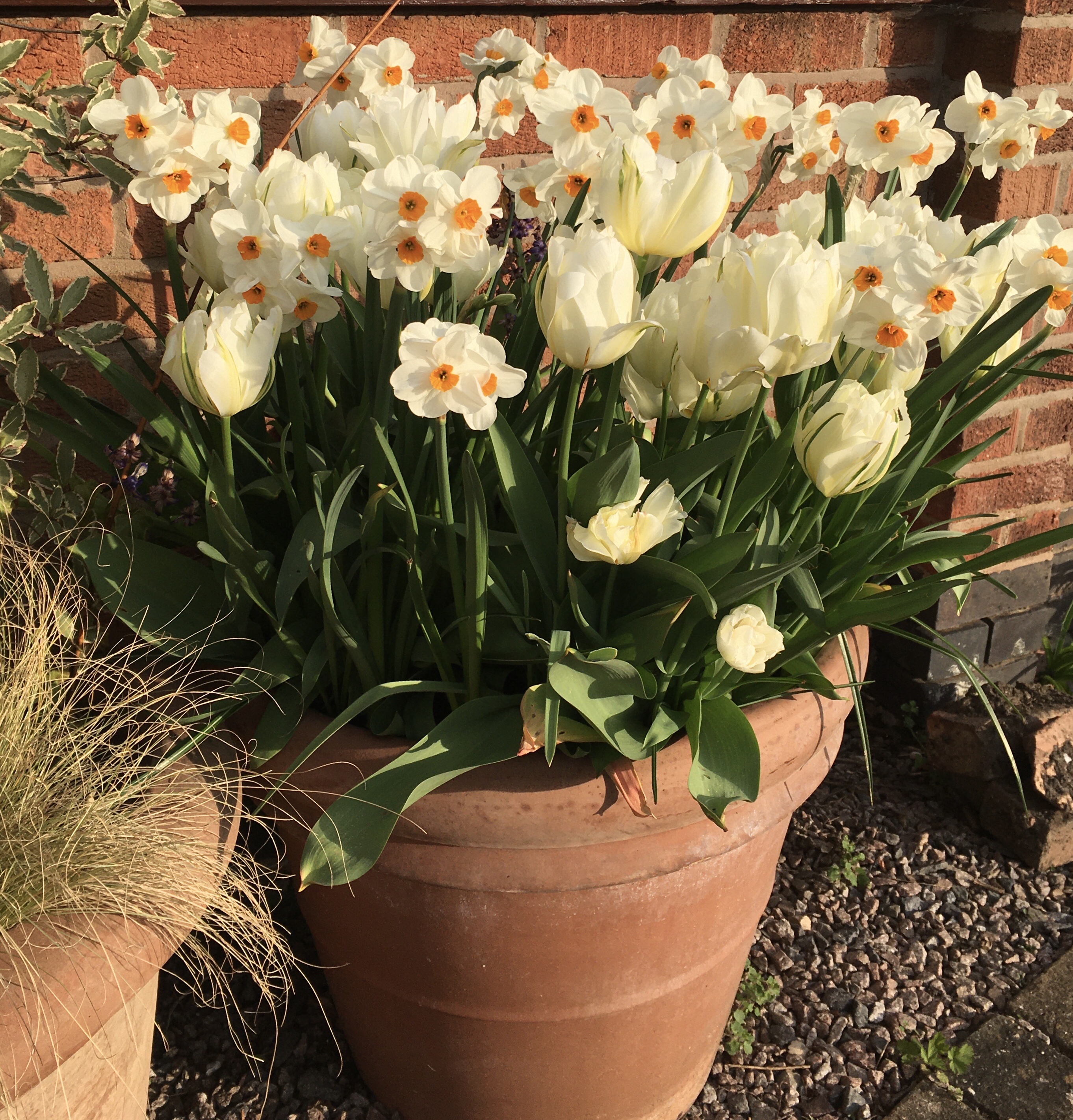
My favourite Italian terracotta pot near my front door. So sad there are no visitors to enjoy this lovely sight. I’m including it here, so you can all share in the magic of spring flowers. Fairly new introduction Exotic Emperor, a double form of the classic and popular Purissima. Has peony-like petals that curve and twist as they open, revealing a flash of green. Very lovely and my favourite. This is a fosteriana tulip, and here in the Midlands, it always flowers through April. Planted with Narcissus Geranium an heirloom bulb dating back to pre 1930. Beautiful, delicate fragrance. Perfect for cut flowers. I have a row in the veg garden for cutting. Multi-headed – some of the bulbs have four flowers to a stem. I love mixing the old with the new. I’m fond of traditional plants, but I love trying something new.

I’ve always grown the white Purissima tulip, so I thought I would try the new sport, Flaming Purissima, another fosteriana tulip. It is such a joy, with all shades of pink and red ‘flames’ over an ivory white background. Beautiful under a white cherry blossom tree. I’ve planted these in a trench on the veg plot for cut flowers. They last a week in a vase, and watching them turn from tight buds to open, flat, almost water lily-like flowers is a joy. These were introduced in 1999, and they reliably come through the winter and flower each spring for me.

So comforting to know we will have masses of cherries this summer. We leave the trees unpruned. Blackbirds enjoy the crop at the top of the tree, and there’s more than we can use around the downward – arching lower branches. I’ve planted narcissus Pheasants Eye under the trees as an experiment. They flower at the same time. They look so glorious, I’ll fill the orchard with them next spring. They cost very little and are a joy to behold. I’ve taken photos of the garden and made notes to remind myself to order bulbs in July and plant in September. If I don’t make a note, I seem to forget!

In the wild garden around the pond we have this un-named beauty. We planted these 30 years ago. I wish I’d recorded the name as I’d love to plant more as pretty and reliable as these. They have a wonderful scent too. Petals glisten and remind me of sugar coated violets. I wonder if you know what I mean.

And finally, a humble bellis daisy, growing in the cracks between the paving by the back door. I’ve been imploring (nagging) the family not to step on them all winter. I have a little patch 60cm square of delightful little daisies. There’s absolutely no soil there. I feel they deserve to live, having made such an effort to survive.
Enjoy your weekend everyone. This is not to say that we are not all desperately worried by what’s going on in the world, and in our own country. But I’m thinking this sharing of garden photos may help someone keep calm and carry on. There is really nothing else we can do at the moment. Stay at home, help the NHS, stay safe. And look around you and enjoy the beauty of nature. When this is all over, our gardens will still be there waiting for us.
Links: all bulbs were bought from https://www.gee-tee.co.uk/
The bellis daisies came originally from my Mum in a little pot stood on the patio all summer. Seeds can be bought from https://www.mr-fothergills.co.uk/Flower-Seed/Bellis-Goliath-Mixed.html
Please leave comments below and let me know what’s flowering in your garden this Easter time.
Contacts and Information to help you through Corona Virus Lockdown

On BBC Radio Leicester, I talk about my garden, what I’m growing, and try to answer listeners’ phone-in and text queries.
Local radio is helping me find food and supplies whilst I’m in lockdown at home and cannot get out. This week I heard about a catering company delivering fresh food boxes around Leicestershire. I’ve given up attempting to get a delivery slot with supermarkets. Instead I’m going to support small companies, farm shops and cafes which are trying to keep their businesses going by adapting to current needs.
I’ve compiled a list of sources of help and advice you might need -to get you through the corona virus crisis. The BBC’s motto at the moment is #BBCMakeADifference. Here’s the people I think are making a difference right now. And I am mostly focusing on the gardening world. Please add anything you feel might be helpful, in the comments below and I’ll update this list and repost it. Please keep checking back for additions.
THE NATIONAL GARDEN SCHEME
We are unable to get out to visit gardens, but we can still view them on the computer and help charities. It’s good to look at something cheerful at the moment.
The NGS raises money for Marie Curie and Macmillan Nurses, among others, and stands to lose 90 percent of its income this year, with all gardens closed for the foreseeable future. Nurses are needed more than ever, so this is a disaster for the famous much-loved Yellow Book charity. I’ve joined the county team to help them publicise on-line events this year.
What they are doing: posting you tube videos of gardens and asking supporters to make a small donation via the just giving pages.
CANDIDE APP HELPS NURSERIES
How to obtain plants for our gardens through the corona lockdown:
With the closure of garden centres and other retail outlets, sales of ornamental plants are being badly hit. Growers are seeing orders cancelled and staff are being laid off. Some growers say they will go out of business. The Horticulture Trade Association (HTA) is calling on the government to offer general and financial support. Meanwhile, in an effort to support smaller nurseries who currently don’t sell on line, social media app Candide is listing nurseries and creating an interactive map which will take you to nursery websites. Candide has 300,000 members.
Rosy Hardy from Hardy’s Cottage Garden Plants is helping nurseries with advice on sustainable packaging and hints and tips on selling mail order and on line.
http://www.hardysplants.co.uk/
Alan E Down is presenting online Candide Garden Club Talks starting on Tuesday April 7 at 6pm -7pm. There will be ‘what to do in the garden’ tips and a question and answer session on Zoom app. This talk will be free.
https://zoom.us/meeting/register/tjQtcuusrzkq1bwnEZ03ag-djA51Yjmw
BLOGGERS OFFERING GARDEN AND GROWING ADVICE
ALISON LEVEY is showing videos of her garden with a link to a just giving page, in aid of the NGS :
https://www.blackberrygarden.co.uk/
30 DAYS OF WILD PARENTING is suggesting ways we can all engage with nature at this stressful time. Feeding the birds and learning more about them is one idea on the blog.
https://30daysofwildparenting.wordpress.com/
THE THREE GROWBAGS, three sisters with a #DigYourOwnaForCorona daily posts on gardening and how to create a veg patch. A light-hearted guide to lift your spirits during this worrying time:
SALLY WICKS is writing an on-line diary about her gardening life. She is keen for us all to grow flowers this summer to fill our windowsills with colour and joy. Lots of expert help and advice on all aspects of growing.
GARDEN NINJA provides you tube guides for people who are self isolating. Gardening tips for any level of skill for any size space. Explains the theory and shows practical elements of gardening.
https://www.youtube.com/channel/UCuhMHrXyf2bvga2Mq0DJvwQ
GROWING FAMILY is a website packed full of ideas and resources for gardening with children. Lots of ideas to get the whole family out there growing fruit, vegetables and flowers. Craft activities, and projects for all ages.
http://www.growingfamily.co.uk
MIKE PALMER uses Facebook and Instagram live to share his garden and to answer questions on improving your garden and on planting and garden design ideas.
@mikepalmer01 on instagram
LIFE ON PIG ROW Working with AGENTS OF FIELD to show you what you can grow, cook and eat. #whydontyou hashtag. Asking people to share favourite recipes, hobbies, crafts and skills. It’s all about finding the positives at home and in the garden right now.
https://lifeonpigrow.blogspot.com/
TAMSIN WESTHORPE Has published a free, down-loadable daily wall planner for children called ’30 Days of Fun in the Garden This April’ in conjunction with Orphans Publishing. It offers affordable ideas suitable for windowsill gardening. You don’t need any special skills or equipment. A boon for any parent with children at home at the moment.
https://www.orphanspublishing.co.uk/30-days-of-fun-in-the-garden-this-april/
ANN–MARIE POWELL is providing a garden design show at lunchtimes, live on instagram @myrealgarden. There’s also a Facebook page where you can ask advice. And a blog post listing nurseries supplying gardening plants and materials.
http://www.ann-mariepowell.com/
LEICESTERSHIRE NURSERIES DELIVERING PLANTS OR MAIL ORDER
This is obviously an ever-changing situation according to demand and government advice.
Brooklea Nursery, Rothley : 07599 515689
Goscote Nursery, Cossington: 01509 812 121
Six Acre Nursery, Costock. See website for details.
This page will be updated daily. Please let me know if you’d like anything adding which you think might be helpful.
Thank you for listening in to the gardening shows on BBC Radio Leicester. It’s not the easiest situation at the moment with me on the phone in the potting shed – separated from the team. But I’m cheerfully carrying on, and hope that you are finding the advice helpful at the moment.
Radio Leicester is on your smart speaker, DAB and 104.9FM and on BBC Sounds to listen again. https://www.google.com/search?q=bbc%20radio%20leicester
VIRTUAL TOUR -BRADGATE PARK, LEICESTERSHIRE
A much-loved parkland in our county. Home of Lady Jane Grey, the ‘nine days queen.’ Jane was the great grand daughter of Henry Vll through his younger daughter Mary. She was queen from 10 July to 19 July 1553. She died in the Tower of London 12 February 1554. Here’s a virtual tour though the park created in response to the covid crisis.
The Secret Lives of Garden Bees- Book Review
BY JEAN VERNON
Hardback 191 pages
RRP £25
ISBN 978 1 52671 186 1
Published by Pen and Sword/ White Owl Books. Foreword by Brigit Strawbridge Howard

Photo from my garden. White-tailed bumble bee on Echinacea White Swan.
Last spring and early summer, we woke every morning to the glorious sound of bees. From dawn till dusk, bumble bees buzzed around the bedroom windows – flung open to welcome warm weather. There is nothing more soothing that waking up to the low hum of bees. We revelled in the sound. We lay there and just listened. There seemed to be nothing more important in the world than listening to ‘our’ bees. And we watched them too. We tried to count them. There were too many to count. Our bees made a nest in the eaves of the house. And they thrived. At one stage we thought we had a swarm. Their fairly relaxed comings and goings suddenly turned frantic. We fretted. What was wrong. Had we read Jean Vernon’s new book – The Secret Lives of Garden Bees – we would have realised our colony was the Tree Bumble Bee, (Bombus hypnorum). And we would have realised their behaviour was perfect normal. They were not under attack, or ill, or annoyed! The sudden frantic behaviour with bees apparently “boiling” out of the nest was perfectly natural. The sudden melee was caused by hundreds of hopeful male bees looking to mate with the newly-hatched queens. Jean’s beautiful book would have been a reassurance. If our bees return again this year we will be armed with more knowledge and will be able to enjoy them all the more.

In Jean’s book we learn that the Tree Bumblebee is a relative newcomer to the British Isles, first appearing here in 2001. It’s a common bee now, making nests under house eaves and in garden bird boxes. It’s an early-emerging bee, with overwintering queens first appearing in February. If nests are disturbed, the Tree Bumblebee can create a real buzz and bees can sting anyone nearby, giving them a bit of a reputation for being aggressive. We had no trouble with ours, but, on the other hand, we didn’t interfere with them, respecting their space and keeping away. Occasionally some would get stuck on this side of the glass, but they were easy to shoo out of the window.

Photo: my i-phone pic of Jean’s photo in her book. The lovely Tree Bumblebee. A relative newcomer to the UK.
Jean’s book gives tips on identifying our garden bees. There are, apparently “cuckoo bees” that look just like the bee species they affect. Cuckoo bees lay eggs in their host bee’s nest, who unsuspectingly raise the cuckoo bee’s young. Luckily, our Tree Bumblebee doesn’t seem to have a cuckoo species that affects it in the UK, but in Europe there is one, Bombus norvegicus.
Hints and tips on helping bees include which plants to grow; plenty of summer flowering varieties, and not forgetting plants that flower in late winter and autumn too. For our Tree Bumblebee, Jean suggests putting up a nest box about 3 metres high in a sheltered place.

Photo: Bumble bees can be trapped in acanthus flowers. Photo from the book by Jean Vernon.
Jean’s book is split in to eight chapters, covering types of bees, bee behaviour, bee food, good plants to grow, and also plants that are deadly for bees. I had no idea acanthus flowers can become a trap. Bees climb inside the flower attracted by the nectar flow, and cannot escape. Late-emerging queen bumblebees caught in this way will deprive the garden of a whole generation of bees. A sobering thought.
Generally speaking ‘good plants’ to grow would be vipers bugloss (echium vulgare) lavender, foxgloves, and other long tubular flowers such as penstemons, comfrey and salvias. Members of the pea family, vetches and birds foot trefoil are also recommended.

Photo: perennial borage loaded with nectar. Photo in the book is by Martin Mulchinock.

Photo: bee look-alike, common drone fly. Original photo by Martin Mulchinock.
There’s plenty of surprises in Jean’s book, including news that we have a bumble bee that looks like a panda – the black and white Ashy Mining Bee (Andrena cineraria). Who knew?
We have tiny bee mimicks called bee flies (Bombylius discolor), which look totally adorable. I’ve been very fond of these fluffy creatures all these years. There’s a thriving colony of them in the garden. However, I am horrified to read they flick their eggs into the nests of poor unsuspecting Ashy mining bee and parasitise them. How could anything so cute be so deadly. I shall look at them in quite a different light from now on!
Meanwhile, I’ll read and enjoy the detailed growing section focusing on phacelia, cosmos, marjoram, rosemary, thyme, currants, borage etc. Luckily I have all those growing this summer for my enjoyment, and now I’ll also be reassured I’m looking after bees as well.

Do you see many bumble bees in your gardens at all? Please leave a comment below and the publishers will randomly select a name to send out a free copy of Jean’s book. I enjoyed every page. It’s a joy to have something as wonderful as bees to focus on. It’s a beautifully-written and well-illustrated book. And there was a message for me. Bees are under attack from poisons, predators, disease. And us- destroying their natural nesting sites. And yet they persist. We must do the same. Thank you for reading the blog. Please keep in touch. Karen.
Pecan Coffee Bites. Cheer-me-up Recipes for Covid

I managed to find a catering company sending out boxes of fresh fruit and vegetables for my Mum. Such a huge relief. On-line shopping is hopeless and there’s a three week wait. I listened in to BBC Radio Leicester, and heard an announcement about small companies trying to survive the covid crisis, and help. And amazingly, the catering company is in the next village to Mum! I’d never heard of them, but I listened as they described filling boxes with fresh fruit, vegetables, meat, butter, eggs and delivering them around the county. Their livelihoods are at risk, all public events, parties and wedding are cancelled for this year. It’s a huge comfort to know Mum will have fresh food without having to go out. Anyway at home here, we have now run out of nice treats such as chocolate, biscuits and cakes. I never realised how many times I just popped to the shops for the odd item here and there. Not being able to go out is difficult. To say the least. I’m sharing my recipe for coffee pecan bites as they may be just the cheer-up you need today. Keep positive and focus on all the good everyone is doing. Lots of love to you all. Xx

INGREDIENTS
For the cakes:
50g self-raising flour
50g low fat spread, can be vegan spread
1 tbsp cocoa powder
2.5 tbsp sugar or granulated sweetener
1 tsp baking powder
1tbsp instant coffee powder
Pecan halves to decorate
Pinch of salt
2 large eggs ( or 1 mashed banana, or 4 tbsp oat milk, or vegan egg substitute)
You will need reusable silicone fairy cake cases. Ours came from Lakeland Plastics.
FOR THE BUTTERCREAM
This is suitable for any cakes or biscuits you might make
INGREDIENTS
25g butter, or margarine, low fat spread ( can be vegan sunflower spread )
50g icing sugar
1tsp cocoa powder
1tsp coffee powder.
METHOD
Set the oven to 190c / gas 5
Place all the cake ingredients, apart from the pecans, in a bowl and mix with an electric hand whisk. The mixture should be light, smooth and fluffy with lots of air incorporated from the whisking.
Place a tablespoon of mixture in each cake case. Stand the cake cases on a metal baking tray.
Place the cakes in a pre-heated oven and cook for 16 minutes.
Cakes will slightly shrink from the sides of the cakes cases when cooked and a knife will come out clean.
Set aside to cool
METHOD FOR BUTTERCREAM
Mix the buttercream ingredients together. If using butter, slightly warm in the microwave to incorporate. Pile 1 tsp of buttercream on top of the cakes and add 1 pecan half for decoration. You can use any nuts if you don’t have pecans. It’s very nice with almond slices or hazel nuts.
TIP
Can be stored in airtight container for 3 days. Or can be frozen before adding the buttercream.
Perfect with morning coffee, or as a sweet for a main meal. Place one on top of any fruit, such as sliced pears, to create a simple pudding. Pear and coffee/ chocolate make a tasty combination.
What recipes are you turning to to help you through this current crisis? Are you managing to obtain all the shopping items you need? I can highly recommend listening to your local radio station. They have a campaign called BBCMakingADifference. And I think they are doing so. Thank goodness.

Corokia- My Adventure. My BBC Garden Hour Book of the Week. Book Review
By MONA ABBOUD
Published by Wood Vale Publishing
144 pages. RRP £9.99
ISBN 978-1-5272-5591-3
Please leave a comment below to be included in the draw for a copy of the book.

Having something beautiful to focus on is a blessing at the moment. This week I’m learning all about Corokias, thanks to a new book by passionate gardener Mona Abboud. Corokias are New Zealand plants with leaves that resemble Mediterranean olives. They can be grown as low hedges, as a replacement for box hedging that’s been ravaged by blight or box tree caterpillar. As well as being useful, they are quite beautiful with names such as Frosted Chocolate, Sunsplash, Red Wonder, Silver Ghost, and my favourite, Coco. The undersides of leaves are always silver, but the colour of the surface of the leaf can be plum, bronze, silver and yellow. There are also very pretty variegated leaves.

Corokia Sunsplash -lit up with tiny yellow flowers.
Corokias produce small star-like flowers in spring and pea-size red, orange or nearly black berries in autumn.

Mona has appeared on BBC1 and More4 with her much-acclaimed garden created in Muswell Hill, London. She has a collection of 40 species of corokia and is a Plant Heritage National Collection holder. Her unusual and beautiful garden has won a gold medal from the London Gardens Society.

Mona has travelled all over the world in search of plants in what she describes as her “corokia adventure.” It’s impossible not to be caught up and swept along by her enthusiasm for these “largely unknown and undervalued” plants. Her passion for corokias endears her to growers and plant hunters in the uk and abroad. And it’s not surprising to hear her talk of being given rare and treasured plants and rooted cuttings of special varieties. Who could resist her. Mona’s enthusiasm is heartwarming and palpable.

Many of the photographs in Mona’s book come from her own remarkable garden. It’s amazing to see that the plants can be cloud pruned, topiarised, grown as parasols, or used as hedges and screens. I particularly like the idea of growing them as a multi-stem shrub, with spring bulbs and perennials as ground cover.



The well-illustrated book features sections on the history of corokias, uses and cultivation, the story of Mona’s garden, a study of her national collection and an in-depth description of the genus.
Mona’s determined quest to collect as many varieties as she could started in 2001 when she fell in love with Corokia x virgata Red Wonder growing in a friend’s garden by the sea in Suffolk. She says: “My passion for the genus has grown steadily since then, along with my collection, and this book is the latest manifestation of my evangelism for the genus.
“The aquisition of all forty currently available species and cultivars has certainly taken me on a fascinating and winding journey. ”
I highly recommend you join Mona on her journey via her stunning new book. It’s certainly an amazing adventure, and she is a lively and knowledgeable guide.
Books available from monasgarden.co.uk, and Amazon.
Please leave a comment below and names will be randomly selected for one free copy. So sorry, it’s uk only, due to postage costs.
Notes : Mona has written articles on corokias for the RHS magazines The Garden and The Plantsman, helping to spread the word about this attractive plant.
Monasgarden.co.uk : https://monasgarden.co.uk/?utm_source=monasgardencouk&utm_medium=web&utm_campaign=urlredirect
A Walk Around My Country Garden -27 Mar 2020

When I planted this walkway of trees, I never knew how essential they were going to be. I must meander along these paths at least 20 times a day, lost in thought.
I’m sharing as many cheerful photos as I can find today. The covid crisis initially knocked me for six. I am desperately worried about all our elderly relatives. For all those expecting babies in the summer. For my young daughters, one a newly qualified nurse, working with desperately ill patients right now. If I could solve everything with walking, I would have worn out my shoes. It’s the first time in my life I have no answers. I can’t do anything to make it ‘right.’ Normally I can think of something. In every other crisis, I have found a solution. Something to make things better.

So I am turning to what I know. Gardening. Giving out advice to anyone who needs it. Families have struggled to buy fresh salads and veg these past few weeks. I certainly haven’t managed to obtain what I’ve needed. I couldn’t find bread, flour or milk. It’s made me feel vulnerable and determined to be more self reliant when it comes to fruit and veg at least. So anyone who needs grow-your-own advice can contact me and I will help. For specific individual garden design advice, how to start a cut flower garden, grow a meadow, deal with a shady border, I am asking for a donation to Rainbows Hospice direct, any amount and I don’t need to know how much. All my garden club talks have been cancelled, and as you know, all my fees go to Rainbows. The clubs have all rebooked for next year, but I wanted to do something for this year to help. So anyone interested, please e mail me at k.gimson@btinternet.com for more information. I am learning to Skype and FaceTime live, and also using the phone and computer. Where there’s a will, there’s a way, as my grandparents used to say. Funny how their little sayings come back to you in times of trouble. It’s as if they are trying to help you, even though they are no longer here.
Enjoy the slide show of photos. I hope it lifts your spirits and makes a difference. From now on, I am solely focusing on people who are doing good, sharing information about what they are doing, supporting them in any way I can. That really is the only way forward for me.
I took this video from the garden gate last night. It’s so heartening to see farmers out and about working their fields after such a dire autumn and winter. If they are out there preparing seed beds, then we can too in our own gardens. I shall be glad to see the green shoots of seedlings after a winter of brown, barren fields.

Hedgerow blossom. This looks like a shooting star to me. Such a beautiful sight. A heart-sing moment. The hawthorn too is coming into leaf. Soon there will be clouds of May blossom to cheer us along.

Lots of daffodils at the top of the paddock. These were a sack I bought from Dobbies at Christmas, reduced from £24 to £3. I couldn’t resist the bargain price, and took a risk. They’d been stored cool and dry so were in good condition. I didn’t expect flowers this year, but they are looking stunning. Every bulb has come up. I’ll water with a potash liquid to feed the bulbs for next year. And if I see another £3 sack, I’ll certainly buy it!

Yellow flowers symbolise friendship, and that is certainly what we all need right now to get us through this crisis. I’m relying on phone calls and my twitter friends to keep upbeat. I’ve just added my name to a list of local volunteers to ring round anyone who lives alone and needs someone to chat to once a day.

Today, the wild cherry trees (prunus avium) started to flower. What a wonderful sight. These trees only flower for a week or two, but we will sit under them with our cups of tea, have picnics outdoors and revel in every single moment they are in bloom.
 My cut flower tulips are in bud. Tulips in the sunny front garden are already flowering early. I’ll cut a huge bunch of daffodils and tulips for the front windows. Vases of flowers will cheer up anyone passing by, even though they can’t call in to visit.
My cut flower tulips are in bud. Tulips in the sunny front garden are already flowering early. I’ll cut a huge bunch of daffodils and tulips for the front windows. Vases of flowers will cheer up anyone passing by, even though they can’t call in to visit.
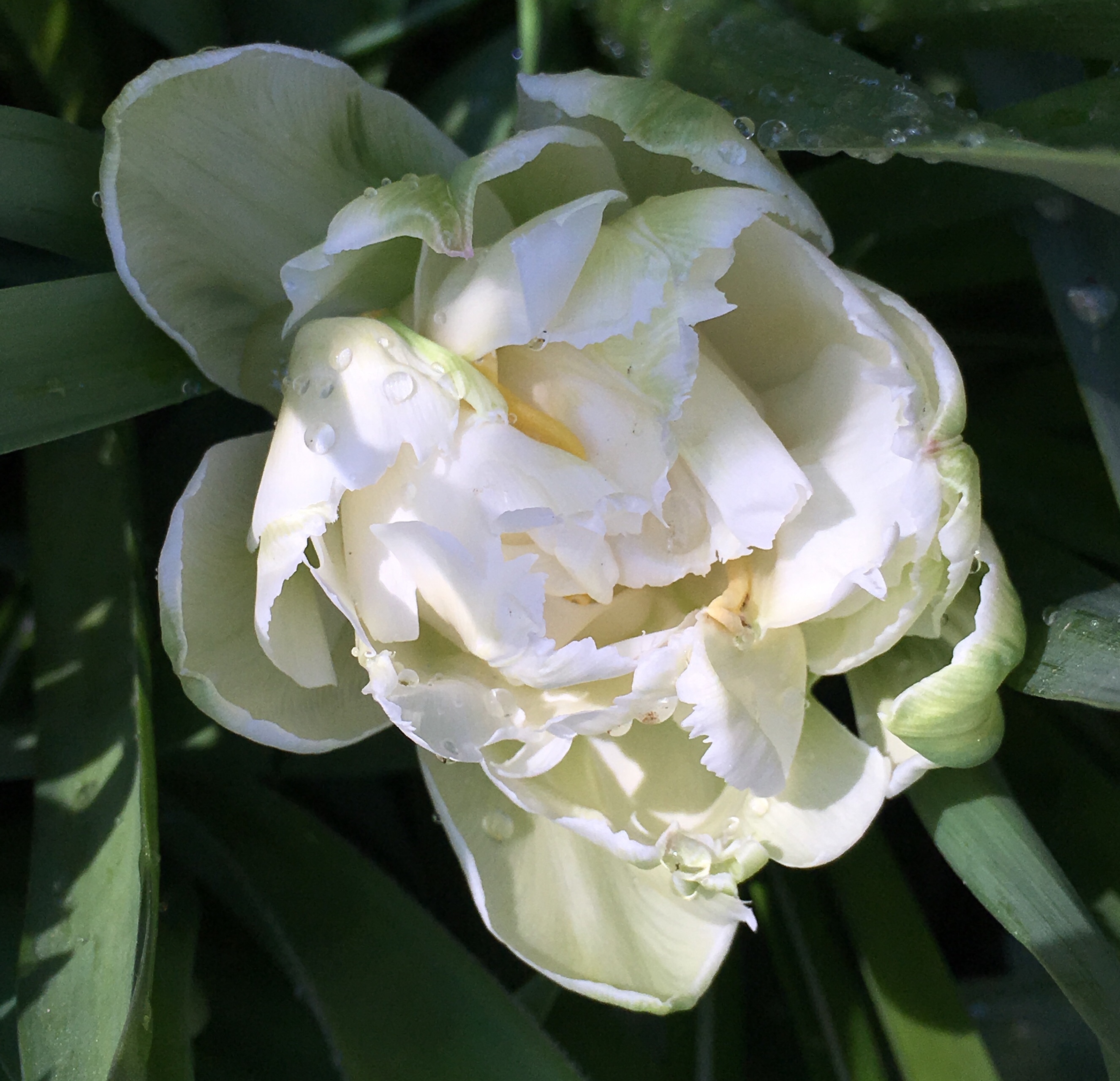
These double creamy tulips, Mount Tacoma, are favourites. They remind me of swan feathers. So graceful.

Scented narcissi, Geranium and Pheasants Eye, are starting to flower. Fabulous with yellow hyacinths and the first wallflowers.

In the greenhouse, the succulents are starting to glow. I’ve started to water everything, and I’m pleased this aeonium has come through the winter.

There’s plenty of citrus fruit coming along. I’ll be able to make orange cakes and lemon meringues soon.

Would you believe it, my new Polar Bear snowdrop is still in flower – at the end of March. It’s a new elwesii type of snowdrop with huge rounded petals and short pedicels which make the flowers look up and out rather than hang down. It looks rather surprised to be out in the spring sunshine amongst daffodils. I wonder if next year it will flower much earlier.
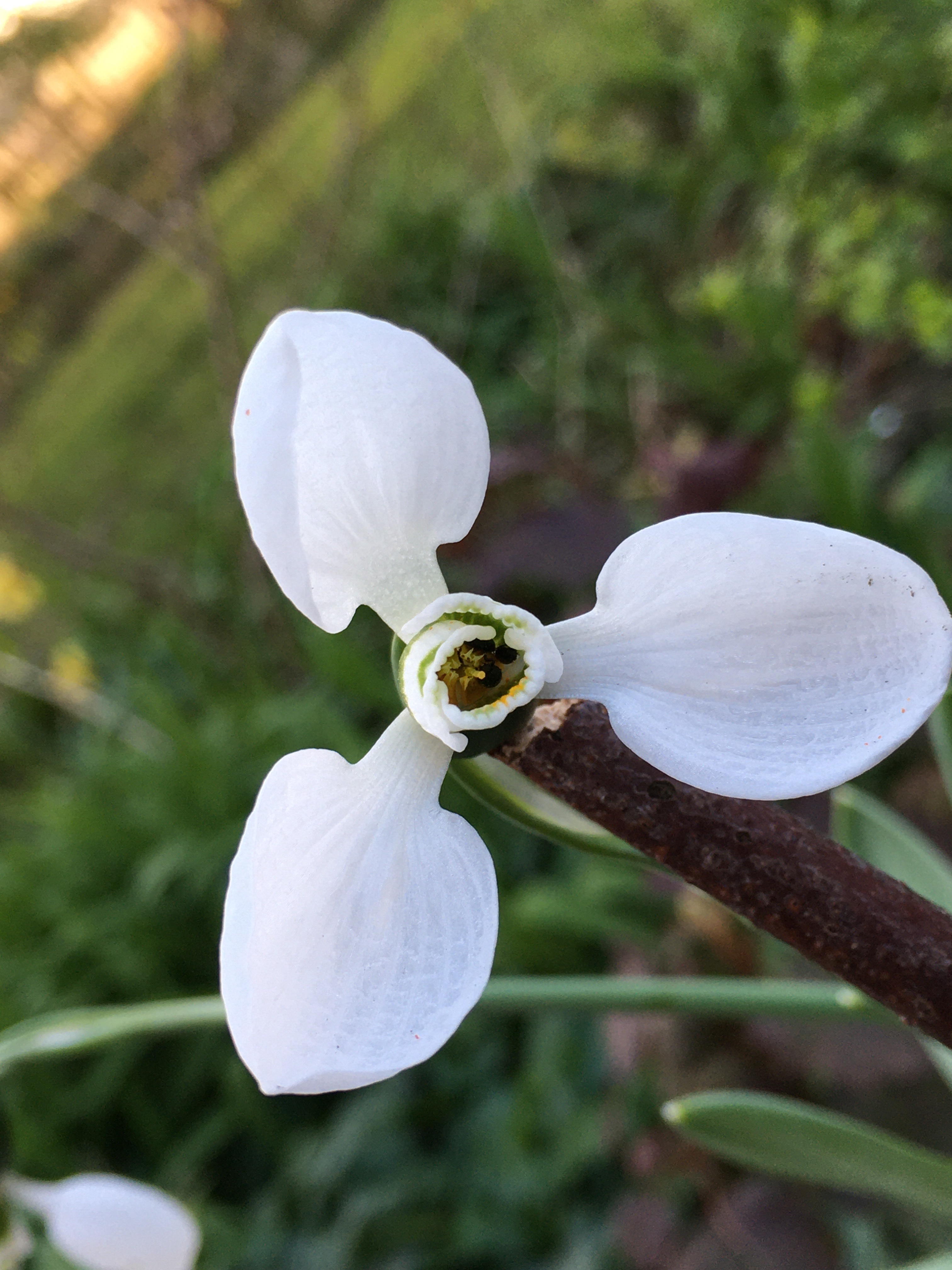

There’s life in the pond. The tadpoles are forming. Lots of pond skaters, some newts, and we’ve even spotted a grass snake, on our new wildlife camera set up on bank.

I’ve mounted the camera on a log, so I can move it about the garden without it being knocked over. Tonight we are hoping to catch sight of the hedgehogs. They are out and about at dusk, making nests in the bottom of the ‘fedge’ and under the old disused hen house.

Ladybirds are much in evidence. Here they are on the phlomis. My army of pest control workers. I’ve left twiggy piles of stems all around the garden to give insects a place to hibernate. Hopefully they will repay me by eating the aphids.

And there’s plenty of bees, thankfully. Bumble bees and solitary bees of all shapes and sizes. I have a new book to review, The Secret Lives of Garden Bees by Jean Vernon. I can think of nothing better than sitting under my cherry trees and loosing myself in a book. It will be something soothing and calming. Much needed at the moment.
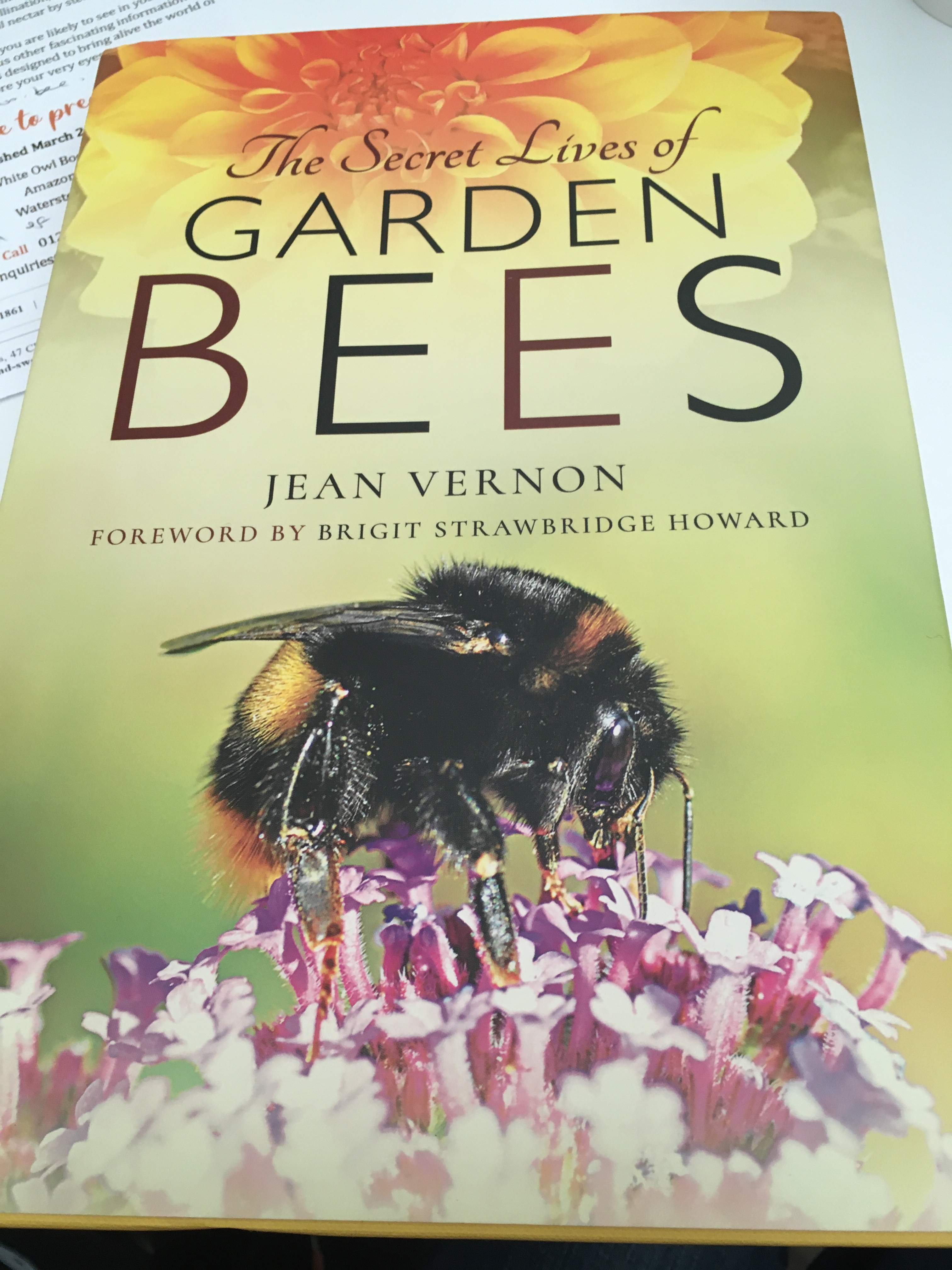

Here’s an enormous bumble bee on the wild anemones. It’s lovely to have a book you can go to to learn more about the bees visiting your garden. And look at ways you can help them to thrive. Something positive to focus on.
I hope you’ve enjoyed this walk around my garden today. The sun is shining and it’s 30C in the greenhouse. All the windows and doors are thrown open. Get in touch and let me know what’s looking lovely in your garden today. And if you are feeling alone or sad, let me know. We are in this together. And be reassured that lots of people are doing wonderful things to help one another. You just have to look for the positives in life. As ever.
Love Karen xx
Home Grown – salads and veg for quick return during Covid-19
The following notes accompany the BBC Radio Leicester Gardens Hour between 1 and 2pm on Sundays, on your smart speaker, DAB, 104.9FM and BBC Sounds. I’m writing this in advance so you can follow what seeds I might be talking about.
It’s been difficult over the past week getting hold of any fresh fruit and veg. Quite dismaying to see empty supermarket shelves. I didn’t stockpile, so we are literally running out of everything.
After a bit of a panic, I’ve settled down to this plan of action. Here’s what I’m growing.
Microgreens and Sprouting Seeds

All you need is a kitchen windowsill to grow sprouting seeds. This tiered growing kit comes from Johnsons Seeds, but you could just use a plate with moist kitchen paper, or a shallow tray with compost for the microgreens. Cheap and easy to grow, adds nutrients to soups stews and sandwiches. Perhaps you’ve done this before with children, growing cress and mustard. It’s the same principle.
I’m growing:
Radish Mino Early
Microgreens Gourmet Garnish
Basil
Beetroot for leaves
Mung beans for stir fries.
Microgreens are grown until they are a couple of inches tall, and then trimmed using scissors. You can repeat this process a few times.
Bean sprouts and seeds are grown for 3-5 days and harvested when approx 2.5cm long
Mixed cut and come again salad

I like the idea of these pre-sown mats. All you have to do is pop the mats on top of a pot of compost snd water them. Fuss-free growing. Pick leaves from the outside when they are 5cm (2″) high, leaving the centre of the plants to carry on growing. Anyone can use these. They are great for children too.
PEASHOOTS

I’m growing peas in shallow trays. They will be harvested when the shoots are 4″. The plants will regrow snd you can repeat the process several times. After this, I plant the peas in a 10″ pot in the greenhouse and they grow on to produce a good crop of pea pods. Any edible pea variety can be used. Friends have even used dried peas from the supermarket.

Herbs in Pots

I’ll sow herbs in individual cells, a few seeds per cell. The cells will be moved on to 5″ pots and eventually they will stand on a sunny patio. Meanwhile, I will just keep pinching out the tips to use to liven up pasta and rice dishes, and this will also make the plants bushy.
Spring Onions

Spring onions will be sown in 10″ pots and kept in the cold polytunnel. They are ideal for growing in containers. They are quick growing and can be sown successionally from March to September. One item I do have is a huge bag of potatoes, luckily. Some mashed potato topped with grated cheese and chopped spring onions turns a simple dish into a tasty treat.
SPINACH

Baby leaf spinach is a favourite here, full of vitamins and goodness. I’ll grow these in recycled polystyrene boxes from a delicatessen, garden centre cafe. You could also use window boxes, or 10″ pots.
DILL

Nano is a new dwarf variety perfect for containers. A few clippings of dill turns any dish into a feast. I make a sauce with mayonnaise, butter and dill to add to fish. Totally delicious and full of vitamins. I’ll sow this 3 or 4 seeds to a cell and then the plants will be moved into window boxes.
CARROTS

Round carrots, such as Paris Market or Rondo are perfect for containers and are relatively fast growing. You can also clip some of the leaves to use in salads without it depleting the roots.
TOMATOES – more long term, but starting now …
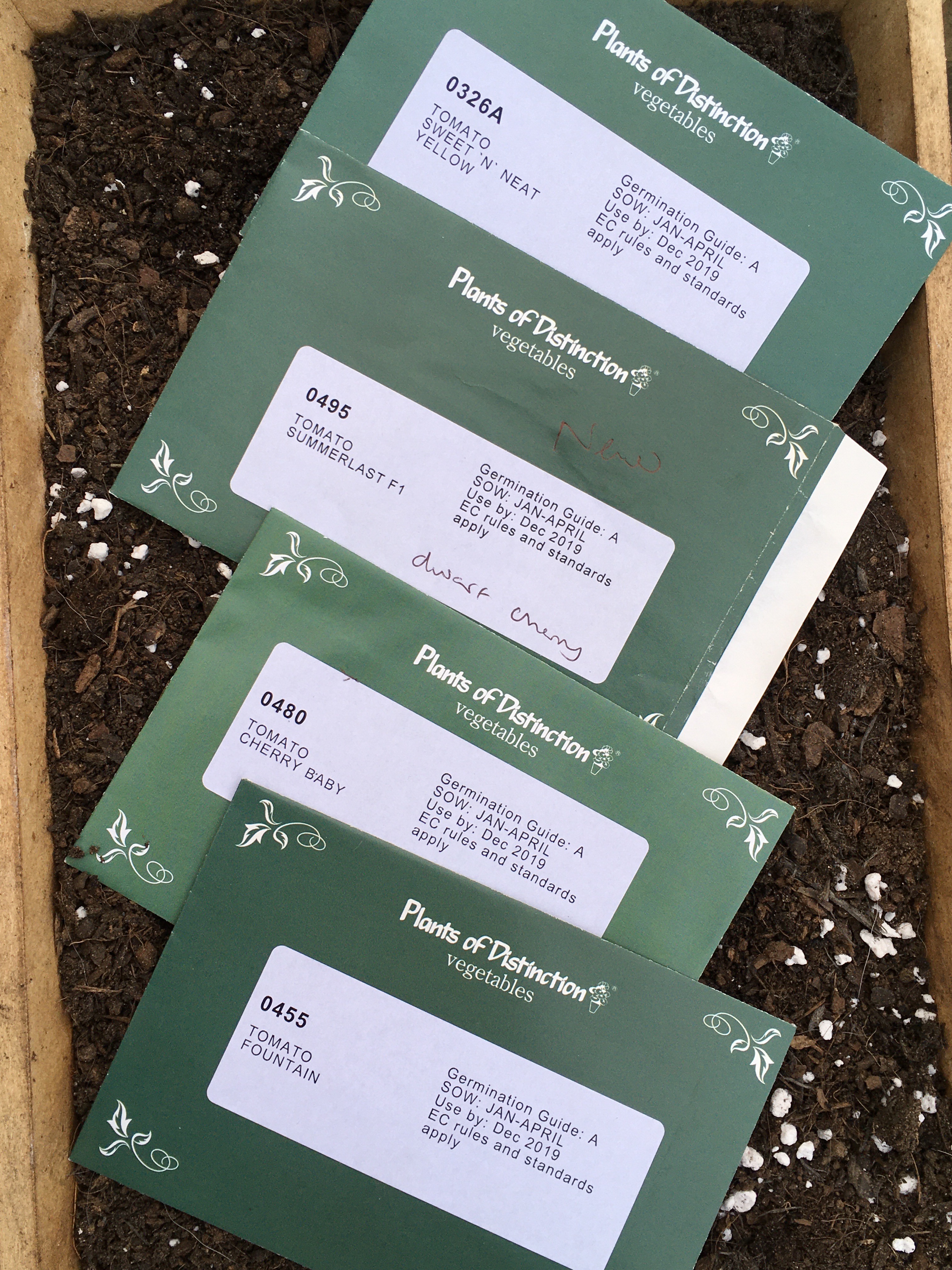
I’ve a selection of dwarf cherry tomatoes for eventually growing in pots on the patio. These won’t need tall canes for support and won’t need pinching out. They naturally branch into small bushy plants. Started now in a warm window or a propagator at 18C, I’ll be eating tomatoes in June. Hopefully.
CUCUMBERS
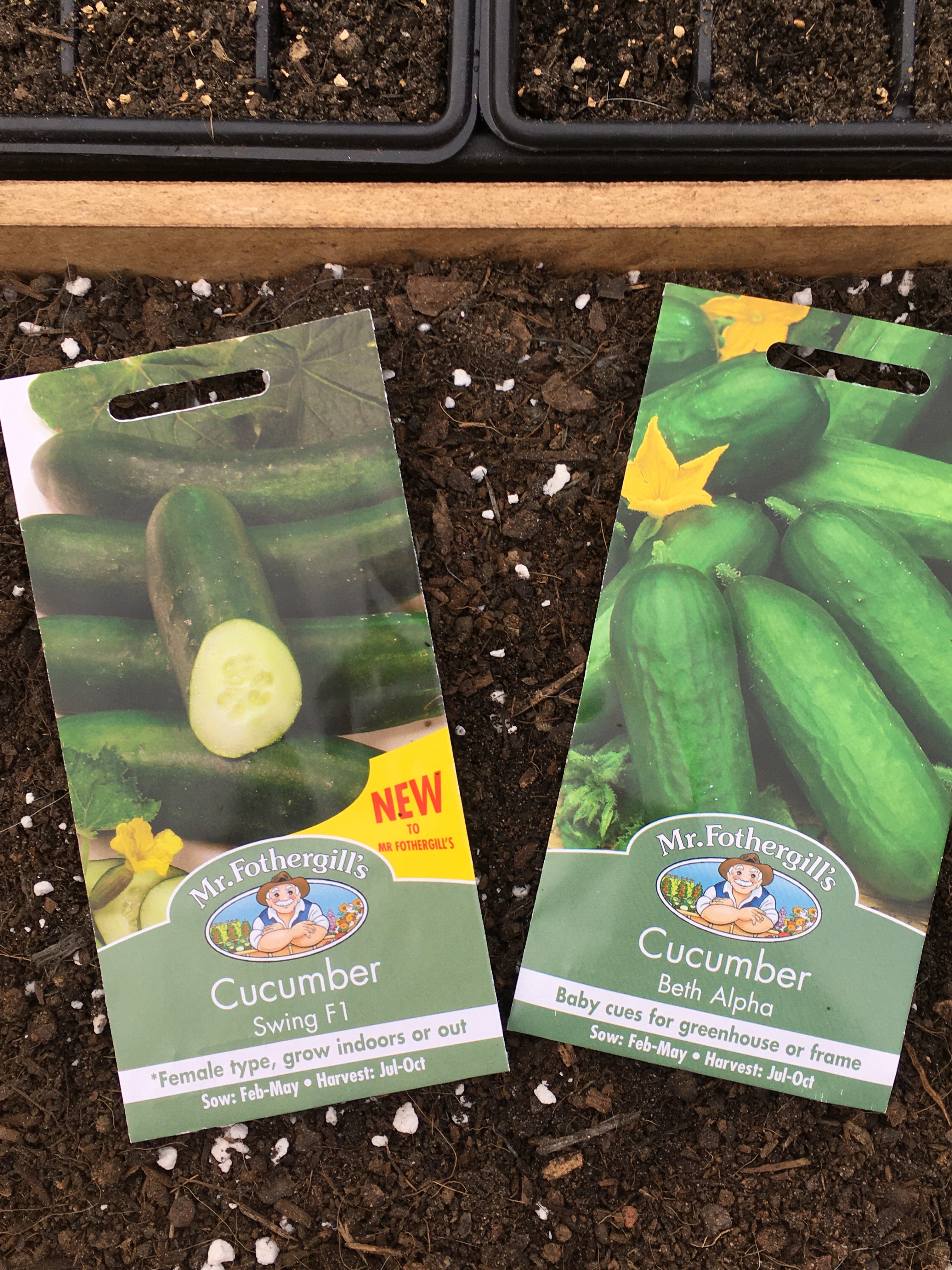
I like baby cucumbers for summer salads. I’m growing Beth and La Diva. I’m also trying a new variety, Swing this year. Half fill a 3″ pot with compost and place the seed on edge. Water with tepid tap water. Keep warm at 18-21C. As soon as the seeds grow out of the top of the pot, add more compost around the stem. Harden off carefully, putting the delicate plants in the propagator over night and out in the greenhouse in the day to prevent damping off disease. Keep warm until June. I’m planning to grow some outdoor and some in the poly tunnel.
SOMETHING FOR CHILDREN

With children off school, cress seeds will be a winner. And also start off sunflowers, not to eat, but to brighten the garden and maybe for a competition to see who can grow the tallest.
My propagator glowing in the dark

It’s been a challenging time where stress levels have been through the roof here. But I feel calmer with a plan of action. Just sowing a few seeds has given me some respite from worries. It’s been a welcome distraction from covid troubles.
Let me know how you are getting on. Have you found it difficult to buy supplies. What are you growing their spring?
Links : seeds from Mr Fothergills https://www.mr-fothergills.co.uk/
Johnson’s Seeds: https://www.johnsons-seeds.com/Home_4/Oriental-Seed_3/Sprouting-Seeds-Sunflower.html#.XnaUjoGnyfA
Little Gardeners https://www.johnsons-seeds.com/Home_4/Oriental-Seed_3/Sprouting-Seeds-Sunflower.html#.XnaUjoGnyfA
Plants of distinction : http://www.plantsofdistinction.co.uk/
Hozelock Pure Bokashi Composter on Trial- and one to give away- Saturday 21 March 2020
During these stressful and uncertain times, I swing between trying to keep things normal, and sitting pondering the dire straits we are in.
I’ve asked all my contacts in the gardening world to supply prizes for readers of this blog. I am determined to keep our spirits up! I’m very grateful everyone has so far responded with overwhelming generosity, and there will be a steady stream of little gifts to give away.
Today’s prize is a Hozelock bokashi home composter. I’ve never tried one of these before, but it seems a great idea. We will perhaps all be trying to grow at least some food this spring and summer. The best way to feed our crops is with home-made compost. Not everyone has space for a large compost bin. This one can sit in the kitchen, porch, garage or garden shed.

Compost is made by adding bran to food waste and peelings every day. The lid is tight fitting and there’s no smells from the composter.

The lid reminds me of those Tupperware containers you used to be able to buy. It’s tight- fitting, but easy to get on and off.
 Inside the composter there’s some bran, a scoop and and container to catch the liquid feed that comes from the tap.
Inside the composter there’s some bran, a scoop and and container to catch the liquid feed that comes from the tap.

There’s a leaflet giving comprehensive instructions. The bottom of the bucket has a colander type filter to stop waste dropping down into the liquid feed collection area.

There’s a reservoir at the base of the bin to collect the liquid.

There’s a tap at the base of the composter. Liquid feed is rich in nutrients. It can be diluted down 1 to 10 with water and used to feed tomatoes, salads and vegetables. And it’s free. That’s the beauty of composting, you are using your waste peelings and food and turning it into something useful for the garden.

All is explained in the leaflet contained in the box. Resulting compost is apparently called ‘digestate.’ How it is made is magical indeed, and I am constantly amazed by nature. The resulting compost is very high value and good for the garden.

I would use the liquid feed for my orange trees, which are starting to produce this summer’s crop in the greenhouse. Just in time for orange cakes and marmalade.
Please leave a comment below if you would like to be entered in the prize draw for a bokashi composter. Hozelock will choose a winner, randomly selected. Usual rules apply, there’s no cash alternative. Prizes may vary from the ones shown. Sorry it’s for UK entries only due to postage costs. Good luck everyone.
I realise composting might not be uppermost in everyone’s minds just now, but we have to keep going. Gardening is certainly keeping me sane at the moment when there seems to be everything to worry about. Please let me know what you are growing, and what methods you are using to keep motivated!
Lots of love, karen x
Comfort Food for a crisis – five minute microwave fruit pudding

If you’re struggling to put your mind to much at the moment, here’s a fast pudding you can make with store cupboard ingredients. You don’t even need to switch the oven on. It’s cooked in the microwave and is ready in five minutes.
INGREDIENTS
3oz margarine ( we use palm-oil free Lurpack)
3oz sugar
5oz SR flour
1 tsp baking powder
1 egg
4 tbsp milk
Sprinkle of mixed dried fruit (optional)
1 apple (optional)
Sprinkle of Demerara sugar for the top.
METHOD
Use an electric hand whisk or food processor to mix the sugar, margarine, egg and milk. Add the flour, baking powder and dried fruit and whizz to incorporate.
Chop one apple and place in the bottom of a glass Pyrex deep dish. You can use any fruit you like. This is also nice with drained tinned peaches, apricots, mandarins, pears, pineapple. Or you don’t have to use any fruit at all, just the sponge mixture.
If using fruit, place the sponge mixture on top.
Cook in a microwave for five minutes. Remove promptly or the pudding will steam. The pudding will carry on cooking for a few minutes after you’ve taken it out of the microwave. Insert a knife into the centre to check that it’s cooked. The knife will be clean if cooked. If not put back for another minute. The pudding shrinks from the sides of the dish as another clue to check whether it’s cooked.
Sprinkle a tablespoon of golden or Demerara sugar over the top. Place under a hot grill for a minute to caramelise and brown the top.
Serve with ice cream, custard, fresh cream.
Serves 6 people and lasts 2 days if kept cool.
VARIATIONS
Instead of dried fruit add 1 heaped tablespoon of cocoa powder. You do not need the Demerara sugar topping as the cake will be brown. This is delicious with mandarins.
This recipe came from my mum and is a family favourite. I’m especially sharing this here for my youngest daughter who is buying a house in the middle of this corona crisis. As if life wasn’t stressful enough. And she will be cooking in her own kitchen for the first time in two weeks. Good luck Rachel xx
Fred, from the FrenchGardener blog (see comments below) suggests making caramel before adding the apples.
150g sugar and 50cl water in the dish for 2.30m to 3 minutes on 900w power. Then add the chopped apples followed by the sponge mixture, sounds delicious. Thanks for the idea.
Wildlife Watching – camera on trial and prize draw for readers
One of the joys of gardening is sharing my plot with wildlife. When I see hedgehogs, it makes my day. When the same hedgehogs emerge from the shrubbery with a family of babies, well, I couldn’t be happier. I’ve given them a home, and it’s simply wonderful to see them thriving.
Today I received a wildlife observation camera to try out on the plot. It took me 20 minutes to read the instructions and set it up, and it has been a constant source of joy all afternoon- and into the evening. There’s an infra red camera to watch after dark.

I set up the camera by the horseshoe pond and placed a suet block in front. It took birds a few hours to find the food, and they were suspicious at first. Then a robin and bluetit tucked in to the treat. The picture is really clear, and you can switch on the sound as well. It’s lovely to hear birdsong while you are working indoors.

The wildlife observation camera comes from Wildlife World. Everything is packed in eco friendly cardboard. The little postcard with a ‘thank you for your order’ message is a nice touch. We enjoyed the chocolates while fathoming out the instructions.

This is what’s in the box. There’s the wire-free outdoor camera, a box with a mounting bracket, a user guide, some screws, batteries, and a USB cable for charging.

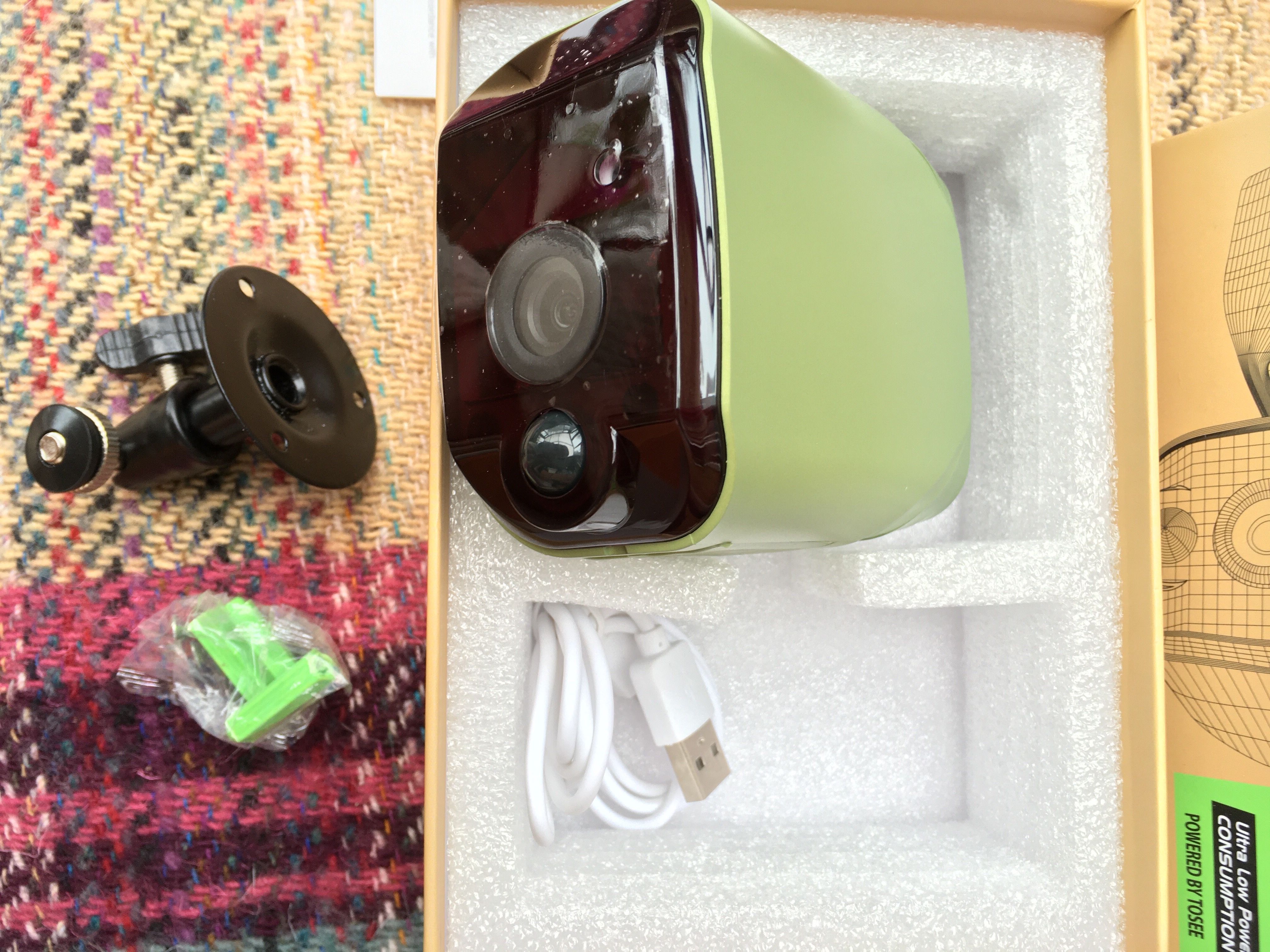
The only assembly I needed to do was screwing the mounting bracket to the bottom of the camera. The batteries were already installed. I expect the camera could be attached to a house wall to watch a bird table, or near a nest box to watch birds and hatchlings. I want to watch a particular blackbird that comes to the pond in late afternoon every day. It spends a good ten minutes splashing around in the shallows. And I’m hoping to catch sight of the hedgehogs as I know they also visit the pond at night.

Here’s what the picture looks like at dusk. If we are very lucky, we might even see the barn owl flying along the boundary. He visits us every evening, silently gliding along the hedgerow like a ghost.
These are screen shots from my i-pad. I haven’t worked out how to share videos from the camera yet, but it’s early days and I’ll have to read through the instructions again.
At about 9pm, great excitement! A grass snake slithered over the stones and into the water. I hadn’t realised they were out and about just yet. But we’ve had two days with sunshine and warm weather. All evening I was glued to the screen watching a tiny mouse dart back and forth hoovering up bird feed crumbs. I took the suet block in for the night in case it attracted rats. And also I didn’t want the hedgehogs to eat it. They have their own special meaty-type food.


Here’s a sample of the instructions for setting it up. I had to go on to the App Store, find ‘ToSee’ and download the free app. It took about ten minutes to sort that out. I was quite pleased with myself, as I’m hopeless with any kind of technology. It was fairly straightforward and the camera connected with the app first time. I then carried the camera outdoors and set it down by the pond. Tomorrow I might move it to another location. When you close down the i-pad or phone, the camera sends a signal if it detects any animal movements. It’s quite a distraction from work!
Overall, I’m delighted with the ease of setting up, the quality of the picture and the welcome little extras such as sound and night time viewing. I have no hesitation recommending the Wildlife World observation camera. It is powered by rechargeable battery and has motion detection by PIR sensor.
I’m working from home now for the foreseeable future. The wildlife camera is part of my ‘coping with panic’ strategy. Corona virus is very much uppermost in my mind, as it is for all of you, I’ve no doubt. But I’ve decided to try to think of something each day that will bring me joy and ease my worries. Concentrating on gardening and nature soothes and heals. I’ve found this to be true twice before when I’ve been seriously ill. And now, like many, I must find coping strategies again, and ways to stay positive when there just seems to be bad news every day.
Please leave a comment below to be included in the prize draw for a wildlife observation camera. Names will be randomly selected by the company. Sorry it’s UK entries only. There’s no cash alternative. Camera types may vary. Wildlife World company decisions are final. Usual rules apply. Please also comment if you don’t want to be entered in the draw and let me know.
Keep safe, and I hope you can all get out and enjoy your gardens too. xx
Links: Wildlife World https://www.wildlifeworld.co.uk/product/wirelesswildlifeobservationcamera/
In a Vase on Monday -March 16 2020

On the first warm, sunny day of the year, I’ve made a comfy place in the garden. I sit here, surrounded by familiar things: flowers, fresh from the garden, favourite books, magazines, tea, and mum’s lemon cake. And for a few minutes, I forget my worries. I am determined to enjoy the garden, birds singing all around, frogspawn in the pond. Trees bursting into leaf. I watch a wren creeping along the eaves of the house, searching for spiders. Spiders webs are used to glue their nests together, so I never clear them away. All of nature carries on, oblivious to the crisis we humans are facing. My small ginger spaniel Meg sleeps at my feet. My cat, Grace, chases a fly. They too are unconcerned. And yet I am a boiling cauldron of concerns. One minute panic stricken by the ‘what ifs’ the next, in warrior mode ready to fight. If only I knew exactly what I’m fighting. I return to voices, advice from my childhood, that some things cannot be changed and what will be, will be. I desperately try to remember comforting phrases from the past. I know my family, going back in time, suffered many illnesses and setbacks and survived. The suffering though. Those photos are etched on my mind. We, in modern times, have had it easy. Until now. And now, none of us know what’s going to happen. To give some respite from my thoughts, I turn to familiar things. For comfort I walk around my garden picking spring flowers, as I have done for the 30 years we’ve lived here. I’m posting them for you to enjoy, hoping they will bring you some comfort too, and for a few moments give you something else to think about. Stay safe all of you and keep in touch. Our gardens and our gardening community have never been needed more than they are today.

Dark, plum-toned Hellebore Rachel, with ruby hyacinth Woodstock, surrounded by Prunus Kojo-no-mai, ribes, Viburnum Eve Price, and pink comfrey.




The first of the wild cherry blossom. Simply beautiful. Pure and bright.



The last of the paperwhite narcissi and some skimmia. Deliciously scented.
Keep in touch and let me know what you are doing in your garden. Are you managing to get any seeds sown yet?
Sending love, hope and good wishes to you all. xx
Links: In a vase on Monday: https://ramblinginthegarden.wordpress.com/2020/03/16/in-a-vase-on-monday-change-of-plan/
Last of the late snowdrops – and snowy pictures of my garden

Patience often pays off. I’ve been watching the prices for this new and expensive snowdrop. Then, when most of the flowers had gone over, the garden centre reduced the price! It was my lucky day. Galanthus Polar Bear is my new favourite snowdrop, and it’s a quite a beauty, isn’t it.

I managed to find a pot with flowers still in bud. It’s a very late flowering type with short pedicels, making the flowers fling out and look up at you. So unusual, as most snowdrops bow their heads and look down. It’s got a lot of charm, and is the star of my potting shed windowsill at the moment.

While we are still talking about snowdrops, I thought I’d show you some snowy photos of the garden. It’s been the mildest wettest winter on record here, and this is the first, and only snow we’ve had so far. It makes the garden look magical and hides all imperfections (fortunately.) No weeds are on show, and brambles look ornamental with an iced topping of snow. Here you can see my greenhouse, polytunnel and potting shed set up, all close together to save walking too far between them. In front of the potting shed there’s some renovated 1930s plant nursery trolleys. Very useful for moving plant pots about, and for staging potted displays. My second-hand poly tunnel has doors both ends which is great for good air circulation. The 20ft Alton Cedar greenhouse is also second-hand and renovated by my husband. We painted it black, and made matching black staging inside. Beyond is my cut flower and veg patch and then the orchard, before you reach the paddock gate leading to the ridgeway footpath.

In the exotic border in front of the potting shed, I’ve left stems and seed heads intact for birds to eat and insects to find shelter. These innula seeds look pretty with a topping of snow.
 The horseshoe pond can viewed from the potting shed windows. There’s a gently-sloping boulder beach to stand on, and this gives easy access for hedgehogs, frogs, newts and grass snakes. It’s very calming to stand and watch the ripples from raindrops. Today the pond is a cauldron of frogs, mating and producing frog spawn.
The horseshoe pond can viewed from the potting shed windows. There’s a gently-sloping boulder beach to stand on, and this gives easy access for hedgehogs, frogs, newts and grass snakes. It’s very calming to stand and watch the ripples from raindrops. Today the pond is a cauldron of frogs, mating and producing frog spawn.

From the pond you can see the cut flower and veg patch. My hazel sweet pea supports have weathered three named storms on consecutive weekends. Really, if they can cope with all that, I think they will stand firm and strong for the summer display. There’s little slab paths between the plots so I don’t have to walk on the soil. It’s a no-dig garden inspired by Charles Dowding who’s been a patient and valued mentor these last few years, along with his partner Stephanie Hafferty. They’ve both given me lots of advice and I’ve got more value out of my plot thanks to their suggestions.

At the end of the veg plot there’s a small orchard, rather neglected. We’ve pruned it this winter which means we might lose some of the crop in the summer. But over a few years we will get the trees back into shape and down to a manageable size for harvesting. Under the trees I’m planning a wild flower patch. I’m going to leave some grass and see what happens, I will sow some plug plants in another area, and finally I’ll try a wild flower lawn, ready seeded. I’ll report back on the project.

Finally here’s the view down the field hedge tunnel. This path is made from bark and brushwood chippings from the garden, put through my new Stihl electric shredder. It saves a fortune on bagged bark supplies, plus helps me recycle waste from the garden.
Thank you for reading. Please share on any social media platform , and get in touch and let me know what your garden looks like just now. Comments box is right at the bottom of the page.
Links: Stihl shredders : https://www.stihl.co.uk/STIHL-Products/099364/Garden-shredders.aspx
In a Vase on Monday- flowers from my plot 9th March 2020
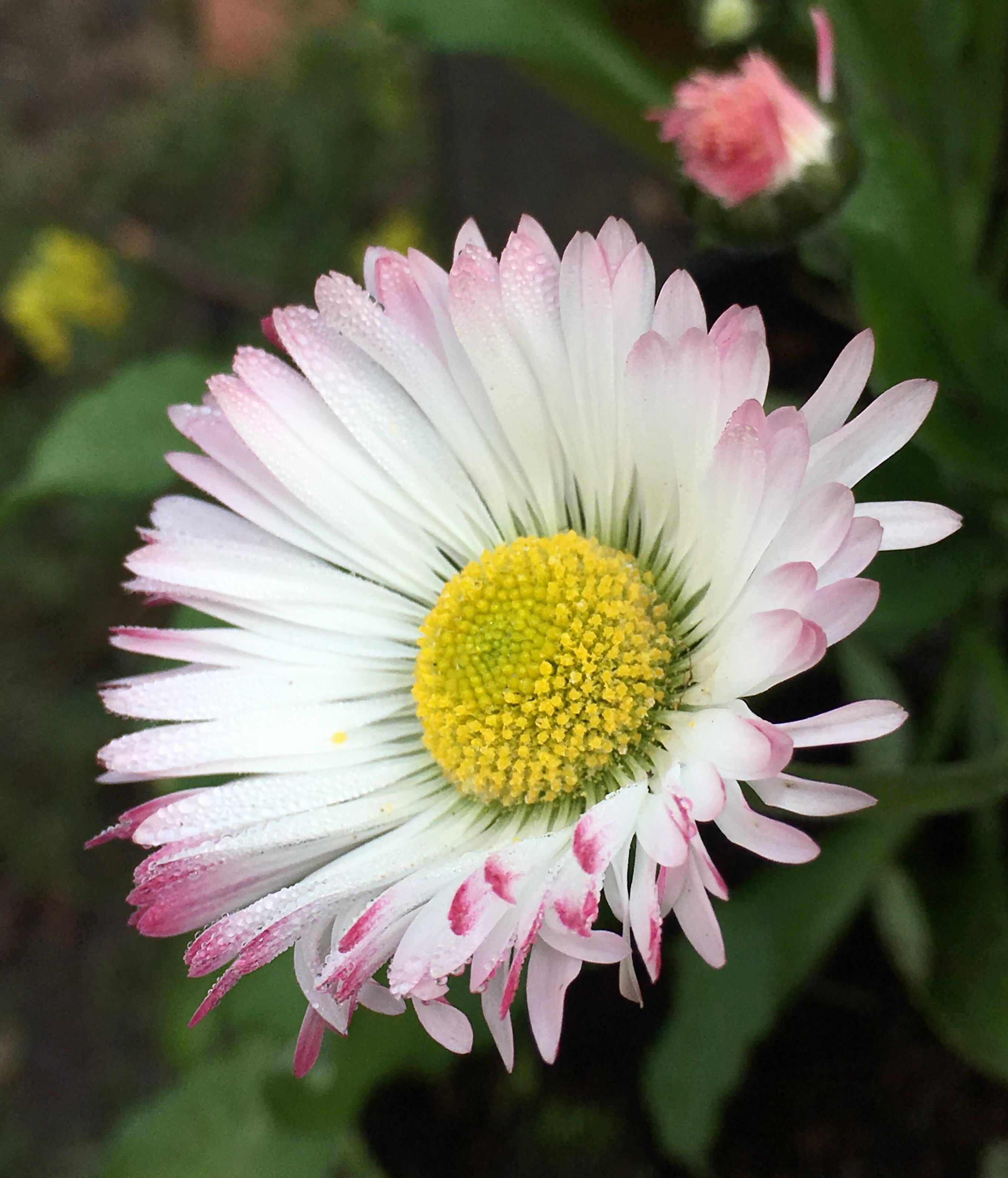
Finding comfort in familiar things, I’m joining in with my favourite IAVOM theme today.
Spring flowers always bring hope. And we need plenty of hope at the moment, don’t we.
Here’s my flowers, picked fresh from the garden. They are in an unusual location, the drinks holder of my car. The perfect place for a jam jar of flowers, on their way to my mother’s house (via Radio Leicester, where I talk about what’s growing on my plot).

There’s some shoots of Japanese cherry, Prunus Kojo-no-mai, at the back of the posy. Some lace-edged heritage primulas, Pulmonaria Sissinghurst White, plum coloured Hellebores, and one very pretty bellis daisy.
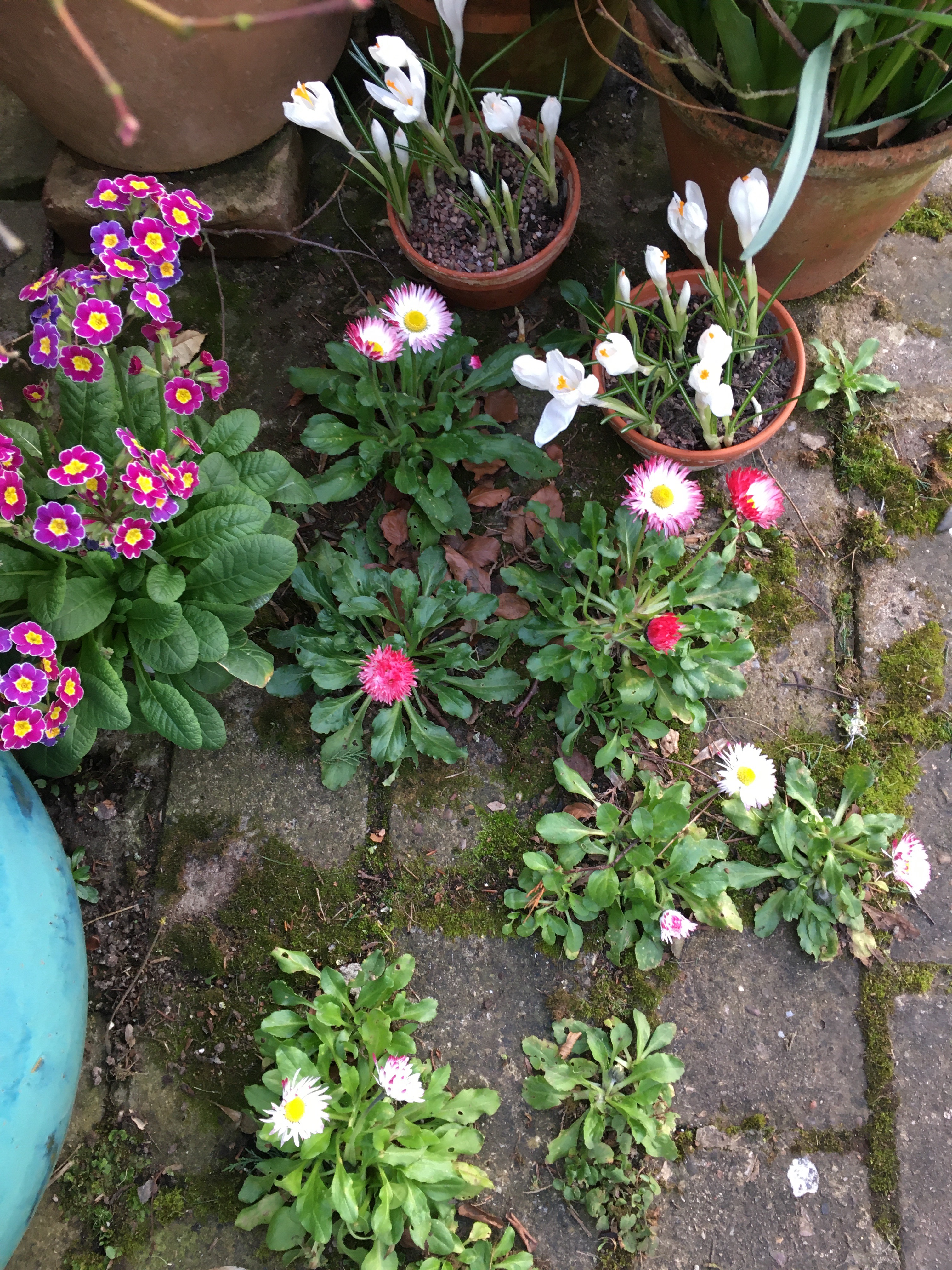
The daises have grown all by themselves in the gaps between paving slabs at my back door. Something so pretty, just growing from seed carried on the wind. They have given me as much joy as anything I’ve planted and tended, probably because they have survived against the odds. There’s no soil there. And no loving care. But they have thrived. A message to us all, about resilience, maybe.

I love the slightly messy, many petaled flowers of bellis daisies. There are single and double forms. Seed packets cost a couple of pounds. Once you have them, they will always be with you. But not necessarily growing where you put them!
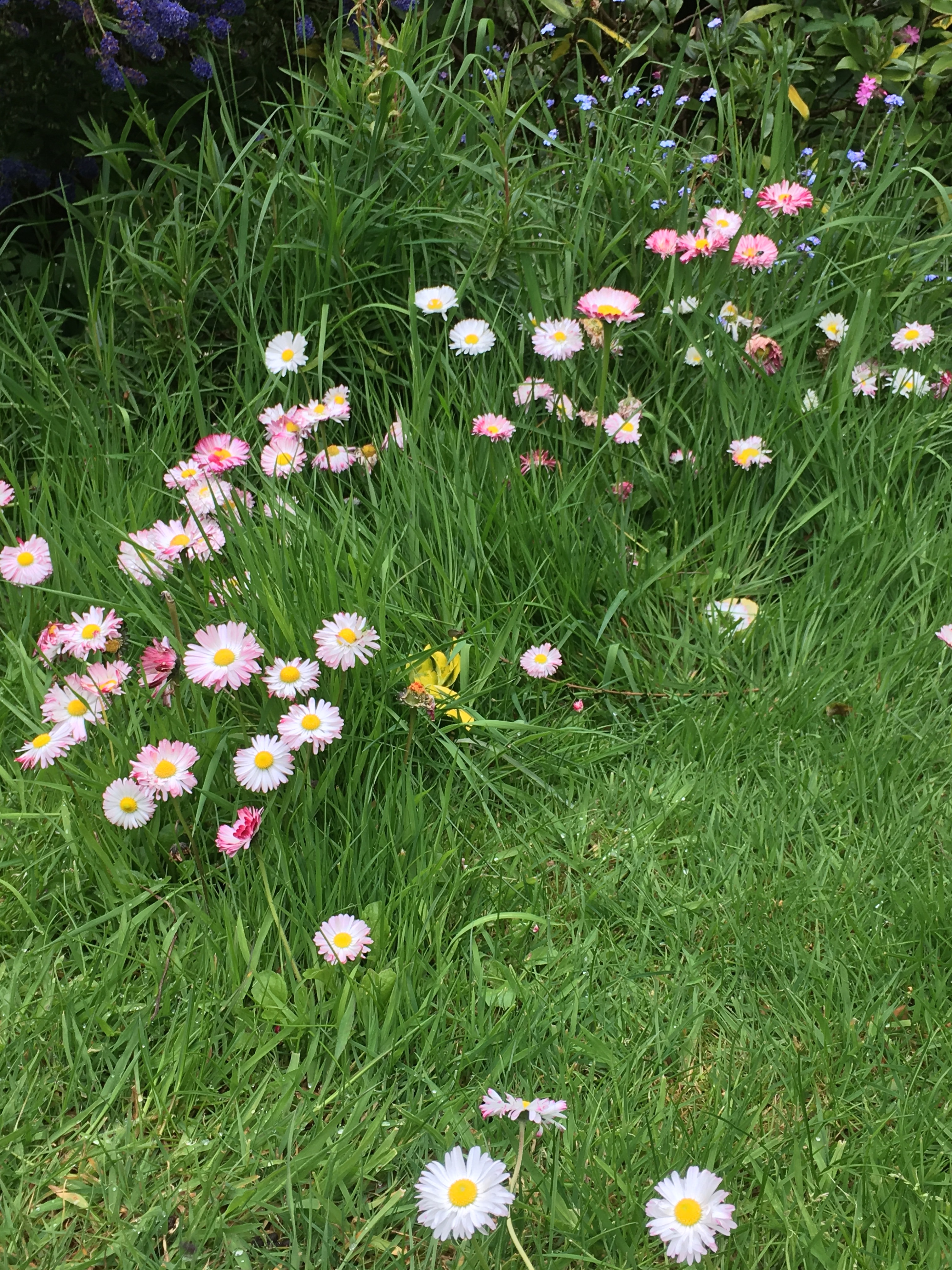
In my mother’s garden, the daisies romp delightfully across the lawn and into the border. She mows around them. It’s obvious where I get my empathy with plants from. My lovely mum has always been my greatest influence in life.

Wishing you all a peaceful, happy and successful week. I’d love to see what you are all sowing and growing in your garden just now. It’s very busy here, with plenty to do in the garden, as always. Hoping for some sunshine and nice weather – soon.
Links: In a Vase on Monday https://ramblinginthegarden.wordpress.com/2020/03/02/in-a-vase-on-monday-pillaged/
Bellis Daisy: https://www.mr-fothergills.co.uk/Flower-Seed/Bellis-Goliath-Mixed.html#.XmZXWoGnyfA
BBC Radio Leicester, gardening starts at 1pm every Sunday with Dave Andrews https://www.bbc.co.uk/programmes/p002zx56. Listen back on Sounds, or ask your smart speaker to tune in to BBC Radio Leicester
Please share via any social media platform. I do not pay for any advertising, and I’m always grateful to anyone who spreads the word and signs up to follow, via e mail. Thank you. 🙂 🌱
Note: I was not driving when I took the photos in my car. Naturally.
